A GUIDE TO BAREFOOT SHOES
- WHAT ARE BAREFOOT SHOES?
- HOW DO I START?
- TRANSITION TO BAREFOOT SHOES
- GUIDE FOR MEASURING
- SPACE IN SHOES
- SOCKS & TOESOCKS
- SANDALS – GUIDE
- LIST OF BAREFOOT SHOE BRANDS
- BAREFOOT RETAILERS
- FREE E-BOOKS
- BRAND REVIEWS
- SHOE REVIEWS
- MORE RESOURCES


9 Must-Have Barefoot Hiking Shoes for an Epic Trek
Obvestilo o partnerskih povezavah
Whether you’re a beginner seeking flexible and lightweight minimalist hiking shoes or an experienced hiker in search of a comfortable long-distance backpacking option, there’s a best barefoot hiking shoe out there that’s perfect for you. These shoes not only mimic the natural shape of our feet and the sensation of being barefoot but also incorporate features essential for a successful hiking experience. From minimalist waterproof hiking boots for wet adventures to the thinnest-soled, lightweight, and highly breathable barefoot hiking shoes that allow your feet to move freely, we’ve got you covered.
At Barefoot Universe, we’ve spent years testing various barefoot and minimalist hiking boots and shoes. In this carefully selected list, we present you with the best of the best. Whether you’re looking for the most minimalistic and lightweight barefoot shoes made from leather or vegan materials, waterproof options for the rainier days, or highly breathable summer trekking shoes, you’ll find them all here. We’ve also included shoes with slightly thicker, yet still zero drop soles, providing more cushioning and making them ideal for beginners.
Throughout our testing process, we focused on the barefoot characteristics such as a wide, foot-shaped toe box, a zero drop sole, flexible soles, and ankle freedom. Additionally, we looked for features that make a great hiking shoe, including comfort, tread and grip, waterproofness, and weight.
It’s important to remember that since every foot is unique , not all barefoot hiking shoes will work for everyone. That’s why we recommend carefully measuring and examining the shape and dimensions of your feet before choosing a hiking shoe. Achieving the right fit is essential for a comfortable and enjoyable trek.
Table of Contents
Can I Reap Benefits by Hiking in Barefoot Shoes? Is It Safe?
If you’re new to barefoot hiking, you may be wondering whether it’s safe and how you can benefit from it. While barefoot shoes offer several benefits, it’s essential to take safety considerations seriously to avoid injuries.
Our comprehensive guide, ‘ Charting New Paths: The Unmatched Guide To Barefoot Hiking Shoes ‘ , has all the answers you need:
- What are the benefits of hiking in barefoot shoes?
- When is it safe to hike in barefoot shoes?
- Barefoot hiking boots or hiking shoes – what’s better?
- What sole thickness should I choose?
- How do I select the right size?
- Should I wear socks with barefoot hiking boots?

By answering these questions, we aim to guide you towards making informed decisions that will help you reap the rewards of barefoot hiking while staying safe on the trail.
Top Picks for Adults: The Best Barefoot & Minimalist Hiking Shoes for Men and Women
Vivobarefoot.
BEST OVERALL BAREFOOT HIKING SHOES
| Men’s, Women’s | Leather, Vegan | Waterproof options | EU 35 – EU 48 | From approx. 165€ |

- Use BUVIVO25 for 25% discount
VIVOBAREFOOT is a brand that offers a wide selection of barefoot hiking shoes and boots that you can use all year round. They have many models available, including super lightweight low cut sneakers, swimrun trainers, and insulated waterproof high-cut hiking boots made from leather or vegan materials. Their collection caters to both men and women, with most models available in various colours too.
VIVOBAREFOOT hiking boots and shoes have amazing traction, thanks to their deeper lugs on the soles. Despite this, some styles still provide excellent flexibility, allowing for unrestricted foot movement. It’s worth noting that you can choose between different types of outsoles to suit your specific hiking needs, such as ‘soft ground’ soles and ‘firm ground’ soles.
Some models like Tracker Decon also have innovative ankle designs that ensure absolutely no ankle restrictions. You can even wear some models sockless for maximum comfort!
The shoes have minimal cushioning, allowing you to have a closer connection to the ground. Additionally, you can remove the insole for an even greater ground feel. Certain models are even waterproof, which offers protection from moisture.
Sizing & fit: VIVOBAREFOOT shoes come in both men’s and women’s sizes, with men’s being wider. Women’s models are best suited for narrow and medium-width feet, while men’s are typically for medium-wide feet. However, some models can accommodate slightly wider feet too.
If you’re in the “crossover sizes” range (EU 40- EU 43), you can choose between both men’s and women’s widths for a better fit.
This is a brand that prides itself on delivering quality products. We have a separate VIVOBAREFOOT review available on our blog if you want to learn more about a specific model.
TOP-PERFORMING TRAIL BAREFOOT HIKING BOOTS
| Men’s, Women’s | Leather | Waterproof | EU 37 – EU 47 | From approx. 259€ |

Use BU15 for 15€ discount
Bär Shoes’ minimalist hiking shoes are truly exceptional in terms of quality. These shoes are waterproof, featuring a gusseted tongue, a foot-shaped design, and a roomy toe box. My initial hiking boots were their Wandertoes, and for a few years, there wasn’t a barefoot edition available. This year, Bär introduced a completely new model called Mountain Barefoot, which I was extremely excited about. As always, they meet the brand’s high standards, and I’m confident they will last for many years, just like all my other pairs from this brand.
Mountain Barefoot has a unique design with a sole that wraps around the midfoot. I was concerned it might feel like arch support, but it doesn’t; instead, it enhances lateral support and stability. The sole is thin with minimal cushioning, and it doesn’t restrict ankle movement. The lacing system is easy to use.
If you prefer a thicker sole, their Wandertoes 2.0 and other hiking boots from their assortment provide more cushioning and protection when necessary. These are undoubtedly top-quality barefoot hiking boots built to endure.
Sizing & Fit: All Bär Shoes are available in half sizes, making it easy to find the perfect fit for various foot lengths. They are best suited for medium-wide feet, with men’s models having slightly more volume above the toes and in the midfoot. I typically wear size 8, but for this model, I chose to size up by half to have extra room for thicker socks, for walking downhill, or for when my feet swell during longer hikes.
BEST BUDGET BAREFOOT HIKING SHOES
| Men’s, Women’s | Leather, Vegan | Water-resistant options | EU 37 – EU 48 | From approx. 100€ |

Use code BOS10 for 10% discount.
Freet stands out as a brand with a vast array of barefoot hiking boots and shoes, tailored for both chilly and warmer hiking days, available in vegan and leather variations. Remarkably, they even incorporate coffee grounds into their materials.
Their microfiber vegan materials are not only environmentally friendly but also easy to clean, even after traversing wet and muddy terrains. While waterproof, it’s worth noting that their vegan options might offer slightly less breathability compared to their leather counterparts.
Definitely check out their Feldom, Ibex, Tundra, and Kidepo models, which are specifically designed for hiking. Additionally, several of their other models are well-suited for lighter trail hikes. While some are low-cut, others offer a higher profile without fully covering the ankle, ensuring ample freedom of movement.
Their barefoot hiking shoes also feature a special HillGrip sole, which has deeper lugs for good grip on wet and muddy surfaces. The sole is flexible in all directions.
In a practical touch, most of their shoes come with removable insoles, providing customization for cushioning and volume adjustment to align with your preferences.
Sizing & fit: each Freet model varies, but generally, they are well-suited for medium and wide feet. In certain models, opting for a larger size could accommodate thicker socks more comfortably. For comprehensive insights into each model’s fit, we recommend exploring our comprehensive Freet review , where you’ll discover in-depth information about the brand and individual models.
Ahinsa Shoes
BEST LIGHTWEIGHT BAREFOOT HIKING SHOES
| Men’s, Women’s | Vegan | Extra wide options | EU 36 – EU 46 | From approx. 199€ |
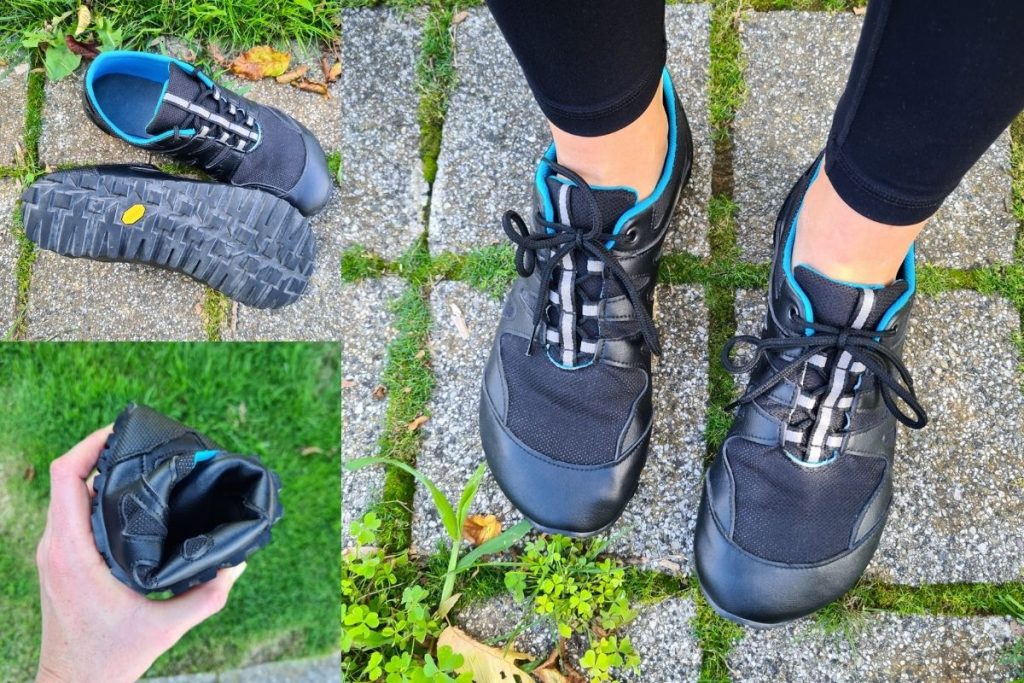
Use code BU10 for 10% discount.
Ahinsa Chitra Trek&Trail stands out as one of the softest, most flexible, and lightweight barefoot hiking shoes available. This model offers two choices: the barefoot and comfort versions. The comfort line features an insole with a slight heel rise, while the barefoot version, designed for more experienced hikers accustomed to barefoot footwear, boasts an ultra-thin, removable insole.
The sensation of wearing them is akin to having nothing on your feet, rendering them ideal for both travel and everyday use, given their sneaker-like appearance. Constructed from vegan materials with mesh inserts, these shoes are well-suited for warm weather hikes. However, due to the vegan materials, wearing them without socks is not recommended, as the insole may adhere uncomfortably to the foot.
The Vibram rubber outsole, characterized by deeper lugs, provides substantial grip across diverse terrains. The sole’s responsiveness to the ground can be intense, particularly on rocky surfaces, making it an exhilarating experience for those well-acquainted with barefoot shoe wear.
Sizing & fit : Ahinsa Chitra Trek&Trail suits medium and wide feet with low to average instep perfectly. An xWide version is also available, catering to extra-wide feet. As a point of reference, I wear size 43 with foot dimensions of 26.3/10 cm.
THE WIDEST BAREFOOT HIKING SHOES
| Men’s, Women’s | Leather | Water-resistant (TEX membrane & gusseted tongue) | 36-47 | 169€ |

Use 10BU for 10% discount
The Trekker Low are amazing, high-quality trekking shoes suitable for year-round use that your feet will thank you for. Perfect for everyday wear, walks in nature, trekking, and hiking, the upper is made of nubuck leather with an integrated waterproof membrane. The gusseted tongue adds extra waterproofing, and after testing in wet and muddy environments, they kept our feet dry. The non-slip rubber outsole is highly flexible in all directions, providing excellent ground feel. While the insole adds shock absorption, it’s optional. The easily adjustable laces, along with the top speed hooks, make them easy to put on.
Sizing & Fit: Realfoot Trekker Low is one of the widest hiking boots we’ve tested, ideal for wide and extra-wide feet (but adjustable for narrower feet). The roomy toe box has ample space above the toes. The midfoot and heel are best suited for narrower and average heels but can accommodate different instep heights well. If you have a lot of volume in the mid and back part of your foot, they may fit snugly there.
BEST CUSHIONED MINIMALIST HIKING SHOES
| Men’s, Women’s | Leather, Vegan | Waterproof options | US 6 – US14 | From approx. 120€ |

Lems hiking shoes present an excellent choice for those seeking hiking shoes with a spacious toe box, zero drop, substantial tread, and slightly thicker soles. While the thicker soles may compromise ground feel and flexibility, they cater wonderfully to beginners and individuals who prefer enhanced cushioning during walks without compromising toe freedom.
Currently, Lems Shoes offer three distinct models equipped with deep lugs suitable for hiking: Outlander, Primal Pursuit Mid, and Primal Pursuit.
The Outlander by Lems is a versatile all-season minimalist hiking boot with a waterproof upper. Its gusseted tongue ensures effective water resistance, making it ideal for mountain hikes, muddy tracks, and rainy urban escapades.
Primal Pursuit is tailored for dry weather hiking and doubles as stylish everyday sneakers. Crafted from breathable mesh upper, these shoes provide optimal ventilation during warmer days. The thick and firm sole with a rubber outsole guarantees reliable traction across various terrains.
Primal Pursuit Mid, an elevated waterproof rendition of Primal Pursuit, features a suede upper for added protection.
Sizing & fit: Lems’ diverse models have varied fits, size charts, and widths. Their hiking range is not among their widest or most foot-shaped Lems offerings. These models showcase minimal tapering in the toe box, rendering them suitable for medium width feet. Opting for a larger size can yield a few additional millimeters in width.
BEST BAREFOOT HIKING SHOES FOR BACKPACKING
| Men’s, Women’s | Leather, Vegan | Water-resistant options | EU 35.5 – EU 48 | From approx. $130 |

Xero Shoes is a renowned brand that offers an extensive array of sport styles in their barefoot collection, and their hiking shoes are no exception. Their hiking boots and shoes (Ridgeway, Scrambler Mid, Mesa Trail, Terraflex, etc.) are available in various editions and colors, ranging from low-cut mesh sneakers to ankle-high waterproof barefoot boots.
The soles of their hiking shoes may feel firmer and less flexible compared to some of their other models. However, this characteristic can be ideal for those seeking a hiking shoe with a mid-range sole thickness, striking a balance between ultra-thin and overly thick soles. Notably, Xero Shoes offers a 5,000 MILE SOLE WARRANTY. Should you manage to wear out the outsole of your Xero Shoes prematurely, they will replace them for a nominal fee.
Sizing & fit: Xero Shoes are available in two widths (Men’s and Women’s sizes). Women’s sizes are slightly narrower than men’s and best suited for medium-width feet. If your feet are slightly wider, opting for a larger size can provide extra millimeters in width. Many of their models also offer ample space above the toes. Men’s shoes are slightly wider, featuring more volume at the ball of the foot and midfoot than women’s, making them an excellent fit for medium-wide feet. If your size falls within the range where both models are available, you can choose between men’s and women’s shoes based on your foot width.
For a comprehensive insight into Xero Shoes hiking shoes & boots, refer to our detailed review .
Softstar Shoes
ADVENTURE-READY BAREFOOT HIKING SHOES
| Men’s, Women’s | Leather | Water-resistant | US 5 – US 15 | 315€ |

Softstar Shoes Switchback are hiking boots renowned for their exceptionally wide toe box shape. The upper is crafted from highly durable waterproof materials. However, it’s important to note that while the shoe is water-resistant up to the height of the tongue, the tongue itself is not gusseted. The lower section of the shoe, without additional treatment, can retain water for a limited period (approximately 2 minutes when fully immersed).
Their robust Vibram™ Megagrip sole provides outstanding traction, even on challenging, wet, and slippery surfaces. Due to its thickness, the sole may be less flexible and slightly challenging to roll. While I can bend the shoe longitudinally, achieving the same in the transverse direction is not as feasible.
Sizing & fit: For this model, we strongly recommend opting for a size larger than what the size chart suggests, especially if you intend to wear thicker socks and your foot length doesn’t precisely align with the lower limit for your size. Additionally, it’s worth noting that the space above the toes towards the shoe’s front is not excessively roomy, impacting the overall sense of spaciousness. Please note that only wide width is foot-shaped!
Check our separate Softstar Switchback review for more details!
BEST MOUNTAINEERING STYLE BAREFOOT BOOTS
| Men’s, Women’s | Leather, Vegan | Water-resistant | EU 36 – EU 47 | From approx. 162€ |

Proalp hiking boots are fashioned from suede leather, available in various colors. Suede leather is chosen for its resilience against scratches. These boots are suitable for both men and women, offering diverse width options. Custom colors can be selected for an additional fee. While they lack waterproofing and a membrane to maintain flexibility, remember that leather naturally repels water. If desired, you can apply waterproofing treatment for added protection.
Proalp Contact S2 hiking boots are designed to provide ankle coverage. They can be acquired with or without the top Velcro strap. These higher ankle boots are frequently favored by seasoned hikers, particularly for trekking in elevated mountain ranges.
The outsole features quality Vibram rubber with deep lugs, offering flexibility in both directions. They come with a removable wool insole, which we suggest removing during summer unless you prefer additional cushioning underfoot.
Sizing & fit: Proalp boots are offered in men’s and women’s sizes and in three different widths. Opting for their ‘PLUS’ size is recommended as it offers a straight line for the big toe. The other two widths taper too quickly and aren’t fully foot-shaped. Women’s ‘Plus’ width is best suited for medium-width feet, possibly medium-wide if your feet have low volume. Men’s sizes are slightly wider at the toes and ankles. Both models are ideal for low and average instep heights. The Contact S2 boots are available in half sizes and are also partially customizable. As a point of reference, I wear size 41 1/2 (foot dimensions 26.3/10 cm). For those intending to wear insoles or thicker socks, sizing up by half or a full size is recommended.
Check out our in-depth Proalp Contact S2 review !
Want More? Here Are a Few Additional Options to Explore!

Groundies presents various models for outdoor activities, catering well to narrow and medium-width feet. Be aware that certain models like Utah and Ontario feature thicker and less flexible soles, resulting in comparatively less traction and ground feel than other shoes on this list.
Use BU15 for 15% discount (valid until 12th April 2024)

Saguaro Forest boasts the distinction of being the most budget-friendly barefoot hiking shoe out there!
SAGUARO EU: Switch to German or Spanish language
Use BU15 for 15% discount

ZAQQ offers an extensive range of waterproof barefoot hiking boots, providing ample options for your preferences.

We hold a special fondness for Koel Shoes when it comes to our kids. It’s exciting to witness their expansion into adult footwear for various occasions.
Exploring with Kids: The Best Barefoot & Minimalist Hiking Shoes for Children
Our family adores hiking with our children. When selecting hiking shoes for kids, ensure their ankle movement isn’t constrained. Opt for low-cut shoes that offer maximal ankle mobility.
Here are the options you can consider for hiking adventures with your little ones:

- Models: Primus Bootie, Primus Trail II
- Ideal for: narrow and medium-width feet, with a stronger slope towards the pinky toe

- Models: BALLOP Barefoot Kids
- Ideal for: medium and medium-wide feet
- Use BOSENOGICE20 for 20% discount
We hope you have enjoyed our roundup of the best barefoot and minimalist hiking shoes. We believe that this list will assist you in selecting a pair of barefoot hiking shoes that align with your needs and preferences. And if your feet aren’t fully prepared for the transition , perhaps consider slipping into some barefoot shoes around your house! You might be pleasantly surprised by their comfort.
Related Content

Barefoot on a Budget: The Best Affordable Barefoot Shoes
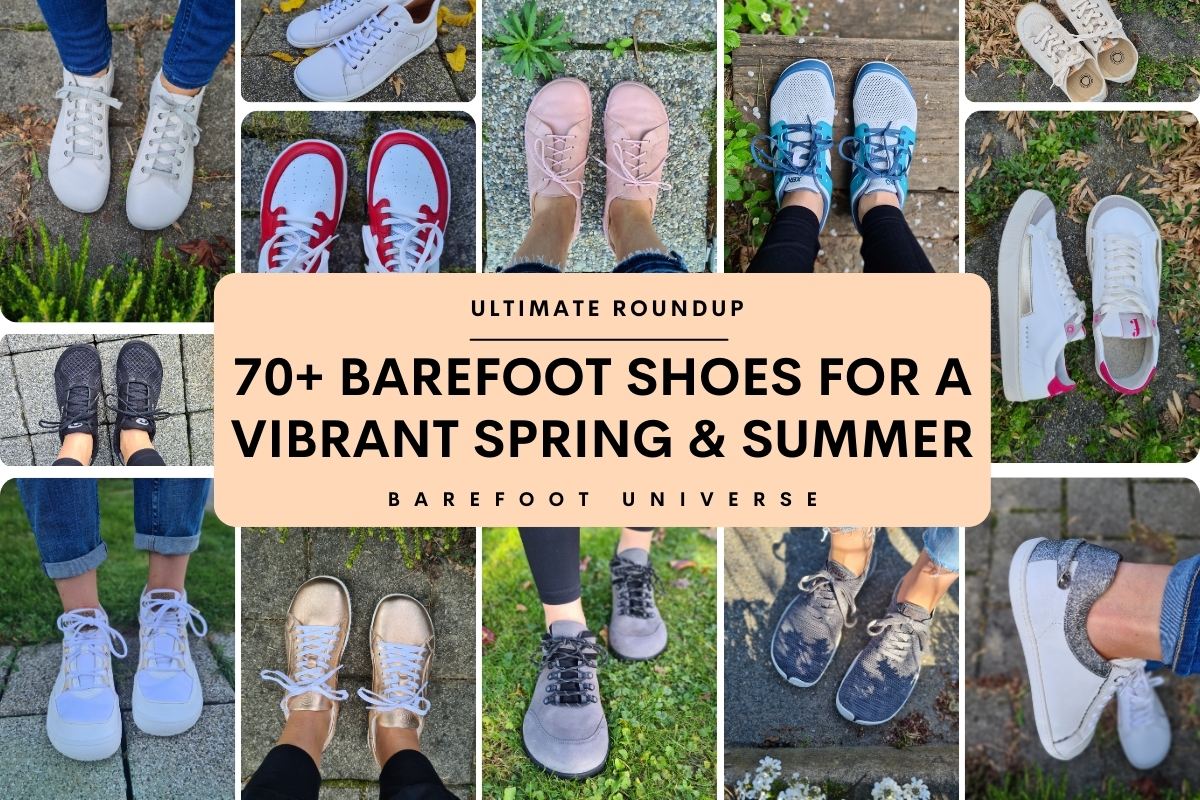
Barefoot Shoes: Ultimate Roundup for a Vibrant Spring/Summer 2024
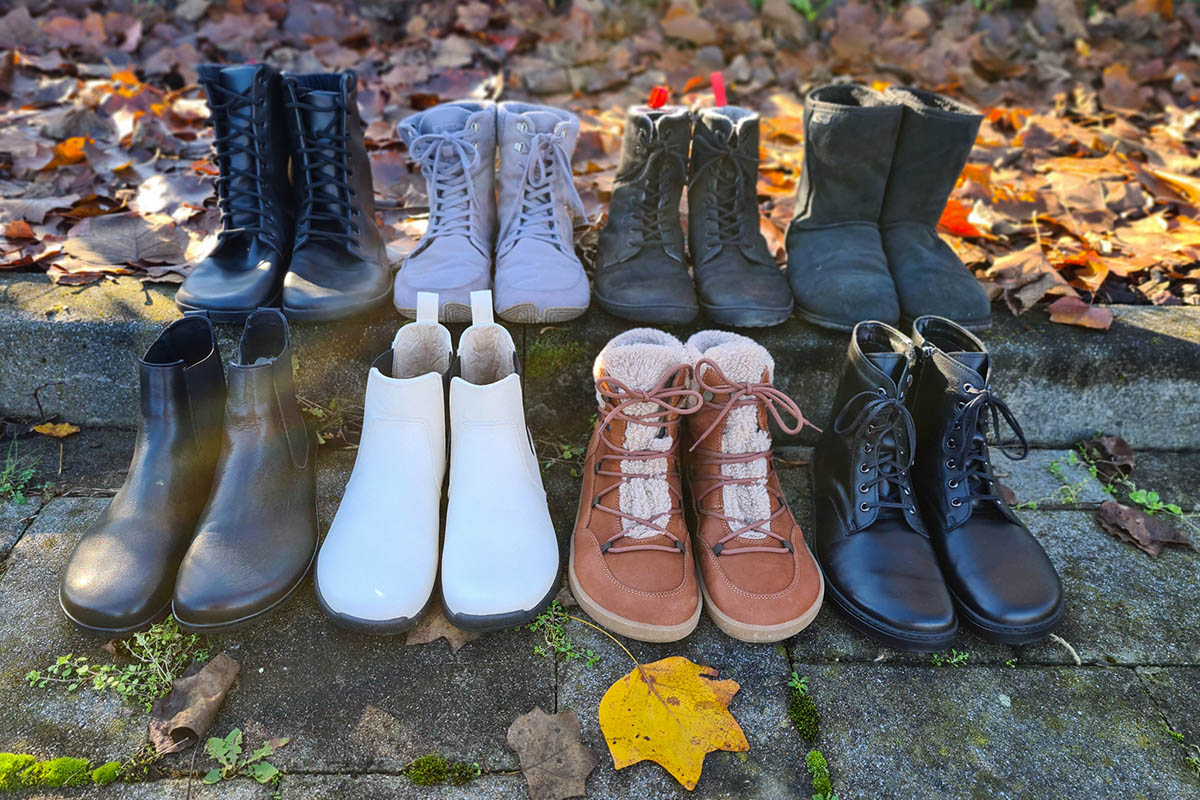
The Most Complete List of Winter Barefoot Shoes For Adults for 2023
Share this:.
- Click to share on Facebook (Opens in new window)
- Click to share on Twitter (Opens in new window)
- Click to share on Pinterest (Opens in new window)
- Click to share on WhatsApp (Opens in new window)
- Click to share on Telegram (Opens in new window)
- Click to print (Opens in new window)
how does the Realfoot Toebox compare to Softstar? Especially the Primal Sawyer or similiar models? I own the Realfoot City Jungle but had to size up because the taper is too aggressive for my pinky. It doesn’t have enough space in front of the toe, even though I left 12 mm space in front of my longest toe.
The Softstar Primal Sawyer seems to have less taper, but maybe the pictures deceive.
Hi Chris, we cannot directly compare it to the Softstar Primal Sawyer as we don’t have it, but we can compare it to the Softstar Switchback boots. There is more vertical space in the Realfoot Trekker than in the Softstar Switchback, and therefore, the Realfoot feels wider than the Softstar, even though the outsole shape is almost the same in the toe area. I have more space for my pinky toe in the Realfoot. Hope this helps!
thanks for your fast response. That was helpful and saves me from trying out Softstar then, since I already had to size up the Realfoot because of missing pinky space.
Since you already tested the barefoot+ Models from Groundies: how do they compare space wise to Realfoot shoes, especially for the pinky toes?
Going purely by the numbers the Groundies look less wide (even if I add the 5mm you mention in your review), and the taper on the pinky seems more aggressive (so easier to touch the front with the pinky toe). Is that correct?
Hi Chris, Groundies Barefoot+ are not as wide as Realfoot. I have much more space for my pinky toe in Realfoot than in Groundies. However, Groundies are slightly wider in the midfoot and heel parts.
Leave a Comment Cancel
Your email address will not be published. Required fields are marked *
Email Address *
Save my name, email, and website in this browser for the next time I comment.
Hi, we are Katja and Tjaša, and we are dedicated to helping you get started with barefoot shoes. We believe that everyone should be able to walk without pain and enjoy the benefits of going barefoot. With our personal experience and knowledge gained, we have created this blog to guide and support others on their journey towards a healthier lifestyle.
Popular Posts
- Are VIVOBAREFOOT Worth the Hype? A Deep-Dive Review 138 views
- Happy Feet Start with Toe Socks: What You Need to Know for Optimal Foot Health 73 views
- Are Xero Shoes Right For You? A Detailed Guide 40 views
- Wildling Shoes Review: Is This Your New Favorite Shoe? 31 views
- Groundies Shoes – Yay or Nay? Our Honest Review! 30 views

The Best Hiking Shoes for Thru-Hiking of 2024
T hink of your hiking shoes as an investment in your future happiness. Choosing the right pair can mean the difference between success and failure on a thru-hike. And, more generally, between a happy hike and a blistery sufferfest. In this post, we’ll share our picks for the best hiking shoes for thru-hiking and backpacking, as well as tips on how to choose your footwear.
READ NEXT — The Best Trail Runners for Thru-Hiking
Best Hiking Shoes for Thru-Hiking: Quick Navigation
Merrell Moab 3 (Best Budget Hiking Shoe) Keen Targhee II (Best Hiking Shoe for Wide Feet) Oboz Sawtooth (Best Insole) Salomon X Ultra 4 Low (Best for Rough/Technical Terrain) Hoka Anacapa (Most Comfortable Hiking Shoe) Danner Trail 2650 (Best Lightweight Hiking Shoe)
Best Hiking Shoes FAQs
What’s the Difference Between Hiking Shoes, Boots, and Trail Runners? Waterproof vs. Non-Waterproof Hiking Footwear Terminology After-Market Insoles Blister Prevention
About This Year’s Picks
Please note that this post covers hiking shoes — a type of footwear partway between a trail runner and a hiking boot ( see below for more information on different types of hiking footwear ). If you prefer trail runners for thru-hiking, we have a separate post about that . If you prefer full boots, every shoe on the list below also has a mid-boot version to provide more ankle support.
Weights listed below are for a pair of medium-sized shoes (sizes 8 or 9). For consistency’s sake, we featured the non-waterproof version of every hiking shoe in the list below (except for the Keen Targhee). Waterproof versions are also linked in the descriptions.
The Best Hiking Shoes for Thru-Hiking
Merrell moab 3 ( women’s | men’s ) (best budget hiking shoe).
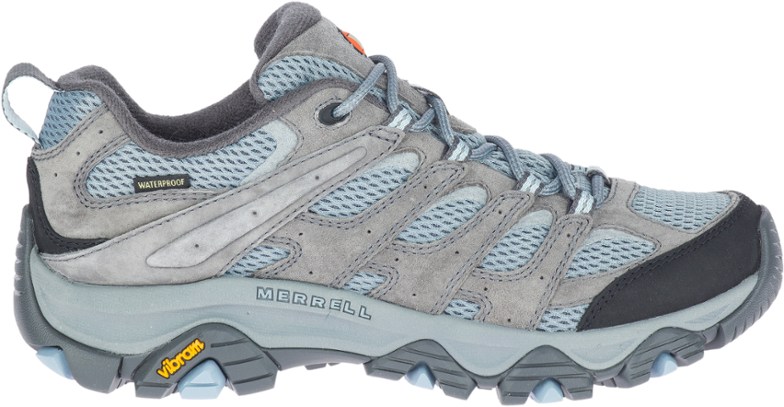
Best hiking shoes for thru-hiking: Merrell Moab.
MSRP: $120 Weight: 26 oz women’s | 33 oz men’s Upper Materials: Pigskin leather and mesh Waterproof version: Women’s | Men’s
Pros: Vibram soles; made with recycled materials; affordable Cons: Heavy; not the most durable hiking shoes
The Merrell Moab 3 was released in spring of 2022. The newest update features partially recycled materials (the mesh lining, laces, and webbing are all 100 percent recycled. The Moab 3 has also been upgraded to a gripper version of its classic Vibram outsole and a more cushioned midsole.
In our experience, Moabs tend to wear out after 600 or 700 miles, making them scarcely more enduring than a trail runner (though we’ve heard reports of them going much further). Superior durability is one of the main advantages hiking shoes and boots have over ever-popular trail runners, so this is a bit disappointing.
In fairness, the reduced durability could have something to do with the large amount of mesh in the shoe’s upper — and the abundance of mesh is a pro in our books since it improves breathability.
And even with a potentially shorter lifespan, the Moab is still very affordable. The $120 list price is dramatically lower than every other hiking shoe on this list, as well as all of our favorite trail runners for thru-hiking).
Finally, it’s worth noting that this shoe was the most popular hiking shoe among AT thru-hikers last year in our 2022 annual survey (excluding trail runners).
Return to top
Keen Targhee ( Women’s | Men’s ) (Best for Wide Feet)

Best hiking shoes for thru-hiking: Keen Targhee.
MSRP: $145 Weight: 26 oz women’s | 32 oz men’s Upper Materials: Nubuck leather Non-waterproof version (discontinued): Women’s | Men’s
Pros: Nubuck leather uppers; contains recycled materials; durable and supportive Cons: Relatively expensive; heavy; not very breathable; heel lining tends to wear out quickly
Keen’s footwear runs wide from the heel all the way through the toebox, and the Targhee is no exception. This durable, supportive shoe features a dual-density EVA foam midsole for maximum comfort and stability.
The Targhee’s upper is made with premium nubuck leather; it’s not the only shoe on this list to use that material, but it’s the only one that achieves that classic leathery look akin to a traditional hiking boot. Keen uses leather from a tannery rated by the Leather Working Group, a nonprofit that developed standards for more sustainable leather production. The dark side of a mostly leather upper is that they aren’t the most breathable hiking shoes on the planet.
Oboz Sawtooth X Low ( Women’s | Men’s ) (Best Insole)
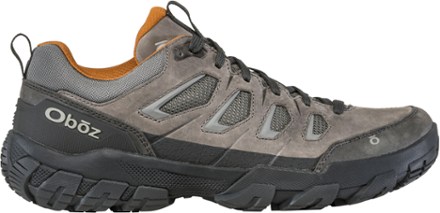
Best hiking shoes for thru-hiking: Obox Sawtooth.
MSRP: $135 Weight: 27 oz women’s | 32 oz men’s Upper materials: Oiled nubuck leather and Cordura mesh Waterproof version: Women’s | Men’s
Pros: Quality insole; recycled materials in laces and webbing Cons: Longtime users say sizing/fit have changed a lot with the latest version; heavy
Most shoes come with flimsy, terrible inserts that provide no support or protection, hence many hikers swap them out for a $50 aftermarket upgrade to keep their feet happy. Which is a fine solution, but it’s refreshing that Oboz actually bothered to manufacture an insole that’s comfortable from the start. Not having to replace the insert will save you beaucoup bucks, plus it’s one less thing headed straight for the landfill when you buy new shoes. Oboz even sells their O-Fit insoles separately so non-Oboz wearers can get in on the fun.
The Sawtooths are on the heavy side for a hiking shoe, but that extra material translates into superior support and stability. They’ve been on the market for 10 years now — hence the X in the name — with no sign that they’re going away any time soon. It’s worth noting that some longtime Oboz users have reported that the newest Sawtooth fits differently throughout.
Although our annual AT thru-hiker survey is always heavily skewed toward trail runners, this shoe was one of the only true hiking shoes to rank in 2022.
Salomon X Ultra 4 Low ( Women’s | Men’s ) (Best Technical Hiking Shoe)
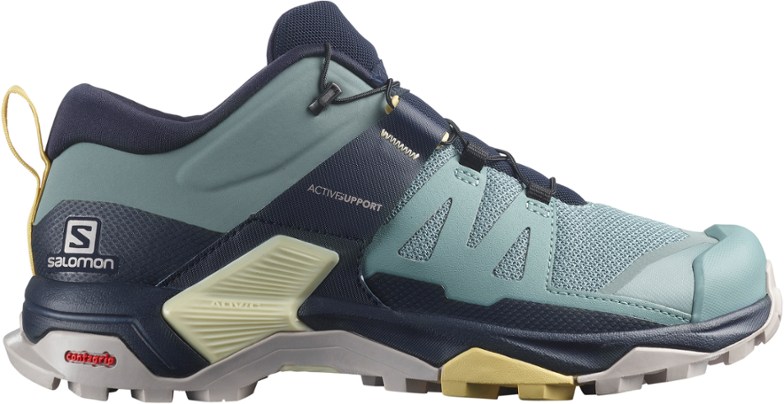
Best hiking shoes for thru-hiking: Salomon X Ultra 4 Low.
MSRP: $140 Weight: 22 ounces women’s| 26 ounces men’s Upper Materials: Synthetic/textile Waterproof Version: Women’s | Men’s
Pros: Lightweight; ADV-C chassis improves stability; woman-specific fit Cons: Quicklace is not for everyone; made with virgin materials; polarizing style
While the Salomon X Ultra’s boxy NASA aesthetic isn’t our cup of tea, it reflects the shoe’s highly engineered, technical nature. Every aspect of this shoe was designed intentionally to optimize foot mobility and support. Even better, the women’s version isn’t just a smaller version of the men’s, it’s a woman-specific design featuring softer materials in some areas and a less dense chassis.
The rubber outsole is very grippy, and the synthetic upper materials are durable and resist wear and tear on rugged trails. The shoe also features Salomon’s ADV-C chassis, a molded insert embedded in the outsole to improve stability and flexibility, and Salomon SensiFit to cradle the foot. The marketing buzzwords are mind-boggling, but they translate to noticeable improvements in function.
Moreover, the Salomon X Ultra is relatively light at 22 ounces for a women’s medium, saving you energy with every step.
Like most Salomon shoes, the X Ultra is a great choice for lazy lacers thanks to its tension-adjustable Quicklace system. (Quicklace is also a great feature if you hate trying to tie your shoes with numb fingers on freezing mornings.) On the flip side, hikers who want to use special lacing techniques will dislike that the lace pulls make this impossible.
If you’re looking for a hiking shoe for casual strolls on groomed trails, this is not your shoe. If you’re heading out on rugged, rocky, uneven terrain, you can’t do better than the X Ultra 4.
Although our annual AT thru-hiker survey is always heavily skewed toward trail runners, this shoe joined the Moabs and Sawtooths as one of the only true hiking shoes to rank in 2022.
Hoka Anacapa Breeze Low ( Women’s | Men’s ) (Most Comfortable Hiking Shoe)

MSRP: $155 Weight: 20.4 ounces women’s | 25 ounces men’s Upper Materials: partially-recycled polyester engineered knit Waterproof Version: Women’s | Men’s
Pros: Moderate cushioning; stylin’ colorways; contains recycled materials; Vibram outsoles Cons: Fit a bit narrower than typical Hokas, particularly in the toebox
Everything about the Anacapa, from the plush EVA foam midsole to the padded, gusseted tongue (designed to keep debris out of the shoe), is crafted with comfort in mind. The insole is made with 50 percent recycled soybean oil and is supposed to be molded for comfort (though you might still want to consider upgrading to a more robust aftermarket insole).
Many think of plush, maximal cushioning when they think of Hokas. However, the Anacapa features balanced, moderate cushioning that trends closer to firm. It strikes an excellent balance between comfort and responsiveness.
The Anacapa is newly available in a non-waterproof, which is a welcome addition to this product line, which we have loved and featured before despite the lack of this lighter weight, more breathable option.
Danner Trail 2650 ( Women’s | Men’s ) (Best Lightweight Hiking Shoe)
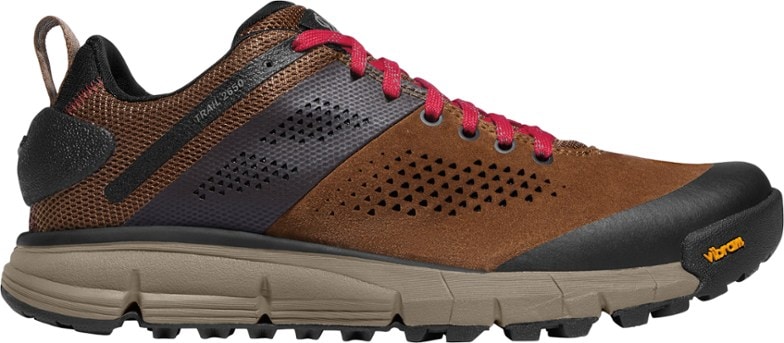
Best hiking shoes for thru-hiking: Danner Trail 2650.
MSRP: $170 Weight: 18 ounces women’s | 24 ounces men’s Upper Materials: Suede leather/textile Waterproof Version: Women’s | Men’s
Pros: Grippy Vibram sole; style points; lightweight Cons: Expensive; not very breathable; narrow toebox; made with virgin materials
Most of us picture Cheryl Strayed’s iconic brown leather boots with red laces from Wild when we think of Danner hiking shoes. But although Danner’s Trail 2650 shoe was named for the PCT, they don’t have much in common with the boot Strayed famously threw off a cliff in frustration partway through her LASH (although they do have the classic brown/red colorway).
Like the Merrell Moab above, the Trail 2650 is a great choice for hikers with narrow feet. It’s also a remarkably lightweight option: a pair of women’s mediums weighs just 18 ounces (or 24 for men’s), which puts this shoe on par with many popular trail runners weight-wise.
In addition to the weight savings and style points, we love the Trail 2650’s choice of a grippy Vibram outsole. On a less positive note, the shoe doesn’t offer as much ankle support as some of the beefier options on this list. With reduced support, one wonders if breathable mesh trail runners would be a smarter choice than these relatively stuffy leather numbers. But wait, Danner has thought of that too! The Trail 2650 is also newly available in a version with mesh uppers ( women’s | men’s ). Can we say SoCal desert?
Best Hiking Shoes for Thru-Hiking: FAQs
What’s the difference between hiking shoes, boots, and trail runners.
Trail runners are running shoes specifically designed for rugged trails rather than pavement. They look like sneakers and are the lightest, most breathable, but least durable or supportive type of hiking footwear. Trail runners are the most popular footwear choice among thru-hikers; we have an entire post about the best trail runners for thru-hiking .
Hiking boots are what most people picture when they think of footwear for the trails. They have high-rise ankle support and are stiffer/more durable overall. They weigh a lot more than trail runners and don’t breathe as well, but a pair of boots will last much longer and provide better support for your foot. A boot’s stiffer sole is also a better tool for kicking steps in hardened snow
Hiking shoes are a compromise between trail runners and boots. Many hiking shoes are just low-top versions of popular hiking boots, like the Merrell Moab. Hiking shoes may also use materials that fall between boots and trail runners in terms of breathability and durability. If you want a little more support and durability than trail runners offer but without the crushing weight penalty of boots, hiking shoes are worth a try.
Waterproof vs. Non-Waterproof
Many retailers push waterproof hiking shoes pretty hard, but we recommend the non-waterproof version in most cases. The trouble with waterproof footwear is that it’s just as good at trapping moisture inside as keeping it out. When the inside of your shoe inevitably gets wet, whether due to foot sweat or snow/rain finding its way in through the top, it will take much longer for a waterproof shoe to dry out than a ventilated one. By the same token, they also trap heat.
We do recommend waterproof footwear for early-season hikes where you expect to encounter snow. Not only will your shoes keep you warmer if they’re waterproof, but they will help to keep snow from infiltrating, especially if you wear long pants or gaiters over the top to keep it from getting in the top. You might also want high-top boots for four-season hikes for the same reason.
For consistency’s sake, we featured the non-waterproof version of every hiking shoe in the list above when available. Waterproof versions are also linked in the descriptions.
Hiking Footwear Terminology
It’s useful to understand common shoe-related vocab when comparing shoes. Here are some terms you’ll come across frequently.
Upper: The “main body” of the shoe/the flexible material above the midsole. Usually made of durable mesh or leather.
Insole: A removable footbed insert located inside the shoe that provides cushioning to your foot. Many hikers upgrade to aftermarket insoles like Superfeet that offer better and more targeted support than the factory version. Also called a sockliner.
Midsole: The rubber bit between the insole and the outsole.
Outsole: The grippy rubber bottom of your shoe where all the tread is located.
Rock plate: A nylon shank found in the midsole of some trail runners to protect your sole from sharp rocks. Most common in trail runners.
Heel-to-toe drop: The height differential between the shoe’s heel and toe, normally measured in millimeters. The heel is elevated higher than the toe in most shoes so that the toe points slightly down, but some minimalist shoes have zero drop (no height difference between the heel and toe).
After-Market Insoles

Many hikers swap out the flimsy insoles that come standard with most hiking footwear for a beefier, more supportive after-market offering. Superfeet , available at REI and most other outfitters, are especially popular. If you go this route, swap out your Superfeet every time you replace your shoes to maximize the benefit.
Yes, they’re a bit expensive, but you won’t be able to finish your thru-hike if you ruin your feet, so this is an area worth investing a little extra. If you still struggle with foot pain, it might be worth visiting a podiatrist and getting custom orthotics that are molded to your unique foot shape.
Blister Prevention
Finding a shoe that fits your foot perfectly (and finding the correct size of that shoe) is probably the most important step you can take toward blister prevention. Everyone’s foot is different, and there’s no one-size-fits-all approach to this problem: you just have to figure it out through trial and error.
If you’ll be thru-hiking, bear in mind also that your shoe size may increase over the course of your hike. Because you can’t predict whether and to what extent your shoe size will change, we recommend starting with a pair of shoes that fits your feet now rather than starting a size too big in anticipation of a change that may or may not happen. The start of a thru-hike is challenging enough without adding the difficulty of too-big shoes.
Other methods include:
- Cover potential hotspots with Leukotape as soon as you feel them.
- Slather on some Vaseline to reduce friction.
- Wear a thin, protective pair of liner socks under your primary socks. Opt for toe socks for maximum protection.
- Use the heel lock lacing method to keep your feet from sliding around in your shoes.
More of the Best Thru-Hiking Gear of the Year
- Best Trail Runners for Thru-Hiking
- Best Tents for Thru-Hiking
- Best Rain Jackets for Thru-Hiking
Why should you trust us?
Because we’re so incredibly intelligent, of course! Attractive, too. (Not to mention extremely humble).
But if that isn’t enough to impress you, there’s also the fact that everyone who contributed to this article is an experienced thru-hiker with thousands of on-trail miles under their belt. We’re gear nerds who love putting our equipment to the test on trails long and short, and we’ve tested dozens of shoes in pursuit of a smoother, more comfortable hike.
Moreover, we survey hundreds of Appalachian Trail thru-hikers every year to learn about their behaviors, demographics, and — you guessed it — gear preferences. That means our picks for the best hiking shoes for thru-hiking aren’t just our opinions: they’re based on years of feedback from the thru-hiking community.
Check out AT hikers’ favorite footwear from the 2018 , 2019 , 2021 , and 2022 thru-hiker surveys.

This website contains affiliate links, which means The Trek may receive a percentage of any product or service you purchase using the links in the articles or advertisements. The buyer pays the same price as they would otherwise, and your purchase helps to support The Trek's ongoing goal to serve you quality backpacking advice and information. Thanks for your support!
To learn more, please visit the About This Site page.

We are the word nerds of The Trek who want nothing more than to infuse some hiking and backpacking joy into your day.
I need a best hiking shoes and low price
Great article. Unfortunately for me, I have large feet, size 12 4E. The more I hiked the wider my feet got. None of the shoes reviewed would even come close to fitting me. New Balance used to be good but 10 years ago they changed and now Hitchcock Shoes are the only ones I know of that will fit.
I love Green Superfeet. I had Plantar fascitis and they made the pain go away. Love them.
If anyone has suggestions for other shoes please let me know.
What Do You Think? Cancel reply
The Best Hiking Shoes of 2024
Stay comfortable and agile on the trail with the best hiking shoes for men and women. From day trips to thru-hikes, we've got you covered.

Summer means long days, warm temps, and miles on the trail. And while we love a good pair of hiking boots, a hiking shoe is ideal for many trail adventures. They’re light and easy to move in, and they keep your feet cool. You’ll give up a bit of ankle support with a shoe, but many find that the increased comfort and performance are well worth the trade-off.
The footwear you choose for your adventure is arguably one of the most important elements of your kit, and it’s vital to find the shoe that works for you and the goals you have in mind. With so many brands and designs on the market, it can be difficult to choose which hiking shoe is best for you. We hope this guide assists in wading through the masses of models out there, and helps you dial in on the perfect fit. Whether you’re staring down the barrel of a months-long thru-hike, or need something to walk the dog with every evening, there’s a shoe here for you.
With the traditional pressure to wear hiking boots for long treks wringing in his ears, current author Chris Carter set off on each trail of the Triple Crown (PCT, CDT, and AT) in lightweight hiking shoes — and never looked back. He’s now a firm believer in shoes’ ability to perform just as well as boots on extended journeys, and much prefers them for their lightweight mobility and long-term comfort.
Chris is always lacing up in the newest kicks as soon as they surface, testing the competition, and seeing if they deserve any real estate in this guide. He’s tested over 20 different models in the past year alone. Scrambling across alpine scree in the San Juans, slogging up muddy Appalachian slopes, and plodding across the blistering African savanna, he put a multitude of different models through the wringer to bring you the streamlined selection you see today. Rest assured, each of the shoes below will carry you hundreds — if not thousands — of miles across brutal terrain.
Our included comparison chart allows for quick and easy comparison, while our comprehensive buyer’s guide and FAQ section will let you know exactly what to look for as you consider your options.
Editor’s Note: We refreshed this article on November 28, 2023, adding additional details about our testing practices, and information about the lifespan of hiking shoes and hiking shoes’ breathability. We also made sure our product list is up-to-date with current models, color schemes, and designs.
- Best Overall Hiking Shoes: Altra Lone Peak 7
- Best Budget Hiking Shoes: Merrell Moab 3
- Best Hiking Shoes for Style & Function: Danner Trail 2650
- Best Water Hiking Shoes: Astral TR1 Water Hiking Shoe
- Best Travel Hiking Shoes: Lems Trailhead Hiking Shoe
- Best Hiking Shoes for Summer Travel: Salomon X Ultra 4 Low
- Best Hiking Shoes for Technical Approaches: La Sportiva TX4
Altra Lone Peak 7
- Weight 1 lb., 6 oz.
- Material Quick-dry air mesh
- Best use Thru-hiking
- Top attribute Wide toebox, zero drop

- Improved upper from the previous version
- Solid drainage
- Roomy toebox
- Minimal cushion
Another update to the legendary Lone Peak adds even more fame to this cherished classic. An absolute staple in the long-distance hiking and trail running communities, the Lone Peak is the pioneer of Altra’s brand and defines its unique style.
The new Lone Peak 7 still gives us that spacious, zero-drop experience we’ve grown to love, and we were grateful they didn’t change too much from previous models. It boasts the most room in any toebox you’re likely to find, and the foot-shaped last gives it an organic feel, allowing your toes to splay out naturally while hiking long miles. The update also comes with a wide version, for those who really need it.
The upper has evolved a bit in this new iteration. It is now entirely stitch-free with no-sew TPU overlays, giving it a sleek and streamlined look and feel. This not only adds style points. It also increases the shoe’s durability, as it eliminates potential failure points along the seams. We haven’t been able to fully test this update’s durability compared to previous models, but they do seem to be more bombproof than before.
The Lone Peak 7 includes new MaxTrac rubber in the outsole, allowing for better grip on wet rock and trail. They also feature a redesigned lug pattern with additional lugs for improved traction over sludgy terrain.
The Altra EGO technology of the midsole claims to add a little more responsiveness to each step, and we definitely noticed a difference compared to pre-Lone Peak 6 models. Something about it feels like a cushier, yet still responsive ride, and we’re fans of how well it carries over technical terrain.
The only complaint we can think of comes from others’ reviews of the wide version, as we only tried the regular width. From what we hear, the wide version is too wide and feels quite sloppy and unstable even for those who generally go with a 2E width.
All in all, the Lone Peak remains a top pick for die-hard hikers looking for a reliable shoe with a natural feel. Senior Editor Chris Carter wore an earlier iteration of the LP on a thru-hike of the entire Pacific Crest Trail, and still wears them today for long treks. The wide toebox and zero-drop profile take a little getting used to, but give you more of a connection with the ground you’re moving over, and help prevent blisters with plenty of room in the toebox. It still is, and will probably remain, a king in the backpacking and thru-hiking community.
Read our full review of the Lone Peak 7.
Merrell Moab 3
- Weight 2 lb., 1 oz.
- Material Pigskin leather and mesh
- Best use Day hikes
- Top attribute Durable, solid value

- Impressive traction and stability for a low-cut hiking shoe
- A bit heavy
- Requires a break-in period for peak comfort
It’s no surprise the Merrell Moab 3 is one of the top-selling hiking shoes. The side ventilation keeps feet cool during warm-weather hikes, and the pigskin leather and mesh upper hold up well through rocky scrambles, long day hikes, and multiday adventures.
We like that they provide some of the stability and traction generally found in a hiking boot with the low-top freedom of a shoe.
The toebox was wide enough that our testers didn’t experience any uncomfortable rubbing. But they are a bit stiffer, and we recommend slowly amping up your mileage. Give them time to break in, and you could have a great hiking shoe for seasons to come at a very affordable price point.
These aren’t the lightest hiking shoes available. And on technical or wet terrain, they didn’t perform as well as shoes like the La Sportiva TX4s , but the Moab 3s are winners for day hikes on regular trails. They’re also available in a waterproof version . Overall, they’re one of the best hiking shoes for regular use on moderate to easy terrain.
Danner Trail 2650
- Weight 1 lb., 8 oz.
- Material Leather
- Best use Day hikes, dry summer adventures, town-to-trail excursions
- Top attribute Out-of-the-box comfort, breathable, stylish

- Grippy outsole
- Expensive compared to other options
Danner is known for making high-quality, long-lasting hiking boots. And this is true of its hiking shoes, too. Inspired by the terrain of the 2,650 miles of the Pacific Crest Trail, the Trail 2650 is built to go the distance.
The mesh liner helped keep our feet cool and aided in breathability on hot summer hikes. In addition to the stylish looks, we really appreciate the fantastic grip these provided. We found them comfortable out of the box and suitable for all manner of day hikes.
Some testers wished they had more arch support, while others found them a perfect fit. This is a matter of personal preference and foot shape. The Trail 2650 shoe comes in several versions, including waterproof, mesh, and mid styles. Check out our full review of these Danner styles.
Astral TR1 Water Hiking Shoe
- Weight 1 lb., 5.2 oz.
- Material Ripstop 2-denier mesh with TPU overlays
- Best use Desert canyons, tropical trails, and trails with water crossings
- Top attribute Easy-draining and quick-drying

- Roomy and comfortable toebox
- Great odor control
- Not the most supportive
If you like exploring slot canyons or trekking through soggy rainforests, a good pair of quick-drying hiking shoes is essential. North Carolina-based Astral is known for making bomber life jackets. And it’s bringing this same water-centric focus to shoes.
Whether you’re a paddler who also plans to hike or a hiker who happens to be near water, the TR1 shoes will keep your feet happy.
We like how light they feel on our feet and how easily they shed water. With holes at the front and back, they easily drain water and the mesh dries quickly. Plus, they help your feet breathe and stay cool even on dry trails.
The sticky rubber soles provided plenty of traction even when rock-hopping along the river’s edge. And we like that the wider toebox design of the TR1 gave our feet room to spread out.
The Polygiene-treated insole makes stinky shoes a thing of the past. This is an all-around great shoe for moderate hiking, tropical adventures, and all manner of watersports. If you’re taking a trip to Hawaii, for instance, these could be the best hiking shoes for the job.
Lems Trailhead Hiking Shoe
- Weight 1 lb., 7.4 oz.
- Material Microfiber and mesh
- Best use Adventure travel
- Top attribute Style and performance

- Comfortable
- Supportive midsole
- Requires some break-in time
Anyone looking for a single summer shoe will love the Trailhead . With plenty of comfort and style, it can easily transition from travel to trail to a night at the brewpub. Built for the trail but styled for the city, it’s the perfect go-to for adventure travel.
We’ve worn it during long days at the airport, hiking in the Rocky Mountains, and exploring the hills of northern Georgia. Through it all, it’s offered plenty of comfort and support.
The 4mm drop encourages a more natural footstrike without going into extreme minimalist territory. And the wider toebox gives your feet plenty of room to wiggle.
A firm EVA midsole can seem a bit stiff at first, but you’ll reach maximum comfort after a few wears. The firmer foam molds nicely to your feet while providing needed support.
And anyone looking for a leather-free shoe can rest easy wearing this vegan-friendly option. If you have any summer travel plans that involve hiking, biking, sightseeing, or general adventuring, the Trailhead could be the best hiking shoe for you.
Salomon X Ultra 4 Low Aero
- Weight 1 lb., 6.4 oz.
- Material Nylon mesh
- Best use Summer hiking and technical trails
- Top attribute Breathable and light with plenty of grip

- Highly breathable
- Good traction
- Lightweight
- Not ideal for technical scrambling on rock and steep terrain
The Salomon X Ultra 4 Low is breathable, grippy, and comfortable. If you’re looking for a warm-weather hiking shoe, this is it. The polyester mesh panels help keep feet cool, and at about 1.5 pounds for the pair, they won’t weigh you down.
With the mudguards and extended toecap, we never had any problems with rocks or sticks jabbing our feet. And the lugs proved plenty burly even for technical trails.
The sole of the X Ultra 4 is surprisingly flexible, which our testers enjoyed. But if you’re looking for something stiff, you may want to choose a different shoe.
Another feature you’ll either love or hate is the Quicklace system. Pull the lace, and it locks into the desired tightness. We’ve found it works well and doesn’t need retightening throughout the day. However, it can limit how specific you get on tightening your shoe.
All in all, these shoes offer traction and comfort while keeping feet cool. With this Salomon offering, you get a do-it-all shoe for $140. The women’s version seems to run a bit large, so we recommend going down a half-size.
Designed with relative simplicity with technical features where you need them, we think the X Ultra 4 is one of the best hiking shoes on the market today.
La Sportiva TX4
- Weight 1 lb., 10 oz.
- Material Nubuck leather
- Best use Technical approaches or rocky scrambles
- Top attribute Tacky rubber, durable leather upper

- Extremely sticky rubber for rocky terrain
- Supportive but cushioned
- Durable, abrasion-resistant leather upper
- On the heavy side
- Leather can shrink when wet
If long miles over technical, rocky terrain are on the docket, it may be time to call in the masters of stone — the approach shoe. Merging the comfortable, durable last of a traditional hiking shoe with the tacky stick-to-anything rubber of rock climbing shoes, approach shoes offer unparalleled traction and toughness.
The La Sportiva TX4s are better suited for off-trail travel in boulder-strewn, wet environments than for long-distance trekking on groomed trails — though we have heard tales of people hiking the entire Appalachian Trail in these. They are cozy enough to clock some serious miles in, but forgo some key elements of regular hiking shoes that contribute to comfort over the long haul. They have a more rigid, climbing-specific sole without much rocker to propel you into your next step, and aren’t near as flexible as other hiking shoes.
That said, the TX4s strike a surprisingly solid balance between stiffness and flexibility in comparison to other approach shoes we’ve tested, and we had no qualms taking these on multi-day demanding backpacking trips. Where they truly shine, however, is on long approaches to big climbs, where maximum traction on rocky routes is paramount. The stiff and grippy sole allows you to teeter on tiny stone edges, and smear your way across blank slabs with ease.
Our tester recently used these shoes on an ascent of El Cap in Yosemite, where he had to schlep massive haul bags to the base of the climb, and then plod for miles back down to the car on the steep descent trail afterward. Not only did he use them for the hike in and out, but actually climbed most of the moderate pitches on the route in them. They’re that sticky.
The burly nubuck leather upper and generous Vibram rubber wraparound rand give the TX4s a rugged, invincible feel, and shrug off serious amounts of torture. The Megagrip Traverse outsole features a Trail Bite heel braking system that boosts confidence while bombing down slippery scree fields or loose mucky trails.
While they may not be the best choices for long thru-hikes across the country, if low-5th-class approaches or technical rocky routes are in your future, these would be great companions.
HOKA Speedgoat 5
- Weight 1 lb., 4.6 oz.
- Material Recycled engineered mesh
- Best use Technical trails and long thru-hikes
- Top attribute Maximum cushion and lightweight durability

- Fantastic traction
- Lighter than previous models
- Superior cushion
- Gusseted tongue is a little short
- Not as stable due to high stack height
With superior traction, durability, and cushion, the Hoka Speedgoat has been a legacy shoe in the trail running and now long-distance hiking community for years. Its newest update, the Speedgoat 5 , doesn’t disappoint and carries on Hoka’s stellar reputation.
While the Speedgoat definitely lets you push the pace, these things truly shine in their durability and unprecedented comfort over the long haul. Though they used to only be worn by trail running aficionados, their reputation has recently seeped into the long-distance hiking community.
Senior Editor Chris Carter walked over 5,000 miles in the Speedgoats in 2021 on his thru-hikes of the AT and CDT and won’t hike in anything else now. He squeezed out about 700 miles a pair and experienced little durability issues.
The soles are fitted with Vibram Megagrip and 5mm lugs, somehow providing even more traction than previous iterations. They also shaved off half an ounce. This doesn’t seem like much, but every gram literally counts at the end of a grueling day on the trail.
The new model also features a bolstered heel collar, more comfortable features, and what feels like a more responsive midsole with what Hoka calls a “late-stage meta-rocker.” An initial gripe of ours is the new gusseted tongue. It’s kind of short and super thin. We liked the previous one better.
We appreciate the protective toe rand that wraps around the front of the shoe. This works well for those who tend to drag their feet as they get tired near the end of a long day. Despite the lighter weight, Hoka still managed to keep the cushion balanced and comfy, and seemed to even improve it a little.
For months-long epics across the country, or weekend backpacking trips to your favorite alpine lakes, Hoka’s Speedgoat 5 will get you there in about as much comfort as you could ask for. Check out our full review.
Merrell Moab Speed
- Weight 1 lb., 7 oz.
- Material TPU and mesh
- Best use Hiking, mild approaches
- Top attribute Grippy and comfortable for narrow feet

- Minimal break-in period
- Sneaker-like styling
- Not the most supportive structure
The closest thing to a bedroom slipper you can hike in, the low-cut Moab Speed light hiker is breathable, durable, and won’t cramp your style because it’s so darn comfortable from the moment you put it on.
Not every trail outing demands super-aggressive footwear. For more casual meanders, even when the road is rocky, uneven, or generally variable, this shoe was the ultimate in comfort.
The Moab Speed’s mesh upper is layered to keep out trail debris, including sand, pebbles, and thorns. Then, it’s reinforced with welded-on TPU for structure that feels soft and unrestrictive while keeping our feet balanced over the sole and midsole.
Although this shoe’s cushy EVA midsole looks and feels more like a sneaker, it’s made for the trail. The thickly padded tongue and padded collar protect our feet from getting rubbed by the laces. They also help keep debris out.
A well-protected toecap with a bumper over it not only prolongs the life of these hikers, but it also protects toes. And many parts of this shoe are recycled — including the lining and laces — to reduce the Moab Speed’s impact on the planet.
Brooks Cascadia 17
- Material Air mesh
- Best use Technical, slippery trails
- Top attribute Durable tacky outsole

- Articulated Rock Shield provides great protection but is still flexible
- A smidge heavier than previous iterations
- A bit stiff out of the box
There’s a reason Brooks is on its 17th iteration of the Cascadia : It’s a simple staple in the running and hiking community, and it continues to offer reliable durability for a whole slew of different activities.
Another classic trail runner that has eked its way into the hiking world, the Cascadia is being seen on more and more hiker’s feet, from weekend warriors to thru-hikers going the distance. The latest update keeps everything we loved from prior models, and offers improvements that focus on the comfort, protection, and sustainability of the shoe.
The Cascadia offers adequate cushion, with a 20mm heel that tapers down to 12mm in the forefoot. Brook’s Ballistic Rock Shield provides additional protection, which is sandwiched between two layers of that luxe DNA LOFT v2 foam we’ve grown to love from the Cascadia 16. This gives the runner noticeable defense against pokey protrusions on trail, without limiting flexibility.
The new PrintDyed air mesh upper is created more sustainably than previous iterations (saving 66% of the energy, and 75% of the water required for traditional dying processes), and affords a bit better ventilation than earlier models — though we haven’t had these shoes for long enough to fully test their upper’s durability compared to the 15 or 16. After a good deal of torture, though, it is showing little to no signs of wear.
New to the 17 is Brooks’ Trail Adapt System — a power combo of their DNA LOFT v2 cushion, rock plate, and strategically placed outsole pods that respond to uneven ground. Paired with their new sustainably made TrailTack Green outsole, these shoes performed quite well over loose, sludgy terrain. We’ve yet to find a proprietary outsole that could match something like Vibram or Vibram Megagrip’s tacky nature, but this does a surprisingly good job in wet, slippery conditions.
We have similar grumbles with the 17 as we had with prior models — namely its stiff nature out of the box, and heavier reading on the scale (even heavier than the 16). The shoe quickly becomes more flexible with use, but those first few hikes feel a bit rigid.
These qualms aside, the Cascadia is a top-shelf shoe that’s been at the forefront of hiking and running comfort for years. The 17 carries on its tradition as a standard bearer for long day hikes over rough trails, or extended backcountry backpacking trips alike.
Adidas Terrex Swift R3 GTX
- Weight 1 lb., 11.9 oz.
- Material Warp-knit textile
- Best use High mileage on marginal trails
- Top attribute Long-term value

- Highly capable on technical and slick terrain
- Supportive enough for heavy backpack loads
The sturdy Continental rubber outsole proves that this shoe from the evolving Terrex line is meant for the trail. Never mistaken for a running shoe, the Swift R3 GTX excels in nasty conditions, including moving across sidehill steeps and slick rock.
Feet are protected like few other models under test with a toecap crafted for apocalyptic rock falls and narrow canyons. Tensioned speed lacing allows fast on-trail adjustment, even as the padded collar minimizes Achilles trauma. A GORE-TEX lining keeps moisture out, but is still breathable.
Not for bouncing along tourist paths, this hiker craves bigger challenges and carries the load in multiday backpacking scenarios. Tight mesh uppers keep abrasion resistance high but can’t undo the weight of the beefy outsoles at around 28 ounces per pair.
We’d recommend trying these on before use, but if they fit well, the Swift R3 GTX is one of the better hiking shoes we tried for technical terrain.
Oboz Sawtooth X Low
- Weight 1 lb., 15.6 oz.
- Material Oiled nubuck leather and CORDURA fabric mesh
- Best use Mid-to-high-mileage backpacking journeys with loads up to 50 lbs.
- Top attribute Versatility

- Heavier than others
- Take forever to dry out if they get wet
Are you looking for a hiking shoe that offers more of a traditional hiking boot design? This below-the-ankle pick could be just what you need. The Sawtooth X Low slices through harsh terrain better than most mid-height hiking boots, and offers stellar durability with bomb-proof oiled nubuck leather and CORDURA fabric mesh.
The new Adaptive Cushioning Technology used in these shoes is an interesting touch. Dual-density rubberized EVA is designed to easily adapt to changing terrain. While we can’t say we fully felt the effects of this, this has a cushioned ride to it and a soft heel strike zone with solid shock absorption.
This shoe comes out of the box ready to hike. It promotes more foot freedom with a wider toebox and an “O fit” insole that combats shifting and boosts comfort even on daunting descents.
The lug pattern of the Sawtooth X gives plenty of grip, and the toe overlays prevent abrasion. Our testers are happy to report that even after significant abuse, these show little signs of wear. Plus, you can feel good knowing that Oboz plants a tree for every pair of shoes sold.
HOKA Anacapa 2 Low GTX
- Weight 1 lb., 14.7 oz.
- Material Recycled mesh
- Best use Technical hiking over sludgy, slippery terrain
- Top attribute Sustainable build with a tacky outsole

- Sustainably made
- Sticky Vibram Megagrip outsole with self-cleaning lug pattern
- Plenty of cushion
- Runs a bit large
- Extended heel cushion isn't everyone's cup of tea
- Pretty heavy
Hoka has always been about innovation — and can consequently be quite polarizing. From the inception of their brand, the folks at Hoka have churned out futuristic designs with bleeding-edge tech, in wild color schemes that pop off the shelf. True to their experimental nature, the newly minted Anacapa 2 Low GTX brings a unique flair to the traditional hiking shoe last, seemingly forcing people to either end of the spectrum. You either love ’em, or you hate ’em, but one thing’s for sure — there are few shoes like them.
Senior Editor Chris Carter recently got to spend several days testing the low and mid versions of the new Anacapa 2 in Zion National Park with Hoka developers, putting the shoes through the wringer and truly picking Hoka’s brain on its interesting design. While it’s not his steed of choice for long hikes, he’s convinced these are some of the more well-designed, and sustainably constructed shoes for those who don’t require an aggressive ride while clocking miles in the backcountry. The supremely tacky outsole and thoughtfully placed Meta-Rocker make these shoo-ins for any serious hiker’s shortlist.
To that last point, we’ve always been fans of Hoka’s Meta-Rocker technology — a curved silhouette with denser foam placed at strategic points in the midsole, giving each stride a degree of smooth propulsion. The Anacapa features a late-stage Meta-Rocker, which puts the rocker point closer to the toe for added stability with slower paces.
Though our editor prefers an early-stage rocker for swifter movement on the trail, this is perfect for those who want stable confidence over variable terrain, and aren’t too concerned about chasing FKTs. For most hikers, this is the design of choice.
Vibram Megagrip — hands down our favorite outsole — decorates the bottom of the shoe. Its performance on slippery, rocky terrain, or muddy, uneven trails is next to none. Qualms we’ve had with other Hoka outsoles were addressed with this shoe. Vibram can be rendered useless if mud packs in tight around the lugs, making the sole a single, sleek sheet that easily slips around.
The Anacapa 2 features a “self-cleaning” lug pattern that channels mud away from the lugs as you step, forcing it to slide off the sole, and allowing the deep sticky tread to work its magic. This, paired with a GORE-TEX Invisible Fit liner, makes these shoes power players in wet, sloppy conditions.
The protruding SwallowTail heel is perhaps the first feature you notice on the Anacapa 2 — and isn’t for everyone. It undeniably affords better traction and stability while bombing down uneven hills, but can sometimes snag on roots and rocks (or even the other shoe) as you clunk down trail. The jury’s still out on whether we dig this design, but it does provide solid surface area on the steeps.
We do find these shoes to be sized a bit large, so make an effort to try them on in-store before snagging a pair. These are also on the heavier (and pricier) end of the spectrum, but the comfort and cushion they afford atone for these sins. Nearly every element of the shoe is designed with recycled components, making this a much more sustainable shoe than the previous iteration, without sacrificing longevity.
For all-day comfort and stability on quick weekend outings, or extended journeys through all sorts of climates, the Anacapa 2 GTX would be a stellar companion for any adventure you could drum up.
Hiking Shoe Comparison Table

How We Tested Hiking Shoes
In our search for the best hiking shoes, we spent months on the trail. From the dry Arizona desert to the hot and humid Appalachian Trail, and the Rocky Mountains — we’ve logged a lot of miles.
The recommendations on this list are the result of intensive testing and thorough observation. “Hiking” is a broad term, and not all people who hike have the same needs. While compiling our roundup, we considered the intended use of each individual model. We paid careful attention to comfort, stability, outsole traction and grip, and long-term durability.
Staff Writer Mallory Paige led the charge with this guide back in May 2019, accruing our initial selection of 10 shoes. A dedicated hiker and backpacker, Mallory is a seasoned pro in the world of hiking shoes.
Senior Editor Chris Carter took over the guide in August 2022, and has been rummaging around his shoe rack and combing the interwebs ever since to bring you the most current, deserving selection possible. Chris has thru-hiked the Triple Crown of long trails in the United States: the Pacific Crest Trail, the Continental Divide Trail, and the Appalachian Trail. He’s plodded back and forth across the country in countless different models of shoes, and knows the importance of dialing in on the perfect fit for various adventures and terrain.
Our hiking shoe testing process is ongoing. As we continue to wear and assess new models, we’ll update our recommendations for the best hiking shoes on a regular basis.
Buyer’s Guide: How to Choose the Best Hiking Shoes

From day hiking to thru-hiking, the right pair of hiking shoes can become the most beloved and essential piece of gear in your kit. As the primary contact between you and the trail, your shoes make your adventures possible, and it’s imperative that they’re reliable.
While some still prefer the ankle support and robust structure of hiking boots , more and more hikers and backpackers are opting for the weight savings and nimble performance of hiking shoes. For any hiking endeavor, good-quality shoes are more than capable of handling a wide variety of terrain.
Because there are so many styles and variables, selecting the best hiking shoes for your unique needs can be difficult. In this guide, we include everything you need to know to select a pair of shoes that will treat your feet well and instill confidence in your stride.
Hiking Shoes vs. Boots

One of the main differences between hiking shoes and boots is the height. Whereas shoes have a below-the-ankle height, hiking boots offer full ankle support and high-top construction. What you give up in ankle support, you make up for in weight savings and out-of-the-box comfort.
Hiking shoes are great for day hikes, smooth trails, and anytime you want to go fast and light. For bigger backpacking trips with a heavier backpacking pack , you may want to consider a full hiking boot. That said, we know thru-hikers who swear by lightweight hiking shoes and day-trippers who won’t head out without their boots. It’s all about preference.
And while there isn’t a single best hiking shoe for everyone out there, we’ve broken down this list into categories to help find the best hiking shoe for you.

In recent years, hiking shoe technology has moved toward low-profile and lightweight designs. Modern fabrics and soles manage to be thinner and lighter without sacrificing performance on the trail. For long hikes and thru-hikes, the benefits of a light pair of shoes only grow as the miles wear on.
While many burly hiking boots weigh over 4 pounds per pair, hiking shoes tend to weigh around 2 pounds or less. If you like to go fast on the trail, or if you plan to do some trail running in your hiking shoes, light is undoubtedly better.
Yes, shaving ounces sometimes does reduce long-term durability. However, lots of pairs of shoes on this list are more than capable of holding up just as long as a hefty pair of boots.
With modern materials and advancements in design, you don’t need to give up durability to cut weight and gain comfort. The shoes on this list range from speedy lightweight models, like Hoka’s Speedgoat 5s at 1 pound, 4.6 ounces, to beefy but stalwart shoes like the Oboz Sawtooth X Low , tipping the scales at 1 pound, 15.6 ounces.

Comfort and Fit
Comfort is the most important factor for any pair of active footwear. The shape of the human foot varies wildly, and the shoe that feels comfortable to someone else might not be comfortable for you. Feet can be wide or narrow, arches can be high or flat, and heels can be bulbous or low volume.
When selecting a pair of hiking shoes, there is really no substitute for trying them on and paying attention to how they feel in action. Most people will want to seek out a fit that minimizes negative space but does not actively constrict or compress their feet or toes.
If your foot moves in the shoe, you’ll likely be dealing with blisters before long. In general, hiking shoes tend to be more comfortable than hiking boots . It’s totally possible to find a pair that you can happily wear all day long.

There are pros and cons to hiking in a pair of shoes that are billed as “waterproof.” When hiking on muddy and wet terrain, waterproof hiking shoes help keep your feet dry and comfortable. When your feet are wet, you’ll be more likely to develop blisters and other foot issues.
However, waterproof hiking shoes also tend to be warmer and less breathable. Once wet, waterproof shoes usually take longer to fully dry.
Most waterproof hiking shoes include a membrane in their liner (GORE-TEX is the most common) that keeps water from reaching the inside of the shoe. In addition, many hiking shoes are treated with a durable water-repellent coating, which can be reapplied after it wears off.
While it is good to prioritize dry feet, it is also important to remember that by sealing moisture out, you’re also sealing it in. Shoes with a waterproof liner are prone to becoming hot and sweaty in warm or humid conditions. All hiking shoes will soak through if they get very wet or become fully submerged, even if they’re labeled as waterproof.
Durability and Materials

The two primary areas of a hiking shoe that will suffer the most from wear are the upper and the outsole. On the top of the shoe, the upper is the material that determines how waterproof, durable, and breathable the shoe is overall.
Most hiking shoes include an upper made from nylon, mesh, leather, or a combination. Nylon is lightweight and breathable, but it may not hold up well to repeated abrasion.
Mesh tends to be the least hardy, but it is super breathable and makes a comfortable choice for the tongue of a shoe. Leather is significantly less breathable, and it is often found on heavier-duty hiking shoes because it holds up to wear.
Although heavier and burlier hiking shoes often have the advantage of durability, many modern lightweight options are impressively long-lasting, too. Softer rubber outsoles will wear through faster than dense, firm outsoles.
Hiking Shoes Lifespan
It’s important that you don’t wear your hiking shoes (or boots) for longer than you should. Just because your toes aren’t hanging out of holes on the side, doesn’t mean the shoe has more life in it. Each manufacturer recommends different mileage for each shoe, but as a general rule, you want to replace your hiking shoes after 300-800 miles.
Many trail running shoes-turned-hiking shoes (such as Altra’s Lone Peak and Brooks’ Cascadia ) are not designed to handle the same level of abuse as dedicated hiking shoes. It’s a good idea to retire shoes like these after between 300 and 500 miles. Stalwart hiking shoes (like Merrell’s Moab or Salomon’s X Ultra 4 Low Aero ), crafted for endless days on trail wearing a heavy pack will last you between 500 and 800 miles before you should lay them to rest.
It’s important to keep a rough estimate of the number of miles on your hiking shoes to avoid injury on trail. We like to keep a running document on our computer with a list of what trips we’ve done on each shoe, and how many miles were added each time. This may not be necessary for you personally — but we clock a heck of a lot of miles each year and have several different shoes in rotation.

Stability and Support
A shoe’s support comes from the construction of its components, including the sole and the midsole. These underfoot layers can be thick and sturdy, or thin and floppy.
For hiking, most people prefer a shoe that is stiff and stable through the middle part of the foot, but slightly more flexible near the toe. This allows your foot to feel supported without sacrificing the ability to flex your toes.
Most hiking shoes have a low-cut ankle collar. If you are seeking lots of ankle support, hiking boots are probably a better choice.
Lacing Systems

The way a shoe laces up can make or break your big-mile adventure. Not being able to find a comfortably snug fit or fighting with constant loosening are both frustrating trail experiences.
Some shoes have a single-pull system. And while it looks delicate and breakable, we’ve had no issues with long-term durability. Many testers find this system allows for a dialed fit, and we appreciate the ability to make quick adjustments.
That said, it’s harder to create a more custom tightness with quick laces. They tend to provide the same tension across the entire foot. If you prefer to create pockets of snugness across your foot, go with a traditional lacing system.

The bottom of a good hiking shoe will feature a firm and grippy outsole. Vibram is the most common manufacturer of outsoles, although some footwear companies make their own.
A sturdy outsole is a major feature that sets a hiking shoe apart from a sneaker or tennis shoe. On a wide range of surfaces from loose scree to slick rock, a good hiking shoe will maintain reliable traction.
Many hiking shoe soles are designed to specialize in certain types of terrain. If you’ll be regularly hiking through unstable surfaces like deep mud, you’ll want a sole with firm, large rubber lugs underfoot.
If you plan to do a lot of scrambling and smearing your feet on slabs of rock, a soft and sticky rubber sole with a flat toe edge is the way to go. Many entry-level hiking shoes will include a versatile sole that will perform fairly well on any hiking surface.
Some manufacturers have specific, niche approach shoes for technical rock scrambling on long approaches and walk-offs of big rock climbs. These shoes, like the La Sportiva TX4 in this guide, have super tacky rubber, and midsoles designed for smearing and adhering to rocks.

Breathability
A shoe’s breathability comes from the materials that make up its construction. Areas of open synthetic mesh and woven nylon will greatly increase breathability.
Meanwhile, large patches of leather and waterproof membranes like GORE-TEX will decrease breathability, but add significant durability. A breathable shoe will feel cooler and less sweaty over the course of a rigorous hiking day, but usually won’t last as long.
However, breathable shoes are more likely to soak through to your socks when hiking in the rain or trudging through puddles. Shoes billed as “waterproof” may feel hot and sweaty at times, but they also help keep mud and moisture from reaching your socks and feet.

The cost of hiking shoes varies, and it is possible to buy a quality pair without breaking the bank. There are many excellent and long-lasting pairs with reasonable price tags. However, you may find that some lower-priced shoes come with fewer features, such as a waterproof liner or a Vibram sole.
The general price range of modern shoes is about $75-200, although there are some exceptions. After lots and lots of testing, we have determined that the cost of a pair of hiking shoes is not necessarily a direct indicator of performance.

The best hiking shoes are the ones that fit your feet comfortably and allow you to enjoy your time on the trail. When combing through the options, your first priorities should be fit and comfort.
Durability, support, and traction are important, too, but ultimately none of that matters if the shoes hurt your feet.
Also, no single pair of hiking shoes will be the very best for every application. The materials, design, and tread pattern will add up to a set of strengths and weaknesses in every shoe.
The current momentum in hiking footwear has shifted away from bulky ankle-high boots in favor of nimble, lower-cut hiking shoes. Hiking boots are heavier, and weight carried on your feet can feel very uncomfortable at the end of a full day. Switching out a 4-pound pair of boots for a 2-pound pair of hiking shoes can make a huge difference in your performance.
Also, many hiking boots have very stiff soles that keep the foot from flexing properly. Many boots are constructed with nonbreathable materials, meaning that your feet are more likely to get sweaty and form blisters. That said, hiking boots can be a great option for those who prefer lots of ankle stability or underfoot stiffness.
Hiking shoes are generally similar in shape to a pair of trainers or tennis shoes. The difference is that hiking shoes are built with durable materials and feature an outsole that is made to grip dirt, rocks, and mud. Compared to boots, hiking shoes feel light, nimble, and somewhat less supportive.

That depends. Keep in mind that no pair of hiking shoes is entirely water-resistant. Although some are marketed this way, full submersion in a puddle for more than a few seconds will soak through just about any pair of hiking shoes. Also, because they are low cut around the ankle, water is prone to getting in at the top of the shoe anyway.
Still, waterproof shoes do include membranes, like GORE-TEX, that can keep a significant amount of moisture out. When walking through dewy grass or muddy trails, waterproof shoes will keep your socks and feet drier than non-waterproof shoes.
Shoes with waterproof membranes are less breathable. If you will be hiking in hot and dry areas, you’ll probably feel more comfortable in non-waterproof shoes.

For the most part, sneakers are designed to perform on artificial surfaces such as asphalt or cement. Many sneakers have flimsy soles and lack the appropriate level of support that is needed for hiking on uneven terrain. Additionally, sneakers are less likely to hold up to the abrasion and wear that is common while hiking on rough trails.
If you plan to mostly walk on flat trails in urban parks or backyards, you’ll probably be just fine with sneakers. However, for hikes of any significant length — and especially backpacking — hiking shoes are a much better choice.
Barefoot shoes are designed to allow your foot to flex naturally with every step. Thanks to their thin and flexible materials, barefoot shoes let you feel the texture of the trail in the soles of your feet.
With each step, the tissues of your feet directly respond to the trail, conforming and contracting as needed. As the name suggests, the experience is similar to walking barefoot.
While barefoot shoes are known for helping hikers and runners develop strong feet, they do take some getting used to. If you have been hiking in boots or hiking shoes, the transition to barefoot shoes will need to be gradual. If you do too much barefoot shoe hiking too soon, you may experience discomfort or quickly develop an injury.
Barefoot shoes lack insulation. They also will not protect your feet from sharp objects underfoot and may be quick to wear out. While some experienced hikers have made the transition to barefoot shoes, we generally do not recommend them to beginners.

The Best Hiking Boots of 2024
If you’re looking for the best hiking boots, look no further. We’ve tested dozens of hiking boots over hundreds of miles to help you stay happy and comfortable on the trail.

The Best Hiking Boots for Women in 2024
We tested the best women’s hiking boots of 2024 with options for every budget. Top picks include SCARPA, Merrell, and more!

Based in beautiful Chattanooga, Tennessee, Chris Carter is a Senior Editor for GearJunkie, while squeezing in side gigs as an adventure filmmaker and content creator in the outdoor industry. Drawing from his childhood in Africa, experience as a rock climbing and backpacking guide, ultra-marathon running, and years of extensive thru-hiking, he’s passionate about journalism that gets people into the wild. He has thru-hiked the Triple Crown of long trails in America: the Pacific Crest Trail (2018), the Continental Divide Trail (2021), and the Appalachian Trail (2021), and has explored, rock-climbed, and backpacked all over the world. He hopes to spread his love of adventure and travel through his writing, art, and videography.

Austin Beck-Doss is a Staff Writer at GearJunkie. Austin has been writing about climbing, hiking, and snowsports for 6+ years. Prior to that, Austin worked as a rock climbing and wilderness guide.
Follow Us On
Subscribe Now
Get adventure news and gear reviews in your inbox!
Join Our GearJunkie Newsletter
Gear Top Stories Deals

Best Hiking Shoes of 2024
For a lightweight and nimble alternative to boots, we’ve tested and picked the year’s top hiking shoes.
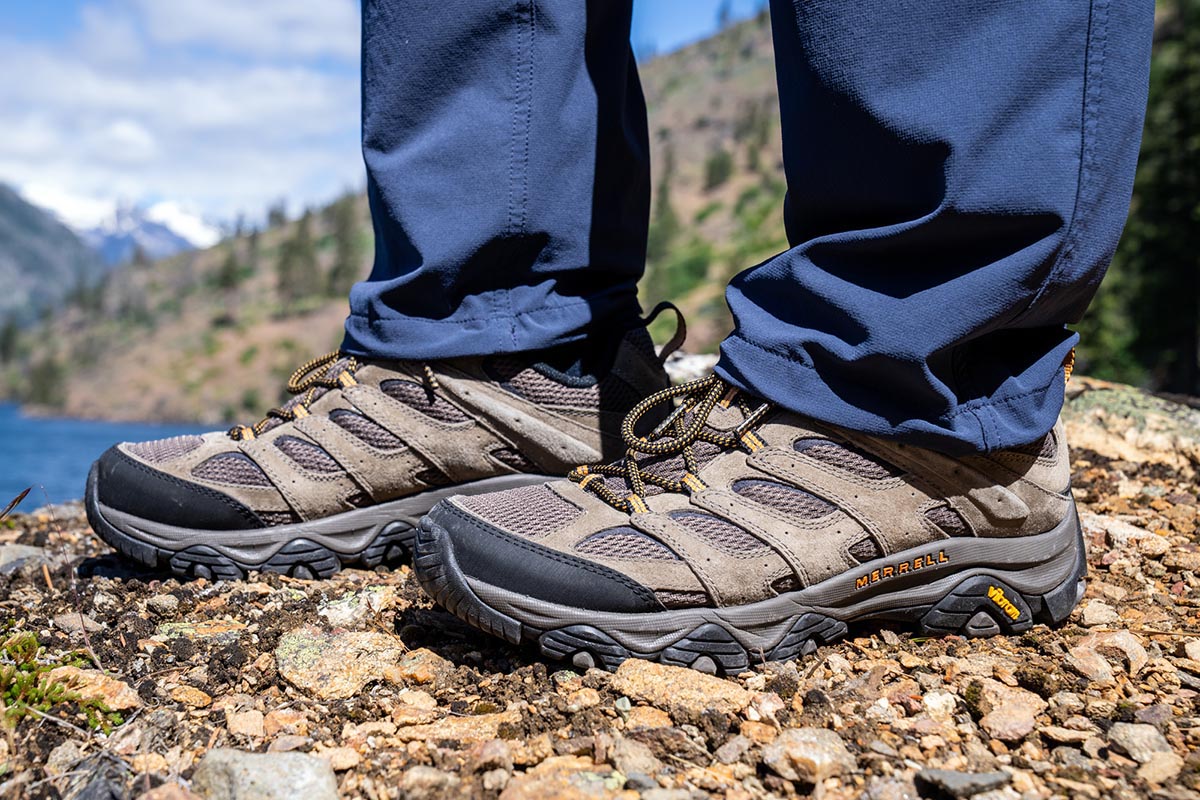
Switchback Travel ( Jason Hummel )
We use affiliate links and may receive a small commission on purchases. Read more about us .
The momentum in hiking footwear is moving away from bulky boots toward lightweight shoes and even trail runners that are faster and more comfortable. You do lose some ankle support when carrying a heavy pack or traversing rocky trails, but the weight savings and feathery feel are worth it for many. Our team of avid hikers and backpackers donned countless pairs of shoes to narrow in on the streamlined selection of 18 models you see below. These are our favorite hiking shoes of 2024, from ultralight options for fast-and-light trips to more supportive models for carrying a full pack. For more background information, see our hiking shoe comparison table and buying advice below the picks. And if you prefer an over-the-ankle style, see our article on the best hiking boots .
Editor's note: We updated this guide on April 16, 2024, to include information regarding our testing practices, add the new La Sportiva TX4 Evo and Altra Lone Peak 8, and expand some of the sections in our buying advice. We also combed through the guide to ensure prices, colorways, and products are current at the time of publishing.
Our Team's Hiking Shoe Picks
- Best Overall Hiking Shoe: Salomon X Ultra 4 GTX
- Best Budget Hiking Shoe: Merrell Moab 3
- Best Ultralight and Cushioned Hiking Shoe: Hoka Speedgoat 5
- Best Shoe for Backpacking and Technical Trails: La Sportiva Spire GTX
- Best Hiking Shoe for Off-Trail Scrambling: La Sportiva TX4 Evo
- A Comfortable Shoe for Hard-to-Please Feet: Altra Lone Peak 8
Best Overall Hiking Shoe
1. salomon x ultra 4 gtx ($160).
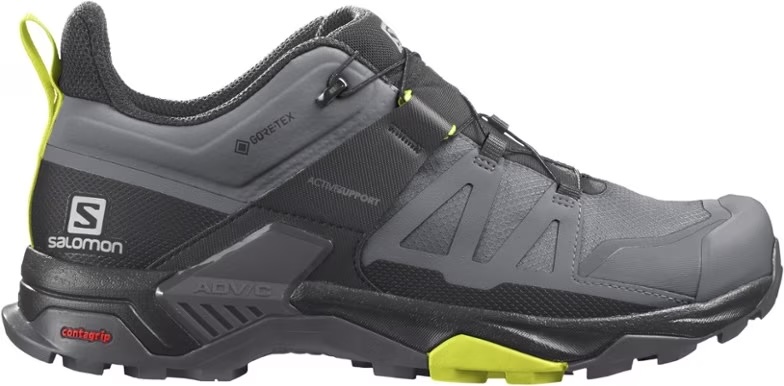
Salomon’s X Ultra has been one of our favorite hiking shoes for years, offering an exceptional combination of comfort, on-trail performance, and durability for everything from casual day hikes to ambitious overnight missions. A few seasons back, they released an update to the much-loved shoe in the X Ultra 4 here. Beyond its sleeker and more modern look, the X Ultra 4 features a revised lacing system and chassis, along with a roomier fit in the toe box. Importantly, the shoe retains the outgoing version’s fantastic mix of agility, support, durability, and protection, and there’s enough cushioning underfoot for full days with a loaded pack. Finally, at 1 pound 9 ounces for our men’s size 9, it’s competitively lightweight and nimble.
While the latest X Ultra 4 takes our top spot, it wasn’t a near-universal choice as in years past. In short, some of our editors weren’t huge fans of the 4’s fit, which features a narrow midfoot, spacious forefoot, and hard-to-customize quick-pull lacing system. For some, this offers a locked-down feel but perhaps too roomy of a toe box; for others, it’s ideal in the forefoot but too tight at the arch. What’s more, the raised collar around the front of the ankle can be a source of rubbing and discomfort for some users (in this case, it wasn’t a problem for our testers). All that said, if you can try it on before you purchase (and it fits), the latest X Ultra is undeniably a high-performance, quality option... Read in-depth review See the Men's Salomon X Ultra 4 GTX See the Women's Salomon X Ultra 4 GTX
Best Budget Hiking Shoe
2. merrell moab 3 ($120).
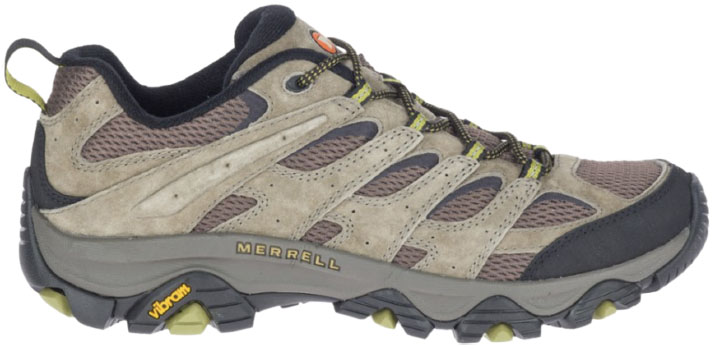
These may not be your long-distance or fast-and-light hiking shoes, but there is a lot to like about Merrell’s flagship Moab 3. What has made this shoe so popular over the years? Most notably, it's the lightweight but planted feel, comfortable and well-padded fit, excellent durability, and attractive price point. Merrell updated the Moab over a year ago, including recycled materials, a new insole, and modest updates to cushioning and traction, but the formula largely remains the same. For day hikers sticking to established trails, the Moab 3 is comfy and a great value.
In terms of downsides, on rocky and muddy trails, we’ve found that the Moab’s traction and stability fall short of a performance shoe like Salomon's X Ultra above or the La Sportiva Spire below. And at 2 pounds 1 ounce for a pair, it feels a little slow and cumbersome compared with some lighter and nimbler alternatives (including the X Ultra 4). But these are reasonable trade-offs for casual hikers, and it’s hard to deny the price, which checks in a full $40 less than the top-rated Salomon. Keep in mind that we included the non-waterproof version here, but Merrell also makes a waterproof model that costs $140 and weighs slightly more at 2 pounds 2 ounces per pair... Read in-depth review See the Men's Merrell Moab 3 See the Women's Merrell Moab 3
Best Ultralight and Cushioned Hiking Shoe
3. hoka speedgoat 5 ($155).
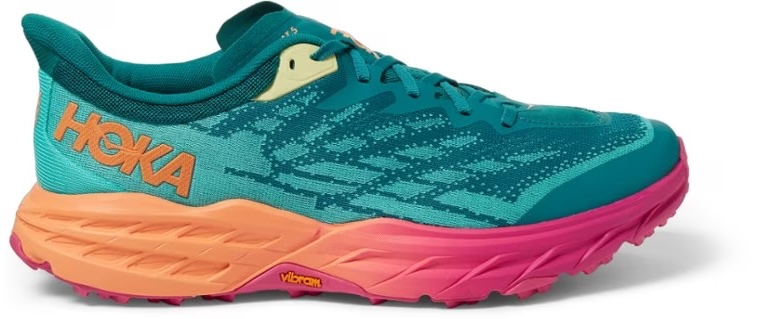
Hoka used to be a niche brand for runners, but that has changed dramatically over the past few years and the brand is now a go-to option for hikers. This trajectory makes sense: More and more people are ditching their burly boots for hiking shoes and trail runners—if you stay mostly on established trails and aren’t scrambling or carrying a heavy pack, a lightweight trail runner can offer the best combination of performance and comfort. And with thick yet supportive cushioning, an impressively grippy sole, and a long track record of success, the Hoka Speedgoat 5 is our favorite shoe in this category.
What are the shortcomings of the Hoka Speedgoat 5? We have been surprised by how quickly they wear down—the sole and midsole in particular. When standing at our local running store recently, a gentleman in front of us was buying new Hokas and said, “I absolutely love these shoes but am bummed by how quickly they pack out,” which sums up our experiences as well. In addition, the revamped upper now forgoes any overlays, which means you get less protection and stability than previous models—we found the 5 quite squirrely for trail running on technical terrain. But for those who hike or run mostly on established trails, you simply won’t find a more comfortable shoe for the job. See the Men's Hoka Speedgoat 5 See the Women's Hoka Speedgoat 5
Best Shoe for Backpacking and Technical Trails
4. la sportiva spire gtx ($209).
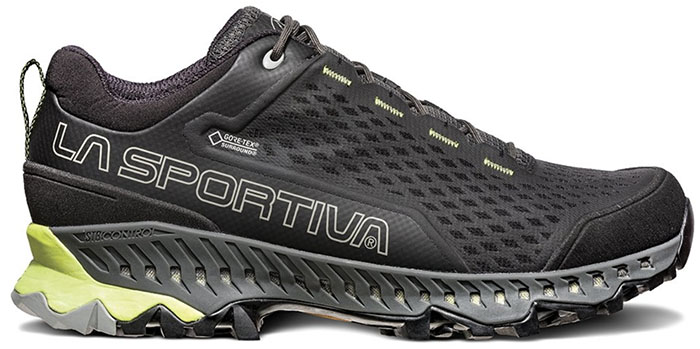
Many of the designs on our list are lightweight or almost trail runner-like in nature, but La Sportiva’s burly Spire is backpacking-ready—or just about as close as a hiking shoe gets. It feels sturdy and substantial with good stiffness and a thick midsole, effectively isolating you from rough and rocky trails (La Sportiva even goes so far as calling it a low-cut hiking boot). Throw in excellent protection and grip over a variety of terrain, plus a quality build that we’ve come to expect from this Italian climbing brand, and you have one of the more capable hiking shoes on the market.
Why isn’t the La Sportiva Spire ranked higher? At nearly 2 pounds, it’s heavy for a low-top hiking shoe and sits relatively high on the ankle. Second, the $209 price tag makes it the most expensive model on this list, and notably more expensive than many hiking boots. Finally, we appreciate the accommodating fit that should work well for most foot types, but the shoe is a little wide at the heel and we had to cinch it down tightly to avoid slippage. These issues aside, it’s hard to knock the performance chops or build quality of the La Sportiva, and it offers a nice step up in on-trail performance and durability compared to the TX4 Evo below... Read in-depth review See the Men's La Sportiva Spire See the Women's La Sportiva Spire
Best Hiking Shoe for Off-Trail Scrambling
5. la sportiva tx4 evo ($169).
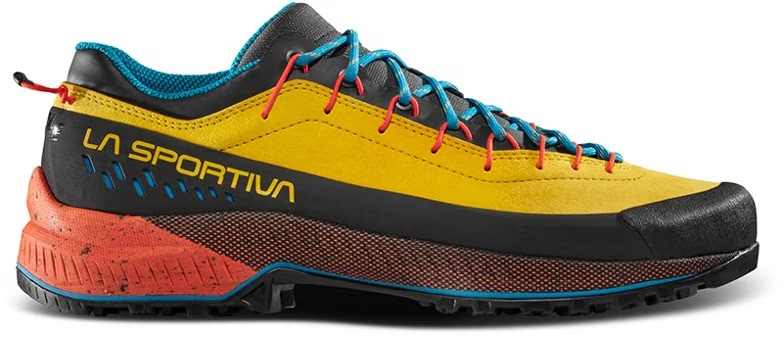
The La Sportiva TX4 Evo—the brand's latest take on their longstanding TX4—certainly isn’t a traditional pick, but boy do we love this shoe. It’s built as an approach shoe, which means that it’s grippy and tough for long hikes to climbing objectives or traveling over steep, rocky terrain. The Vibram outsole, full rubber rand, and smooth area of sticky rubber under the toe make it a great option for scrambling, smearing, and edging on rock. But what we have been impressed with most is its versatility: The TX4 does equally well moving fast on the trail with its light and moderately flexible construction. We even like it for everyday use due to the high levels of comfort and attractive design.
As with most approach shoes, the TX4 Evo does have limitations. The dotty tread grips exceptionally well on wet and dry rock and even impressed us with traction on snow, but it will fall short of a true hiking shoe in dirt and mud. Further, some hikers—mostly those of the fast-and-light variety—might find that the stiffer sole feels clunky and inflexible. But overall, don’t be dissuaded by the approach shoe label: The TX4 Evo is a worthy companion for long days on the trail. And keep in mind that La Sportiva does make this shoe in a number of versions, from the uber-lightweight TX2 Evo up to the TX Hike Mid (a full-on hiking boot). Note: We recently received the TX4 Evo for testing and will update this write-up with our feedback soon. The design is largely similar to the outgoing TX4, but with eco-friendly touches like recycled materials and a new platform that can be resoled to maximize the shoes' lifespan... Read in-depth review (previous model) See the Men's La Sportiva TX4 Evo See the Women's La Sportiva TX4 Evo
A Comfortable Shoe for Hard-to-Please Feet
6. altra lone peak 8 ($140).
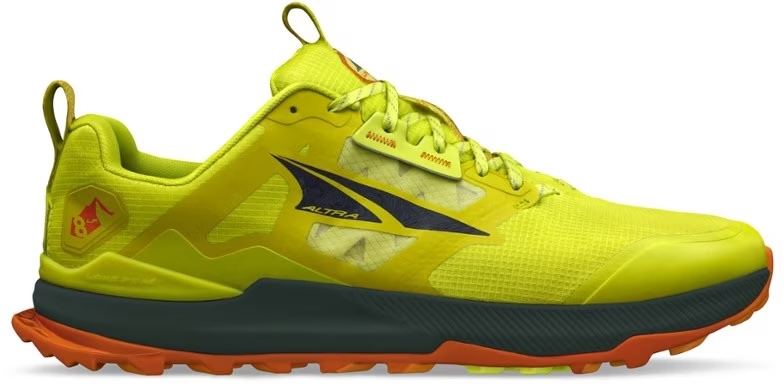
Similar to the Speedgoat above, Altra’s Lone Peak was designed first as a running shoe and has since become a thru-hiker favorite. But while we love the Speedgoat for its agility and cushioning, the Lone Peak is highlighted for a different skill set: The shoe has a roomy toe box, features a zero-drop shape that encourages a natural stride, and offers great ground feel with just 25 millimeters of stack height compared to the Speedgoat’s 33 millimeters (at the heel). It all adds up to a very comfortable shoe that’s especially ideal for long-distance hikers with wide or hard-to-please feet. Altra also tacks on a few trail-worthy features, including a rock plate and gaiter attachments; and the recently updated 8th generation improves the design with a moderately more aggressive outsole, slightly lower weight (by 0.6 oz. per pair), and a new "Ghillie" lacing system with optional pull-through points for a more customizable fit.
We commonly recommend the Lone Peak to hikers who have struck out with other hiking footwear (most often due to issues with blisters and pressure points caused by overly stiff or narrow designs) and have yet to lead anyone astray. But the shoe isn’t for everyone: It can be too wide for most narrow feet, and the zero-drop design can feel particularly squirrely on uneven terrain. And compared to a svelte shoe like the Speedgoat, the Altra offers a more sluggish, “padding along” kind of experience—in fact, we have a hard time not using the word “slipper” to describe the Lone Peak. But for long-distance hikers who prioritize roominess and comfort above all else (this is especially key once your feet start to swell), the Lone Peak is hard to beat. Note: We're in the process of testing the latest Lone Peak 8 and will share our feedback here once we stack on more miles. See the Men's Altra Lone Peak 8 See the Women's Altra Lone Peak 8
Best of the Rest
7. danner trail 2650 ($170).
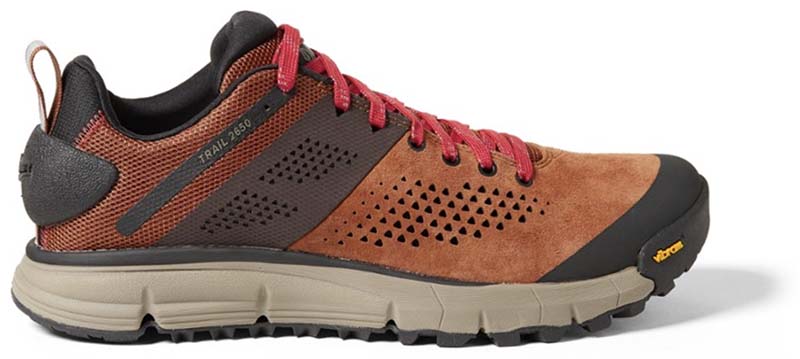
The North Face’s footwear lineup has seen a lot of modernization in recent years, and the Exploris 2 is case in point. Taking inspiration from their Vectiv trail running collection, this hiking-specific variation features a rockered profile for moving fast on the trail, a full-length TPU plate in the midsole for stability, and a lightweight yet durable synthetic ripstop upper. TNF utilized their in-house Futurelight waterproofing, and the thin construction helps minimize overheating when working hard in mild temperatures. Finally, the updated “2” boosts comfort with 2 millimeters of extra cushion and a more accommodating toe box. The styling may be a little polarizing—it’s not as around town-friendly as alternatives like the Danner Trail 2650 above—but it’s clear that a lot of thought and effort went into the design.
We took the Vectiv Exploris 2 backpacking in Patagonia and returned with mostly positive impressions. The SurfaceCTRL rubber was impressively confidence-inspiring on everything from slippery rock to mud, and there was little to no break-in period. Further, the waterproof membrane held up extremely well despite the sloppy conditions and numerous creek crossings. And while the rockered shape did feel a little awkward at first, it really came to life and gave the shoe a natural and poppy feel when hiking quickly. We wouldn’t push the Exploris 2 too hard into cross-country terrain—it felt slightly tippy while crossing talus and boulder hopping—and despite the updated toe box, we found the shoe to be on the narrow side. But for a durable yet nimble hiking shoe that will feel just as comfortable on mile 20 as it does at mile 2, the Exploris 2 is well worth a look. See the Men's TNF Vectiv Exploris 2 See the Women's TNF Vectiv Exploris 2
9. Hoka Anacapa 2 Low GTX ($180)
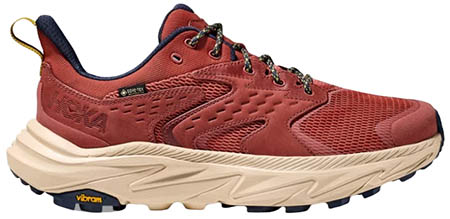
The Hoka Speedgoat above has achieved legendary status among hikers (specifically the thru-hiking community), but there are some notable trade-offs with the trail-running design. For those who want a bit more support and protection, Hoka also offers an impressive lineup of hiking-specific footwear, including the Anacapa 2 Low here. The Anacapa (also available in a mid-height version ) features Hoka’s well-known springy midsole, a rockered shape for a smooth ride on the trail, and a beefed-up construction that includes durable nubuck leather and a Gore-Tex waterproof liner. The result is a fast-moving shoe that nicely mixes a trail runner-like feel with the added structure of a hiker.
The Anacapa was updated to the “2” with a focus on more sustainable materials, along with a few noteworthy changes to the midsole and upper. With a less intrusive heel counter, additional tongue padding, and a slightly softer midsole, the 2 is arguably more comfortable than the outgoing version, and Hoka also enhanced the toe box for more durability and protection. However, we were surprised to see that the Vibram Megagrip outsole remains virtually unchanged—like the original, it features large sections of blown rubber that are susceptible to damage from rocky trail use. Additionally, we found it fit slightly larger than the outgoing model (some may need to go down a half size). But the Anacapa 2 nevertheless is a solid update to a very good hiking shoe, and it’s especially ideal for those who stick to established trails and prioritize cushy comfort. For a more breathable design for summer hiking, check out the non-waterproof Anacapa Breeze Low ($155)... Read in-depth review See the Men's Hoka Anacapa 2 Low GTX See the Women's Hoka Anacapa 2 Low GTX
10. Adidas Terrex Swift R3 GTX ($160)
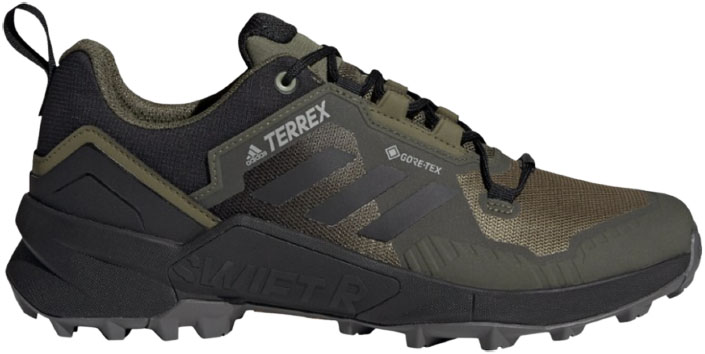
With a light but sturdy and supportive build, Adidas’ Terrex Swift R has consistently been a trail favorite. The third generation brought a more traditional lacing system—which we consider a positive as the quick-lace design on the R2 was finicky—but otherwise, they stuck to the winning formula. Its outsole grips well on everything from mud to rock, and the moderately stiff construction makes it a nice pairing for more technical terrain and when carrying an overnight or multi-day load. Finally, we appreciate the tough and long-lasting materials used throughout: There’s no open mesh in the upper like you’ll find on less durable trail runners, and protection is great around the toes and sides of the feet. For hikers wanting a boot-like feel in a low-top shoe, the Swift R3 is a worthy option.
Some of the Swift’s closest competitors include the La Sportiva Spire and Salomon X Ultra above. All the designs balance weight, cushioning, and trail performance well, although the Salomon is the lightest and nimblest of the bunch. For those who like a little more structure and stiffness, the Adidas and La Sportiva have their appeals, but the trade-off is a longer break-in period and a somewhat clunky feel when you’re trying to move quickly. We also found the R3 runs a little big, which led to a fair amount of heel slippage on extended climbs (some may need to size down). These complaints push the Swift R3 down our rankings, but if it fits you well, the shoe offers a nice combination of durability, support, and price... Read in-depth review See the Men's Adidas Terrex Swift R3 GTX See the Women's Terrex Swift R3 GTX
11. Brooks Cascadia 17 ($140)
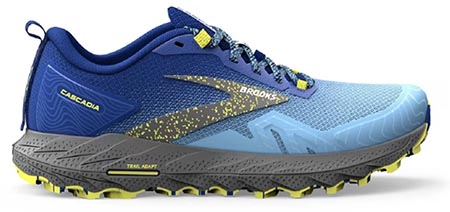
Now in its 17th generation, the Brooks Cascadia is one of the longest-standing trail runners on the market and particularly popular in the thru-hiking community. Like the Speedgoat and Lone Peak above, this shoe bridges the gap for speed-focused hikers with the support and protection you need for rugged trails alongside a hefty dose of cushioning for long days out. And at only 1 pound 6 ounces for the pair (our men’s size 9 was a hair more at 1 lb. 6.5 oz.), it won’t weigh you down as much as the hiking-specific shoes here. We took the updated “17” on a backpacking trip through Washington’s Necklace Valley and were impressed with its balanced design: The Cascadia felt stable and precise while traversing off-camber terrain with a full pack but remained impressively quick and responsive when running the vehicle shuttle at the end of the trek.
How does the Cascadia compare with another darling of the thru-hiking world, the Altra Lone Peak? Both offer a nice array of trail-ready features like aggressive rubber outsoles and attachment points for gaiters, but the Brooks is the technically capable option with more cushioning and protection underfoot and better stability. In terms of fit, the two shoes feature roomy toe boxes that are great for accommodating swollen toes (the Altra is more spacious), but the Cascadia locks things down more at the midfoot and heel for a more performance-oriented fit. A final key difference is the Cascadia’s 8-millimeter drop compared to the Lone Peak's zero-drop shape, which lends a more agile and quick overall feel (although the “natural” zero-drop profile of the Altra is one of the reasons it has such a loyal following). In the end, we think the Brooks is the better all-rounder for most hikers, although the Altra gets the edge for those with particularly hard-to-please feet. See the Men's Brooks Cascadia 17 See the Women's Brooks Cascadia 17
12. Merrell Moab Speed 2 Low ($140)
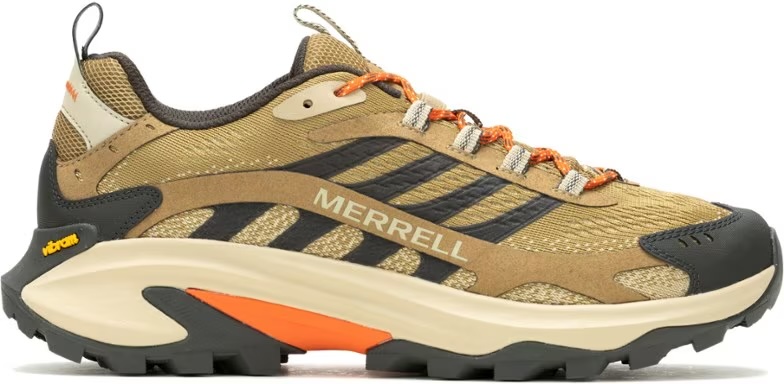
Merrell is a longtime leader in hiking footwear, and their recently updated Moab Speed 2 Low brings the much-loved Moab (above) into the modern era. The Speed 2 Low features a lightweight and cushioned design that will appeal to day hikers and weight-conscious backpackers alike. And despite its trail-runner-esque appearance, the Speed 2 still offers a healthy amount of protection and support—including a generous toe and heel cap and firm but comfy midsole—along with a capable Vibram outsole. We also appreciate that Merrell added more foam with the latest model, resulting in a noticeably cushier and less rigid feel. The end result is a hardwearing yet easy-to-wear hiking shoe that toes the line between weight-savings and on-trail performance better than most—and the price is right too at just $140.
The Moab Speed 2 Low will get the job done for the majority of day hikers and lightweight backpackers, but keep in mind that it’s far from the most supportive or durable shoe here. If you’re headed out on technical terrain or with a heavy pack, models like the La Sportiva Spire and Salomon X Ultra 4 will offer noticeably more underfoot stability and isolation from the trail. On the other end of the spectrum, the Speed 2 Low feels decidedly firmer and more planted than the even lighter Speedgoat above, although you don’t get the Hoka’s snug and sock-like feel (the Merrell's roomy toe box and lack of secure heel resulted in some sloppiness). But in the end, these shoes strike a healthy balance between comfort and structure, offering enough underfoot support for covering technical ground without feeling overly stiff... Read in-depth review See the Men's Merrell Moab Speed 2 Low See the Women's Merrell Moab Speed 2 Low
13. La Sportiva Ultra Raptor II ($165)
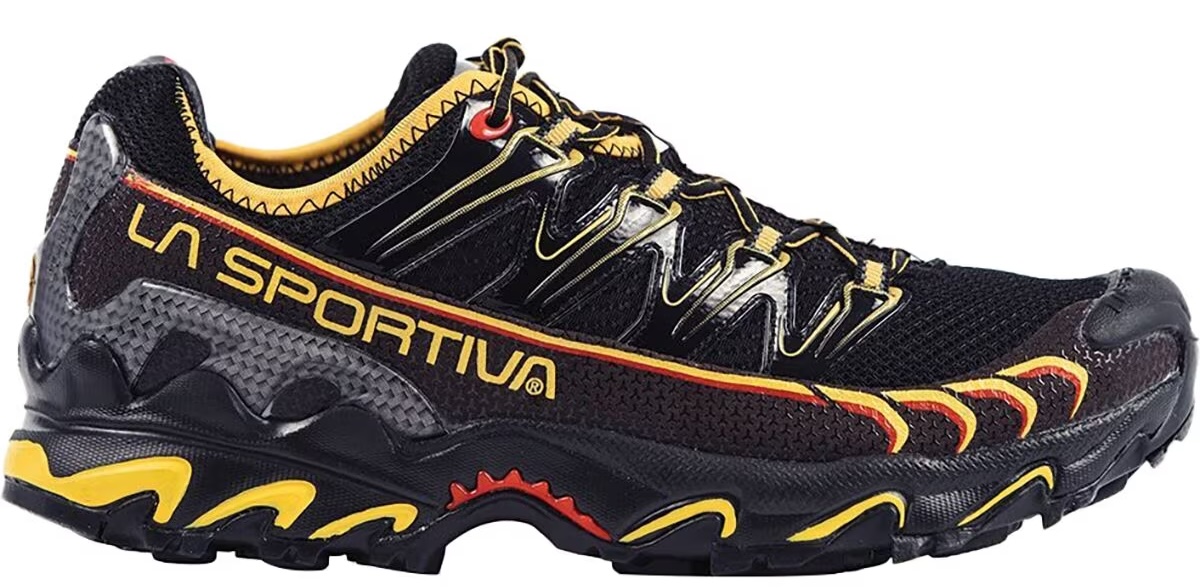
La Sportiva bills their Ultra Raptor as a mountain running shoe, but we’re big fans of this design for hikers venturing above treeline on rugged trails or cross-country terrain. Now in its second iteration, the Ultra Raptor II provides chart-topping protection against rocks and roots by way of generous toe and heel caps and a full-length rock plate, along with incredible grip on everything from mud and loose talus to boulders and snow. Ample cushion makes the shoe comfortable enough to wear all day, and a sock-like construction keeps the foot snug while sealing out trail debris. For high routes, climbing approaches, and peak bagging, the Ultra Raptor gives Sportiva’s Spire and TX4 Evo shoes above a run for their money in terms of protection, support, and durability.
But for all the Ultra Raptor’s strengths, it’s not our shoe of choice for most trails. Compared to most trail runner-inspired designs, the Sportiva is rather stiff and clunky, and the rigid TPU heel counter is known to cause discomfort in the heel for some. Second, although the Ultra Raptor is built with a mesh upper, it has a tendency to absorb rather than drain water, which makes for a heavy shoe after creek or snow crossings. But the Ultra Raptor is an incredibly capable shoe for technical mountain terrain, and the fun updated colorways—particularly for women—certainly don’t hurt. La Sportiva also makes the Ultra Raptor II Leather GTX , which is just a few ounces heavier, offers waterproof protection, and retails for $179... Read in-depth review See the Men's Ultra Raptor II See the Women's Ultra Raptor II
14. Scarpa Rush 2 GTX ($199)
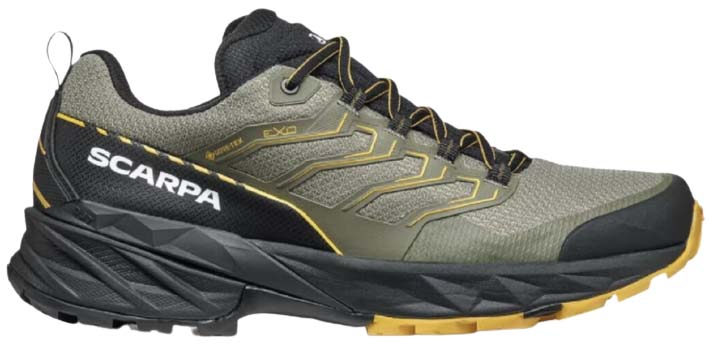
The hiking-shoe-meets-trail-runner love story has been unfolding for a number of years, and Scarpa’s Rush 2 GTX is a prime example. With the cushion and rocker of a trail runner alongside the stability and protection of a hiking shoe, the Rush is a best-of-both-worlds option for modern hikers. Specifically, you get a durable fabric upper with welded reinforcements, burly midsole with EVA foam and TPU reinforcements for cushion and stability, and a sticky, rockered outsole that facilitates quick movements. All told, if you’re considering a trail runner but are wary of giving up the support and hardwearing nature of a hiking shoe, the Rush 2 GTX (also offered in a mid-height version ) is well worth a look.
We wore the first-gen Scarpa Rush while trekking in southern Patagonia and were impressed with its prowess on everything from hardpacked trail to talus and smooth rock. Our main gripe was the shoe’s low collar and poor ankle lock; thankfully, the 2 offers a noteworthy improvement with increased stability and torsion control at the rear. And while the Rush is heavier than trail runners like the Speedgoat and Lone Peak above (read: not ideal for running), it does feel lighter than its weight would suggest (and in a side-by-side test, the first-gen version was notably more cushioned than the top-ranked X Ultra 4). Finally, the Scarpa is pricey at $199. But for speed-focused hikers and fastpackers, it’s hard to knock the purpose-built design, which offers a nice boost in stability and protection compared to standard trail running shoes. Note: The Rush 2 is currently discounted at REI, but Scarpa has better availability if you can't find your size through the former. See the Men's Scarpa Rush 2 GTX See the Women's Scarpa Rush 2 GTX
15. Adidas Terrex AX4 ($100)
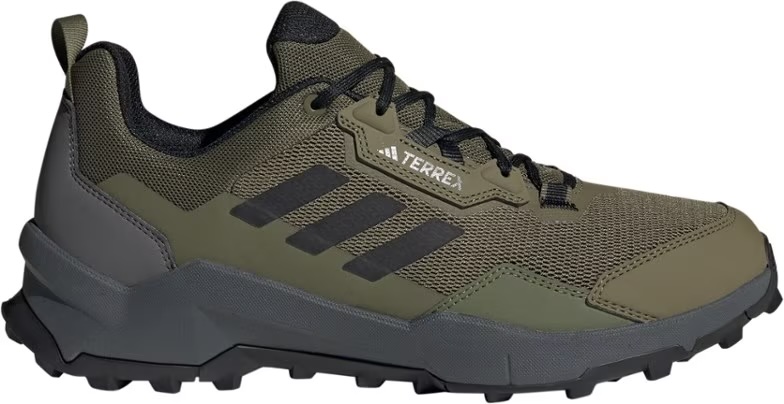
We didn’t anticipate two Adidas Terrex shoes making our 2024 list, but the AX4 impressed as a well-rounded budget offering. At just $100 for the non-waterproof version—$20 less than the Moab above—you get excellent traction from the Continental-brand outsole, a durable upper, and a simple but effective lacing system. On lengthy and challenging hikes in southern Patagonia, we found the shoe surprisingly adept: Its light weight and low-profile midsole make it easy to trust when scrambling, and there’s sufficient cushioning to isolate you from rocks and roots. As a day hiking option, the Terrex AX4 has a lot going for it.
Unsurprisingly, there are a few compromises in the AX4’s affordable build. First and foremost is the lack of a proper toe cap, which we got a few painful reminders of when catching rocks on the trail. Additionally, the insole is cheap, thin, and seems to hold stink more than a higher-end OrthoLite design. Finally, while comfort is quite good considering the price, spending up for a shoe like the Merrell Moab Speed above will get you a softer interior and springier cushioning. In the end, high-mileage users may want to steer clear, but the AX4’s combination of price and performance earns it a spot for this year... Read in-depth review See the Men's Adidas Terrex AX4 See the Women's Adidas Terrex AX4
16. Arc’teryx Aerios GTX ($180)
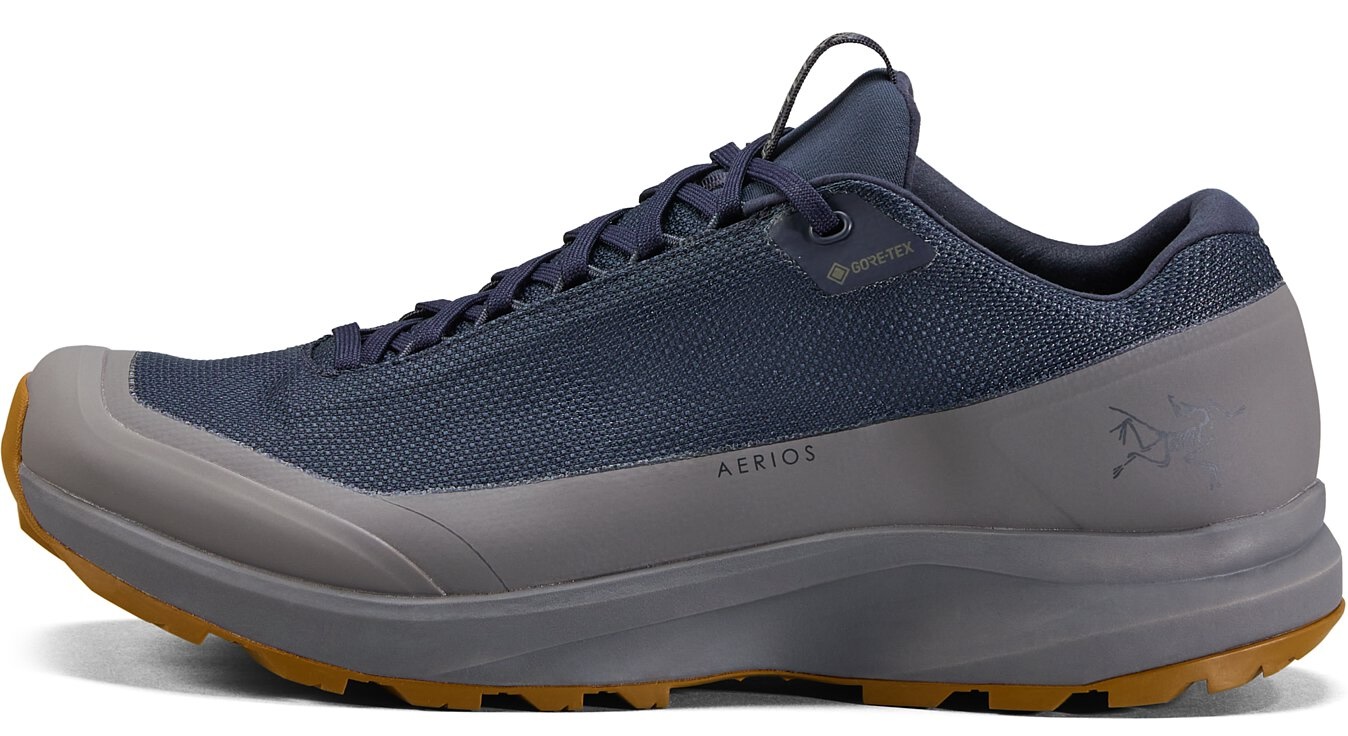
Arc’teryx has built a reputation around premium and sleek-looking designs, and their Aerios GTX carries the torch. Now in its second iteration, this shoe is one of the Canadian brand’s biggest success stories of late, combining the comfort and light weight of a trail runner with the protection and stability of a hiking shoe. It’s very light and nimble at just 1 pound 8 ounces per pair, waterproof with a Gore-Tex membrane, and tough with a burly toe cap and a large swath of TPU where the upper meets the outsole. What’s more, the current iteration features a 100%-recycled polyester upper, which has proven itself to be just as durable as the outgoing model’s Cordura. For these reasons, it’s our favorite shoe in Arc’teryx hiking footwear lineup to date.
In terms of traction, the Aerios is in its element on rock thanks to a sticky Megagrip Vibram outsole, but the shorter lugs compromise grip over wet and soft terrain like mud and snow. Additionally, some users have reported premature delamination along the front and sides of the upper, although we haven't experienced any issues with several iterations in the Aerios line. Finally, the shoes' basic lacing system makes it hard to customize fit and results in loosening throughout the day. These gripes aside, the Aerios GTX is a premium piece of footwear for everything from speedy day missions to week-long treks in the mountains. And for a more breathable option for hot summer hiking, Arc’teryx also makes the non-waterproof Aerios Aura ($150) , which features a mesh upper. See the Men's Arc'teryx Aerios GTX See the Women's Arc'teryx Aerios GTX
17. Keen Targhee Low Vent ($155)
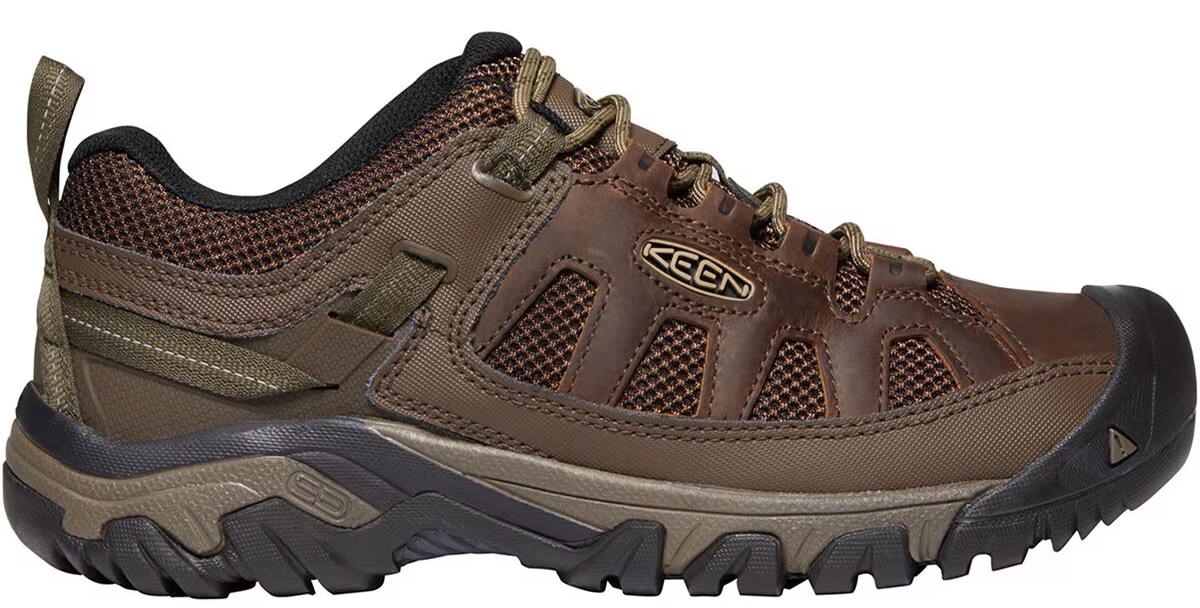
Like Merrell's Moab, the Targhee is Keen's signature everyday hiker. Updated a few years ago, the changes weren't groundbreaking but did a nice job at modernizing the classic design. Most importantly, the super-wide foot bed of the previous model has been trimmed down slightly to give the shoe a slightly less sloppy feel over rocky terrain (it’s still plenty roomy for most folks, though). The Targhee Low Vent still won’t be confused with an aggressive model like the Salomon X Ultra 4 above—in looks as well as performance—but its tough leather construction, reasonable weight, and well-cushioned interior make it a great casual hiking shoe.
Among day hiking options, the Keen Targhee Low and Merrell Moab 3 are two of the most popular on the market. Both are very comfortable right out of the box, offer sufficient support and traction for non-technical trails, and can even do the trick on shorter backpacking trips. The Targhee’s Nubuck leather upper is a little more durable than the Moab’s mesh-heavy build, but the Keen isn’t as good of a value at $155 (the waterproof version is $165). That price difference is enough to push it slightly down our list, but the Targhee’s standout comfort make it a consistent favorite. Note: Keen recently released the Targhee IV Vent , and we will report back here after testing the latest model. See the Men's Keen Targhee Low See the Women's Keen Targhee Low
18. Oboz Sawtooth X Low ($140)
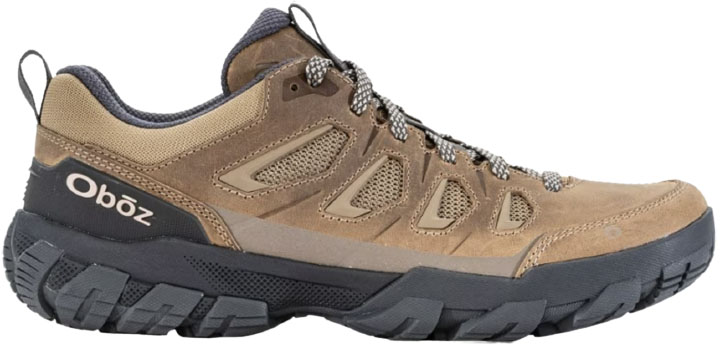
Based in Bozeman, Mont., Oboz has a reputation for making tough, comfort-first footwear for less than much of the competition. The Sawtooth has long been one of their most popular models for both day hiking and overnights, and this year it received a full overhaul with the latest “X.” Responding to the resounding movement toward lighter and nimbler footwear, the Sawtooth X features a modernized aesthetic and refined fit, along with added Cordura for abrasion resistance. But the original formula remains largely the same, including a roomy toe box and plush interior, Oboz’s supportive O Fit insole, and a tough, durable construction that can handle mile after mile of trail abuse.
What’s not to like about the Sawtooth X? Despite Oboz’s efforts toward streamlining the design, it’s still a fairly heavy shoe and less agile than most. And with a leather upper and plush cushioning, its breathability suffers compared to the lighter, mesh-heavy hikers above. In looking at the Sawtooth X and Moab 3 side-by-side, the Merrell is $20 less and better ventilated, while the Oboz is a bit lighter (by about a half-ounce per shoe) and offers more durability by way of Cordura in the upper. It’s also hard to find fault with the Sawtooth X’s fit, which is built to accommodate medium-to-high-volume feet and has a very minimal break-in period. And lastly, the Sawtooth X also comes in a low-top waterproof model ($165) and waterproof and non-waterproof versions of a mid-height boot. See the Men's Oboz Sawtooth X Low See the Women's Oboz Sawtooth X Low
Hiking Shoe Comparison Table
About our testing process.
The Switchback Travel team is no stranger to long days on the trail. From epic high routes traversing striking peaks to months-long thru-hikes across the country, we clock serious miles each year on all sorts of terrain. Former editor-in-chief John Ellings drew from his experience on local trails in the PNW and far-flung expeditions to southern Patagonia (and beyond) to whip up our initial selection of 12 hiking shoes back in 2015. Senior editor Chris Carter took over the guide in 2024. A seasoned thru-hiker, Chris has completed the Triple Crown of long trails in the United States (AT, PCT, and CDT) and continues to backpack and explore around the world. He's worn well-earned holes in more hiking shoes than he can count and knows the importance of solid kicks for tackling any trail.
We meticulously tested countless highly rated hiking shoes to narrow in on the selection of 18 models above, drawing from personal experiences as well as feedback from seasoned contributors and the hiking community as a whole. Weight, durability, breathability, and cushioning are all key factors we consider when gauging the mettle of a hiking shoe, and each design had to prove itself over grueling miles to earn a spot in this round-up. Finally, we know the hiking shoe market is constantly evolving. As a result, we keep our finger on the pulse of new products when they surface, adding standouts to our list along the way and ensuring our existing reviews stay up-to-date.
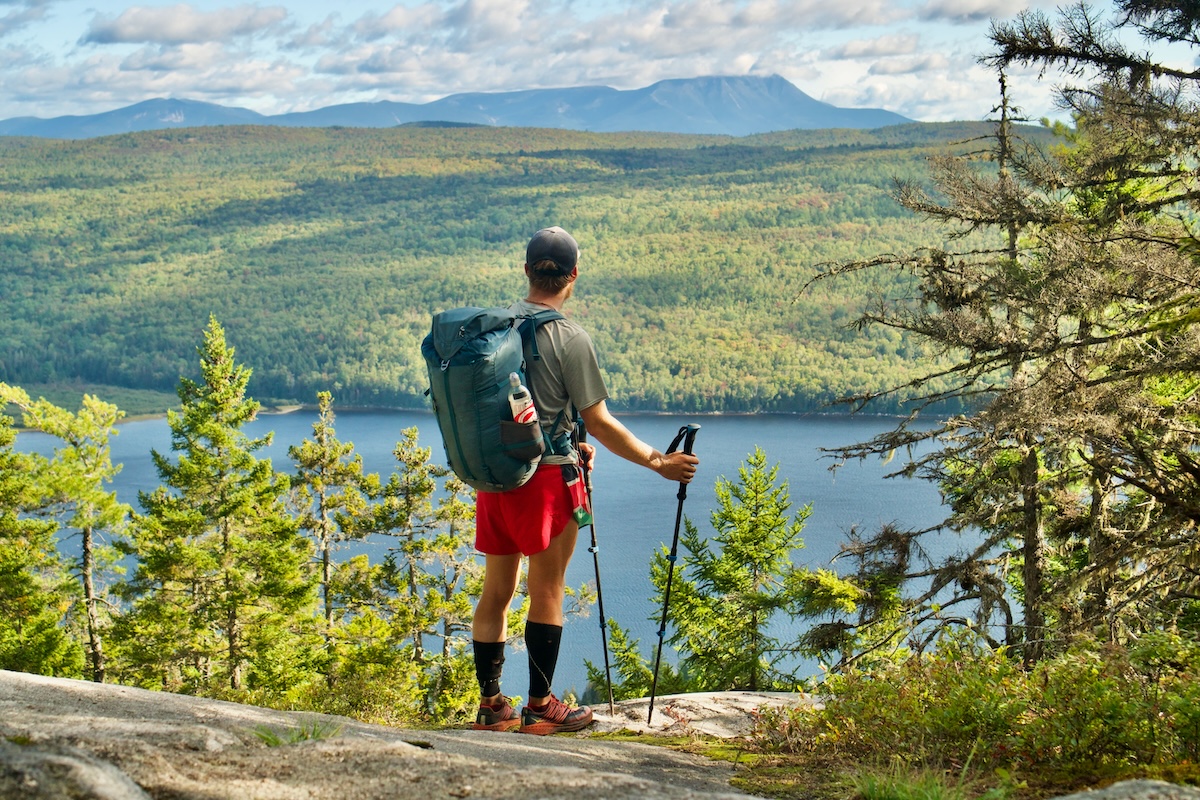
Hiking Shoe Buying Advice
- Hiking Footwear Categories
Stability and Support
Waterproofing, breathability, lacing systems, hiking shoe "upper" materials, midsoles and cushioning, outsoles and traction, toe protection.
- Hiking Shoes vs. Hiking Boots
Hiking Footwear Categories
Hiking Shoes For the vast majority of day hikers, and even a good number of backpackers and thru hikers, a hiking shoe that falls just below the ankle is the perfect match. Shoes like our top-rated Salomon X Ultra 4 GTX are stiffer and more substantial than a trail runner for carrying a light load over mixed terrain but don't feel draggingly heavy like a full-on boot. Furthermore, hiking shoes often have a tougher construction than trail runners, with increased use of leather and durable nylons as opposed to mesh. Protection from obstacles like rocks and roots come courtesy of rubber toe caps and medium-stiff midsoles. Hiking shoes also are great options for folks needing a substantial shoe for daily wear, just be aware that the outsoles will wear faster on pavement.
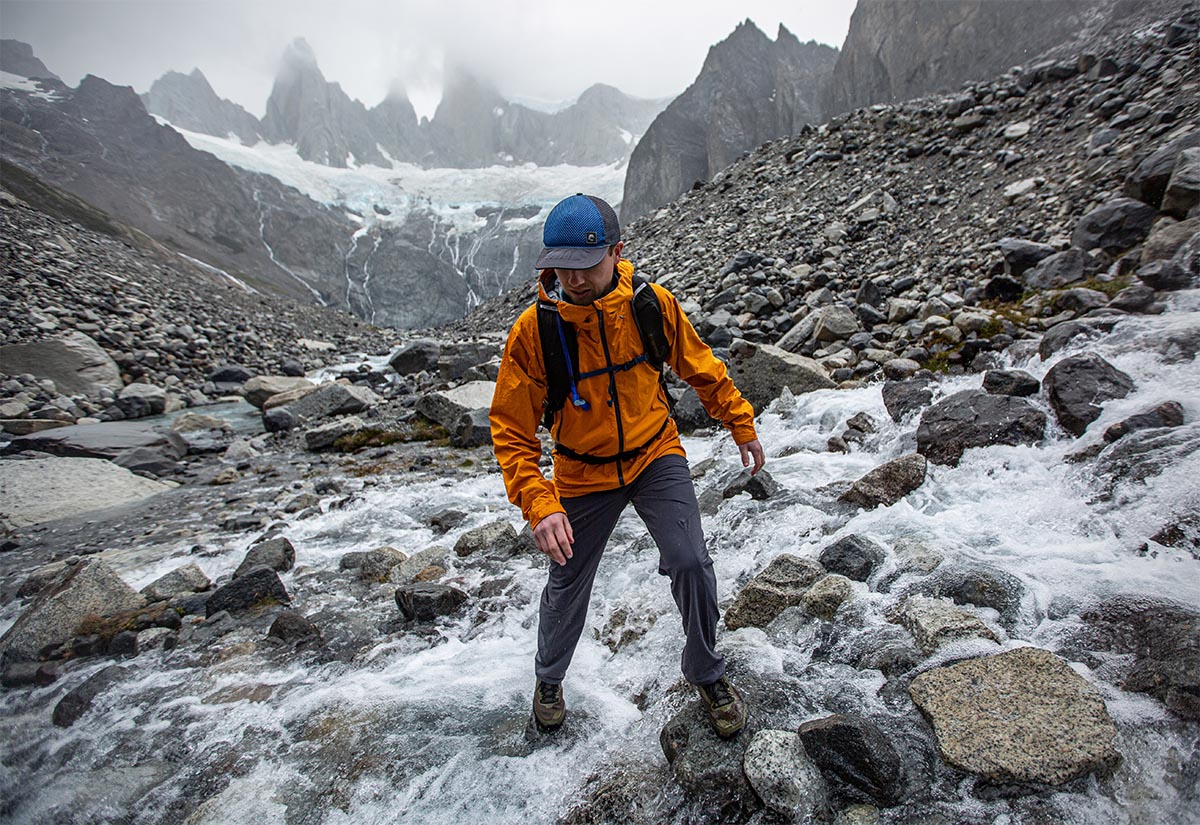
Trail Running Shoes If moving fast trumps all else, you should consider a trail runner. Shoes like the Altra Lone Peak and Hoka Speedgoat have gained significant popularity over the past few years for being the ultimate lightweight option and are a common sight on thru hikes like the PCT and AT. That said, keep in mind that these types of shoes are not traditional off-trail or backpacking footwear. Trail runners are flexible and super comfortable, but they don’t provide much in the way of ankle support when you’re carrying a heavy load and generally have minimal toe and underfoot protection. For hikes on established trails or for experienced minimalist trekkers, however, a trail runner remains an excellent option. We’ve included a couple great hybrid trail running and hiking options in this article, but for a complete breakdown, see our article on the best trail running shoes .
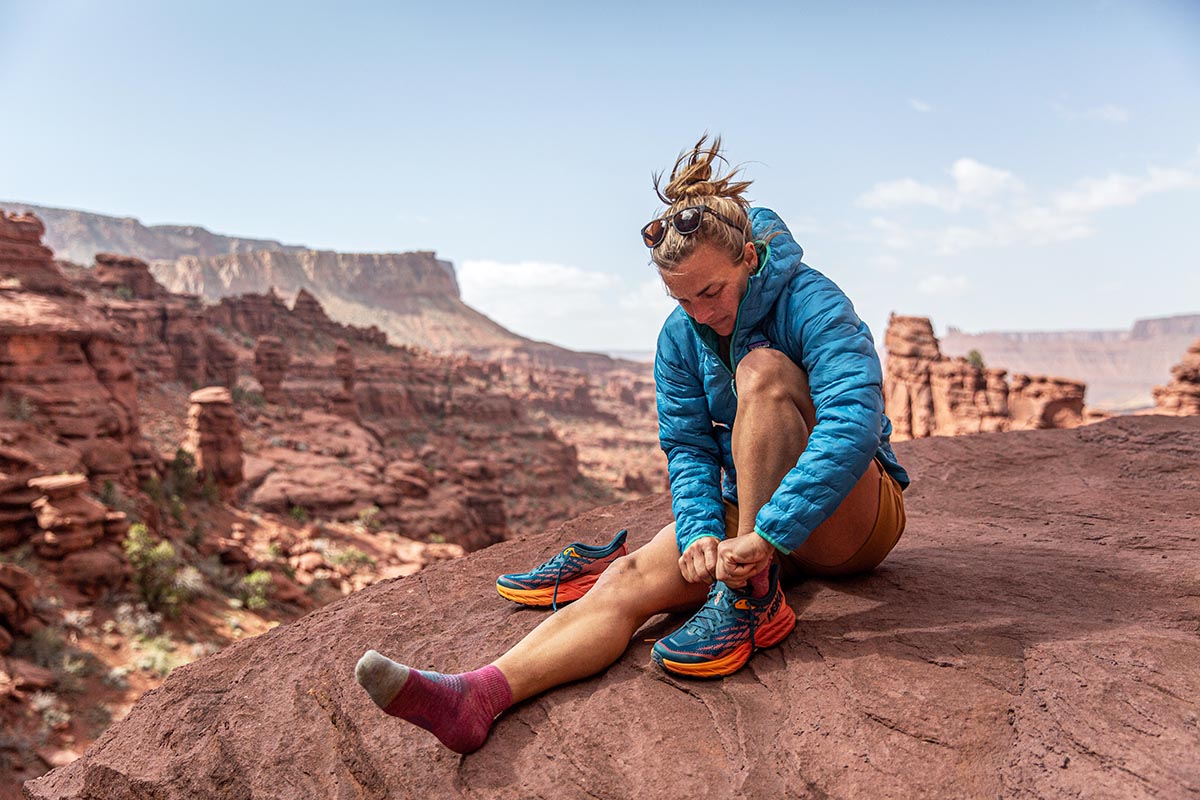
Approach Shoes The third option has a relatively narrow focus: climbers or hikers that need a grippy shoe to tackle steep rocky terrain. Many rock climbers will use an approach shoe on the hike in (hence, the “approach” name), and swap out to a true climbing shoe when the going gets vertical. Approach shoes are easy to spot: They have a large rubber toe rand and a sticky, low-profile rubber compound underfoot for maximum grip on rock. The shoes can be plenty comfortable on day hikes, especially a crossover style like the La Sportiva TX4 Evo , but aren’t what we typically recommend as a daily driver or backpacking pick—though one of our editor's does know someone who hiked the entire AT in TX4s. The treads aren’t as secure on muddy hiking trails and they’re generally not as comfortable underfoot for long trail days. If, however, your day hikes include a lot of scrambling or low grade rock climbing, an approach shoe is an excellent choice.
.jpg)
As a reflection of the push for lighter gear in all facets, hiking shoes are moving away from the traditional stiff construction of a hiking boot in favor of flexibility and a nimble feel. All hiking footwear (excluding some minimalist trail runners) does retain a degree of stiffness thanks to built-in shanks or internal supports. These features are part of what separates a hiking shoe (and approach shoe) from a super flexy cross trainer or road-running shoe.
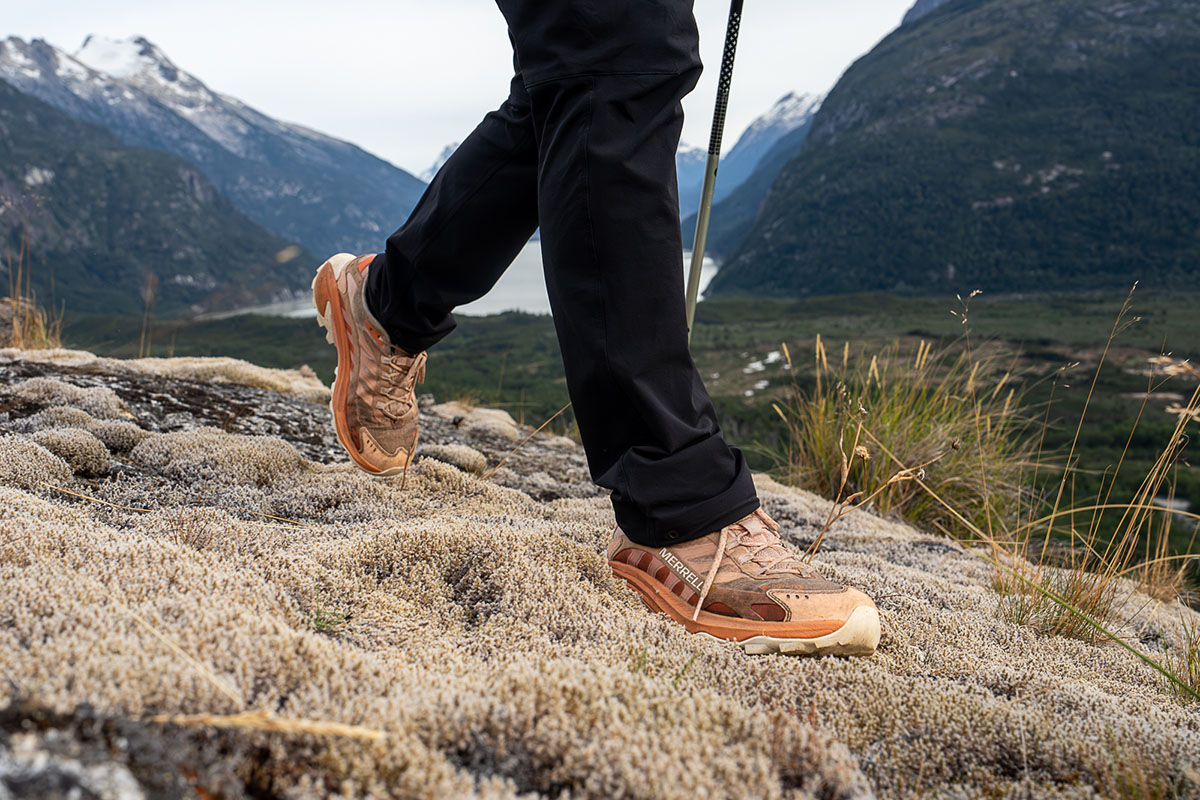
For day hikes on flatter or less technical terrain, we can’t recommend a lightweight and semi-flexible hiking shoe enough. Shoes like the Merrell Moab 3 and Keen Targhee Low are standouts for these uses. As your trips get longer and your pack gets heavier, a more substantial shoe still wins out for us. Look to the Salomon X Ultra 4, Adidas Terrex Swift R3, and La Sportiva Ultra Raptor II for great all-around options that are equally adept at conquering summit peaks and multi-day backpacking.
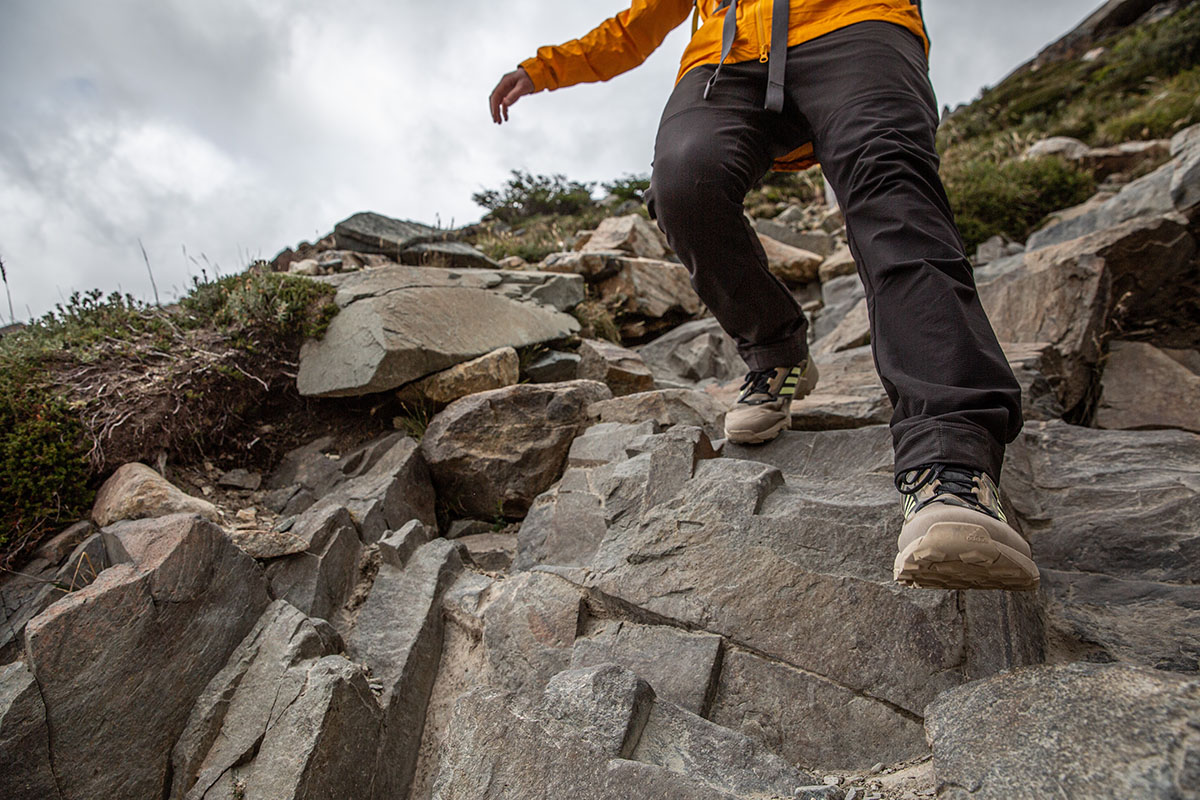
Once you narrow your hiking footwear search, you may be considering the GTX question: Do you need waterproofing or not ? In theory, waterproofing is a nice security blanket if you’ll be hiking in the mountains. The extra protection that comes with a waterproof and breathable membrane inserted into the shoe is great for creek crossings, surprise rainfall or if you hit snow on an early season trek. But the extra layer adds weight, impacts breathability pretty significantly (discussed below), and the designs aren’t always perfect. We’ve found Gore-Tex models to work consistently well, and many in-house designs perform similarly keeping water out (breathability is a different story), including the Oboz Sawtooth's BDry technology.
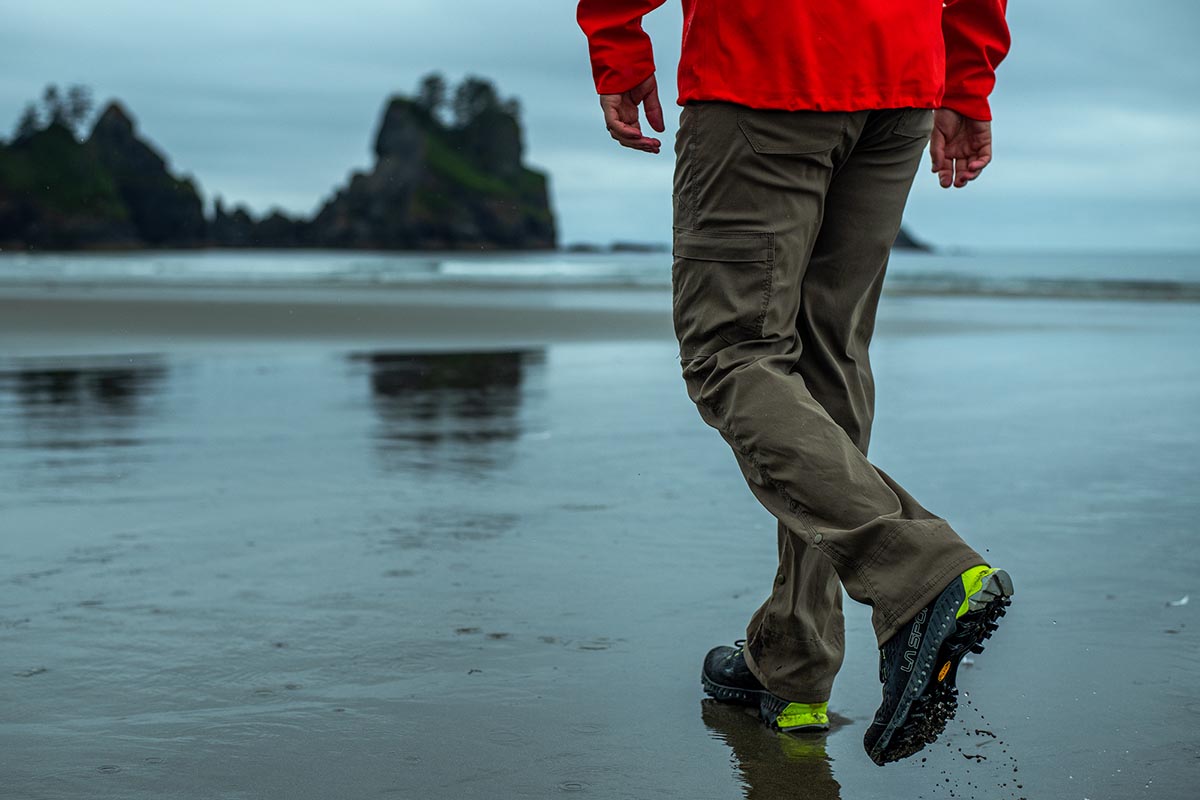
Whether or not you need waterproofing often comes down to a personal choice. Are you a summer-only hiker or live in a warm and dry area? We’d recommend a non-waterproof shoe in most cases, and some of the best ventilating shoes are the La Sportiva Ultra Raptor II and Merrell Moab 3 . But if you get into the alpine regions or would benefit from the added protection and modest insulation waterproofing provides, we’d lean the other way. The great news is that most shoes on our list are offered in both varieties. Expect to pay about $20 to $30 more for the addition of waterproofing.
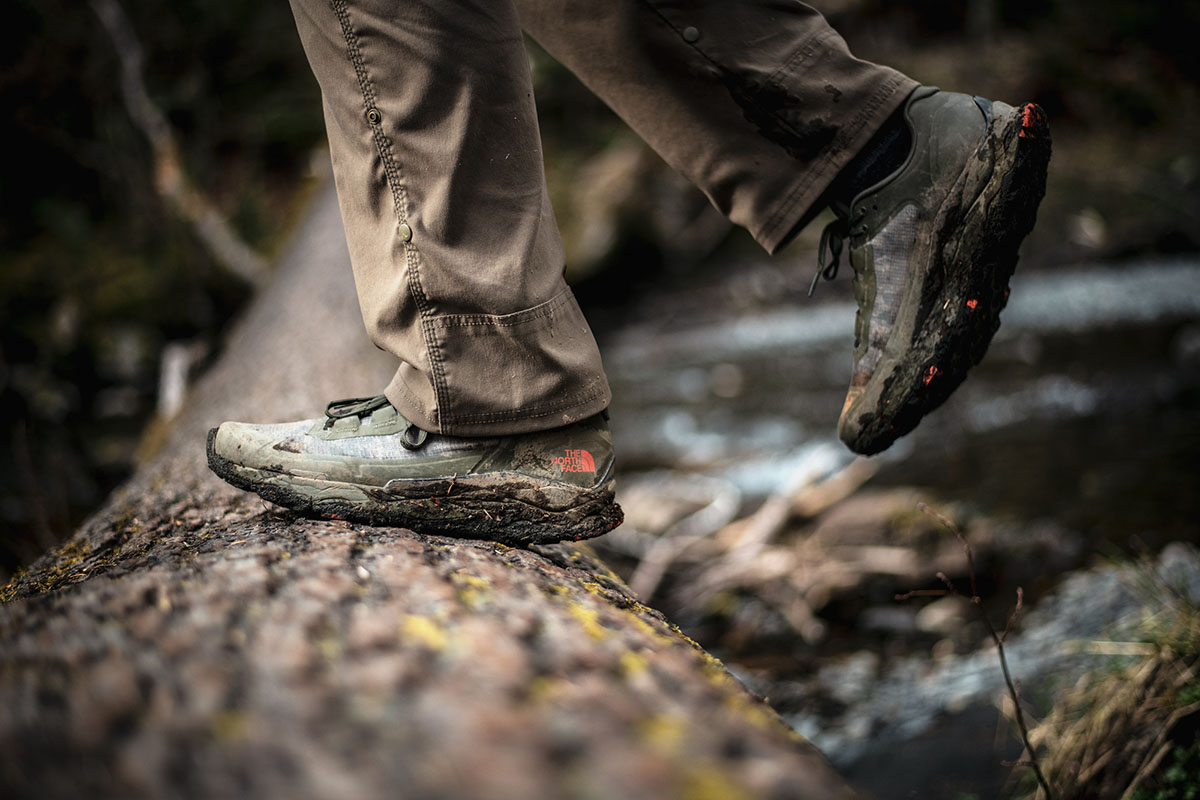
The truth about waterproof liners, even expensive Gore-Tex booties, is that they don’t breathe well—just as a waterproof jacket won’t be as breathable as a comparable non-waterproof version. Simply put, waterproof and breathable membranes restrict a shoe’s ability to pull moisture away from your sweaty feet as efficiently as a non-waterproof upper. Not all non-waterproof shoes should be treated equally, however. Footwear that features thinner fabrics and a lot of mesh will increase moisture transfer and airflow, which will keep feet less sweaty in hot weather as well as dry out soggy hiking socks far more quickly.
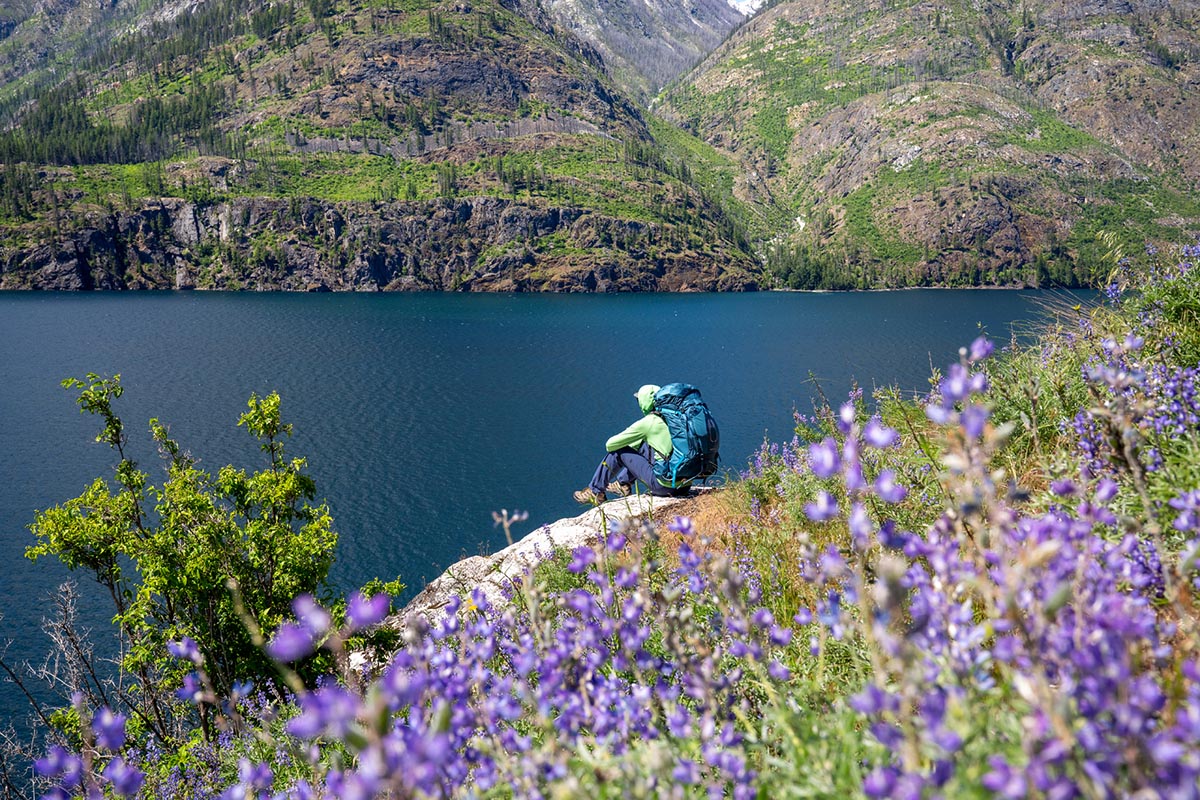
Gore-Tex Surround, which is designed to bring 360 degrees of breathability by venting out the insole of the shoe, is an intriguing, if expensive, concept. It’s been well received in a few models, including the La Sportiva Spire, but performance will always fall short of a shoe made mostly of mesh (for more, see our in-depth Spire review ). No matter your final decision, we encourage you to at least give non-waterproof footwear a thought before selecting your next pair of hiking shoes.
Easily overlooked, laces, as well as the lacing system of hooks and eyelets, play an essential role in fit and comfort. If a shoe has a poor lacing system that is prone to loosening, you’ll find yourself having to readjust constantly on the trail. If the system itself doesn’t secure your heel very well, the up and down walking motion will create hot spots and blisters. If the culprit is just the laces themselves, it’s an easy fix: There are a number of good quality replacement laces available. But if the system design doesn’t hold your foot very well, we recommend looking elsewhere.
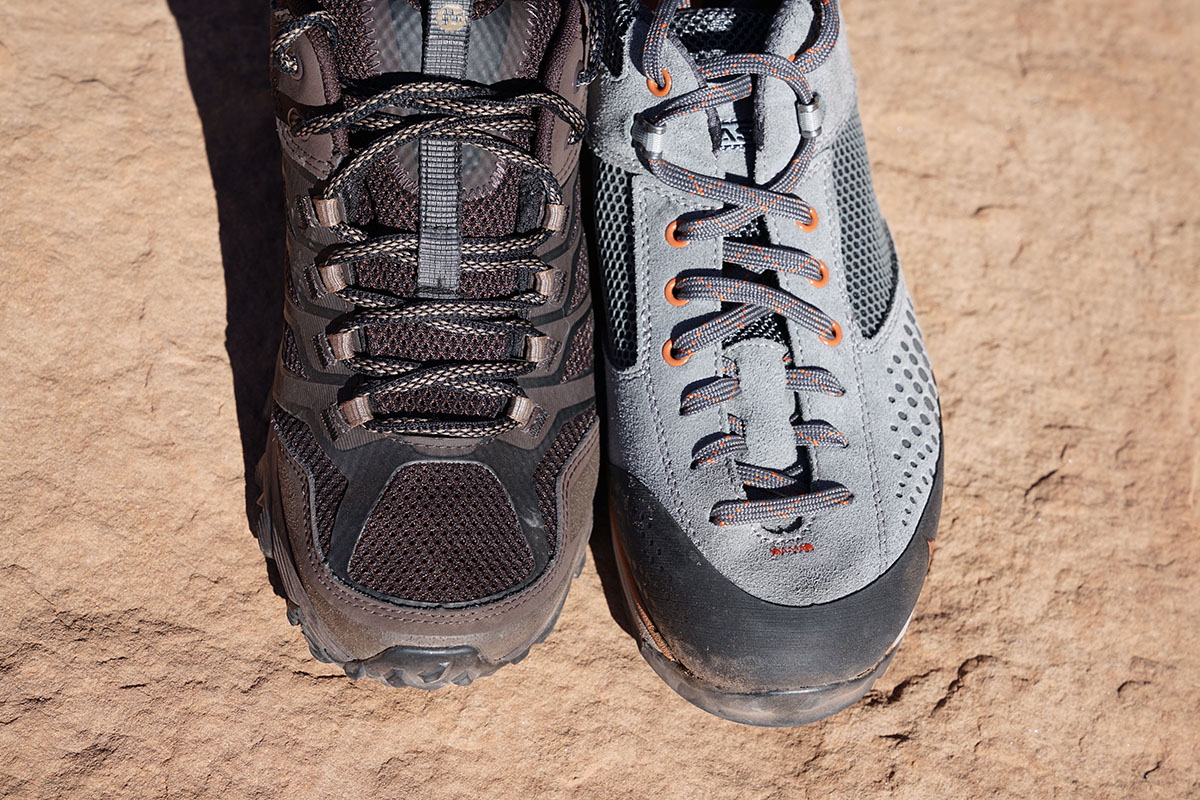
Some models, including the Salomon X Ultra 4 , have a single-pull lacing system. The design is totally convenient and we’ve had no more issues with durability than a traditional lace. One thing to keep in mind, however, is that you aren’t able to adjust the fit between eyelets, so the fit will be equally tight across the entire foot. Those with finicky feet that need to fine tune their laces to be comfortable may be best served avoiding quick lace designs.
.jpg)
Nubuck Leather Made of full-grain leather, but given a brushed finish that has a suede-like feel, Nubuck leather is a common sight on heavier-duty hiking shoes. The softer-touch leather is lighter and more flexible than traditional, glossy full-leather options and more durable than most nylons. It does fall short in breathability, however. As a result, it’s common to find a mix of leather and nylon mesh for abrasion resistance and breathability, as seen on shoes like the Merrell Moab and Keen Targhee Vent. Hoka's Anacapa 2 Low GTX also features a recycled mesh upper crisscrossed with Nubuck leather overlays, which boosts durability while still affording decent breathability—a tricky balance for waterproof shoes.
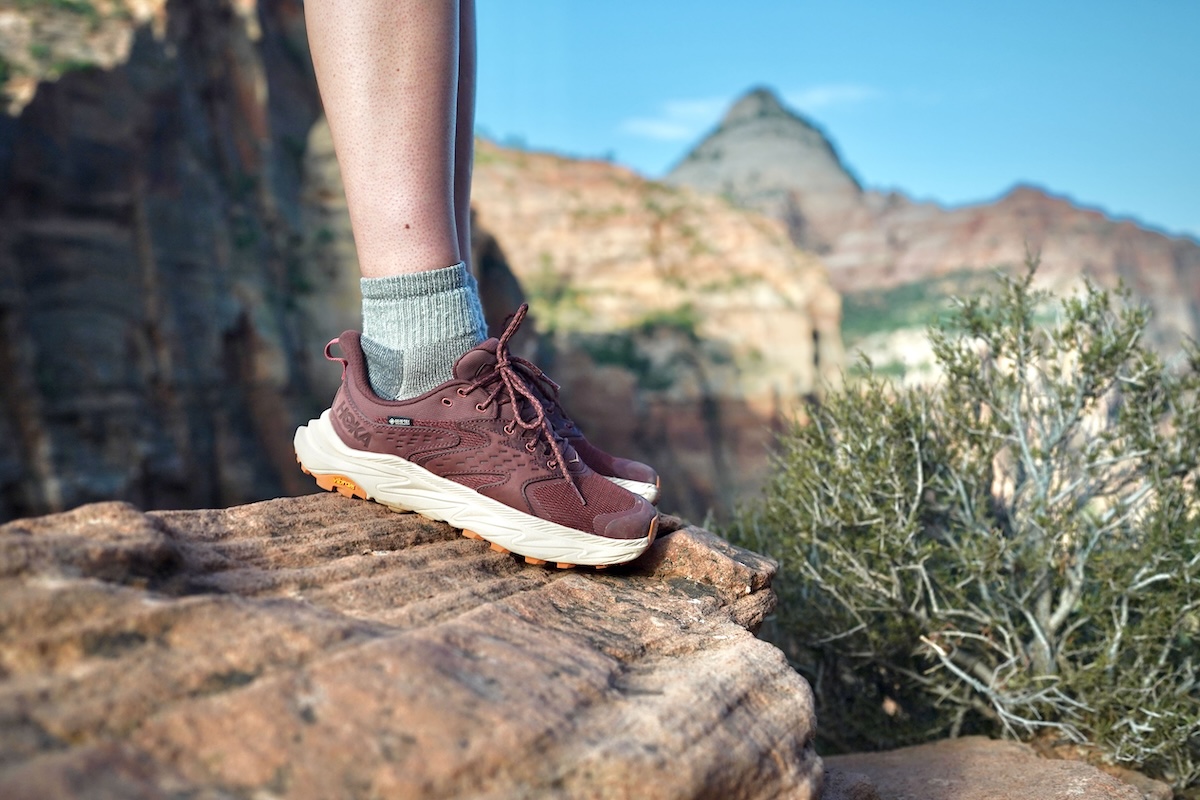
Digging a little deeper into the shoe's construction, we'll look at midsole construction next. Its importance lies in cushioning your feet, working as a shock absorber from impacts, and providing an additional layer of protection from sharp rocks. Depending on the design, midsoles vary from very thin (minimalist trail runner ) to stiff and substantial (burly hiking shoe). Most include EVA, TPU, or a combination of both in their construction. EVA Foam EVA midsoles are a common site on running and hiking footwear. The cushy soft material takes some of the sting out of your heel or midfoot impacts and is also extremely lightweight. While nearly all shoes on this list use some sort of EVA, the proprietary versions can vary from super soft to mildly stiff. For logging serious miles on tougher terrain, we prefer a firm and supportive midsole as opposed to too much cushioning. Those overly soft midsoles also have a tendency to break down overtime, much like a road-running shoe. In general, you pay more for an improved midsole design and a higher-quality EVA compound.
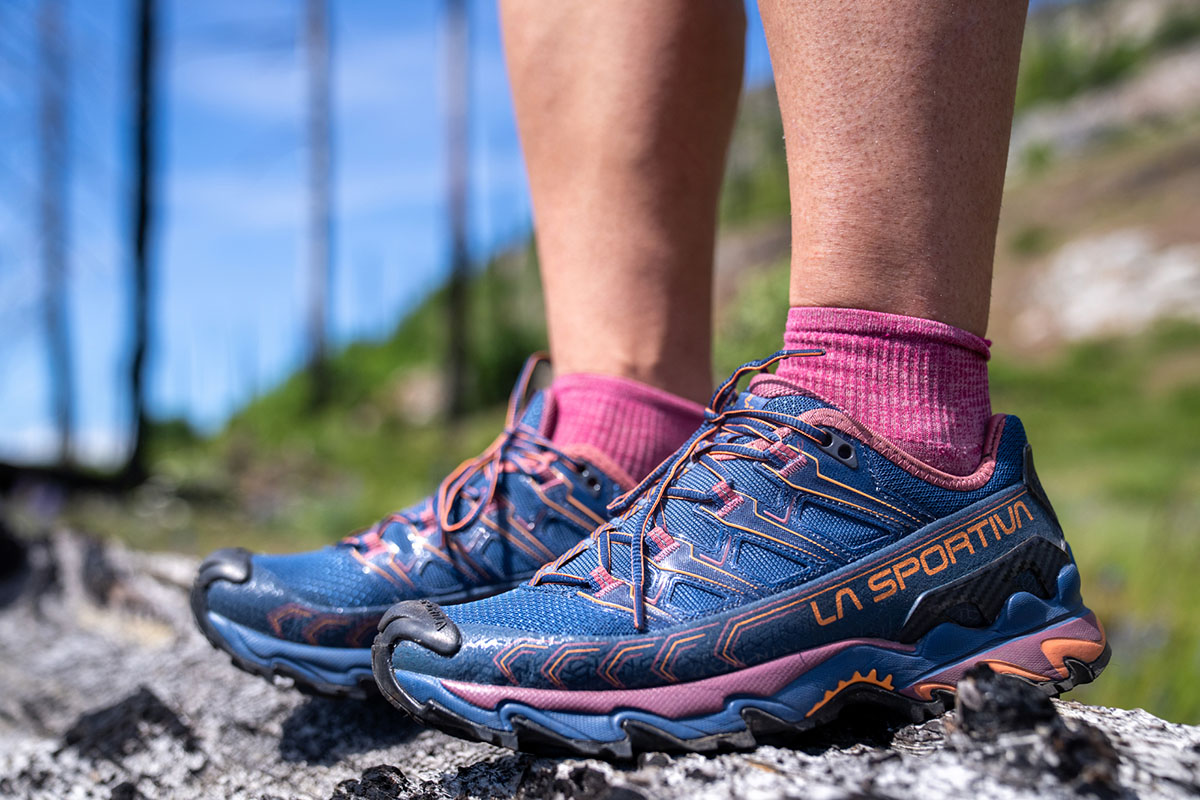
TPU Thermoplastic polyurethane, (mercifully) shortened to TPU, is a durable plastic commonly found in performance-oriented light hikers. Shoes that use TPU underfoot are often less cushy than those with only EVA but will last longer and better handle a heavier load. In addition, they’ll keep their shape longer and won’t be prone to compressing like EVA. Because both midsole types have valid applications and TPU is more expensive, it’s common for a manufacturer to use a TPU frame or shank for stability and toughness and add in EVA underfoot to increase comfort.
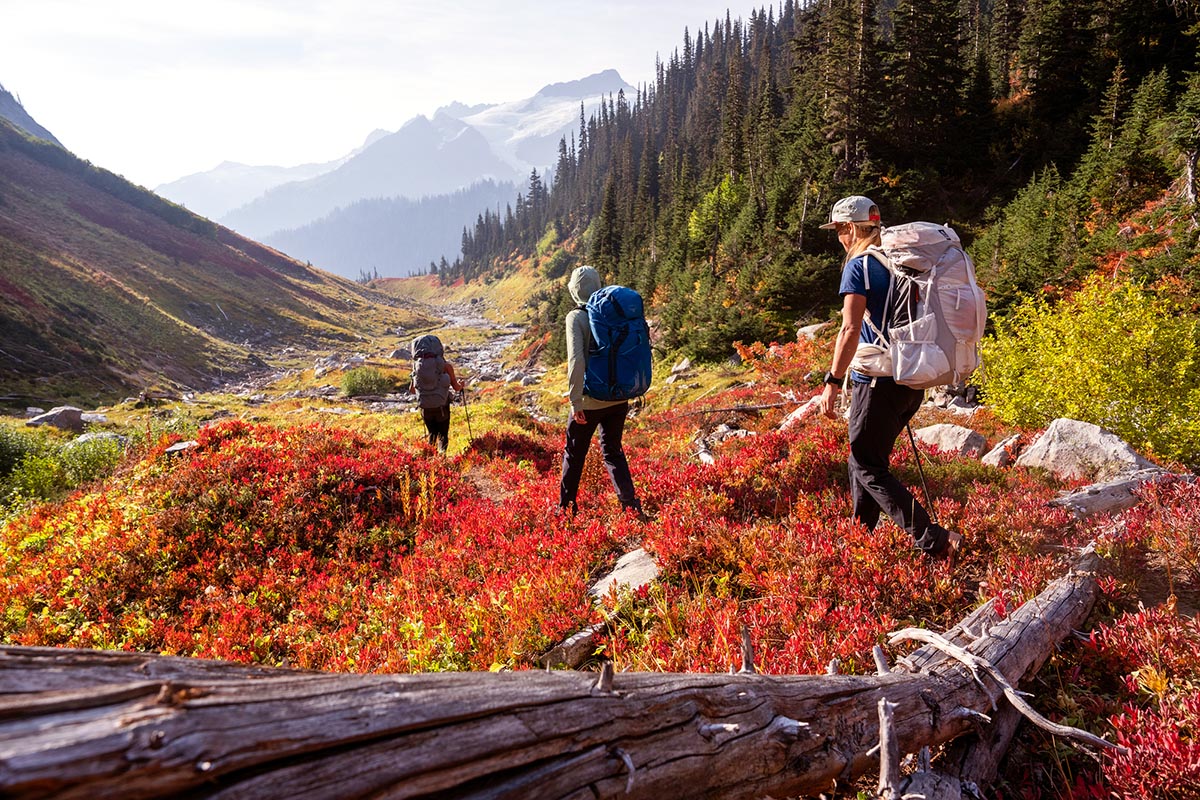
One of the main reasons to upgrade from a flimsy cross trainer to a true hiking shoe is for improved traction. In a way that more casual footwear can never match, hiking and trail running footwear is leaps and bounds better when the going gets rocky, slippery, and steep. And much in the same way that Gore-Tex dominates the market for mid to high-end waterproofing, Vibram inhabits a similar space for outsoles. Their name is synonymous with solid grip and traction on a variety of terrain, and Vibram rubber is incredibly durable compared to other compounds we've tested. Not all Vibram models should be treated as equals, however, as the rubber manufacturer tailors their designs for the specific footwear and brand. Some have much larger lugs underfoot for serious grip in mud, and others prioritize sticky rubber for scrambling over rocks. There are also more entry-level options that just do well on easier trails, like the lugs you’ll find on the bottom of the Merrell Moab 3 boots and shoes.
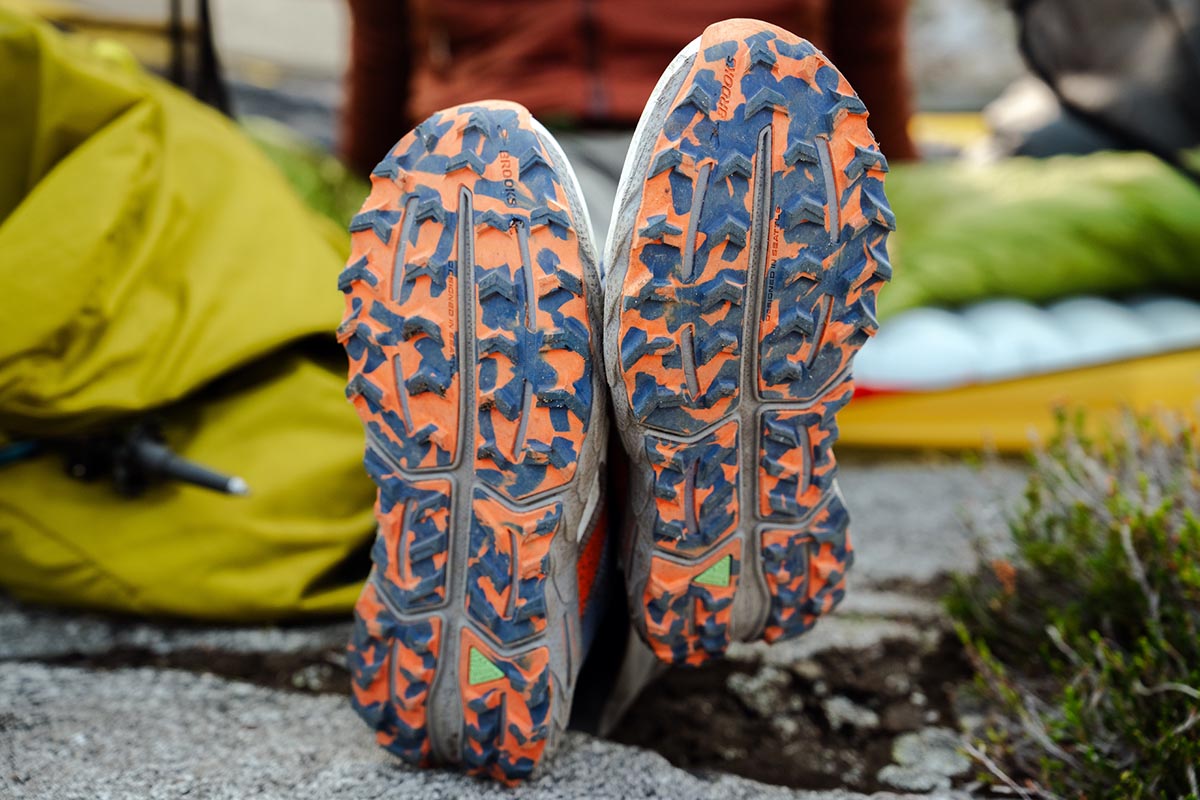
Salomon is one brand that doesn’t outsource their traction needs. Instead, they use their in-house Contagrip compound for all of their hiking and trail running models. We’ve found the level of quality and performance is in line with the Vibram offerings across the board, from anything from their fast-and-light X Ultra 4 hiking shoes to the burly Salomon Quest 4 backpacking boots.
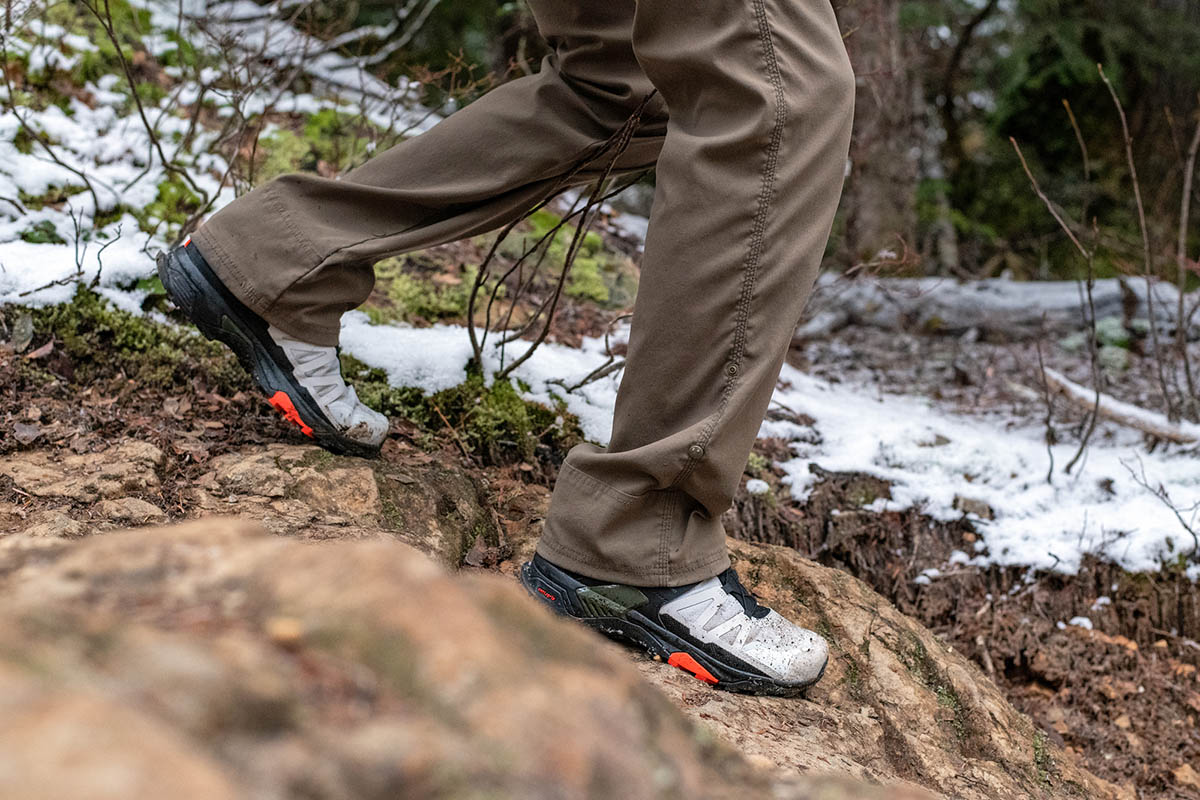
Hiking trails, even well maintained ones, are full of rocks, roots and other potential hazards, so we almost always recommend a hiking shoe with some type of toe cap. Lacking any protection on the front of your shoes can lead to a trip ruining impact when you inevitably look up from the trail to enjoy the scenery. Hiking shoes typically have a full rubber toe cap, but trail runners sometimes have a trimmed down version or none at all—one of the compromises in opting for a minimalist shoe. Approach shoes, on the other hand, have exceptional toe protection with their wraparound rubber rand at the front of the shoe.
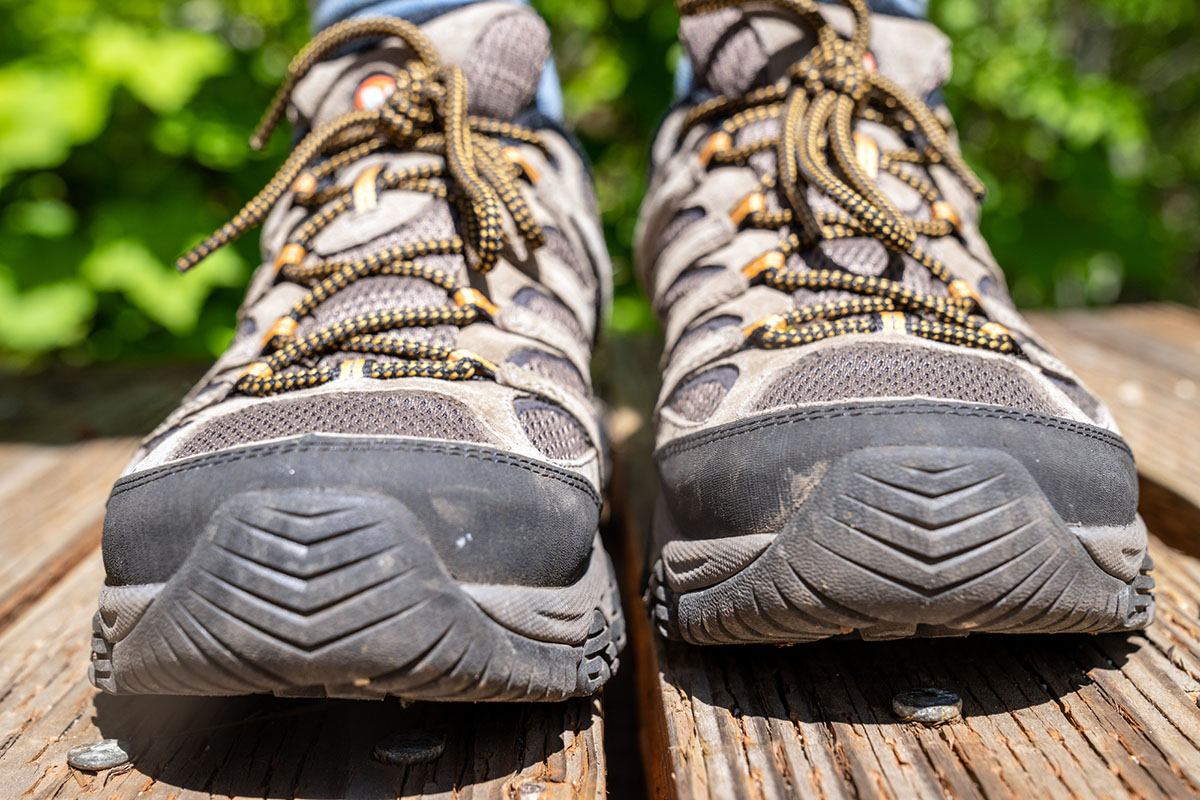
Just like with running shoes, the stock insoles that come with nearly every hiking shoe generally are cheap. For some, this might not make a difference, but for others it’s what separates comfort from misery. Thankfully, removing your insoles is super easy, and replacing them with an aftermarket model that’s specific to your foot size and shape can remedy most shoe maladies. New insoles can provide more or less volume to fill out the shoe, improve the fit under the arch, and increase or decrease the cushion and impact shock. We recommend checking out Superfeet insoles for their wide selection of options and trusted reputation in daily shoes, ski boots, and hiking footwear.
Hiking Shoes vs. Hiking Boots
Perhaps the biggest point of differentiation between hiking shoes and boots is height: Shoes have a low-top fit, while boots generally sit above the ankle. Hiking shoes excel on smooth trails where rolled ankles are less of a possibility, if you keep your pack weight down, and for those who want to move fast with less on their feet. Tradition tells us that hiking boots are the better choice for heavy packs and rough trails, and in most cases that holds true today. The tall height, along with laces that hold the shoe snugly around your ankle, offer a more secure fit, greater stability, and more protection. That said, with enough practice and trail time, hikers can build up ankle strength in low-top shoes and remain quite safe traversing the same terrain that they would in boots. Given the choice, we most often select a hiking shoe for its light feel, but both are viable options for day hiking, backpacking, and non-alpine peak bagging.
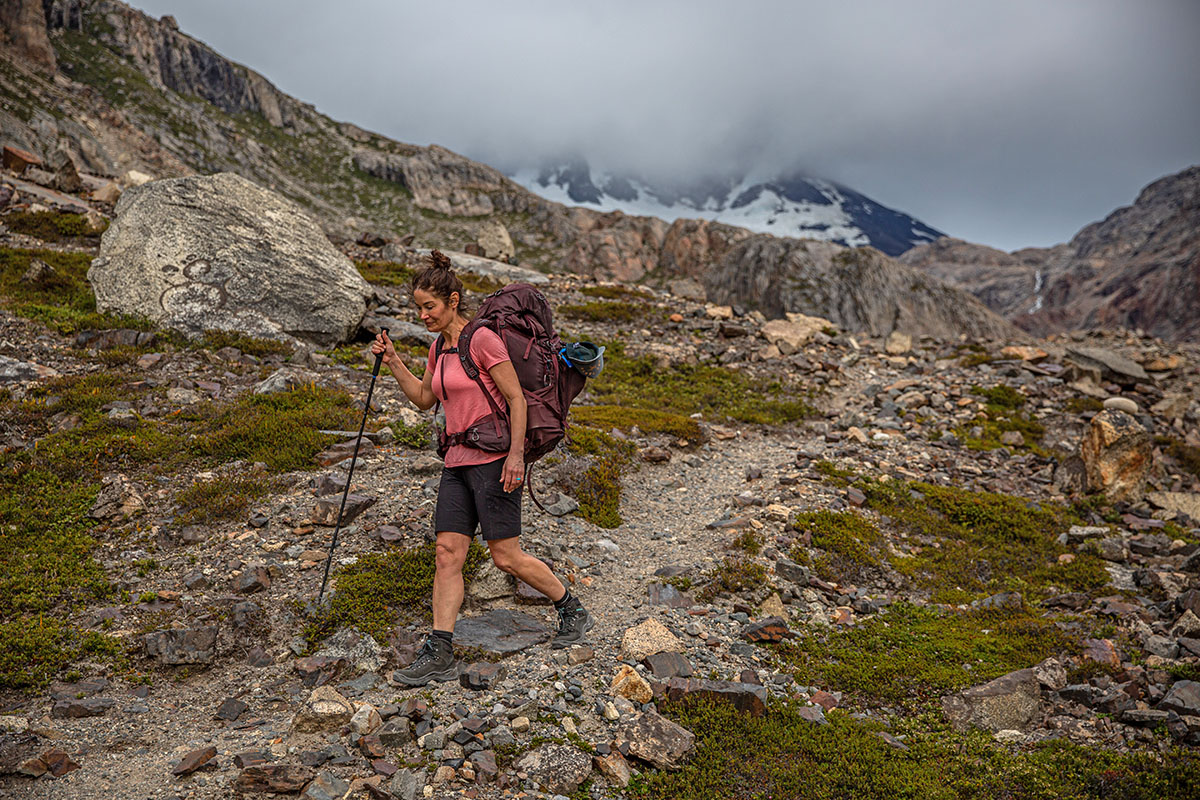
In 2024 and beyond, we see the lines between hiking shoe and boot categories continuing to blur. They still will be separated by height—although some modern boots only cover part of the ankle—but fewer and fewer boots resemble the heavyweight leather clunkers of old. One example is the over-the-ankle version of our top-rated Salomon X Ultra 4. It’s the exact same shoe with the same defining characteristics—feathery feel, aggressive stance, and supportive fit—but the “Mid” sits slightly higher on the ankle, weighs a couple more ounces, provides a little more protection, and perhaps a modest increase in rollover prevention. Since most folks stick to defined trails, the push for this type of light and fast footwear will continue to take over the market. Back to Our Top Hiking Shoe Picks Back to Our Hiking Shoe Comparison Table
Learn More About Hiking Gear
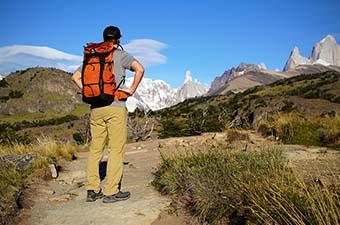
Hiking Gear Reviews
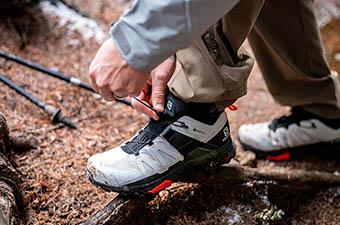
Salomon X Ultra 4 GTX Hiking Shoe Review
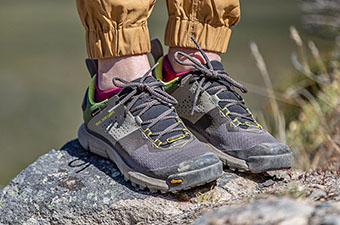
Best Women's Hiking Shoes of 2024
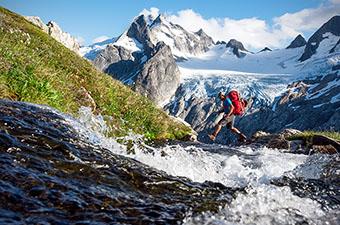
Do You Need Waterproof Hiking Shoes?
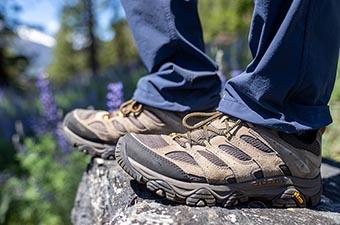
Merrell Moab 3 Hiking Shoe Review
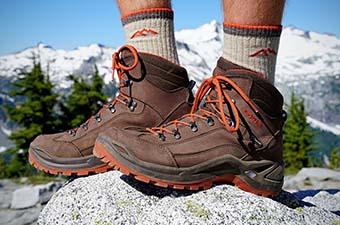
Best Hiking Boots of 2024
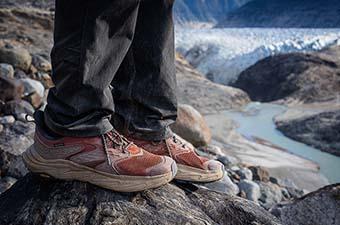
Hoka Anacapa 2 Low GTX Hiking Shoe Review
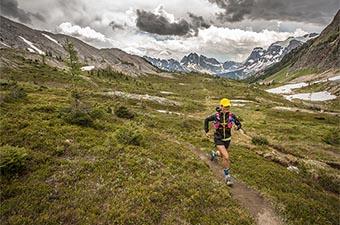
Best Trail Running Shoes of 2024
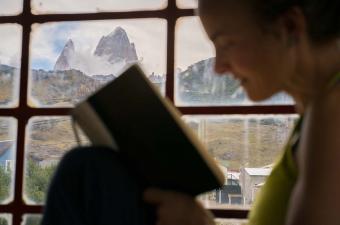
On Location: El Chaltén

Mobile Menu
Megamenu - desktop hamburger menu.
- Hiking Gear
- Backpacking Gear
- Biking Gear
- Camping Gear
- Footwear Reviews
- Climbing Gear
- Skiing Gear
- Winter Gear Reviews
- In-Depth Gear Reviews
- Hiking Shoes
- Hiking Boots
- Trail Running Shoes
- Mountain Bike Shoes
- Approach Shoes
- Climbing Shoes
- Beginner Climbing Shoes
- Mountaineering Boots
- Winter Boots
- Rain Jackets
- Down Jackets
- Synthetic Jackets
- Fleece Jackets
- Hardshell Jackets
- Softshell Jackets
- Windbreaker Jackets
- Ski Jackets
- Winter Jackets
- Hiking Pants
- Hiking Socks
- Trekking Poles
- Baby Carriers
- Running Vests
- Backpacking Tents
- Backpacking Packs
- Backpacking Sleeping Bags
- Backpacking Sleeping Pads
- Backpacking Stoves
- Backpacking Food
- Water Filters
- Altimeter Watches
- Handheld GPS
- Mountain Bike Helmets
- Mountain Bikes
- Mountain Bikes Under $1,000
- Mountain Bikes Under $2,000
- Gravel Bikes
- Bike Brands
- Kids' Bikes
- Hitch Bike Racks
- Camping Tents
- Rooftop Tents
- Camping Sleeping Bags
- Camping Mattresses
- Camping Chairs
- Camping Stoves
- Duffel Bags
- Rock Climbing Shoes
- Climbing Helmets
- Climbing Harnesses
- Climbing Quickdraws
- Belay Devices
- Climbing Ropes
- Climbing Backpacks
- Winter Gloves
- 4-Season Tents
- Ski Helmets
- Ski Goggles
- Ski Backpacks
- All-Mountain Skis
- Ski Bindings
- Backcountry Skis
- Backcountry Ski Boots
- Skis for Beginners
- Hardpack Skis
- Mirrorless Cameras
- Full-Frame Cameras
- DSLR Cameras
- Point-and-Shoot Cameras
- Travel Cameras
- DSLR Lenses
- Mirrorless Lenses
- Lofoten Islands
- Lofoten Hiking
- Hardangervidda
- Jotunheimen
- 10 Great Norway Hikes
- Public Huts
- Torres del Paine
- Chalten and Glaciares
- Lake District
- Patagonia National Park
- Milford Sound
- Abel Tasman
- Marlborough
- Great Walks
- Adventure Towns
Add adventure to your inbox
- Privacy Policy
- Terms of Use
© 2024 Switchback Travel. All Rights Reserved. No part of this site may be reproduced without our written permission.
- svg]:stroke-primary"> 735K
- svg]:stroke-primary"> 133K
- svg]:stroke-primary"> 54.1K
The Best Men’s Hiking Shoes of 2024, Tested and Reviewed
By Alex Murphy
Updated on Feb 29, 2024 6:20 PM EST
12 minute read
Best Overall
Scarpa rush gtx, most comfortable, merrell moab 2, best waterproof, salomon x ultra 4.
We may earn revenue from the products available on this page and participate in affiliate programs. Learn More ›
Hiking is the root of many outdoor activities, and the top men’s hiking shoes are going to help you go farther faster. They’ve replaced big, rugged boots for hikers who find boots overkill for trails or plan to pick up the pace.
If you’re looking to replace your heavy boots with something lighter, you’ll need to sort through the wide range of options, fits, and specialties of hiking shoes. I’ve turned that uphill march into a walk in the park by testing the best options on the market on my local Colorado trails. After putting miles on these shoes and evaluating their fit, traction, features, and support, I made my top picks for the best men’s hiking shoes.
- Best Overall: Scarpa Rush GTX
- Most Comfortable: Merrell Moab 3
- Best Trail Runner: Altra Lone Peak 6
- Best for Mixed Terrain: La Sportiva Ultra Raptor ll
- Best Lightweight: Hoka Kaha GTX 2
- Best Support: Garmont Groove G-Dry
- Best for Trail and Town: Danner Trail 2650 Campo GTX
- Best Waterproof: Salomon X Ultra 4
How I Chose the Best Men’s Hiking Shoes
I used my years of hiking knowledge to head into the Northern Colorado mountains on a mix of aggressive trails and paths—including creek crossings—to get a good take on what made the best men’s hiking shoe and what other unique aspects made other shoes stand out. I tested them with a series of steps including:
- Hiking: I started out each shoe with a short hike to give it some time to break them in. I then followed up with a longer hike that covered up hills and flat sections to get a good feel for the shoes.
- Water crossings: I made sure to spend sometime crossing wet rocks and downed trees, while also occasionally getting some shoes fully into the water to see if they kept my feet and socks dry.
- Sizing: With so much shopping done online, it’s important to get a good idea for a fit. As a size 11, some shoes felt a little too loose while others left no room in the toe box. As with most hiking shoes, having a gap between your toe and the front of the shoe is essential for hiking downhills.
- Uniqueness: I also made sure to test out anything that made a shoe unique to highlight what each hiking shoe was designed for—this included waterproof hiking shoes, alternative laces, and other qualities.

Best Men’s Hiking Shoes: Reviews & Recommendations
Key features.
- Designed for day hikes and trail running
- Waterproof to keep you going
- Weight: 1 pound, 10 ounces
- Great for fast hikers
- Extra padded soles to keep feet comfortable
- Designed to keep water out and to keep you moving on trail
- Most users will need to size up
- Not as breathable as someone other options
It might be surprising that trail runners are the best men’s hiking shoes, but more hikers are adopting this shoe style, myself included. I consider myself a fast hiker when I’m backpacking. I recently hiked 30 miles on a two-day trip. Often on trail, I bring trail runners, and Scarpa Rush fills that need. I found them to be a great version of a hiking shoe for those who move swiftly through rugged trails and like to keep moving.
There was also additional support in a thicker sole than you would find in a traditional trail runner, making this a great hybrid for anyone looking for an all-around shoe. Plus, the shoe did a great job of keeping water out while creek crossing yet still being breathable with its GORE-TEX design. One thing to note is the Scarpa Rush runs fairly tight. I usually wear an 11, and my toes were right up against the toe box in these 11s.
- Offers extreme cushion
- Vibram soles
- Weight: 2 pounds
- Affordable with lots of variations to fit your needs
- Sticky sole helps handle slick and wet rocks
- Felt broken in right out of the box
- With the added comfort comes a bulkier design and an overall wider looking shoe
- Did begin to feel sore after about ten miles
Slipping on the Moab, my most comfortable hiking shoe pick, felt like a cloud compared to some other brands. I noticed immediate comfort from the Moab’s cushioned design. The Moab 3 also handily dealt with rocky trails and roots in the Rocky Mountains, and with a Vibram sole, you can count on many miles and a rubber that’s sticky enough to handle slick terrain and rocks. Once I started pushing miles in these shoes, it eventually felt like a strain on my foot, so maybe these are best designed for the casual day hiker.
I also tried a few other Moab variations Merrell offers, including the waterproof version. It’s an excellent option for anyone who does a lot of creek crossing, casual fly fishing, or lives in a wet area. The sticky rubber also made it great for river crossing and overall kept my feet fairly dry as I crossed a few small creeks. You can also go with the Mid GTX (Gore-Tex) that takes the Moab design and makes it into a boot. Overall, I found it had the same comfort and strong attributions as the shoe, with added ankle support.
Best Trail Runner: Altra Lone Peak
- Available in wide
- Weight: 22 ounces
- Includes a rock plate
- Lightweight
- Zero drop for runners
- Minimal cushioning and arch support
If you’re looking to switch up your footwear, whether it be for hiking, trail running, or hunting, then it’s worth putting the Altra Lone Peaks onto your short list. Runners may discover that they naturally change their gait in footwear that promotes a mid-foot or forefoot strike, with subsequent benefits in their running form, knee pain, or both. One thing to note is that there is minimal support, particularly arch support in this shoe, so some runners may need to add in a custom insole, such as from Superfeet, to compensate.
These are some of the few true zero-drop shoes on the market that also provide a level of underfoot cushioning. The wide toebox helps to improve stability while hiking, especially over uneven terrain. Individuals looking to ease their way into true minimalist footwear should consider this as an in-between shoe that will allow their foot (particularly their arch) to strengthen after years of wearing more traditionally supportive shoes.
Best for Mixed Terrain: La Sportiva Ultra Raptor ll
- Gore-Tex extended comfort waterproof and breathable linings
- Can be resoled
- Weight: 1 pound, 11.5 ounces
- Breathable hiking shoes
- Thick rubber toe cap
- Pricey
This shoe bridges the gap between a trail runner and scrambler. It’s ready for unexpected weather, but without added weight and bulk. The outsole has one set of raised oval-shaped lugs that grip dirt and rock, as well as another set of lugs for stability by biting into the terrain for push off. The center of the insole has a deep cup with two big lugs on the back end that act as a braking system for hard stops or descending a steep slope.
The shoe is wrapped in an abrasion-resistant breathable mesh that is tough against rocks and sticks and does not allow in small debris. The toe of the shoe is reinforced by a huge rubber cap that absorbs impact and tackles obstacles in the terrain. I do worry that because the rubber is not flush with the shoe it could peel back over time, but it has yet to happen.
As for weather protection, the whole shoe is wrapped in Gore-Tex to keep your feet dry at all times. A simple, but secure, lacing system with one eye hook keeps the shoe snug. The heel does not have a pull loop, but rather a fold in the material that allows you to get a finger in to pull the shoe on. —Justin La Vigne
Best Lightweight: Hoka Kaha GTX 2
- Available Sizes: 7-15
- Price: $240
- High ankle support
- Cushy footbed
- No wide options
The design of the sole of the Kaha GTX has a very slight arch, which creates a rocking motion to spring my steps forward. I feel a bounce in my steps along with the enhanced cushion. Released just last year, the GTX 2 has a more plush cushion and my feet never ached or fatigued. The newest GTX also utilizes more sustainable materials, like recycled Gore-Tex textiles. These are one of the few pairs of shoes that I don’t feel I need to replace the insole with aftermarket versions because of the ideal shock absorption.
I tramped through wet and muddy swamps and the Gore-Tex lining kept my feet completely dry. Comprised of Vibram Megagrip, the multi-directional rubber lugs of the outsole gripped well and kept me moving forward. If there are any downsides, it’s been my experience that after extensive use — especially after hiking on sharp lava rock — the outsoles do wear down faster than other shoes I’ve tested. —Justin La Vigne
- G-Dry tech is waterproof and windproof and keeps your foot dry
- Sturdy middle foot for those who want extra support
- Weight: 2 pounds
- Good hiking shoes for rocky terrain
- Waterproof adds confidence in creek crossing
- Sturdy for those who need extra support
- A fairly narrow shoe, so you may need to size up
- If you care about your shoes looking new, that won’t last long as the black leather exterior is like a magnet for dirt
Out of the box, the Garmont Groove G-Dry lives up to its sturdy design. I took these on a fairly aggressive uphill trail in Roosevelt National Forest, and it took a bit of walking before I could feel my feet getting used to them. I prefer fairly flexible footwear, so it took a minute to get used to the Groove’s stiffness. However, the Groove may be a great option for anyone looking to get the extra support of a boot in a shoe.
This best men’s hiking shoe also does a great job of keeping things dry, as I found when I tested it around the Poudre River. One con is the all-black design does attract plenty of dirt, so you’ll have to rinse them off to keep them looking pristine.
- Breathable lightweight design
- A unique design with a sock-like fit you slip your foot into
- Very breathable hiking shoe
- Great grip and handling of trails
- One of the pricier options
- Takes a bit to get used to the fit and may be a little loose
The first thing I noticed with the Danner Trail 2650 is they look cool. I have a pair of blue ones, and they look like you can wear them just about anywhere.
Aside from looking the part, Danner also uses the Vibram sole for great grip. While the actual shoe is thin and breathable, I found it had extra reinforcement where you need it, like on the toe box, which is helpful on rocky trails. The GORE-TEX material also helped keep my feet dry from outside water while allowing for breathability and avoiding sweaty feet. I would recommend sizing down these men’s hiking shoes in some cases as I felt a little bit of wiggle room, especially around the heel.
Best Waterproof: Salomon X Ultra 4 GTX
- Gore-Tex waterproof shoe
- Weight: 1 pound, 11 ounces
- Does great handling water and kept my feet dry
- Lightweight compared to some competition
- Traction didn’t feel as good as the brands using Vibram rubber
- Opting to not use traditional laces can take getting used to for the right fit
Many hiking shoes use Gore-Tex technology, and to test them, it was easiest to just hike right into a river. I will say, out of all of them, the Salomon X Ultra 4 GTX kept my feet the dryest. In the water the grip also held up close to competitors who used the Vibram rubber.
Instead of traditional laces, the shoes have a SensiFit system that works like a drawstring. While many may like this feature for its snug fit, it took me time to get used to it and optimize the feel for my feet. The sizing is also true to size and the shoe felt good to go right out of the box.
How to Choose the Best Men’s Hiking Shoes
There is a lot that goes into picking the best hiking shoes . Luckily, a few simple steps can make sure you find the perfect fit to avoid injury and find what works best for you.
Starting with what might be obvious, but can be overlooked, hikers need to examine their own feet. Cramming wide feet into a thin shoe leads to blisters and other problems. So, getting your feet measured and finding the right fit is key.
Also, all shoes have a drop, that’s the height from your heel to toe, and it can have a big impact on how you walk. For those who aren’t used to a zero drop, you’ll notice it quickly when you buy a flat shoe. It’s good to ease into any drastic changes when it comes to a drop height as too many miles with a big change can lead to an injury.
Next up, knowing where and how you plan to use a shoe is also key. Different footwear could come in handy on the marshy trails of the Southeast compared to rugged rocky paths you come across in the West. If you know you may often be crossing a creek or muddy paths, a waterproof shoe should work in your favor, as opposed to a trek up a 14er, something a little tougher could be more ideal. If you plan to travel, finding an all-around diverse shoe may work best, but keep in mind how often you use it and where you do so.
This is best answered by knowing where you live and where you plan on taking your hiking shoes. Waterproofing is great in most places, even if that’s just a rainstorm. However, opting for waterproof hiking shoes could cost extra and you may not need it especially if you live somewhere dry or rarely cross trails with running water. Keep in mind that if you are going to be hiking in deep water for long periods of time, you may be better off with one of the best water shoes for hiking .
In many cases, the best hiking boots are more than you’ll need. Not to mention the added weight can slow you down on trail. The best men’s hiking shoes allow for some of the sturdier qualities found in boots while letting your feet breathe better and make it feel less like you have cinder blocks tied to your feet. Especially, if you’re not used to wearing boots. Plus, packing hiking shoes for a trip is going to save a lot of space compared to boots. If you find that the best hiking shoes are more than you need, consider one of the best minimalist shoes for hiking and trail running .
Just like the best hiking pants , some hiking shoes are designed specifically for town to trail in a way that lets you take them anywhere. This is primarily a focus on the look of these shoes and less on the capabilities for trail. However, if you want your shoes to last longer, it’s best to switch them out while not hiking.
The general rule for most men’s hiking shoes is about 300 to 500 miles. It depends a lot on the brand and what you’re willing to put up with. In some cases your body will start to ache from older shoes, meaning it’s time to get a new pair as the sole has worn down and any padding is no longer protecting your ankles and knees.
Hiking shoes should be locked in at the heel, but then loosen up as the foot moves forward. If the balls of your feet feel constrained or your toes are unable to splay (inhibiting shock absorption) then the shoe’s volume is too small for your foot. One option to increase the volume of the shoe is to take out the insole.
Trail runners and hiking shoes both cost in the neighborhood of $100 and $200. However, keep in mind that hiking shoes typically last longer than trail runner.
Final Thoughts on the Best Men’s Hiking Shoes
No matter what new outdoors or action sport I get into, I always return to hiking. It’s the most accessible way to get out the door and in nature. Outdoor gear is far from cheap, but having the best men’s hiking shoes can make all the difference. They protect your feet on hike and while getting to a crag or fishing spot. Taking the time to find a shoe that fits correctly and is the best design for where you’ll be using it will only pay off in the end.

- Shoes & Boots Reviews
- Hiking Gear Reviews
The 7 Best Hiking Shoes for Women of 2024

On the hunt for new hiking shoes? In 11 years, we have put 126 pairs of the best hiking shoes through extensive testing. In this update, our all-female hiking team compares the 18 top women's hiking shoes available today. Our hiking experts have done the leg work, busting out hundreds of miles over the years through deserts, forests, mountains, and streams. We carry loaded packs, consider all-day comfort, and evaluate traction over and through wet, loose, slippery, and uneven terrain. From differing foot shapes to varied trail conditions, we consider it all and rank each shoe according to our on-trail experiences. Over months of side-by-side comparison and testing, we tease apart the differences between these shoes and share our findings to help you hone in on your perfect pair.
Hiking in the great outdoors is a ton of fun, whether you load up on gear or head out with nothing more than your favorite hydration pack and a solid pair of shoes. And if you are the kind of hiker who loves to have all the high-end gear , we've probably tested it and have recommendations for you. If you are planning longer treks carrying a heavy pack or just prefer to have a bit more support, you might be interested in our reviews on the best women's high-top hiking boots . If you're looking for the best men's hiking shoes , we've tested those too.
Editor's Note: Our women's hiking shoe review was updated on April 17, 2024, to include 3 new products along with updated media and testing perspectives.
Top 18 Product Ratings
Best overall women's hiking shoe, la sportiva spire gtx - women's.
- Comfort 8.0
- Support 8.0
- Traction 9.0
- Water Resistance 9.0
- Durability 8.0
The La Sportiva Spire GTX features a low-profile design that combines the agility of a trail runner with the stability of a hiking boot into one unstoppable trail shoe. The fit is comfortable right out of the box, though it may run a little big and favor those with a high arch. The abrasion-resistant mesh upper combined with the compression-molded midsole offers excellent support while remaining flexible, whether day hiking or considering an extended trip into the backcountry with the added weight of a pack. The Vibram XS Trek outsole and Stability Control System built into this design are ready to tackle any type of terrain without sacrificing ground feel underfoot or responsiveness on the steeps. This shoe features one of the highest flood levels, measuring 3.75 inches above the ankle, and a waterproof membrane that remains breathable without allowing water to penetrate the shoe. Whether crossing creeks during high runoff or moving through melting, slushy snow, this shoe is up for the challenge.
For some who are seeking simple day hikes on well-maintained trails, this shoe may be overbuilt with too many additional features. The waterproof membrane may also be too hot for those who plan to hike at lower elevations during the heat of summer. And finally, though we love Sportiva's nod towards sustainability by including 100% recycled polyester laces, they may require adjustment or replacement depending on your foot shape and how much off-trail travel you get up to. While the Spire is one of the most expensive designs that we tested, we believe it's worth every penny and will last for many hiking seasons to come. If this shoe is a bit out of your budget, the Merrell Moab 3 stands out for its price to performance ratio.
Read more: La Sportiva Spire GTX review
Best Bang for the Buck
Merrell moab 3 - women's.
- Traction 7.0
- Water Resistance 4.0
- Durability 7.5
The Merrell Moab 3 is a constant and reliable hiking shoe for those seeking performance at a reasonable price. The mesh and leather combination upper are comfortable out of the box, though we found that it took a few miles on the trail before hitting the sweet spot. The shoe is true to size and available for those seeking both regular and wide fits. The Super rebound compound midsole offers a ton of support, especially for those with high arches. Merrell also upgraded the outsole to a Vibram TC5 rubber that performed much better than its predecessors, thanks to a multi-directional lug pattern. Though this is not a waterproof shoe, we found it to be perfect for hot desert trails or low-elevation hikes when precipitation isn't in the forecast, as the lack of a waterproof liner helped increase the breathability and overall comfort of the shoe.
For those of you looking for lightweight performance, this shoe is not the best choice, as it weighs in with some of the heavier hiking shoes that we tested for this review. We attribute this additional weight to the beefy Vibram outsole that effectively protects every stride from debris along the trail, in addition to the excessive padding that surrounds the ankle collar. While we didn't experience any durability failures during our testing period, we can't help but question the mesh upper that could easily snag on technical terrain. The lacing attachments are also constructed from mesh and webbing, which doesn't inspire much confidence in their longevity. Overall, this shoe remains a consistent top performer, especially for those seeking a more affordable option for day hikes and backcountry overnights, and everything in between. If you're brand new to hiking and looking for some shoes to see whether or not you like the sport, we recommend the Columbia Crestwood – this model surprised us with its overall performance considering its notably low price.
Read more: Merrell Moab 3 review
Best Hiking Shoe Below $100
Columbia crestwood - women's.

- Comfort 7.5
- Support 7.5
- Water Resistance 3.0
- Durability 6.5
The Columbia Crestwood is a lightweight and nimble hiking shoe that features a suede leather and mesh combination upper, which allows for out-of-the-box comfort and a flexible sneaker-like feel underfoot. The shoe runs true to size and is available for those with narrow and wide foot shapes. The design supplies just enough padding surrounding the ankle and the bellow tongue without adding a ton of bulk and weight below your feet. The Omni-grip rubber outsole performed well on most terrain types, though we found it to offer the most security on slippery boulders and polished rocks along the trail.
While this is not a waterproof design, we believe you can work that into your favor by selecting this shoe for its breathability rather than waterproof protection. The enhanced breathability is perfect for those day hikes in the desert or at low elevations during the hottest months of the year. While we didn't experience any issues regarding durability during our testing period, we can't imagine these shoes will last as long as their leather counterparts, especially with the flexible mesh upper and mesh lacing attachments. Overall, our testers were impressed with the performance of this shoe, which is available for a price that doesn't break the bank. If you have the funds to invest in a burlier pair of shoes, the La Sportiva Spire GTX is one of our all-time favorites.
Read more: Columbia Crestwood review
Best for Slickrock
La sportiva tx4 - women's.
- Support 9.0
- Water Resistance 5.0
The La Sportiva TX4 is more than just a shoe that's built for long and arduous climbing approaches. It's time to let hiking enthusiasts in on the secret to navigating slippery and polished rock on the most popular hiking trails. Featuring Vibram Megagrip Traverse rubber with an Impact Brake System, these shoes will provide the ultimate confidence underfoot. In addition to top-of-the-line traction, the TX4 offers a comfortable and supportive feel directly out of the box thanks to the STB Control System for torsional stability and a spacious fit in the forefoot.
Unfortunately, the TX4 is not fully waterproof, but it does perform well when moving through shallow stream crossings, mud puddles, and even melting snow patches. The nubuck leather upper features a very high-quality construction and can be treated with waterproof protection if desired, though it may affect the breathability. While we didn't experience any issues with our TX4s during our testing period, we couldn't help but notice other models on the trails wearing holes near the big and pinky toe and the tiny orange cord ripping out around the laces and the heel pull tab. Regardless, this quickly became our go-to hiking shoe for navigating slickrock trails from the slippery granite in Yosemite Valley to the polished sandstone in Zion National Park. If you know you'll be encountering some shallow creeks and puddles or maybe a little rain, the Salomon X Ultra 4 Gore-Tex is about as good as it gets in terms of water protection.
Read more: La Sportiva TX4 review
Best for Versatile Performance
Salomon x ultra 4 gore-tex - women's.
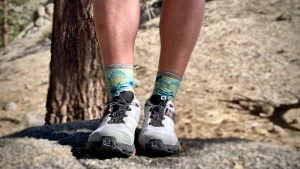
- Comfort 7.0
- Traction 8.0
The Salomon X Ultra 4 Gore-Tex features excellent traction, a relatively lightweight design, and impressive midfoot stability. With a sleek, modern appearance and a snug, protective fit paired with a surprisingly solid base, it proves particularly well suited to technical backcountry terrain and mountaintop scrambles. The welded, synthetic upper does a great job of locking the forefoot and heel securely into place for stability from the bottom up. Meanwhile, the rubber Contagrip sole features a chevron lug pattern to enhance traction while navigating loose scree or wet and slippery rocks, and the Gore-Tex liners deliver watertight confidence during inclement weather. The X Ultra 4's toe box is also notably roomier than in previous iterations, making it spacious enough for those with a wider foot. Just keep in mind that the Salomon fit typically favors those with narrow feet and higher arches.
When it comes to agility and responsiveness on technical terrain, the X Ultra 4 makes a fantastic shoe, even if it isn't our go-to for multi-day expeditions while carrying a heavy pack. Perhaps our biggest complaint about this shoe is the Quicklace system — it's designed for convenience but ultimately prevents a customized fit and requires adjustments due to loosening on the trail. We also don't recommend this shoe if you plan on primarily traveling off trail, as the synthetic, welded upper isn't substantial enough to endure the impact from constant boulder-hopping over sharp rocks, talus, and scree. Still, these are an all-around, hard-charging option available at a reasonable price. If you know you have feet that are a little happier in wider shoes, the Hoka Anacapa 2 Low GTX is one of our favorites when it comes to comfort.
Read more: Salomon X Ultra 4 Gore-Tex review
Most Comfortable
Hoka anacapa 2 low gtx - women's.

- Comfort 9.0
- Water Resistance 7.0
- Durability 6.0
The Hoka Anacapa 2 Low GTX is a lightweight and uniquely engineered hiking shoe that prioritizes all-day comfort through a thickly-cushioned sole that helps to propel you forward with every step on the trail. The recycled mesh upper also contributes to overall comfort by releasing moisture that's built up during those hard-earned trail miles, as well as protecting the feet during stream crossings with exceptional Gore-Tex Invisible Fit technology. The Vibram Megagrip outsole performed well, whether our team was navigating the steeps or cautiously hiking on slippery boulders found on popular trail systems.
Though these shoes are designed with neutral stability in mind, we found that adding an aftermarket insole enhanced arch support for those who need or prefer it. We would also like to recommend engaging the extra runner's loop eyelet near the ankle, which will help to lock your heel into place, especially on steep and demanding trails. The sole of the Anacapa is comprised of a lightweight, soft rubber and a high-performing Vibram Megagrip rubber. Unfortunately, we noted that the softer rubber can be impacted when navigating scree fields and burlier terrain. Still, these hiking shoes impressed our testing team thanks to their standout comfort, breathable waterproof capabilities, and solid traction whether you're headed out for a multi-day backpacking trip or a short weekend stroll. If you can sacrifice a bit of comfort for streamlined weight and better durability, the The North Face VECTIV Fastpack FUTURELIGHT is built for speed.
Read more: Hoka Anacapa 2 Low GTX review
Best for Speed
The north face vectiv fastpack futurelight - women's.
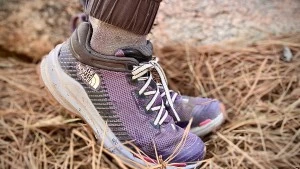
- Traction 6.0
- Water Resistance 8.0
- Durability 7.0
The North Face VECTIV Fastpack FUTURELIGHT is our favorite hiking shoe to recommend for those seeking to drop the added weight and bulk of a traditional hiking shoe without sacrificing high performance. This shoe features a moderate cushion and a unique rockered design that feels comfortable right out of the box and centers around maximizing energy output on the trails. The fully waterproof design allows space for air to permeate the abrasion-resistant mesh upper and increase overall breathability without losing any waterproof performance.
This high-performing shoe is not without some caveats. While we appreciate the reduced weight and bulk, we also can't imagine this shoe will offer the same durability as other more substantial, heavier synthetic and leather uppers. While we love this lightweight design for day hikes and fastpacking missions, it wouldn't be our first choice for an extended backpacking trip with any significant weight on our backs. All that said, if you're looking to shed some weight without losing torsional stability and waterproof performance, this is a shoe that will maximize forward motion without slowing you down. For those that are heading to redrock country (like a lot of us are), we've found that the La Sportiva TX4 is by far and away the best option for sandstone.
Read more: The North Face VECTIV Fastpack FUTURELIGHT review
Compare Products

How We Test Hiking Shoes
Before testing begins, we research a wide variety of available options. After scouring the market and vetting many manufacturers and models, we purchased all the shoes in this review at retail price. Our selection includes models that we consider to be the most promising, innovative, intriguing, and of high value. We then test our selected models for months, hiking many miles in each pair, sometimes under heavy packs. We assess their comfort and how suitable each shoe is for different foot shapes, noting adjustment points like laces and tongues. We evaluate arch and lateral structures for support and test traction on a variety of surfaces, from rock slabs and wet logs to sandy trails and mud. We test out their water resistance by submerging them in several inches of water for five minutes, as well as flowing streams. For more on our testing process, see our How We Test article.
- Comfort (25% of overall score weighting)
- Support (20% weighting)
- Traction (15% weighting)
- Water Resistance (15% weighting)
- Weight (15% weighting)
- Durability (10% weighting)
Why You Should Trust Us
Comfort and support tests are the two most important metrics we investigated, and together, they make up nearly half of the total weighted score. We wore each pair of hikers in various terrains, from soft trails in the forest to scree-covered buttes and scrambles over slippery granite. We assessed support while traveling light and while wearing a heavier pack, checked traction by wearing them back-to-back on dry and technical scrambles, and carefully evaluated all of their positive and negative attributes along the way. Since 2012, we've tested over 50 unique hiking shoes for women, giving us insight to better evaluate the performance of each and every shoe.
Our review team is headed up by a team of strong women with decades of hiking experience. Our lead tester is Trish Matheny , an avid climber, splitboarder, ultra runner, and gear junkie. Pick a day, and Trish is on the move, probably testing gear. She is backed up by Myrha Colt , a long-time adventure travel professional and trail enthusiast whose feet have carried her from the rugged backcountry trails of the US West to dramatic heights and dusty roads in trekking hot spots worldwide. Also contributing to this dynamic team is long-time climber, backpacker, and all-around outdoor gear expert Mary Witlacil . These three backcountry connoisseurs are well-versed in assessing the features that make a great trail shoe while calling out the hiking shoes that may miss the mark. So it is with great enthusiasm they bring you their final, well-vetted assessments.
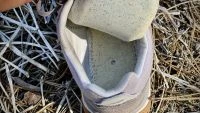
Analysis and Test Results
Following our testing period, we scored each pair of hiking shoes on specific criteria so you can find the best shoes for your needs . Read on to learn more about each metric and which shoes rose to the top.
Hiking is, at its core, a pretty basic activity that requires much less gear than most other outdoor activities. That being said, a good pair of hiking shoes tailored to your specific outdoor objectives is essential and can make all the difference in enjoying your experience. Back in the day, you could buy one pair of leather hiking boots that would last a decade or two. Given the lighter weight and high-performing materials of today's styles, many new hiking shoes may last only a fraction of that lifespan. There's no doubt modern hikers benefit from innovative design and advanced technologies. But people who hit the trail often are apt to blow through one or two (or even more!) pairs each year. Though the hiking shoes in this review may not be outrageously expensive, costs add up if you're replacing your trail shoes often. We offer opinions on the value of each shoe based on the metrics below, but to a certain extent, any final assessment will depend on two things: your hiking priorities and your specific fit.
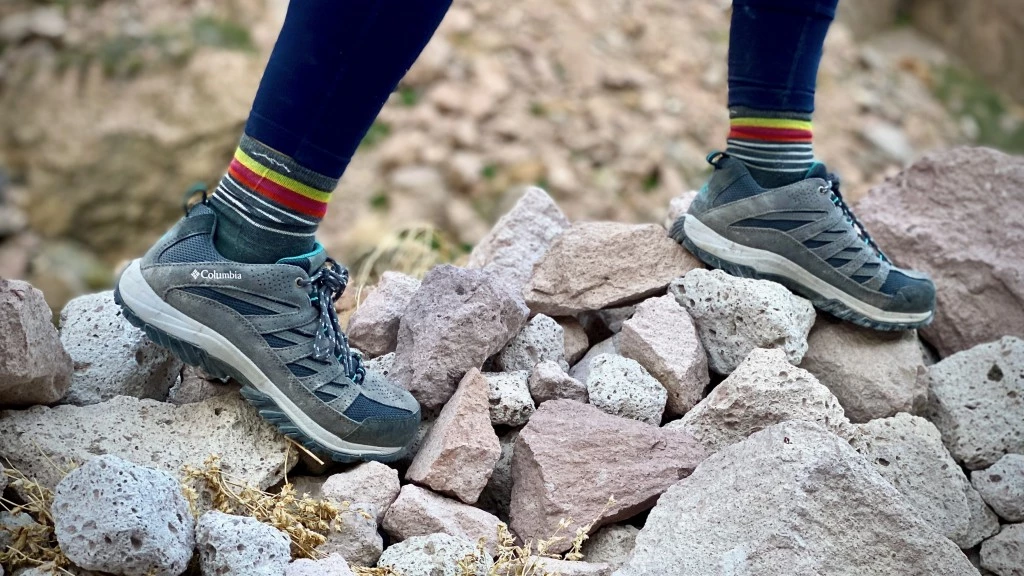
The Columbia Crestwood provides a ton of performance in exchange in exchange for a modest price tag. The mesh and leather combination upper offers a flexible, sneaker-like feel directly out of the box while also offering the stability and support you'd expect from a hiking shoe. Though not a waterproof design, our testers appreciated the enhanced breathability that was perfect for hot and dry days on the trail. The Merrell Moab 3 is another great choice for those seeking value in exchange for their investment. The Moab 3 is also a more breathable, non-waterproof option, yet offers more support for those with high arches, along with a beefy Vibram outsole for more protection on the trail. When you need to move quickly to achieve your objectives, the The North Face VECTIV Fastpack FUTURELIGHT is an excellent, well-priced option that will impress you with its rockered design that optimizes forward motion. While the Merrell Siren Edge 3 wasn't a top performer (nor is it waterproof), it is one of the least expensive and lightest-weight shoes in our review. It provides reasonable comfort out on the trail with better breathability than hiking shoes that feature a waterproof membrane. The Siren is also available in a waterproof version. The Nortiv 8 Lightweight was the most affordable shoe that we've tested so far and proves that you truly get what you pay for. This shoe features a minimalist design that offers limited trail protection and durability.

It is difficult to overstate the importance of comfort when considering hiking footwear. Your feet are your foundation on the trail, navigating roots, rocks, and rugged terrain, so it is essential to have cushioned and comfortable shoes, especially with the weight of a pack. Even a short hike can be unpleasant in an uncomfortable shoe, let alone a weeklong thru-hike in remote mountains. It's hard to take in views when all you can think about are hotspots and blisters on your toes.
Comfortable shoes are strategically padded, responsive, supportive, and sized correctly. Of course, a good fit is essential and highly subjective, as a shoe that fits one person's long and narrow foot might not feel so great to someone with a wider forefoot. So, we highly recommend test-driving any potential candidates before committing to your purchase. If the fit is too loose or too tight, you'll end up with pressure points, chafing, and, worst of all, blisters. In this section, we'll identify which shoes will work best for various foot shapes and arch heights, as the overall fit significantly influences comfort. If you think you've found the perfect shoe but discover it didn't break in as well as you had hoped, consider swapping out the insole it came with for some aftermarket insoles , tongue pads , or different shoelaces.

Our testers discovered three very different standout options when evaluating each shoe for comfort — the Anacapa 2 Low GTX , the Altra LP Alpine , and the On Running Cloudwander . While the Anacapa 2 and Cloudwander both offer ample and unique cushioning combined with substantial structure and support, our testing team ultimately preferred the thickly-cushioned Anacapa 2 above all. The LP Alpine features distinctive comfort through its spacious toe box and Balanced Cushioning that encourages your body's natural alignment by placing the heel and forefoot at the same height.

One telltale sign of a comfortable shoe is the amount of fatigue and soreness you feel in your feet at the end of the day. Though the La Sportiva Spire GTX is not the most cushioned option, it has a responsive and dynamic midsole and excellent support that performs particularly well on technical, off-trail terrain. While the abrasion-resistant mesh upper could be considered too spacious for some, a set of Superfeet insoles could be a great way to add cushioning and achieve a near-perfect fit. The Salomon X Ultra 4 also features flexible, soft materials and supportive technical overlays, which combine to make a remarkably agile and comfortable shoe. And finally, we'd be remiss not to mention the VECTIV Fastpack for its moderate cushioning, flexible forefoot, and rockered design that increases comfort without weighing you down on the trail.
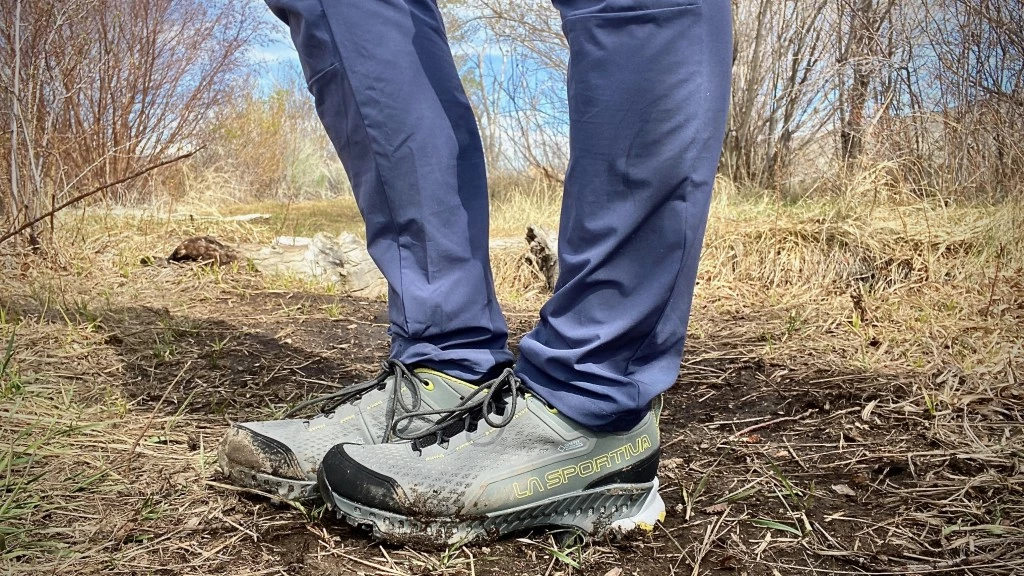
Leather shoes can sometimes require a few miles to break in, as the material needs to be worked to conform to your foot. Conversely, shoes made with synthetic materials tend to be more comfortable out of the box, with the laces establishing a more individualized fit. Despite being leather, the La Sportiva TX4 impressed our testing team after it quickly molded to our feet and provided a comfortable fit and a secure heel right out of the box. The design hugs your foot and imparts confidence with every step. We found a stiffer material, like that of the Adidas Terrex Swift R3 , which will certainly require quite a few hikes to soften up and increase responsiveness. We highly recommend slowly increasing your mileage while breaking in any new shoe rather than heading out for a demanding hike. This will give you time to dial in the lacing and adjustments you'll need to maximize the comfort of the shoe and hopefully prevent any development of blisters or hot spots before committing to a longer hike.

There is great variation across shoe brands when it comes to width, length, and shape. While we evaluate whether each shoe will work best for a narrow or wide foot, keep in mind that some models like the Oboz Sawtooth X Low , Merrell Siren Edge 3 , the Merrell Moab 3 WP , the Merrell Moab 3 , the Columbia Crestwood , and the Nortiv 8 Lightweight also come in wide sizes. If you prefer more width in your hiking shoe, these models are worth considering.
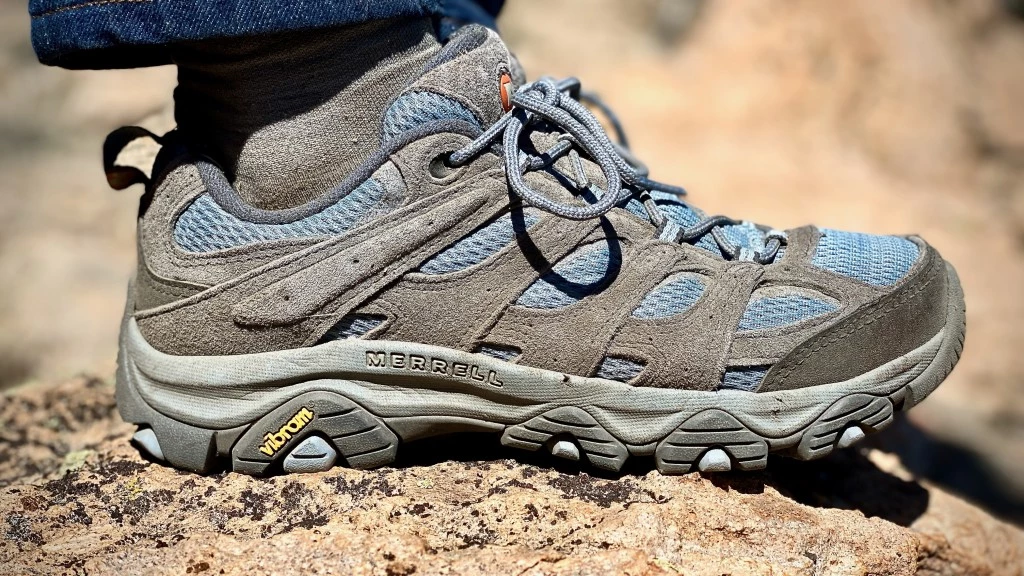
When evaluating the overall support of a hiking shoe, we consider the arch support, lateral stability, overall stiffness of the sole, and the effectiveness and adjustability of the lacing system. We examined each feature and evaluated the different shoes side-by-side, noting how they performed relative to one another. It's important to understand that ankle-high hiking shoes simply do not offer the same amount of support as a full boot with an ankle cuff for additional stability. If you prefer more ankle support while exploring uneven terrain or you plan to hike with a heavy pack over long distances, we highly recommend a full hiking boot (often referred to as "mid" height).
The shape of your foot will often determine the amount of arch support you prefer your hiking shoe to have built into its structure. If you have flatter feet and put on a shoe with pronounced arch support, it's not going to offer stability or comfort. Conversely, little to no arch support in a shoe can feel brutal to someone with medium to high arches, especially after hiking all day. If you love every other feature of a specific hiking shoe but are after more support for your arches, it is possible to replace the insole of the shoe with an aftermarket insole that better suits the shape of your feet and provides a more customized fit.

Out of all the shoes we tested, the La Sportiva Spire , La Sportiva TX4 , Salomon X Ultra 4 , and the On Running Cloudwander offered the most support for moderate to high arches. The proprietary insole in the Cloudwander provides the most support of the bunch, with extra padding and a molded arch that holds its shape well. Those who prefer more neutral support may want to consider the Hoka Anacapa 2 Low , the Altra LP Alpine , or the Keen Zionic Speed , which have less pronounced arches.

Lateral stability is also a crucial consideration for your next trail shoe, especially since hiking rarely happens on flat terrain free of obstacles. Such stability is a combination of internal arch support and a sole's flexibility and firmness, which comes into play when you are boulder-hopping, scrambling, or hiking over mixed terrain through rugged trail systems. Whenever you can wring out a shoe like a wet towel, that shoe's lateral structure will leave a lot to be desired. However, the more stiffness you add, the less flexibility you'll find in the forefoot, and the shoe can become less suitable for tackling steep inclines. On the flip side, too much flexibility under the balls of your feet means you will absorb more shock from the trail and fatigue your feet more quickly. So, your hiking plans will likely dictate your priorities.
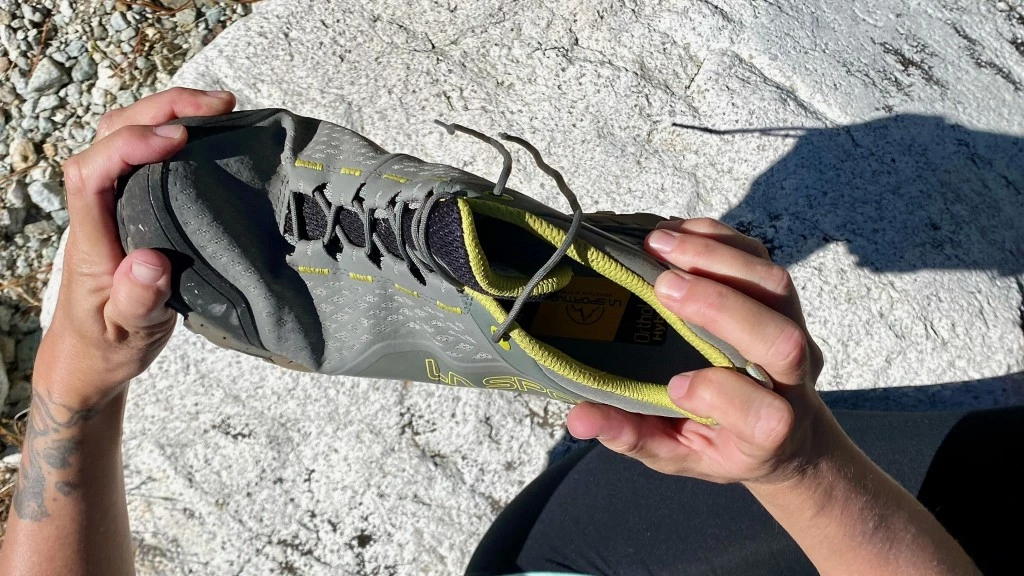
One of the best mixes of support and mild forefoot flexibility we saw was in the La Sportiva TX4 . On technical hikes and scrambling for summits, it offered protection underfoot and solid stability with limited motion side-to-side. For longer hikes through any type of terrain, the sturdy base of the La Sportiva Spire GTX makes an excellent choice. Or if miles of uphill climbs lie ahead, the Salomon X Ultra 4 impressed us with ample flexibility at the ball of the foot coupled with ankle and pronation support via overlays on the outside of the upper.
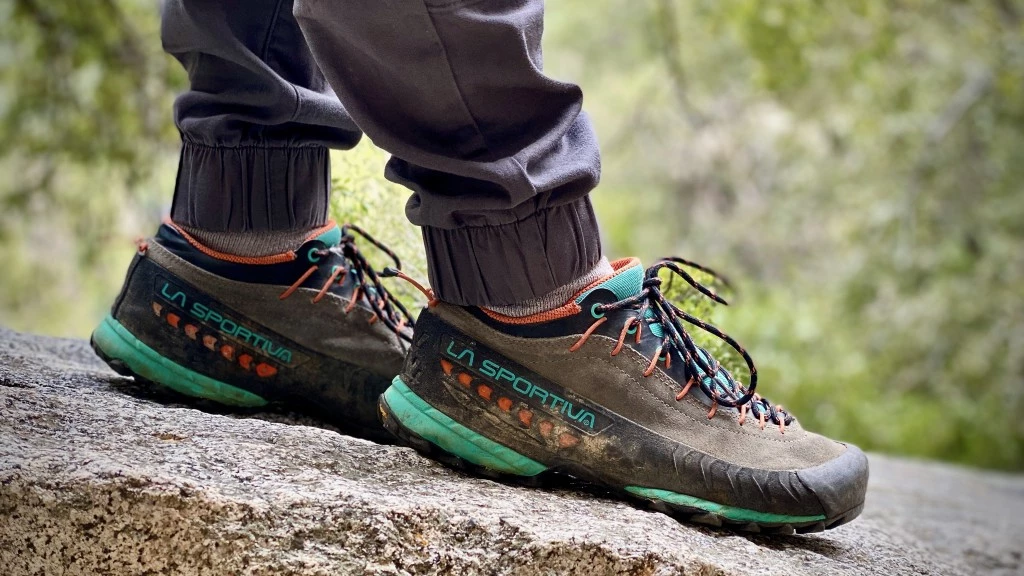
A key feature for ensuring stability is to have your heel secured in place. An extra runner's loop eyelet on shoes like the Oboz Sawtooth X , Adidas Terrex Swift R3 , Keen Zionic Speed , and the Anacapa 2 Low allows for alternative lacing strategies to create a snug fit and minimize heel lift. It's important to consider that even the slightest amount of movement in the heel over the course of an all-day hike can be a recipe for severe blisters and discomfort, so we highly recommend finding a shoe with the best fit for your feet. We recommend reversing the final lace on shoes like the Merrell Moab 3 and the Columbia Crestwood , which helped to lock the heel into place while also placing less torque on the mesh lacing attachments.
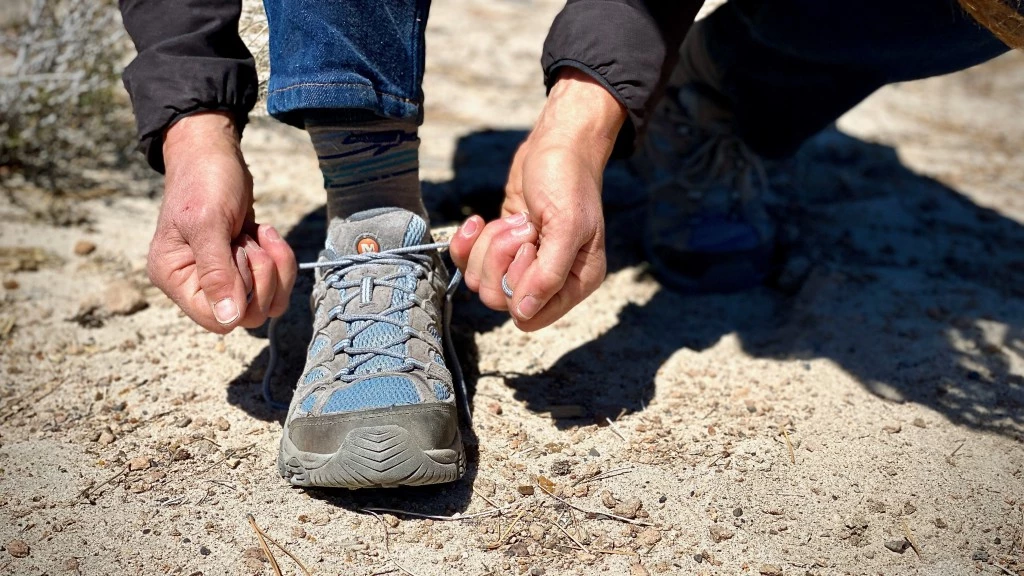
Traction is a critical consideration for any footwear designed for the trail. Slick feet could land you on your rear end, contribute to twisted ankles, and severely limit the terrain you feel confident exploring. Several things contribute to a shoe's traction, including the stickiness of the rubber as well as the size, shape, direction, and depth of the lug pattern on the outsole. Vibram soles are the gold standard for high-end hiking shoes; they make dozens of different rubber compounds and tread patterns with varying degrees of surface grip.
Our overall favorite shoe for navigating slick rock terrain is the La Sportiva TX4 , which features a Vibram Megagrip Traverse with a TrailBite Heel Braking platform below the heel. This shoe is well-known by rock climbers who primarily navigate steep and unforgiving terrain on the approach to their favorite climbing routes. However, we also found this "approach" shoe to perform well when evaluated on hiking trails, especially when navigating slippery, polished, and super popular trail systems in America's National Parks.
Other notable performers include the La Sportiva Spire GTX , which features a Vibram XS Trek outsole and an Impact Brake System positioned on the heel for additional grip and traction while quickly descending technical terrain. This rubber also performed exceptionally well in cold, wet conditions, where we've seen other softer rubbers lose traction once the temperatures dropped. We'd also like to give a shout-out to the Hoka Anacapa 2 Low GTX but with an asterisk. The sole is comprised of two separate rubbers, and in our case, the light purple rubber represented the durable, high-performing Vibram Megagrip rubber, while the lighter soft-sole rubber was very susceptible to durability issues while moving through challenging and rocky terrain.
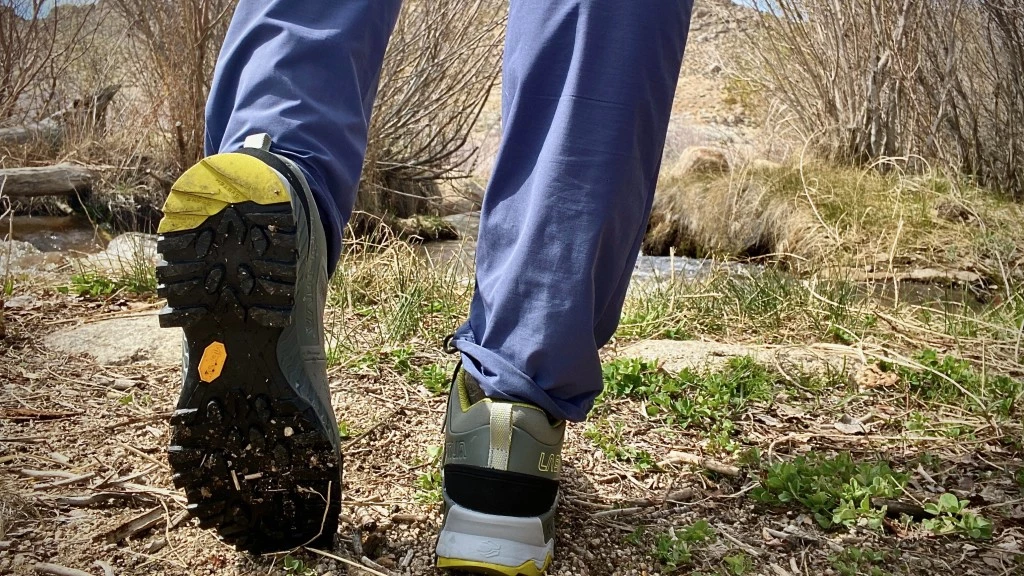
We primarily evaluated traction on steep and unconsolidated dirt trails littered with decomposing granite, in addition to slippery slabs, roots, wet logs and boulders, mud, loose scree, melting snow, and talus fields. Above-average traction on dirt is usually achieved through a deep lug pattern that can dig into the ground with every step. We found shoes that feature outsoles with "multi-directional" chevron lug patterns that look like zigzags or arrow tips to provide the highest-performing traction. This optimal traction allowed us to tackle the steeps without losing confidence in our footwork. Notable pairs include the Salomon X Ultra 4 and the Altra LP Alpine , which feature a chevron pattern with a very different feel underfoot. Though none of these outsoles are equipped for tons of off-trail terrain, the LP Alpine boasts more flexibility and control thanks to the Duratread rubber and Trailclaw patterning, while the X Ultra 4 offers exceptional grip even on icy terrain without being overly rigid. The Omni-Grip rubber outsole on the Columbia Crestwood offers a multi-directional lug pattern along with a flexible, sneaker-like upper that grips the best on slippery rocks and boulders.
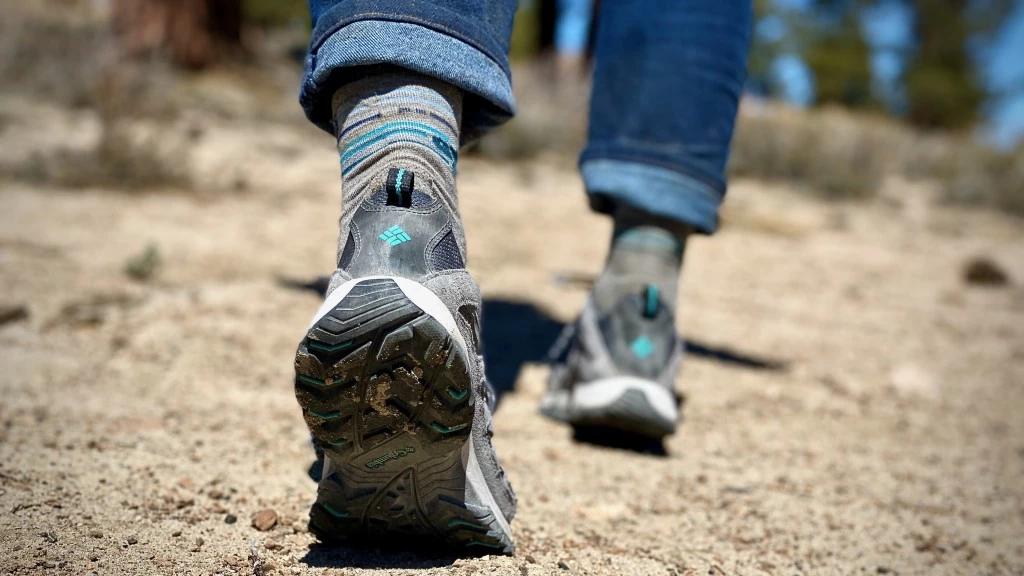
When it comes to traction on rock, the greatest impact comes from the stickiness of the rubber rather than the shape of the lugs. Hard and stiff rubber doesn't grip as well as softer and more pliable formulations. The La Sportiva TX4 , Terrex Swift R3 , Altra LP Alpine , and the Salomon X Ultra 4 performed particularly well on rock that lacked texture due to their flexible and grippy outsoles. Though various types of rubber, these outsoles remained soft, flexible, and sticky, thereby increasing our confidence as we leaped from boulder to boulder and scrambled over polished slabs. Of course, the temperature can affect stickiness, and soft rubber typically does not perform as well in colder conditions. Therefore, in colder conditions, we recommend the Spire GTX , which is outfitted with a Vibram XS Trek outsole, giving high performance while maintaining flexibility on cold, icy, and wet surfaces.
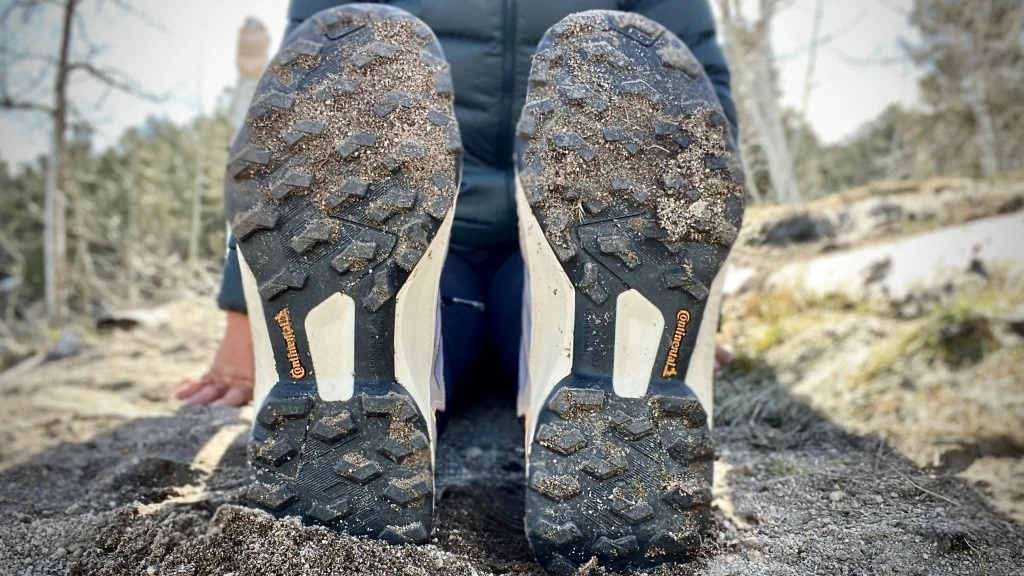
The flexibility of the forefoot will also affect traction. If you can't bend the front of your foot or the sole is too thick to feel the rock, you may have difficulty achieving secure footing. The X Ultra 4 and the Spire GTX both hit that sweet spot between forefoot flexion and stability to prove themselves as great options for navigating technical descents and steep climbs.
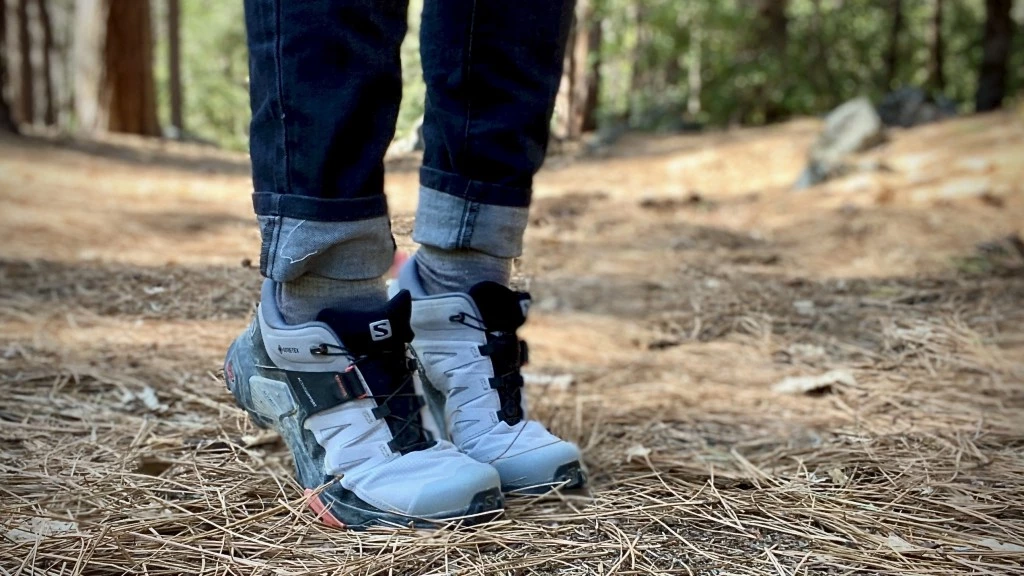
Water Resistance
Many hiking shoes are available in both waterproof and non-waterproof versions. The best option for you depends on the climate, terrain, elevation, and the season where you plan to do most of your hiking. Do you live in the desert and avoid hiking in the rain? Are your hikes primarily shorter and closer to home? You may want to pass on the less breathable Gore-Tex membrane and opt for a pair with a mesh lining instead. However, most hiking destinations have unpredictable weather, and an afternoon rainstorm far from the trailhead can make for a soggy, uncomfortable, and even painful hike.
Waterproof membrane technology is always improving, allowing shoes to transfer heat and sweat away from your feet and out of the shoe. Even as the technology becomes more breathable, a membrane will invariably be less breathable than a shoe without this lining. The best mix of breathability and waterproof protection in our current lineup is the Spire GTX , which is designed with a Gore-Tex Surround liner that increases ventilation through the bottom of the shoe with open channels in the sole. Other breathable waterproof options include the VECTIV Fastpack and the On Running Cloudwander , whose designs feature performance mesh and waterproof membranes that maximize water resistance without sacrificing overall breathability, thereby making them better options for hikes during the heat of the summer at lower elevations.
If you live in a wet climate or like to plan trips into the mountains, a waterproof shoe is typically a necessity. Most of the models in our current test suite claim such protections, but we also included a few non-waterproof models for comparison. To determine the level of water resistance each offers, we performed various trail tests, including stream crossings and a controlled submersion test (5 minutes submerged in 3 inches of water) with each shoe. We were immediately impressed by the performance of modern waterproof technology, noting that each shoe advertised as waterproof could back up its claim in practice, holding strong against any outside moisture to keep our toes warm and dry.
Other excellent options that offer waterproof performance but lack some breathability include the Salomon X Ultra 4 GTX , Adidas Terrex Swift R3 , and the Oboz Sawtooth X Low . Though the X Ultra 4 offers excellent waterproof protection, we found the design to run hot, causing our feet to sweat and swell in warmer climates. On the flip side, we appreciated this design feature when some of our early hikes required post-holing through knee-deep snow and crossing several cold creeks filled with recent snowmelt. The Terrex Swift R3 is perfectly watertight and makes an excellent choice for those cold and wet days on the trail, though our feet got rather toasty while hiking during the warmest days of the season.
In comparison, each of our mesh-lined shoes lasted less than 60 seconds in our submersion test, with the Merrell Siren Edge , Danner Trail 2650 , Keen Zionic Speed , Altra LP Alpine , Columbia Crestwood , Merrell Moab 3 , and Nortiv 8 Lightweight immediately soaking through and absorbing a significant amount of water. Among them, the Siren Edge was the fastest to dry by a long shot. So, if waterproofing is not a top priority but breathability is, this could be a great option to regulate sweat and foot temperature while still drying quickly in the event of an unexpected storm. It is also available in a waterproof version if you love the fit but require moisture protection. Not to be missed, the La Sportiva TX4 features a nubuck leather upper that can withstand some moisture on the trail, though it cannot be fully submerged when crossing creeks. There is an option to treat this leather with a waterproof coating for added performance while remaining mindful that the treatment may reduce overall breathability.
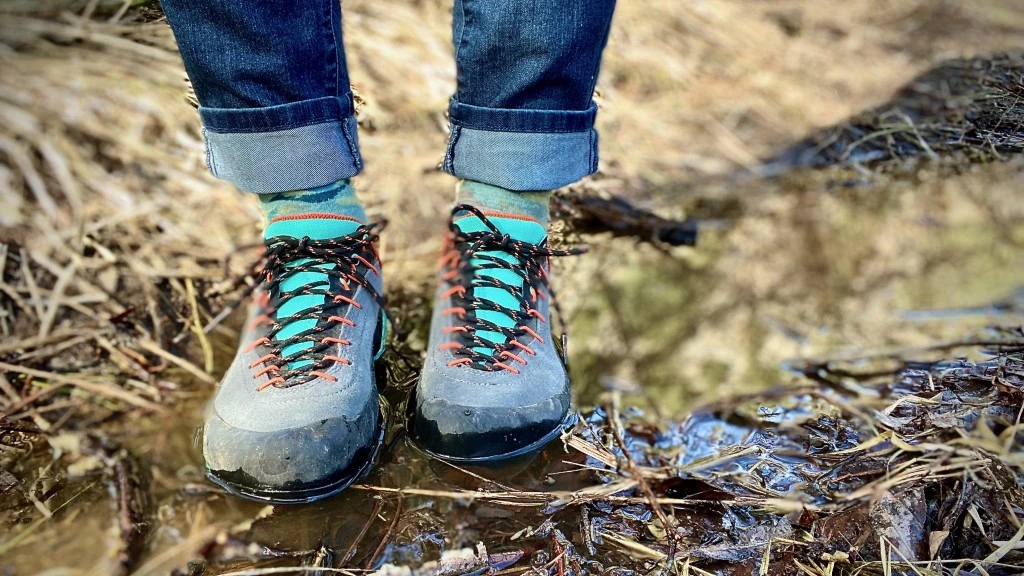
Light hiking gear can often lead to a more enjoyable experience on the trail, and hiking shoe technology has now advanced to the point where hikers are almost as light as trail running shoes without sacrificing protection, stability, or performance. Though less than half a pound separates our testing group's heaviest and lightest pairs, this extra weight can make quite a difference, especially when carrying a heavy pack or increasing overall mileage. It's important to consider that some of the lightest shoes that we tested also delivered the least performance.
Some examples of shoes that offer a lightweight design and limited performance are the Keen Zionic Speed and the Merrell Moab Speed . For a little extra weight, we found shoes that combined the agility of a trail runner with the stability of a hiking boot to offer the best performance. For instance, the VECTIV Fastpack only weighed 1.34 pounds per pair yet offered excellent comfort, support, and waterproof protection. The La Sportiva TX4 weighs only 1.42 pounds per pair yet provides incredible stability and traction within a comfortable and supportive structure. The On Running Cloudwander and the Salomon X Ultra 4 both weigh only 1.54 pounds, and though not as durable as their nubuck leather counterparts, they still remain appropriate and responsive for navigating technical terrain.
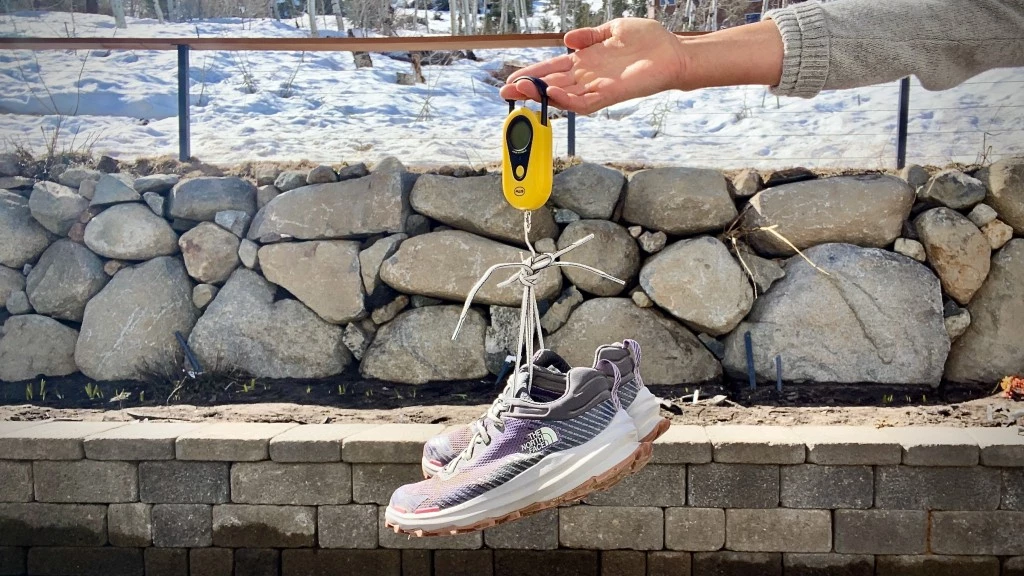
Moving to the middle of the pack, the La Sportiva Spire GTX weighs in at 1.68 pounds. The synthetic upper remains flexible while also offering high performance in both traction and waterproof protection. The extra weight is worth the trade-off for the additional features and stability that allow this shoe to navigate off-trail while carrying a pack.
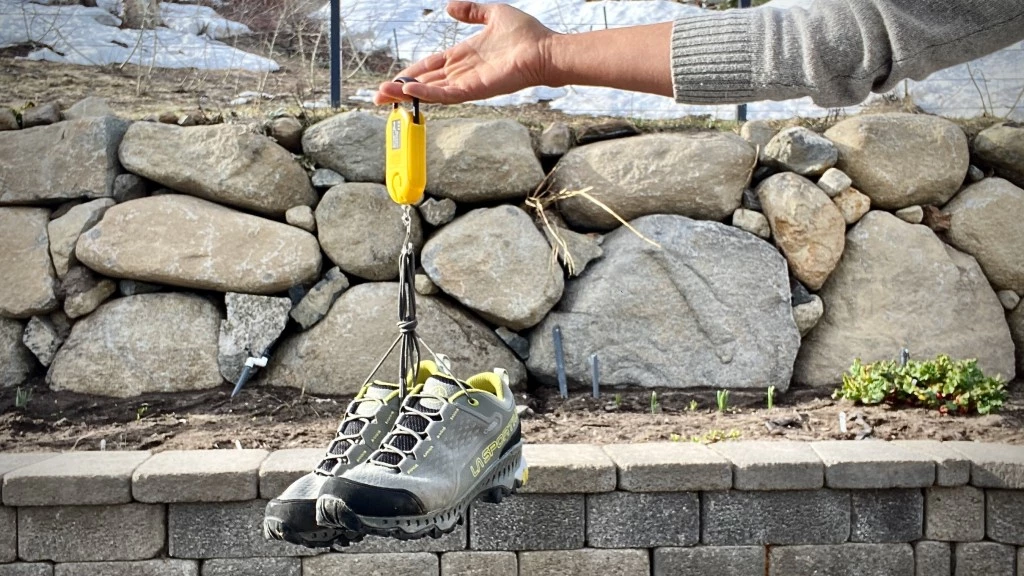
The heaviest shoes that we tested included the Merrell Moab 3 WP , the Merrell Moab 3 , the Keen Targhee III Low , and the Oboz Sawtooth X Low Waterproof , weighing between 1.78 and 1.92 pounds per pair. Though only a few ounces heavier than our lightest contenders, the designs feature bulky leather construction with additional volume that makes for a heavier feel on the trails. It is also worth mentioning that the added weight for these hiking shoes means increased durability and a long-lasting, if heavy, design.
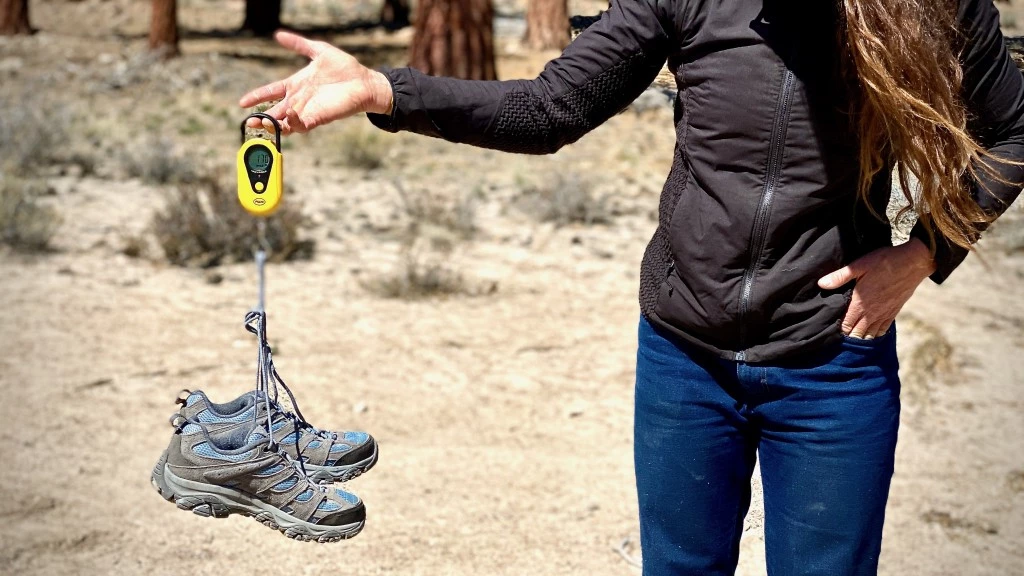
Hiking shoes are the buffer between you and the rough, rugged, or abrasive terrain you encounter on the trail, so it's no surprise that they may wear out faster than the rest of your hiking gear. A typical shoe with a soft EVA midsole lasts between 300-500 miles, depending on its structure, as well as where you hike, how you walk, and how much weight you carry. If you are a casual hiker, it might take years before your shoes begin to break down. Ambitious hikers, however, may go through one or more pairs per year . Shoes with a polyurethane (PU) midsole are expected to last up to twice the mileage; however, that extra durability can come at the expense of comfort and an extended break-in period. Normal wear and tear on any shoe packs down the midsole and wears down the outsole, so stiffer midsoles (like a dual-density EVA) and dense rubber soles will last longer overall.
While time does not allow us to put 500 miles on every shoe in this review, each pair was still worn extensively on various terrains. We closely inspected them for damage, areas of potential weakness, or premature wear and compression. In an effort to make shoes lighter weight, some midsoles are left almost entirely exposed. Since that material is softer than rubber, it is more prone to snagging on vegetation, tearing, or even pulling away from the upper. If you hike in very brushy terrain, you may see more of this kind of damage than if you are out on desert slabs or well-maintained trail systems.

In addition to the soles, we look closely at the uppers. Leather tends to have the greatest longevity, especially when it is double-stitched. Synthetic materials are lighter and more breathable than leather, but our experience shows that they are more vulnerable to tearing or cracking after encountering debris on the trail. We closely inspect seams, eyelets, toe boxes, and pressure points for any indication of failure, delamination, or wear. The abrasion-resistant mesh of the Spire GTX is supplemented with a polyurethane toe cap and a "heel-surround" for added durability. Some models have welded overlays made of thermoplastic polyurethane (TPU), which adds durability while being lighter than rubber. It protects from abrasion but will not provide as much protection from rocks, roots, or other potential toe-stubbing hazards.
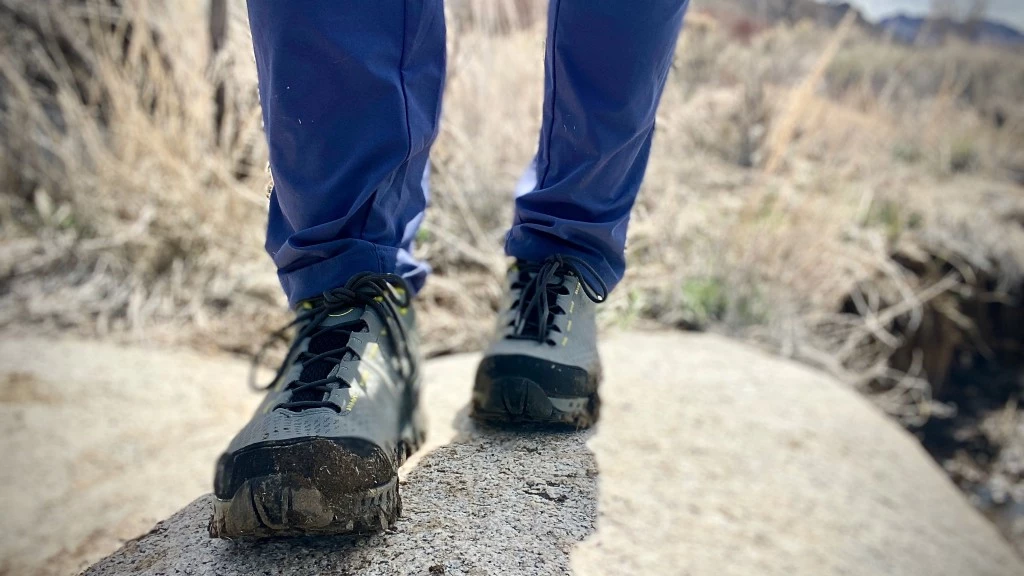
The La Sportiva TX4 , Oboz Sawtooth X Low Waterproof , and Keen Targhee III Low all impressed our testers thanks to their durable leather uppers and mesh inserts to improve breathability. Double or triple-stitched seams gave no indication of pulling or unraveling throughout our testing period. These shoes are burly, and the insoles are solid, thereby increasing the life of the footbed. All of these shoes are designed to handle long-distance hikes, and we expect them to offer long-lasting performance. That being said, though leather uppers will offer a better return on your investment in terms of longevity, the design may include additional weight and bulk.
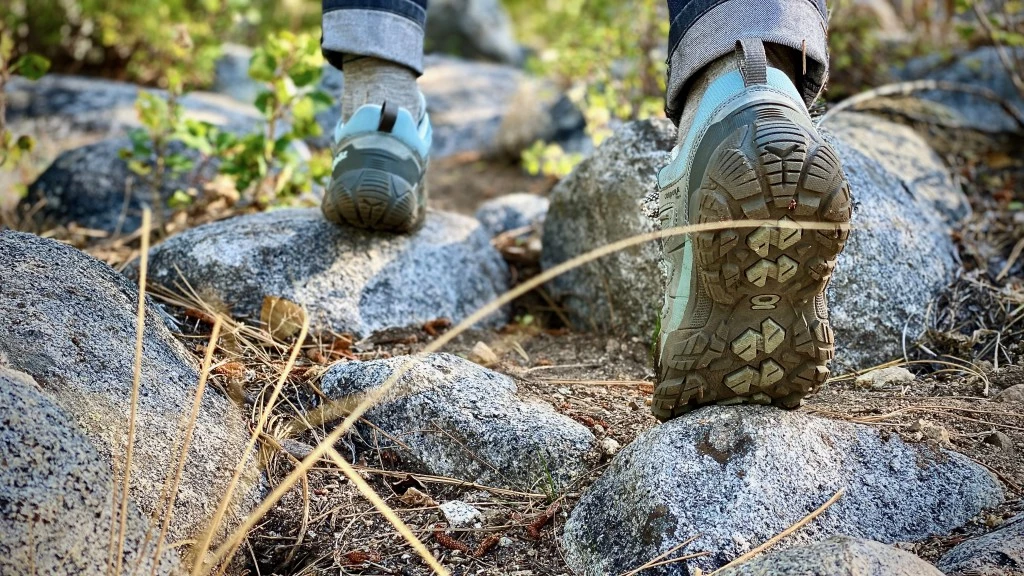
Many innovative and exciting technologies are being used to design hiking shoes these days, making them lighter and more responsive without sacrificing support, stability, or waterproof performance. However, it can require many miles to test new features and models with any depth. We hope this review helps you to narrow down your selection so that you find the right hiking shoe for your upcoming adventure, whether exploring local trails or planning a once-in-a-lifetime trip.
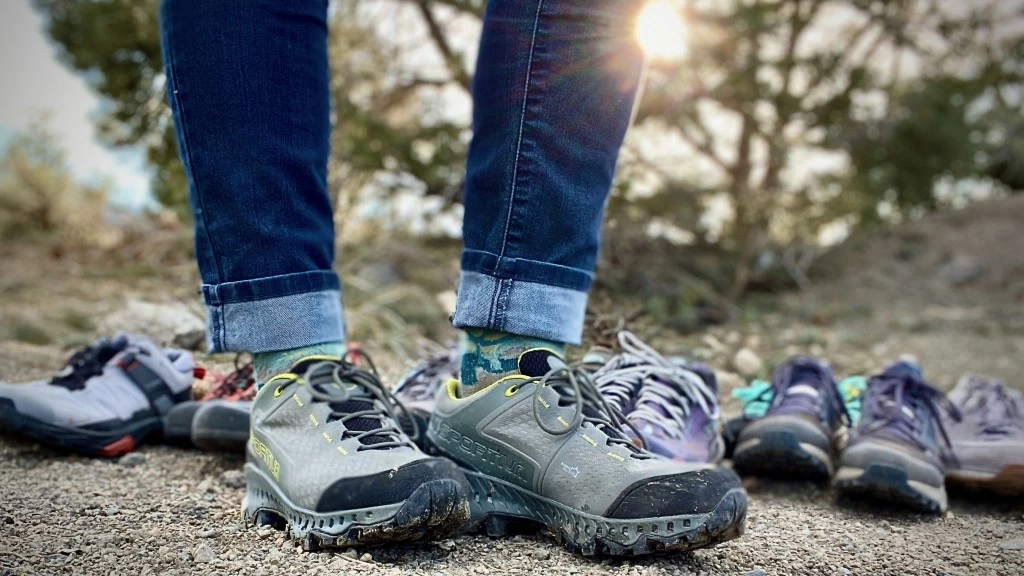
Best Hiking Gear of 2024
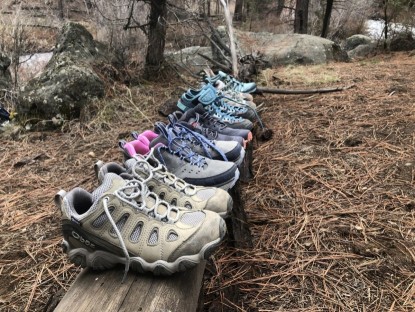
How to Choose Hiking Shoes for Women
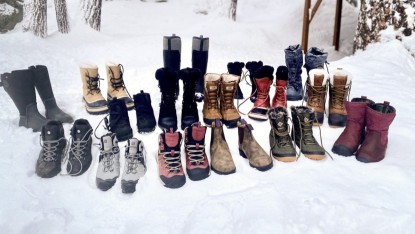
10 Best Winter Boots of 2024
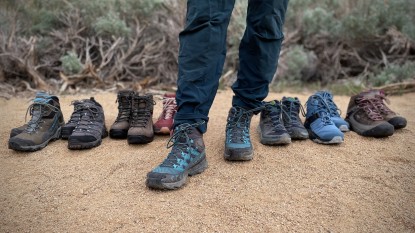
Best Hiking Boots for Women of 2024

Best Trail Running Shoes for Women

Best Windbreaker Jacket For Women
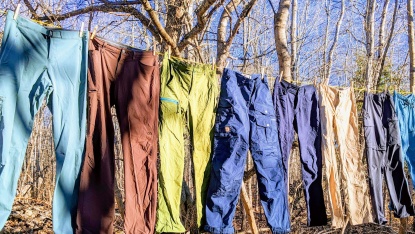
Best Hiking Pants for Women
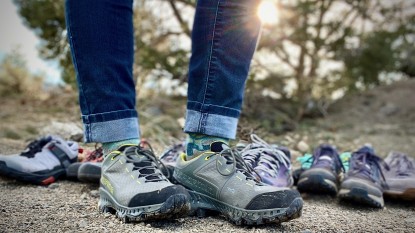
10 Best Walking Shoes of 2024
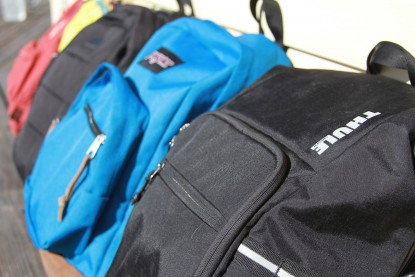
10 Best Backpacks of 2024
Table of contents
Best Hiking Shoes for Women of 2024
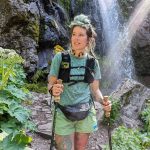
Some of the links on this page are affiliate links
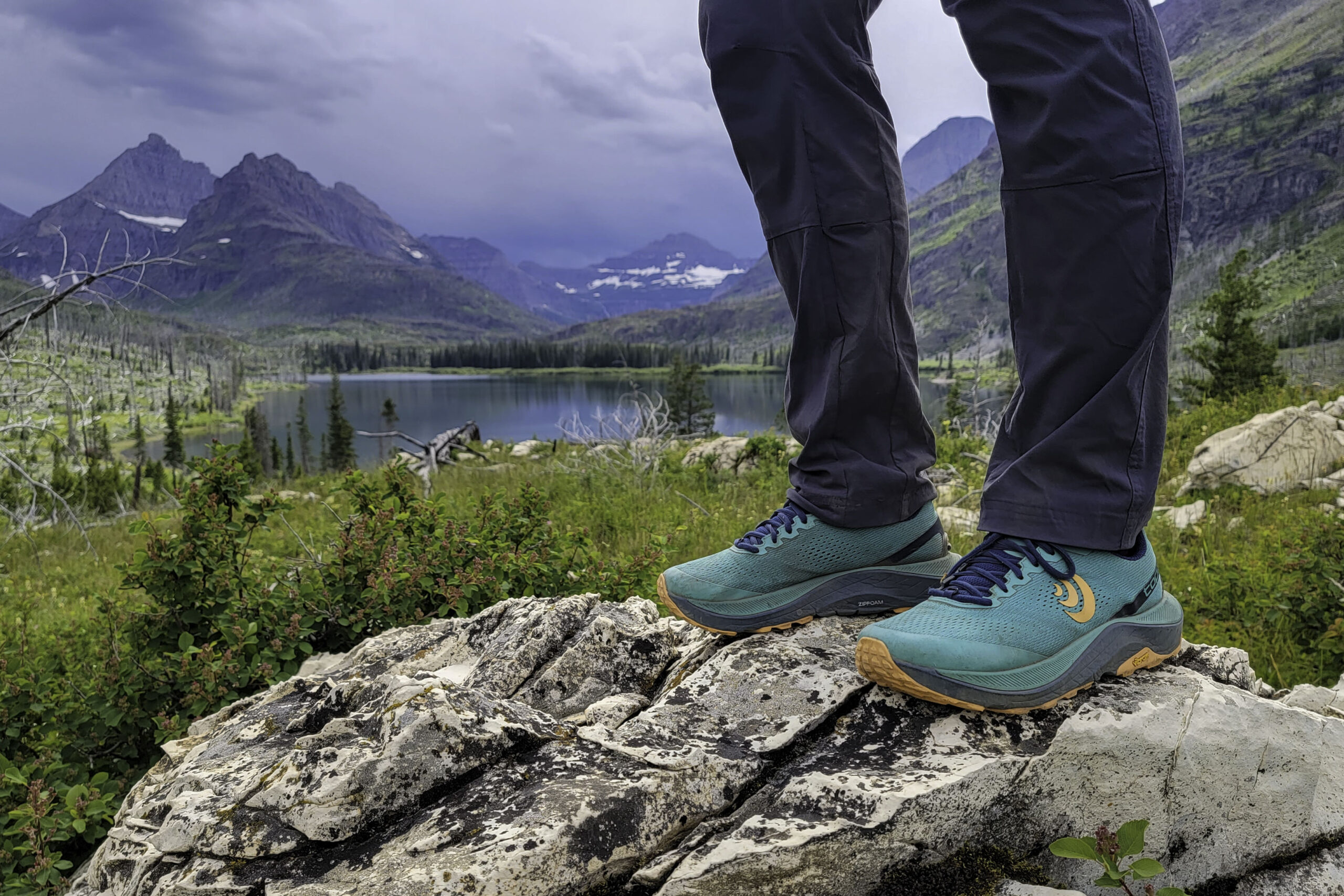
Choosing a great pair of hiking shoes is one of the most important gear decisions you’ll make. Finding the right balance of comfort, traction, weight, and durability will make a huge difference with every step along the trail.
It can be tricky to find the perfect pair, and we expect our footwear to withstand a lot of rough use on the trail. Our team has trail-tested over 50 pairs of hiking shoes on trails all over the world. From 2000+ mile thru-hikes on the CDT and PCT to quick day hikes, we’ve put the best hiking shoes on the market through the wringer to narrow down this list of our 11 top picks. We’ll use that experience in this guide to help you find the very best hiking shoes for your needs.
If you want something even more rugged for your feet, take a look at our favorite hiking boots . For truly cold-weather hiking, our winter boots guide has what you need. And don’t forget to pick up a pair of high-quality hiking socks to go with your new footwear.
Quick Picks for Women’s Hiking Shoes
Check out this quick list of our favorite hiking shoes, or continue scrolling to see our full list with in-depth reviews.
Best Hiking Shoes Overall: HOKA Speedgoat 5 ($155)
Best Budget Hiking Shoes: Merrell Moab 3 ($120)
Best Balance of Weight, Support & Breathability: Topo Athletic Ultraventure 3 ($150)
Best Budget Trail Runners for Hiking: Saucony Peregrine 14 ($140)
Most Durable & Supportive Hiking Shoes: La Sportiva Spire GTX ($209)
Best Waterproof Hiking Shoes: Salomon X Ultra 4 GTX ($160)
Best Hiking Shoes for Long-Distance & Thru-Hikers: Altra Lone Peak 8 ($150)
Excellent Balance of Weight & Durability at a Great Price: Merrell Moab Speed 2 ($140)
Some new shoes hit the market this year, and we’ve been putting them to the test to see how they stack up against our top picks:
- The La Sportiva Spire GTX are new to our list earning a spot for their durability and support.
- We’ve updated our review for the newly released Saucony Peregrine 14 .
- The Altra Lone Peak 8 remains our favorite shoe for thru-hiking after receiving an update from their previous version.
- We’ve also added the Merrell Moab Speed 2 which are a lighter, less bulky take on the classic favorite Merrell Moab 3 .
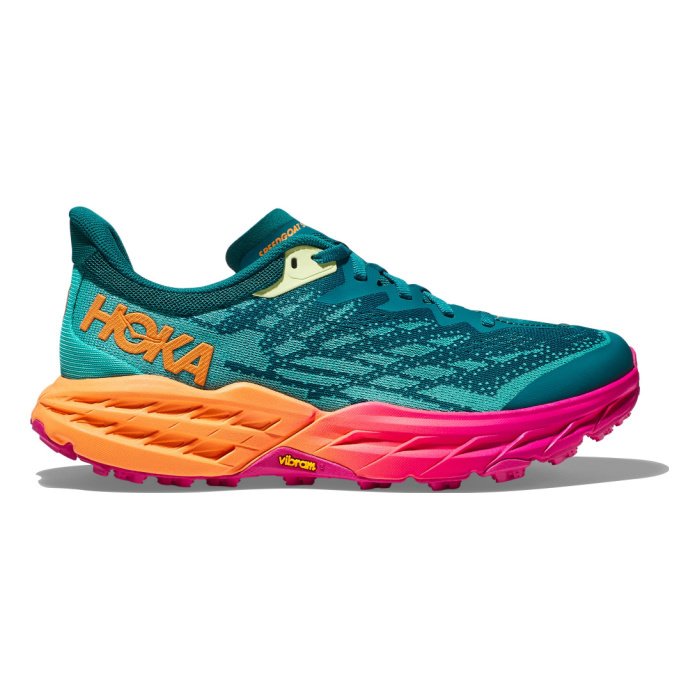
Women’s HOKA Speedgoat 5
Best Hiking Shoes Overall
Price: $155
Weight (Pair): 1 lb. 4.7 oz.
Options: Waterproof
Heel-to-Toe Drop: 4 mm
- Very cushy soles
- Lightweight
- Excellent traction
- Roomy toe box
- Above-average comfort
- No break-in needed
- Taller stack height can feel a bit unstable
The HOKA Speedgoat 5 s are known for their exceptional comfort and low weight. The standout feature of these shoes is the ultra-cushy midsole, which is excellent at absorbing impact and doesn’t flatten out as quickly as many other lightweight hiking shoes we’ve tested.
Thanks to that comfy design, the Speedgoats are a favorite among thru-hikers who need a shoe that’s lightweight and can keep their feet and joints comfortable while logging lots of miles. These shoes are also more durable than many trail runners because they’re constructed with less mesh, so you get more literal and figurative mileage out of them.
All that cushioning means the Speedgoats have a taller stack height, and this is where we find the limitation of these shoes. They can feel a bit unstable when carrying a heavy load, so we recommend getting your pack weight as low as possible before tackling big miles in these shoes.
That said, the rockered sole is designed to keep you moving fast, and the on-trail performance of the Speedgoats is excellent in terms of traction and underfoot protection. Hikers who prioritize a cushioned ride and an unrivaled balance of low weight and durability should look no further than the Speedgoats.
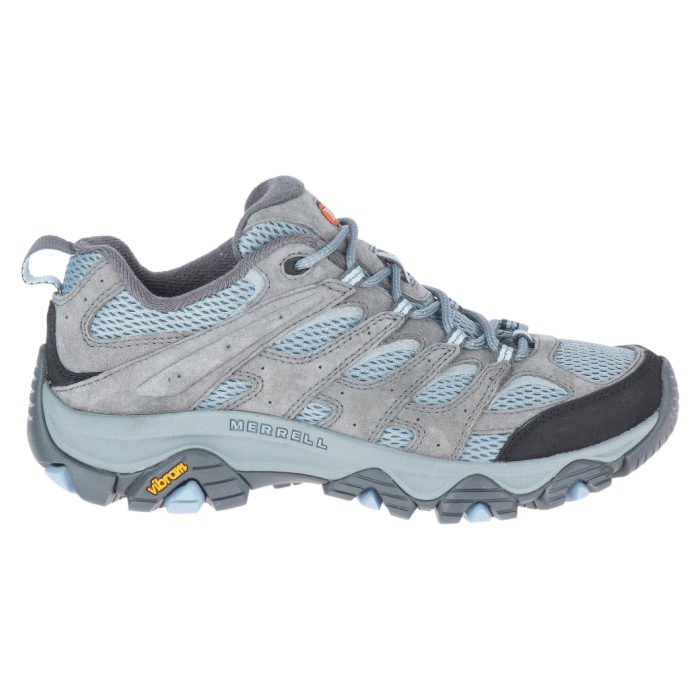
Women’s Merrell Moab 3
Best Budget Hiking Shoes
Price: $120
Weight (Pair): 1 lb. 10 oz.
Heel-to-Toe Drop: 11.5 mm
- Less expensive
- Very little break-in needed
- Far more breathable than other leather shoes
- Wide sizes available
- On the heavier/bulkier side
The Merrell Moab 3 s have reigned supreme as our best budget hiking shoes for years due to their comfort, durability, and performance. Their relatively heavy and bulky design means they aren’t our first choice for big-mile days, but day hikers and those looking for a shoe that gives the protection of a boot without the restriction of a high collar will absolutely love these shoes.
The upper is constructed with a combination of leather and mesh which translates to an excellent balance of durability and breathability – especially when compared to many of the full-leather waterproof designs typically found on more traditional hiking shoes. The Moabs also come in a waterproof model , but we find that the breathability and decently quick drying time of the non-waterproof version are generally more important to us than the added water protection. No amount of waterproofing will keep moisture out during sustained downpours or deep water crossings anyway.
What the Moabs lack in grace, they more than make up for in cushioning and support. They also require less break-in than other traditional shoes which means you can spend more time doing what you love – enjoying your hike – without the need to slowly ramp up mileage. If a burlier shoe that doesn’t compromise on durability, traction, and comfort is what you’re after, the Moabs could be the perfect shoe for you.
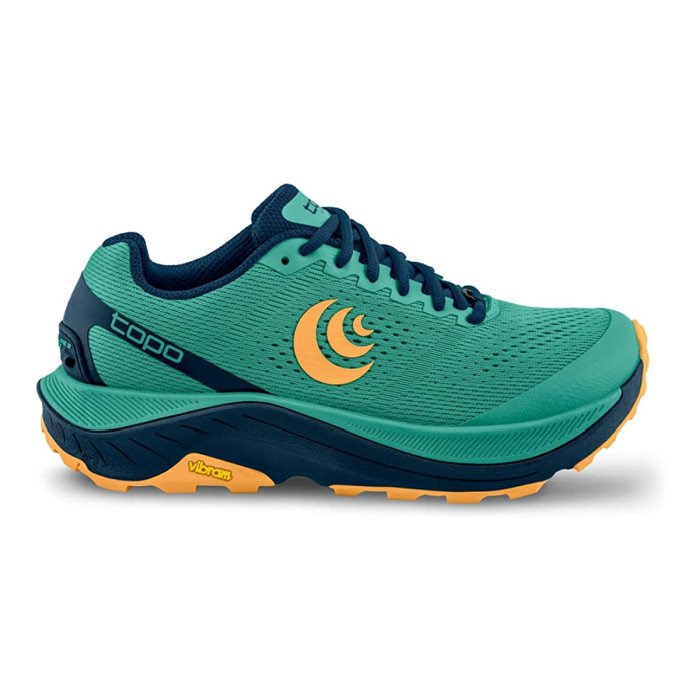
Women’s Topo Ultraventure 3
Best Balance of Weight, Support & Breathability
Price: $150
Weight (Pair): 1 lb. 4.6 oz.
Options: N/A
Heel-to-Toe Drop: 5 mm
- Great price for the quality
- Cushy soles
The Topo Ultraventure 3 s have quickly become a favorite hiking shoe for our team because they’re lightweight, highly breathable, and they have excellent grip on a variety of terrain types.
The Ultraventures hit a nice middle ground between the HOKA Speedgoats above and the Altra Lone Peaks a little further down this list. They provide similar cushioning to the HOKAs combined with a natural foot shape like the Altras, so we think the Ultraventures are a homerun for hikers looking for the best of both worlds.
The uppers are flexible, light, and airy, so they’ll keep your feet feeling cool and unrestricted on long hiking days. However, we’ve found that the taller stack height (a 5mm increase over the Ultraventure 2s) feels a bit unstable on tricky terrain. That said, the Ultraventures are plenty comfortable and secure for putting up big miles on established paths that don’t include sloped rock traverses or scrambling.
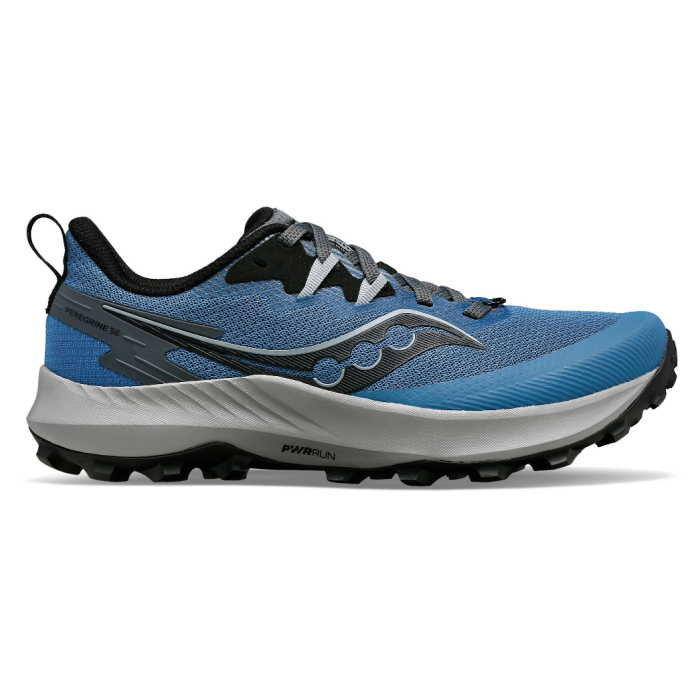
Women’s Saucony Peregrine 14
Ultralight Trail Runners with Exceptional Traction
Price: $140
Weight (Pair): 1 lb. 1 oz.
- Superior traction
- Great price for the performance
- Not as durable as some
- Not supportive enough for heavy loads
We’ve hiked thousands of miles in these shoes over the years, and the Saucony Peregrine 14 s continue to be some of our favorites due to their exceptional traction and low weight. Over treks through Nepal, the Sierras, and the Torres del Paine in Patagonia, the sticky outsoles of the Peregrines were up for the challenge.
This version is lighter than ever, even grippier than before, and has a refined fit. These shoes also have an increased stack height with more underfoot cushioning for tough terrain. Plus the Peregrine 13s are made with a highly breathable knit upper that dries quickly, so they’re ready for just about anything you throw at them.
A shoe this light won’t hold up as well as more traditional models in the long run, but you’ll expend less energy with each step and experience fewer problems with sweaty feet (like blisters). The Saucony Peregrines are the shoes you’ll catch us rocking for most of our high-mileage backpacking trips, and we can’t recommend them highly enough for those who prefer lightweight trail runners.
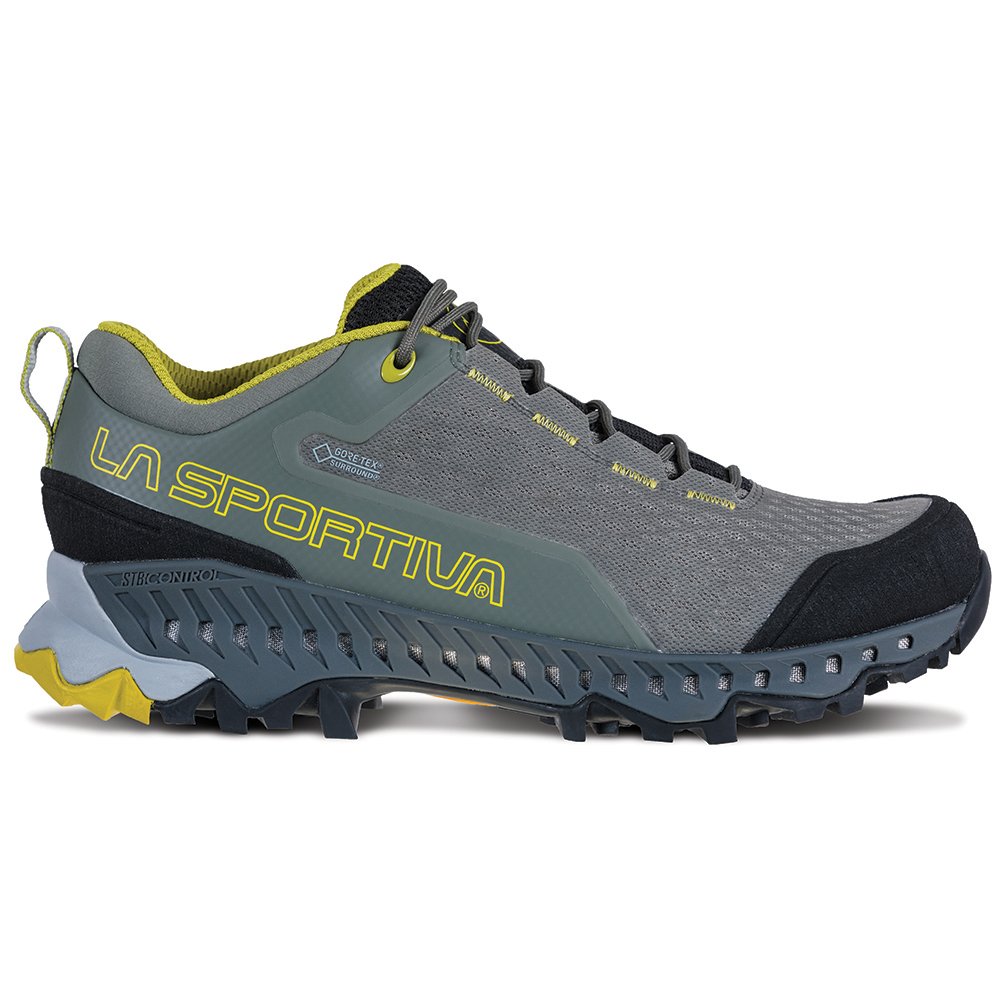
Women’s La Sportiva Spire GTX
Most Durable & Supportive Hiking Shoes
Price: $209
Weight (Pair): 1 lb. 10.2 oz.
Heel-to-Toe Drop: 6 mm
- Above-average support
- Exceptional durability
- Decently breathable for waterproof shoes
- Cleaner look than other burly hiking shoes
- On the heavier side
- Some break-in required
- A bit stiff
The La Sportiva Spire GTX are what we reach for when we need maximum traction and stability on technical terrain. We really put these shoes through their paces on recent hikes among the granite mountains of Southern Arizona, and they delivered exceptional protection and grip from trailhead to peak.
What stands out most about the Spires is their boot-like performance in a more nimble package. With a high level of support and durability but a streamlined fit and look, it’s not surprising to us that La Sportiva describes these as a low-cut boot. This beefy build contributes to a higher overall weight for the Spires, but we don’t find them uncomfortably heavy thanks to the balanced design.
Backpackers hiking with a heavier pack weight in the 35+ pound range will find these shoes well-suited to supporting a heavy load. However, those traveling a bit lighter may prefer to forego the substantial cost of the Spires by choosing the more flexible and affordable Salomon X Ultras below. The Spires are a bit stiffer than the X Ultras – even after breaking in – but they provide undoubtedly better support and traction.
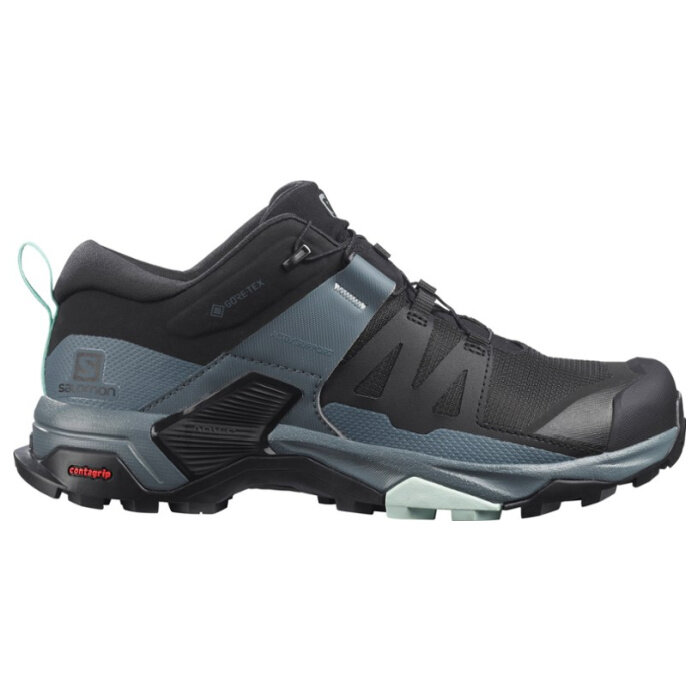
Women’s Salomon X Ultra 4 GTX
Best Waterproof Hiking Shoes
Price: $160
Weight (Pair): 1 lb. 9.9 oz.
Options: Non-waterproof
Heel-to-Toe Drop: 11 mm
- Lightweight for how durable/supportive they are
- Excellent waterproofing
- Fit isn’t our favorite on this newest model
- Quicklace system is clunky
The Salomon X Ultra 4 GTX hiking shoes have a nearly unrivaled balance of durability and low weight – they’re built like a traditional shoe but they fit more like trail runners. These shoes feel much more nimble than others in their category, and they require practically no break-in period. After several hundred miles of testing – including 100 on the rugged Arizona Trail – we’ve found that the traction is well above average on the X Ultras, so they’re great for backpacking or day hikes on challenging terrain.
We’ve used every iteration of the X Ultras since the originals came out, and this is the first model that we weren’t completely in love with. With a stiff, narrow arch that opens up to a slightly wider toe box, this version has a fit that might not work for everyone. We find the heel and midfoot too stiff for our liking, but hikers who like a locked-in feel will probably really dig the new design.
Our fit preferences aside, we’re still big fans of the X Ultra line for its durability, balance of weight/support, and top-tier traction on variable terrain. So we highly recommend them for hikers wanting a shoe that fits like a trail runner but lasts as long as more traditional hiking footwear.
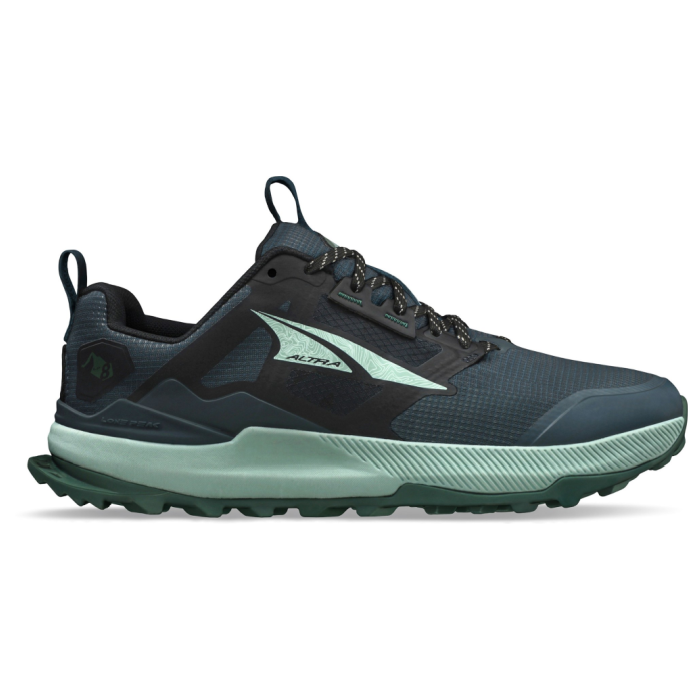
Women’s Altra Lone Peak 8
Best Hiking Shoes for Long-Distance & Thru-Hikers
Weight (Pair): 1 lb. 2.3 oz
Heel-to-Toe Drop: 0 mm
- More durable than previous Lone Peak models
- Built-in gaiter attachment
- Zero-drop takes some getting used to
- Not as cushioned as the other trail runners
Altra Lone Peaks have long been the flagship shoe of lightweight hikers due to their low weight, grippy outsole, and roomy fit. The 8th iteration of the LPs hit the market with some slight improvements over the LP 7s – the upper material has changed to a more durable ripstop nylon, the overall weight is lower, and the toe cap is slightly beefier.
If you’ve never tried an Altra shoe before, the first thing you need to know is that these are zero-drop – meaning your heel and toes sit at the same height in the shoe as opposed to having a higher heel. Hikers who are new to zero-drop should ramp up mileage to build strength in muscles and tendons that aren’t used to working so hard before taking these on any big trips. That said, once you acclimate to the build, the Lone Peaks allow your foot to move in a more natural way and many hikers find this more comfortable and intuitive.
Adding to that ergononmic feel is the foot-shaped toe box that allows your toes to spread naturally as you step. Most other shoes are designed to direct your foot into a specific gait, but again – many hikers find it’s better to let their feet do their thing according to their particular gait. Like most things with footwear, it’s a highly personal choice and we recommend trying the Lone Peaks for yourself to see if they’re right for you.
Lone Peak enthusiasts have been lamenting the downfall of durability since the LP 4.5s, but the Lone Peak 8s sport a new upper material and more reinforced spots that will make them last longer than previous iterations. But durability will always be part of the tradeoff when you want a lighter shoe, and the Lone Peaks are about as light as you can get for a long-distance shoe.
We put about 650 miles on a pair of Lone Peak 7s on the notoriously tough-on-shoes Arizona Trail before needing to buy a new pair. The Lone Peak 8s feature the same strips of reinforcement as the previous model, but we expect the new upper fabric on this latest model to allow us to push a little further.
Hikers who loved the Lone Peak 7s as much as we did will find that the Lone Peak 8s perform very similarly with a few small improvements. Those seeking a low weight and wider fit that allows for natural movement, should keep the Lone Peak 8s at the top of their list.
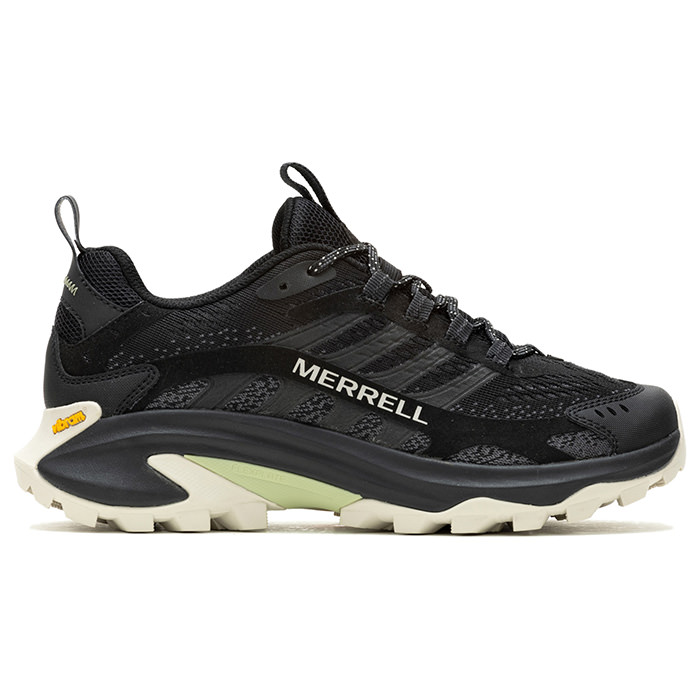
Women’s Merrell Moab Speed 2
Excellent Balance of Weight & Durability at a Great Price
Weight (Pair): 1 lb. 3.4 oz.
Heel-to-Toe Drop: 10 mm
This isn’t your father’s Merrell Moab. The Moab Speed 2 is a whole different breed built for lightweight hikers and backpackers looking to cover longer distances. Like the traditional Moab 3 above, the Moab Speeds feature a stout toe cap and a beefy heel that provide solid protection on rocky terrain – but the Speeds deliver it with a lighter and more streamlined build.
Sitting somewhere between a trail runner and a hiking shoe, the Moab Speeds are more comfortable than many of the hiking shoe offerings on the market. During our test hikes in the foothills of Idaho’s Lost River Range, we found ourselves forgetting to take off the Speeds at camp because they were just that comfy.
We love that the Moab Speeds have a similar, comparatively less expensive price point than their traditional counterparts, but budget-conscious hikers tackling tricky trails with a backpack over 35 pounds will likely prefer something like the standard Moab 3s for their added durability and support.
That said, the Moab Speeds are a solid choice for day hikers and lightweight backpackers looking for a more nimble shoe that won’t break the bank. And the Speeds are good-looking and comfortable enough to double as an around-town shoe.
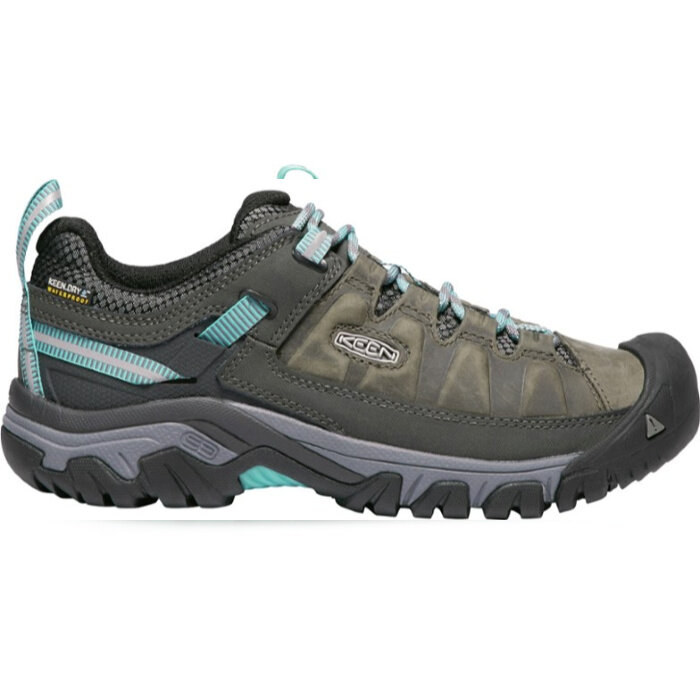
Women’s KEEN Targhee III WP
Excellent Value Hiking Shoes for Day Hikers
Weight (Pair): 1 lb. 11.8 oz.
Heel-to-Toe Drop: 12 mm
- Great traction on non-technical trails
- Extra secure lacing system
- Stiff soles
- Waterproofing limits breathability
- Requires longer break-in period
The KEEN Targhee III WPs are a favorite because they’re a dependable shoe that’s made to last. These leather hiking shoes require a longer break-in time than many of the lightweight models on our list, but the high-quality material of the upper holds up for hundreds of miles on the trail.
One of our favorite features of the Targhees is the elastic band that connects the laces to the heel cup. This provides a secure, locked-in feeling and makes it easier to dial in the perfect fit. The Targhees are also known for their wide toe box, so they’re an excellent choice for hikers needing a little extra wiggle room in their shoes.
Because they’re on the bulkier side and not as breathable or fast-drying as some shoes, we recommend the Targhees for shorter hikes and for those who want something long-lasting and comfy for daily wear.
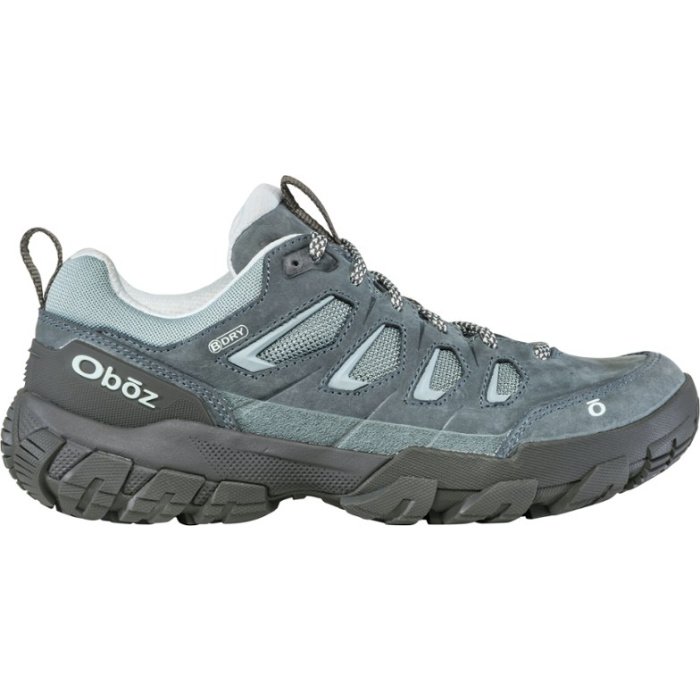
Women’s Oboz Sawtooth X WP
Highly Supportive Hiking Shoes That Hold Up to Hard Use
Weight (Pair): 2 lbs. 1.1 oz.
Heel-to-Toe Drop: 8 mm
- More supportive than most hiking shoes
- Wide toe box
- Surprisingly quick break-in for such a stout shoe
- Heavy/bulky
- Support is overbuilt for some
Thanks to their signature premium insoles, the Oboz Sawtooth X WP are some of the most supportive hiking shoes we’ve tested. The molded arch and heel cup, cushy midsoles, and exceptional traction make this shoe a great choice for challenging terrain – especially for backpackers who tend to carry heavier loads over 40 pounds.
The Sawtooths have been a star in Oboz’s lineup of trail shoes for years, and this tenth anniversary edition stays true to the heart of the original while improving upon some key performance features. The reimagined midsole is more durable and supportive, and the outsole has stickier rubber with a new lug pattern for better traction on variable terrain.
The traditional-style Sawtooths start a little stiffer than other pairs, so we recommend breaking them in before taking them on any big trips. But after you get past this initial period, you’ll have a comfy shoe that can withstand multiple years of hiking.
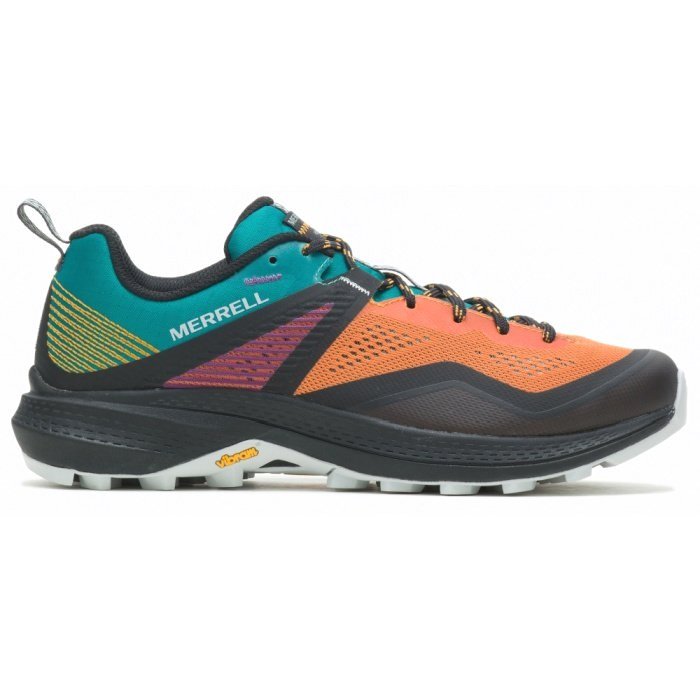
Women’s Merrell MQM 3
Lightweight Hiking Shoe/Approach Shoe Hybrid
Weight (Pair): 1 lb. 6.5 oz.
- No break-in required
- Traction isn’t as solid as others
- Stiffer than others in their weight class
The Merrell MQM 3 s are pretty unique shoes that blend the freedom of a lightweight hiking shoe with the scrambling prowess of an approach shoe. They have a slim heel and midfoot that opens up to a wider toe box for a secure, yet unrestricted fit that allows your toes to move naturally.
The outsoles don’t have much variety in the lug pattern, so we’ve found that the MQMs can struggle a bit on trails with mixed terrain. But the sticky climbing zone at the front and the soft rubber of the Vibram lugs along the rest of the foot work well for granite inclines and rocky traverses. The cushy soles also provide plenty of comfort for long days with a pack on, so the MQMs are a good choice for hikers tackling mountainous trails.
Though the hybrid design of the MQM 3 doesn’t excel as a hiking shoe or an approach shoe in our view, we think its affordable price and solid performance in both categories make it a good option for hikers who spend most of their time on granite-laden trails.
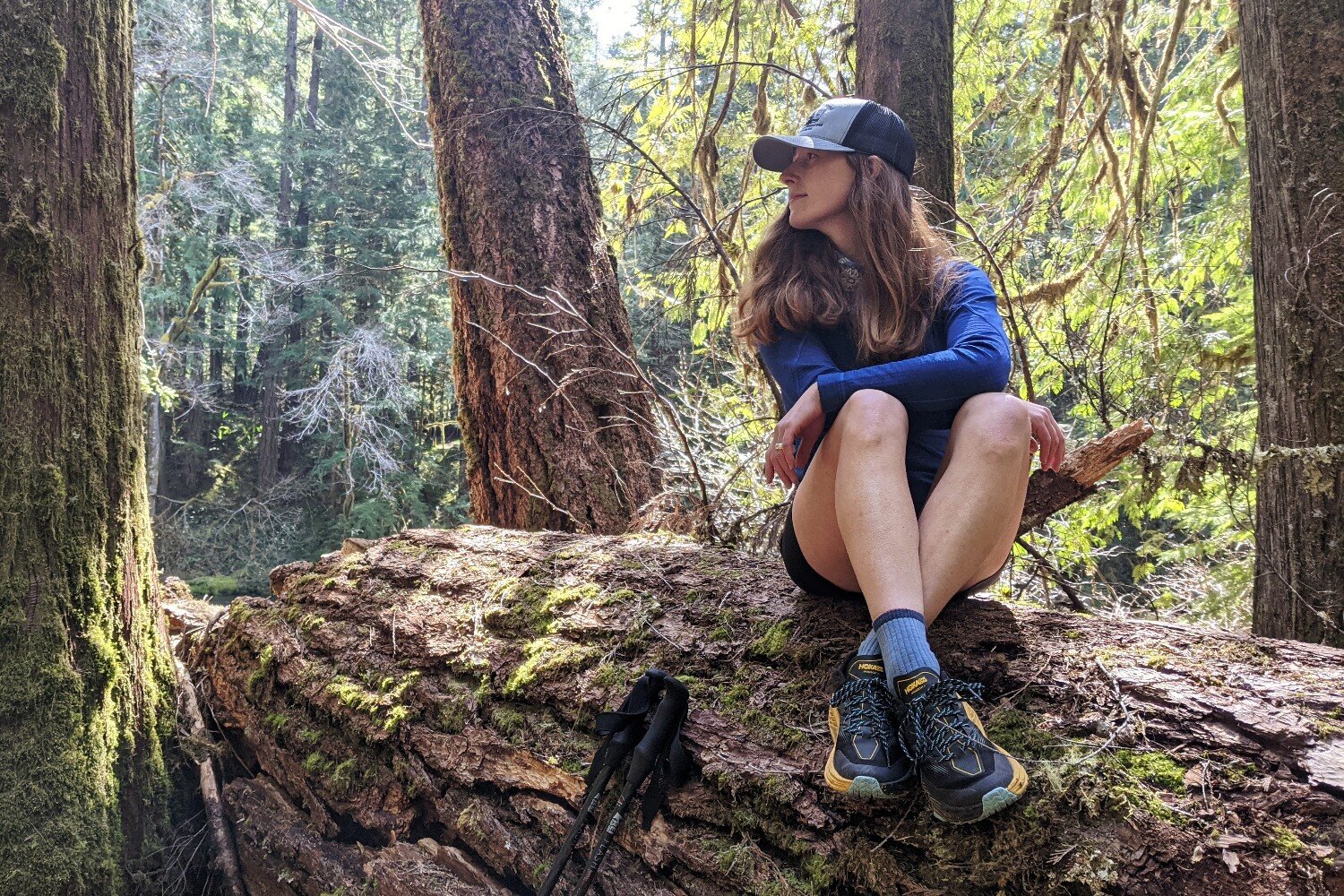
Product Comparison Table
How we test & methodology.
We assess hiking shoes along five different dimensions: comfort, traction, weight, durability, and weather resistance. We have hiked hundreds of miles in each pair of shoes and taken them the distance to determine how each model performs in the following metrics.
Comfort is queen when it comes to footwear. We test with a careful eye toward the space in the toe box – enough to accommodate natural toe splay and prevent squished toes and blisters during long hikes, but not so much that shoes feel floppy. We scrutinize the lacing system, looking for both a secure and customizable fit that allows users to adjust tension over the course of a hike and prevent slippage or pressure points. The right sole stiffness is crucial to strike a balance between stability and flexibility, ensuring sufficient support while allowing for natural foot movement on uneven terrain. We also take note of arch support, examining each shoe’s ability to provide adequate support for various foot arch types to limit fatigue and discomfort over extended periods. Also paramount, we use our feet to feel out cushioning and a shoe’s capacity for impact absorption and responsiveness with every each stride.
For traction, we tackle a variety of terrains. From traditional single track to gravel, rock scrambles, mud, and sand. Most shoes perform admirably enough in fair conditions, so we are sure to put each pair through its paces in wet and slick conditions to figure out which ones can really grip in the muck. We analyze the lug pattern of the outsole, and rank them by depth and bite. Deeper lugs typically provide superior traction in loose or slippery conditions. The sole material plays a vital role in traction performance and we are also sure to test out additional traction features like heel brakes and forefoot grooves, which generally enhance grip and maneuverability on steep descents or ascents.
The lighter the better, all else being equal. We look at the listed manufacturer weight and weigh each pair ourselves.
Durability is every aspect of construction and materials that ensures long-lasting performance on the trail. We put on mile after mile, carefully assess the outsole material, opting for durable rubber compounds and specialized blends that resist abrasion and wear. We also feel out the insole foam to see how well it maintains its cushioning properties and structural integrity over extended use. The upper material is another critical consideration for us and we examine its resilience against tears, and punctures, especially in high-wear areas. And though they are replaceable, we still scrutinize the durability of the laces, ensuring they can withstand repeated tightening and loosening without fraying or breaking.
WEATHER RESISTANCE
Weather resistance is about keeping out water, drying quickly, and providing breathability to keep feet dry. After hiking through rain and crossing waterways, we thoroughly examine the upper material of each pair for its ability to repel water. Certain features like well-sealed seams and a gusseted tongue are important for their effectiveness in preventing water penetration. In addition, we pay attention to the design of the collar, looking for a snug (but still comfortable) seal against rain, mud, and debris. Furthermore, we assess the breathability of the shoe to prevent sweat buildup.
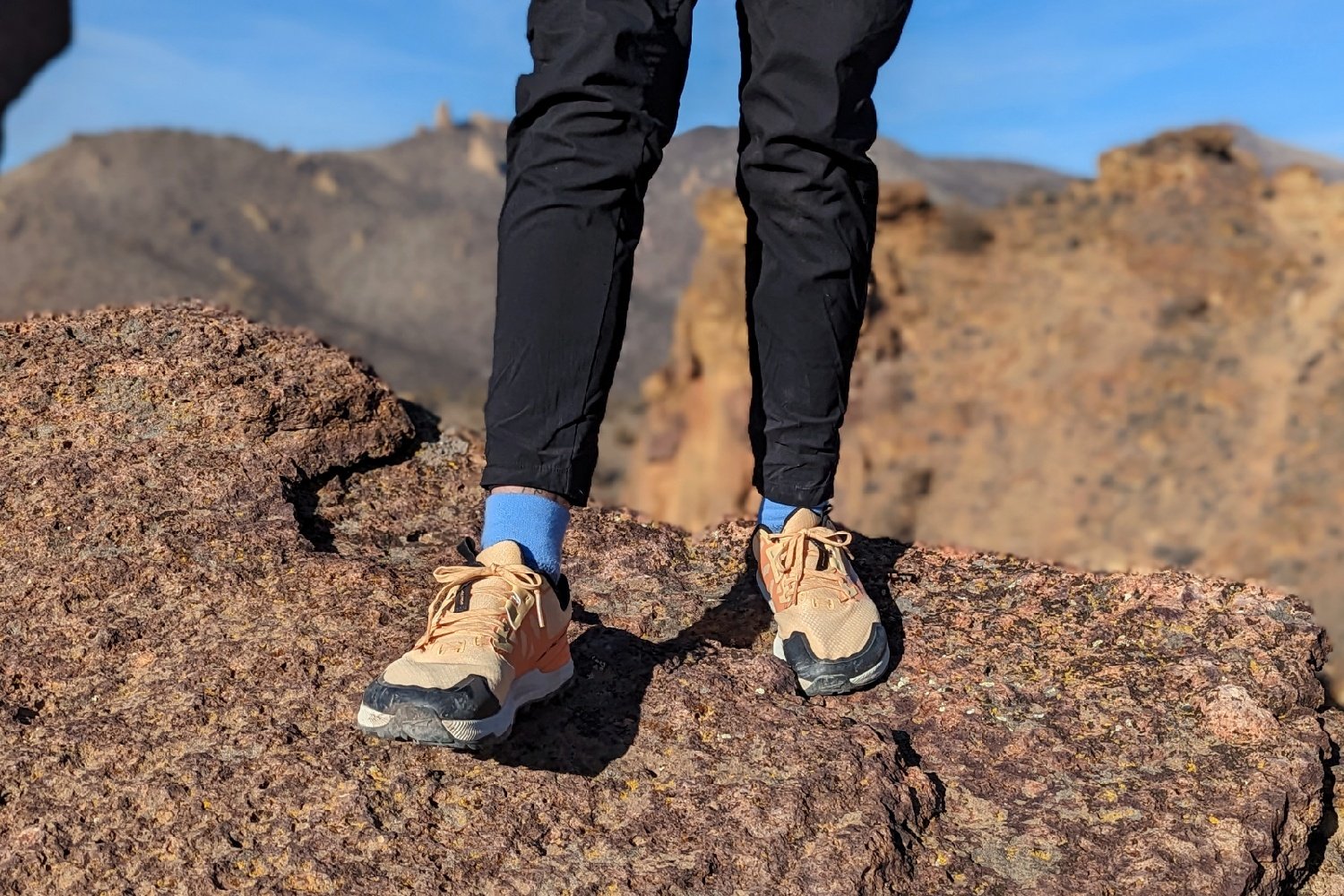
What’s Most Important to You in a Hiking Shoe?
We create our lists taking into account a handful of different metrics, however, you may heavily prioritize one characteristic over everything else. If that’s you, here are our picks if you’re most interested in:
COMFORT & FIT
Hiking shoes that don’t require breaking in to be comfortable
- HOKA Speedgoat 5
- Topo Athletic Ultraventure 3
- Salomon X Ultra 4 GTX
- Saucony Peregrine 14
- Altra Lone Peak 8
- Merrell Moab Speed 2
Best hiking shoes with a wide fit
- Merrell Moab 3
- KEEN Targhee III WP
- Oboz Sawtooth X WP
Most supportive hiking shoes
- La Sportiva Spire GTX
Best mid-range hiking shoes
Best budget hiking shoes
Best lightweight hiking shoes
Best heavy-duty hiking shoes
- Merrell Moab 3 WP
DURABILITY & MATERIALS
Most durable hiking shoes
Most durable trail runners for hiking
WATERPROOF VS NON-WATERPROOF
Best waterproof hiking shoes
Best non-waterproof hiking shoes
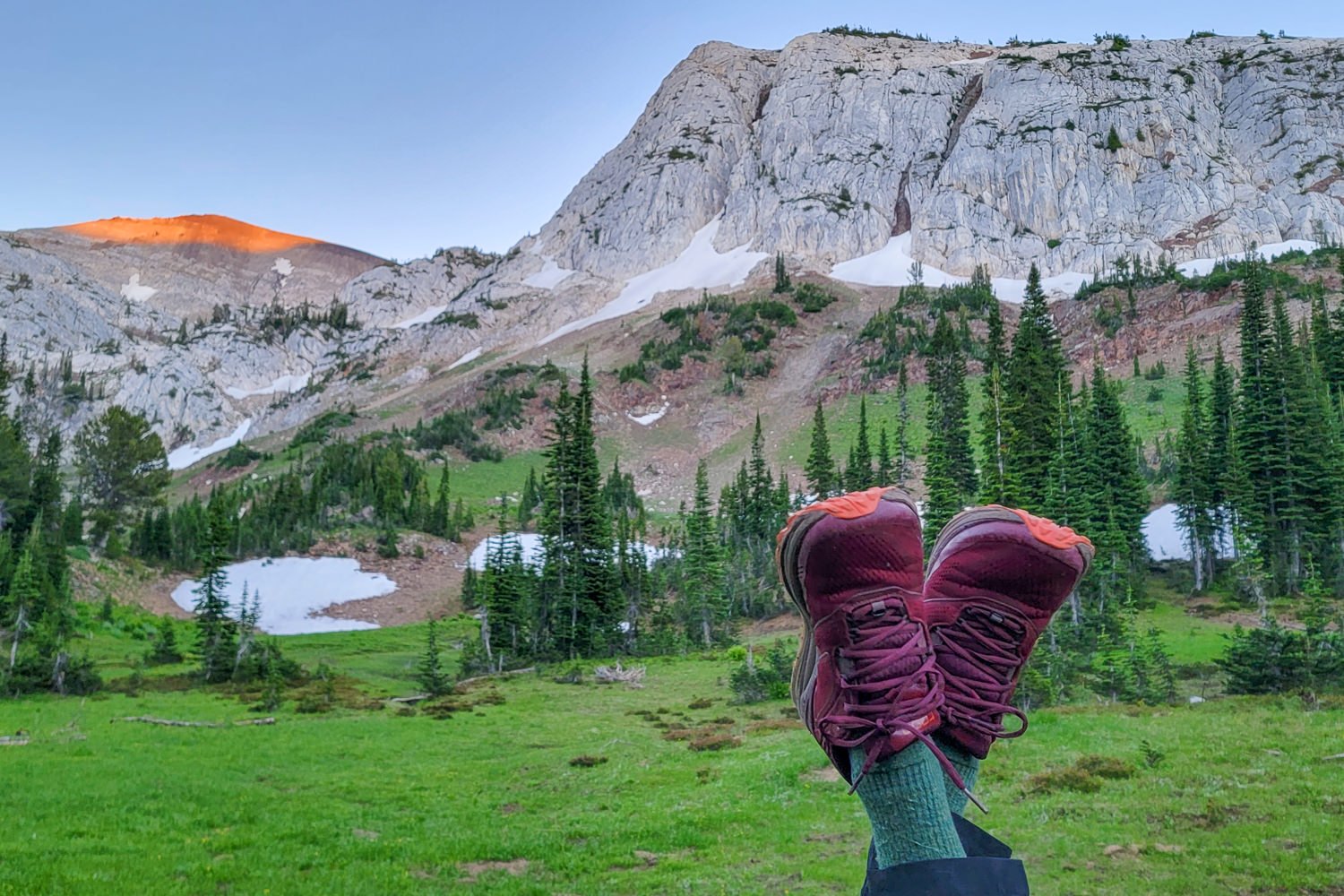
Topo Ultraventure – Photo credit: Heather Eldridge (CleverHiker.com)
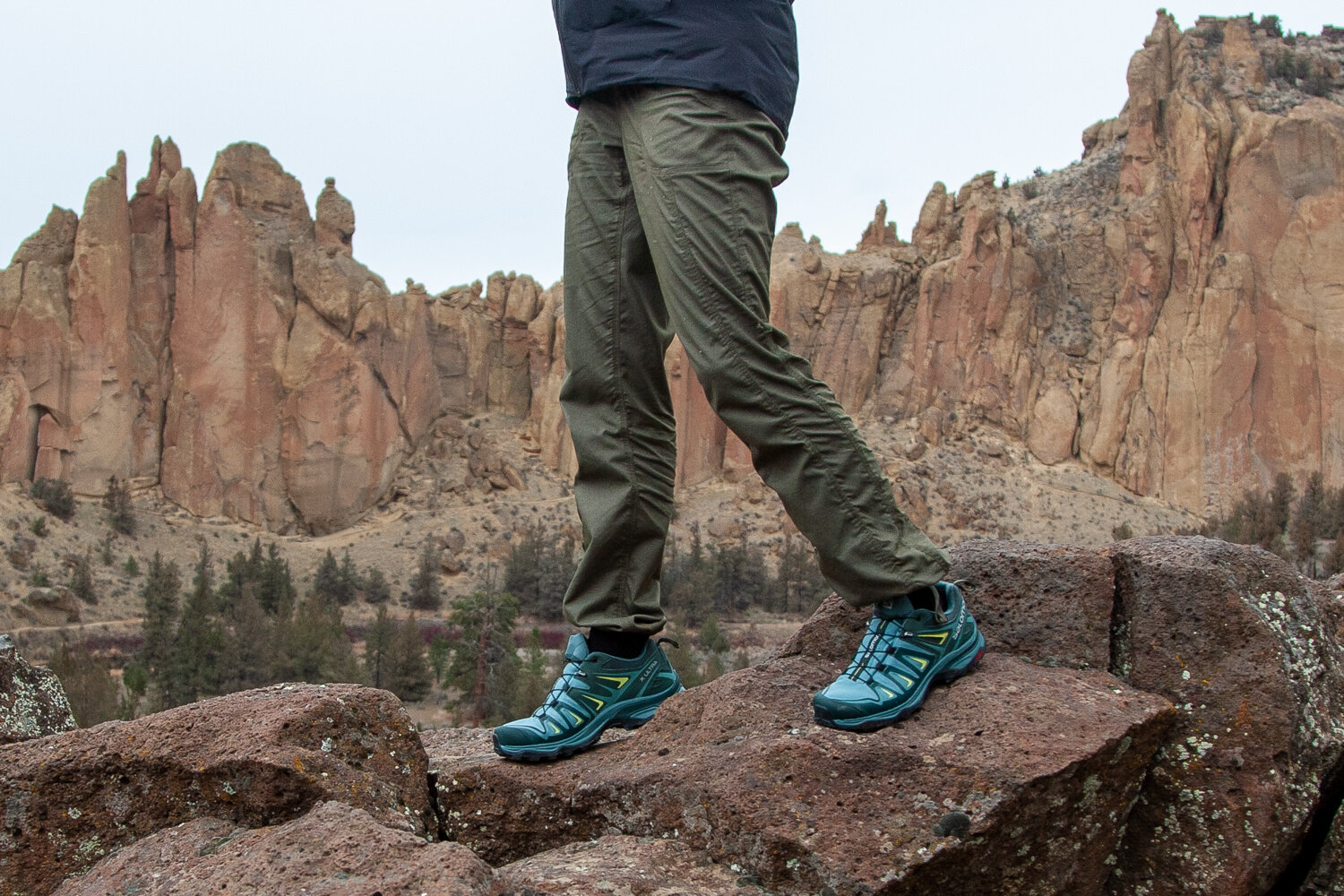
Salomon X Ultras – Photo credit: Casey Handley (CleverHiker.com)
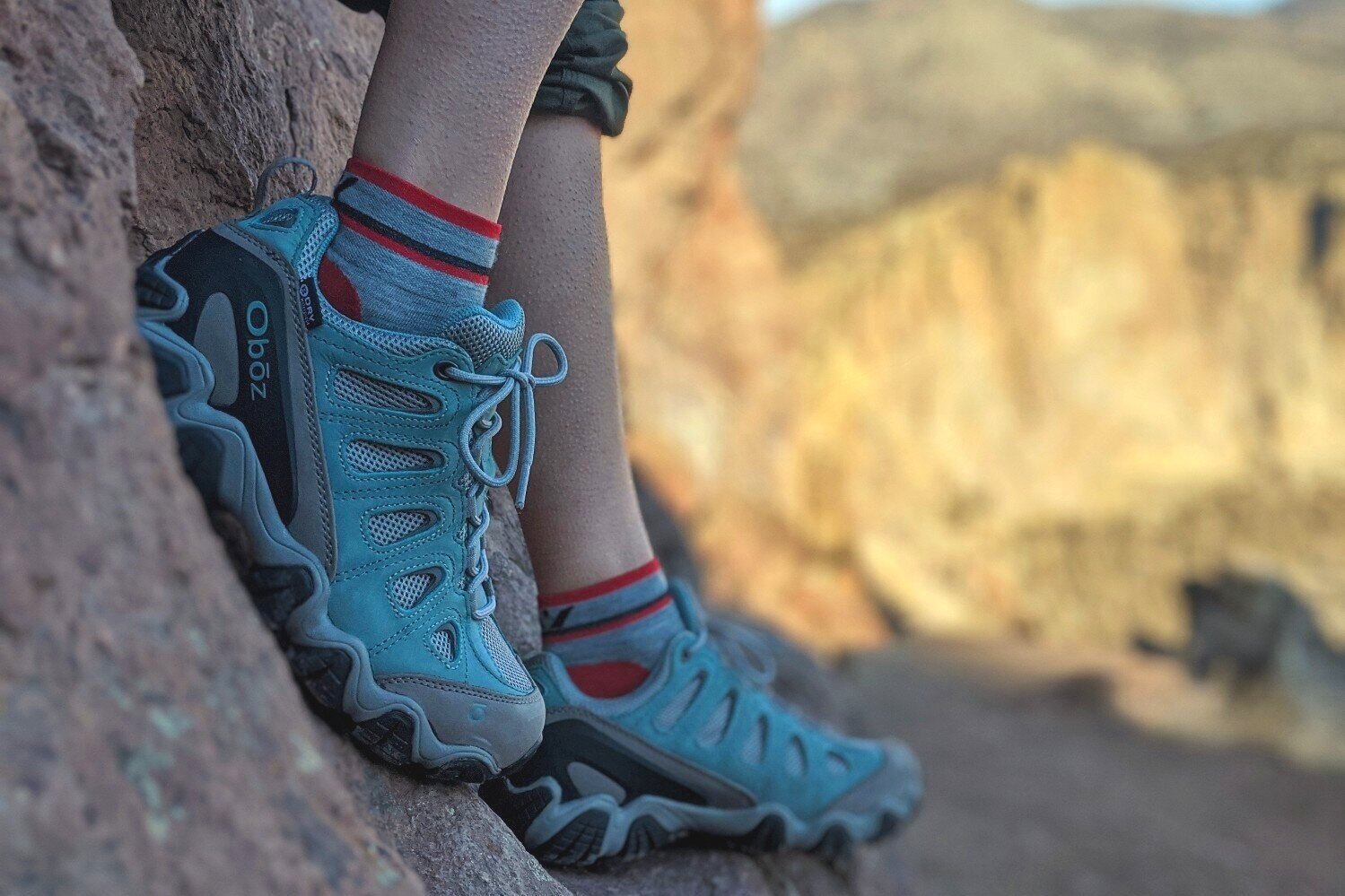
Oboz Sawtooths – Photo credit: Casey Handley (CleverHiker.com)
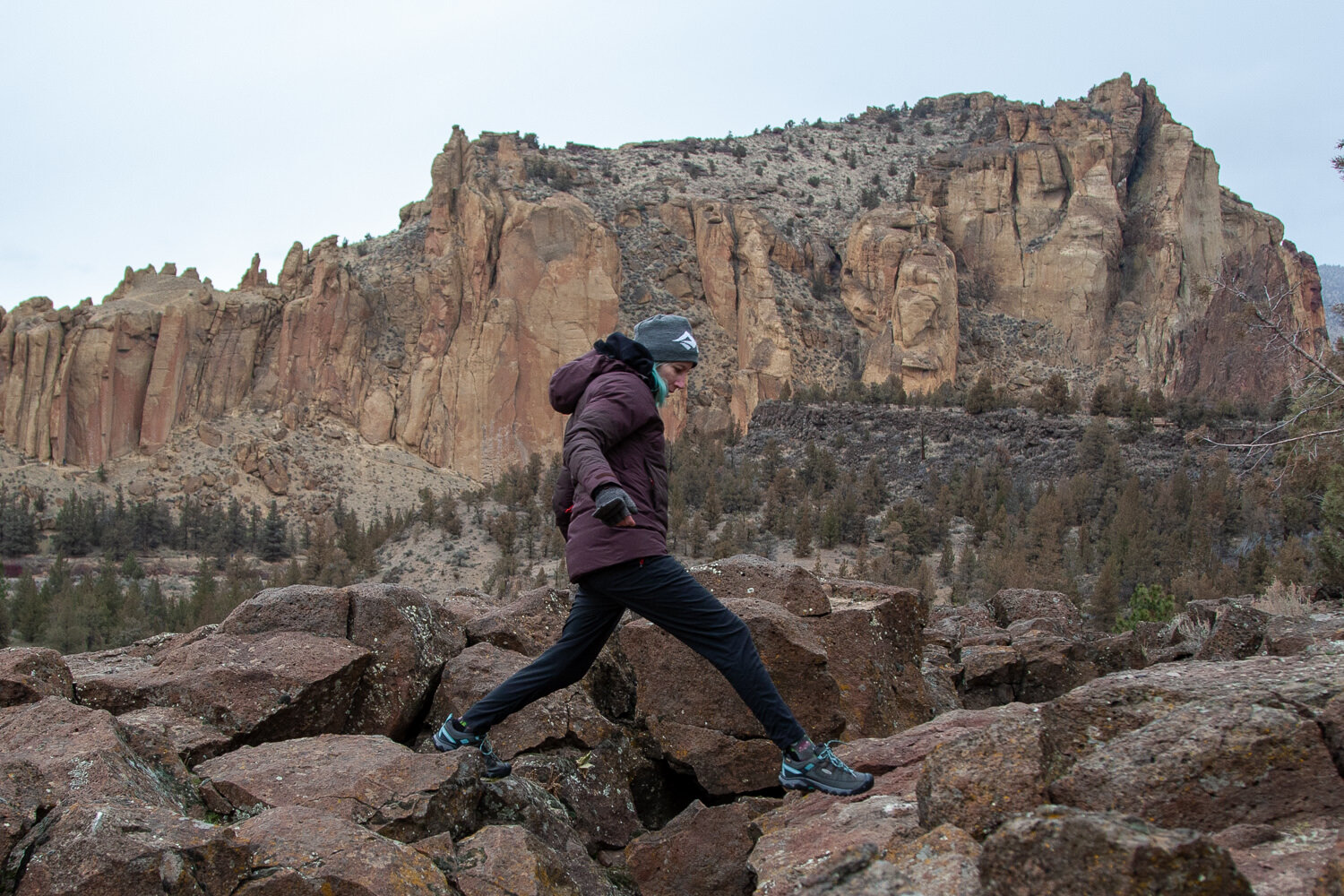
Keen Targhee III WP – Photo credit: Heather Eldridge (CleverHiker.com)
How to Choose Hiking Shoes
Boots vs. shoes vs. trail runners.
Hiking footwear is a really personal choice, and people often have differing opinions on what type of shoe works best for hiking. We tend to prefer lightweight trail runners since they’re more comfortable to hike long distances in and they’re typically more breathable. Traditional hiking shoes – especially those made with leather – are going to be more durable, but they’re typically significantly heavier/bulkier. Hiking boots tend to work well for those wanting extra ankle support and durability. Here’s an article that will help you decide which style works best for you.
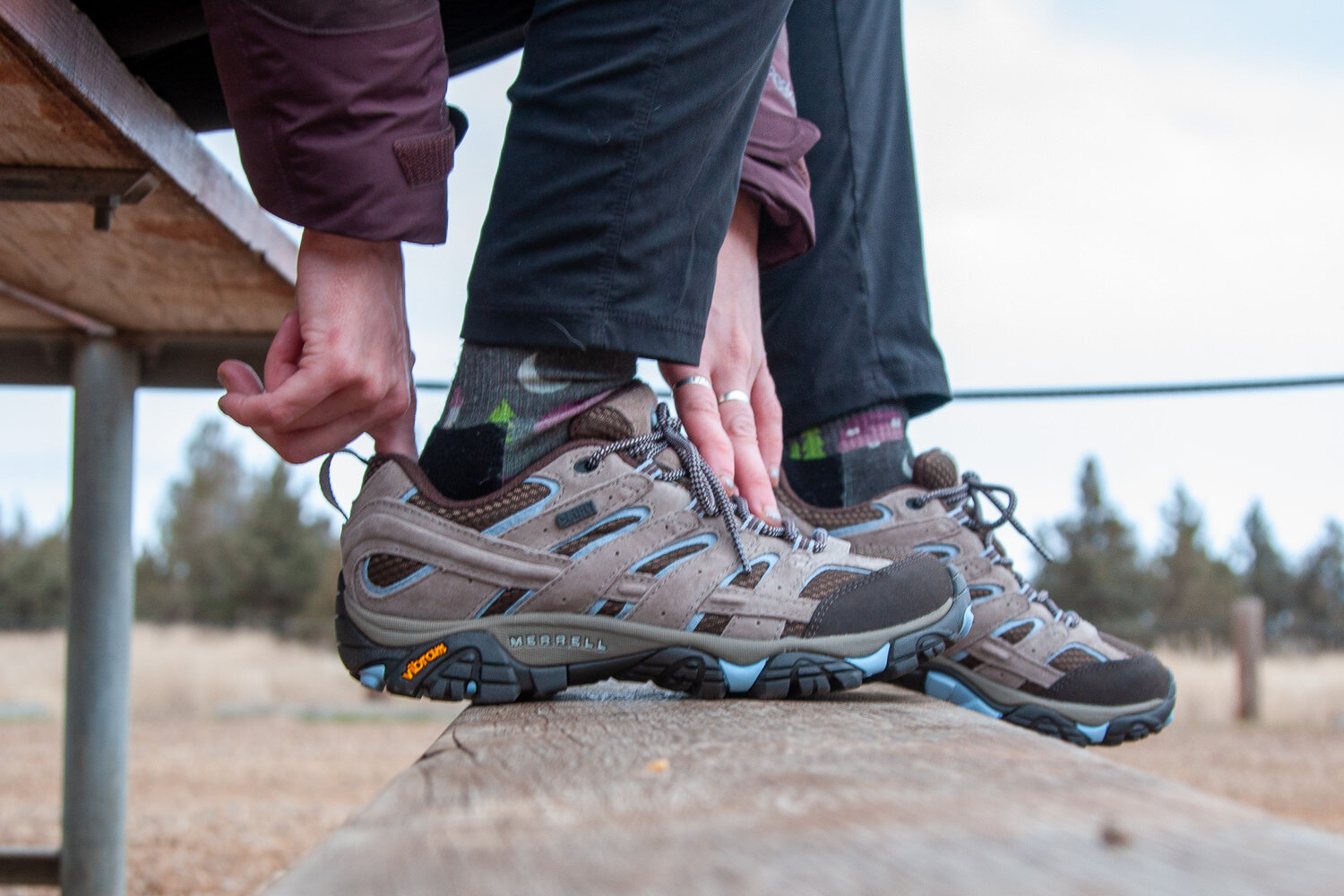
Feet can swell during long days on trail, so it’s a good idea to buy hiking footwear at least a half size larger than your normal shoes if you’re on the edge of a size. A good way to test sizing on your hiking shoes is to loosen all the laces, situate your foot so that your toes touch the front of the toe box, and then make sure you can put your index finger between your heel and the back of the shoe. This will ensure that your toes don’t slide forward and hit the toe box on downhill sections of trail. You should also consider which socks you’ll be wearing and if you’ll be adding aftermarket insoles when choosing a size. It’s much better for footwear to be a little big than too small.
BREAK-IN PERIOD
You’re going to take thousands of steps on any backpacking or hiking trip, so you need to know that your footwear will fit comfortably and won’t cause blisters. We recommend buying your footwear at least a few weeks before any long hiking trips and spending as much time in them as you can. This will allow your new shoes to soften up, and you can make sure they work well for your feet. If you notice any issues, it’s much easier to address them before you head into the backcountry.
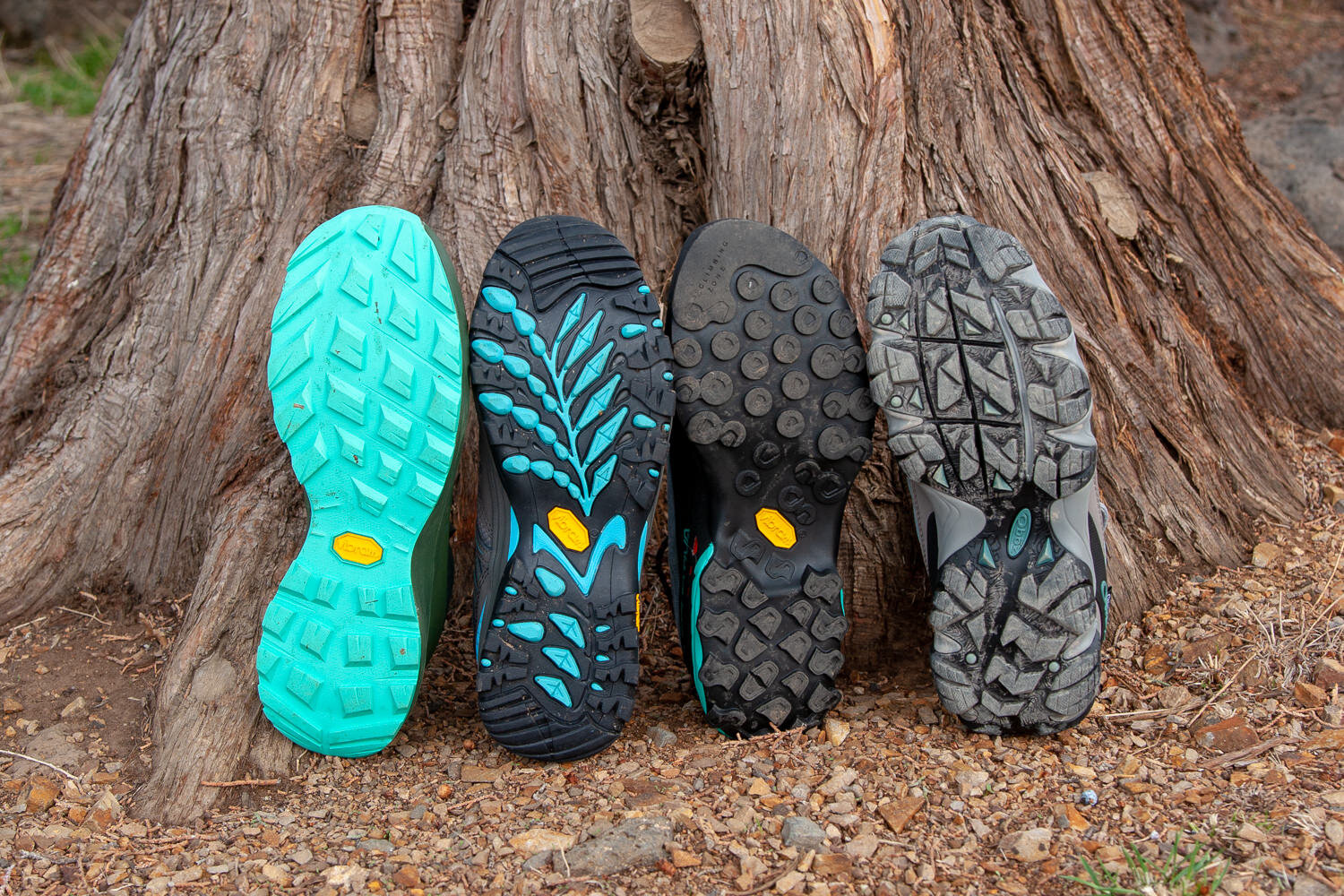
Traction is one of the most important aspects of backpacking and hiking footwear. Your shoes will take you over narrow and rocky ridgelines, through slippery water crossings, and across loose scree fields. Knowing that your footwear will keep you from slipping is crucial, especially over washed out or exposed sections of trail. We heavily factored quality traction into all of our footwear recommendations.
MANAGING MOISTURE & BLISTERS
If you’re on an extended trip in wet conditions or you find yourself caught in a downpour during a day hike, your feet will likely get wet no matter what type of footwear you’re wearing. Wet feet can lead to hot spots and blisters, but this can be prevented if you have a healthy foot care routine. Whether you hike in waterproof hiking shoes or non-waterproof trail runners, be sure to check out our post on How to Prevent and Treat Blisters for more info on moisture and blister management.
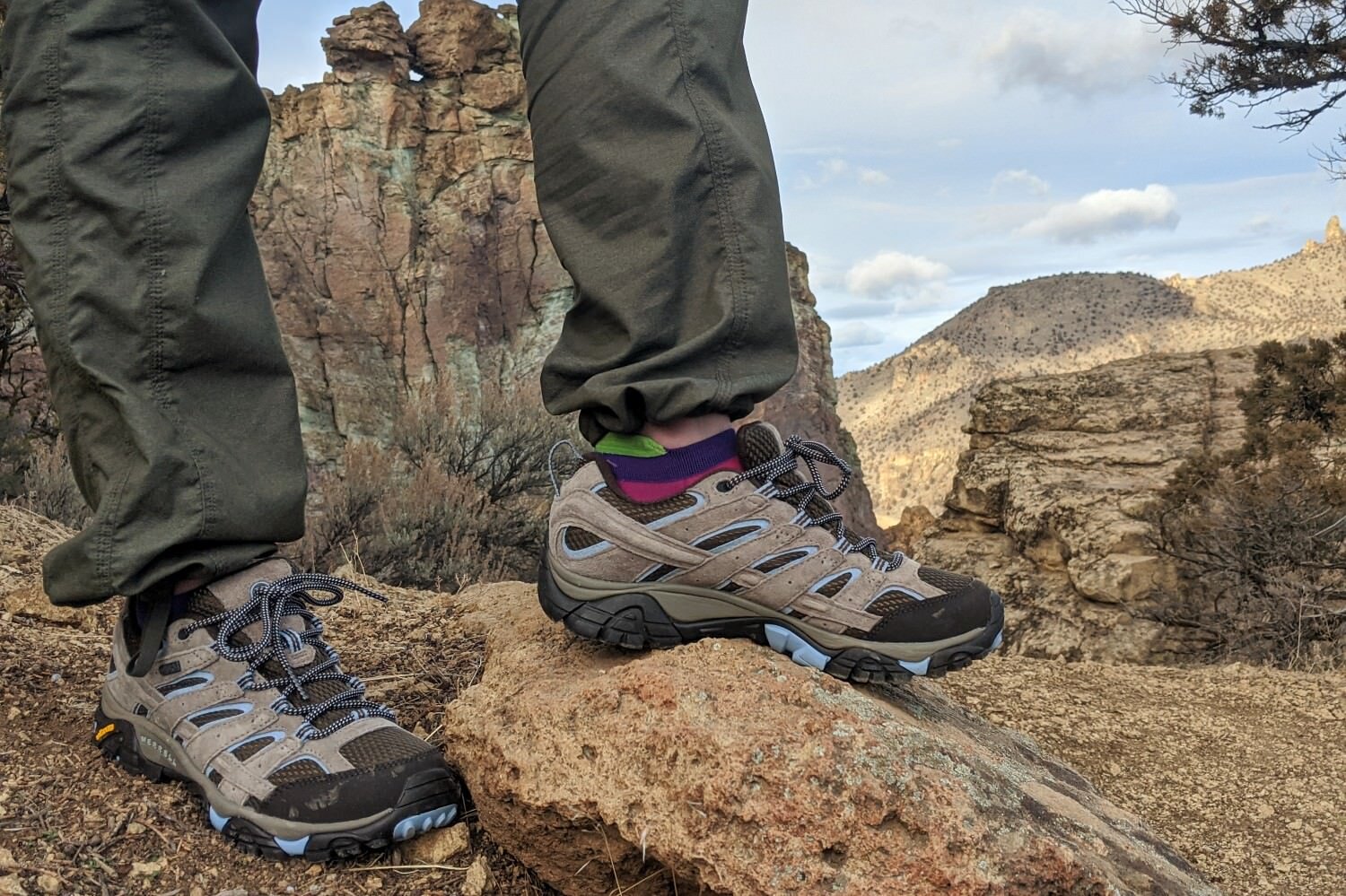
WATERPROOFING TREATMENTS
zzWaterproof footwear is ideal for soggy day hikes, but it’s important to remember that “waterproof” doesn’t mean that water can never get in. Water always finds a way in during a prolonged downpour, and light rain can drip down your legs and into your shoes. Keep in mind that waterproof treatments are not permanent, you’ll eventually need to reapply a treatment to keep your shoes sealed.
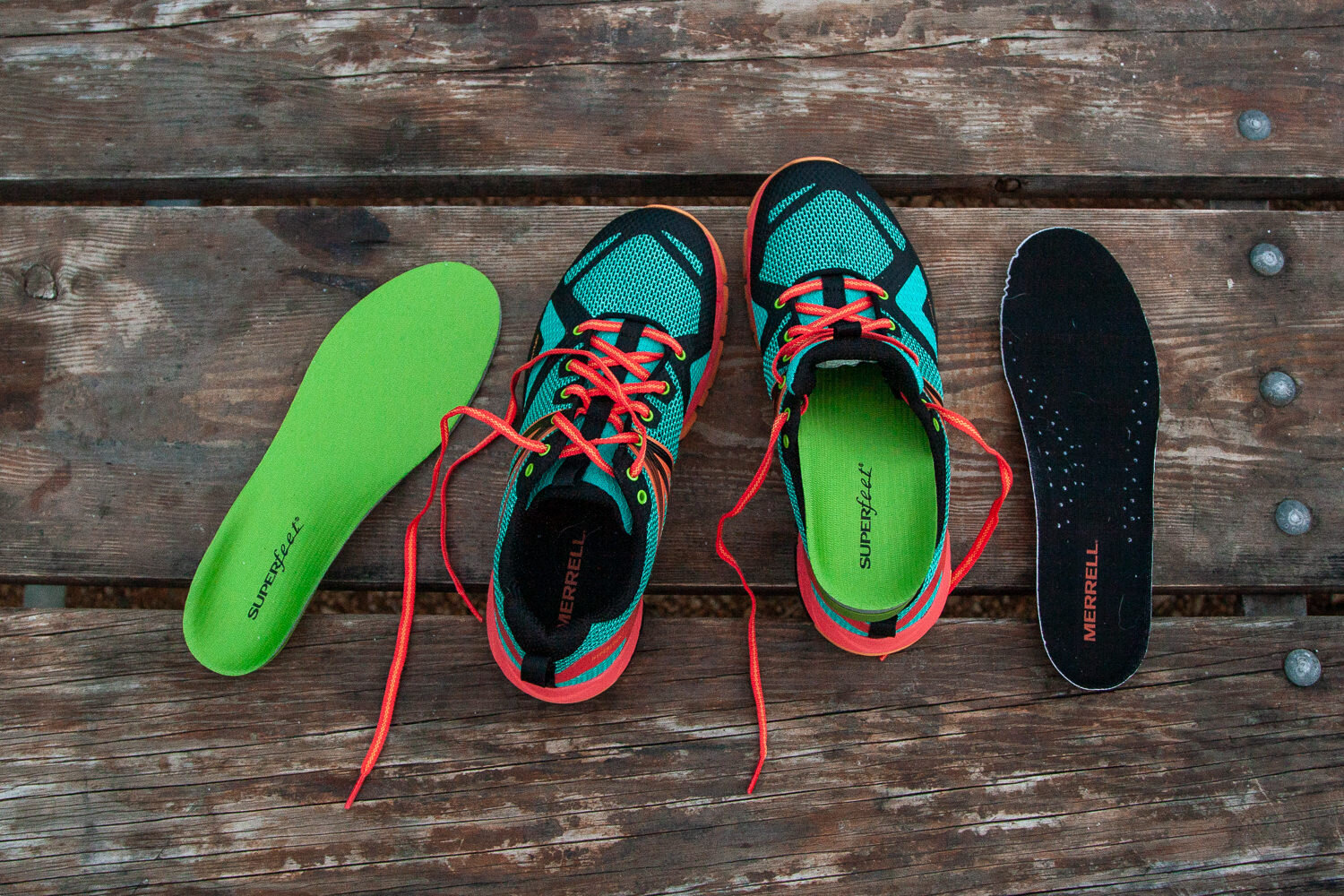
We’ve found that wearing quality socks makes a big difference in how long we can keep our feet happy and in good shape on trail. Hiking socks should be comfortable, durable, and made with materials that wick moisture away from your skin. Check out our Best Hiking Socks list to see our top picks.
Aftermarket insoles can help alleviate a variety of shoe discomforts on the trail. If you suffer from plantar fasciitis or you just need more cushioning and support in an otherwise rigid shoe, swapping insoles may be your solution. Insoles can also help take up a little extra space in footwear for a customized fit if you’re between sizes.
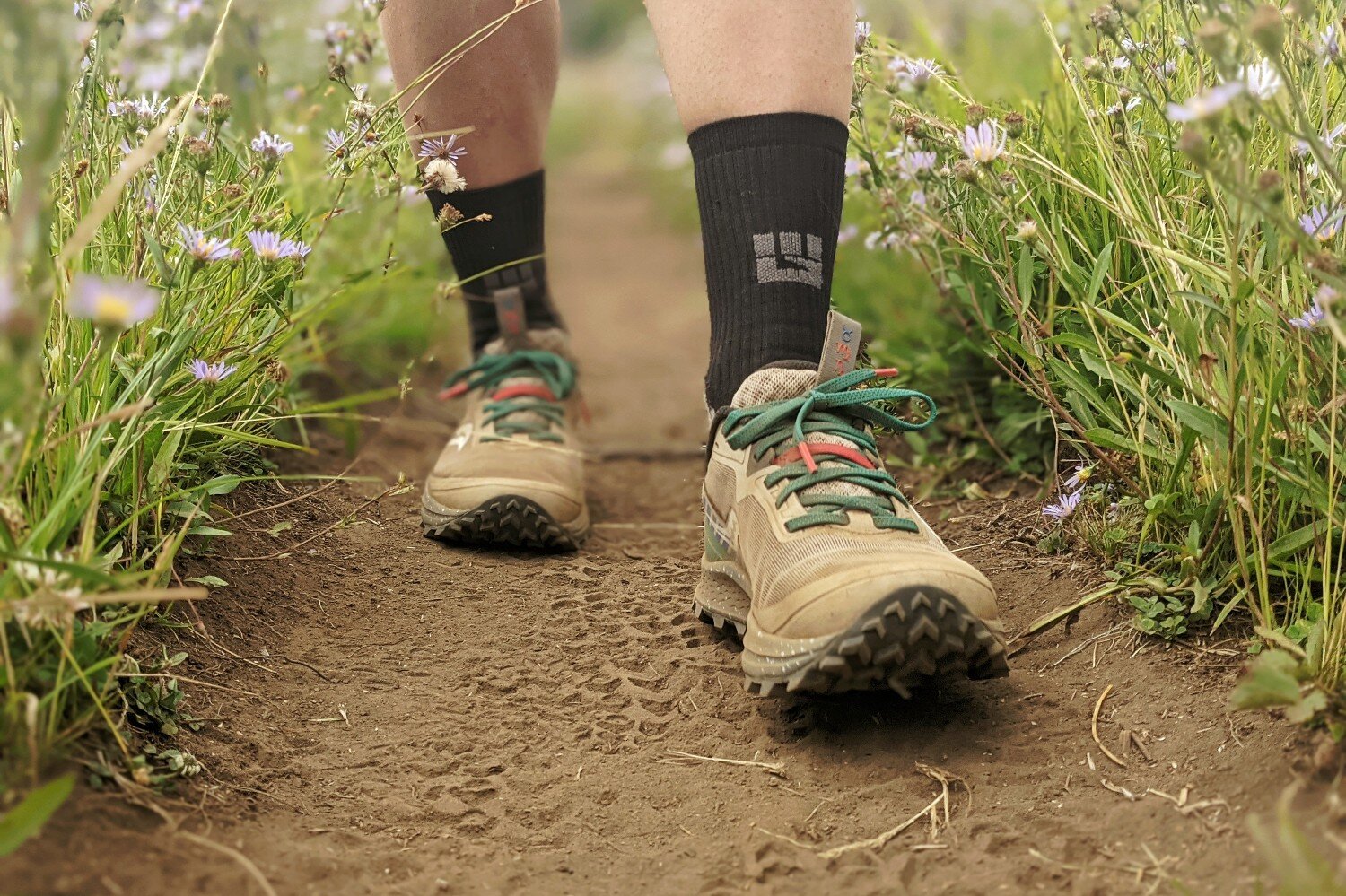
Honorable Mentions
These hiking shoes are very popular and have a lot of good things going for them. You never know, one of them might be your perfect fit:
Merrell Siren Edge 3
The lightweight and affordable Merrell Siren Edge 3 hiking shoes have a varied lug pattern for good traction on many different types of terrain. We find the support to be a little stiff and overbuilt for our liking, but many others like the Siren Edges for wearing as everyday shoes around town.
As for their performance on trail, the aggressive arch and stiff underfoot take away much of the ground feel and make us less confident on paths with a lot of uneven terrain – like rooty and rocky trails. The tread is excellent for groomed paths with a mix of stone slab, dirt, and wet rock, but they’re noticeably more clumsy on loose terrain and muddy trail.
La Sportiva TX 4
La Sportiva’s TX4s are approach shoes, so they excel on trails with a lot of scrambling. While they’re not as versatile as the other shoes on our main list, they do what they do quite well.
So who needs an approach shoe? The main demographics are climbers and mountaineers who need nimble but supremely grippy shoes for tricky traverses to final ascents, but some hikers who don’t mind a snug fit find the exceptional traction of the TX4s preferable for all manner of trail.
Most members of the CleverHiker team prefer a looser fit for their shoes, and that’s a big part of the reason the TX4 just wasn’t it for us. Moreover, we tend to find that footwear that attempts to blend uses ends up being really good for one thing and not so great for the other. If you asked us our favorite approach shoe – it would be the TX4, no questions asked. But for typical hiking trails, we’re almost always going to reach for something less stiff, snug, and specific.
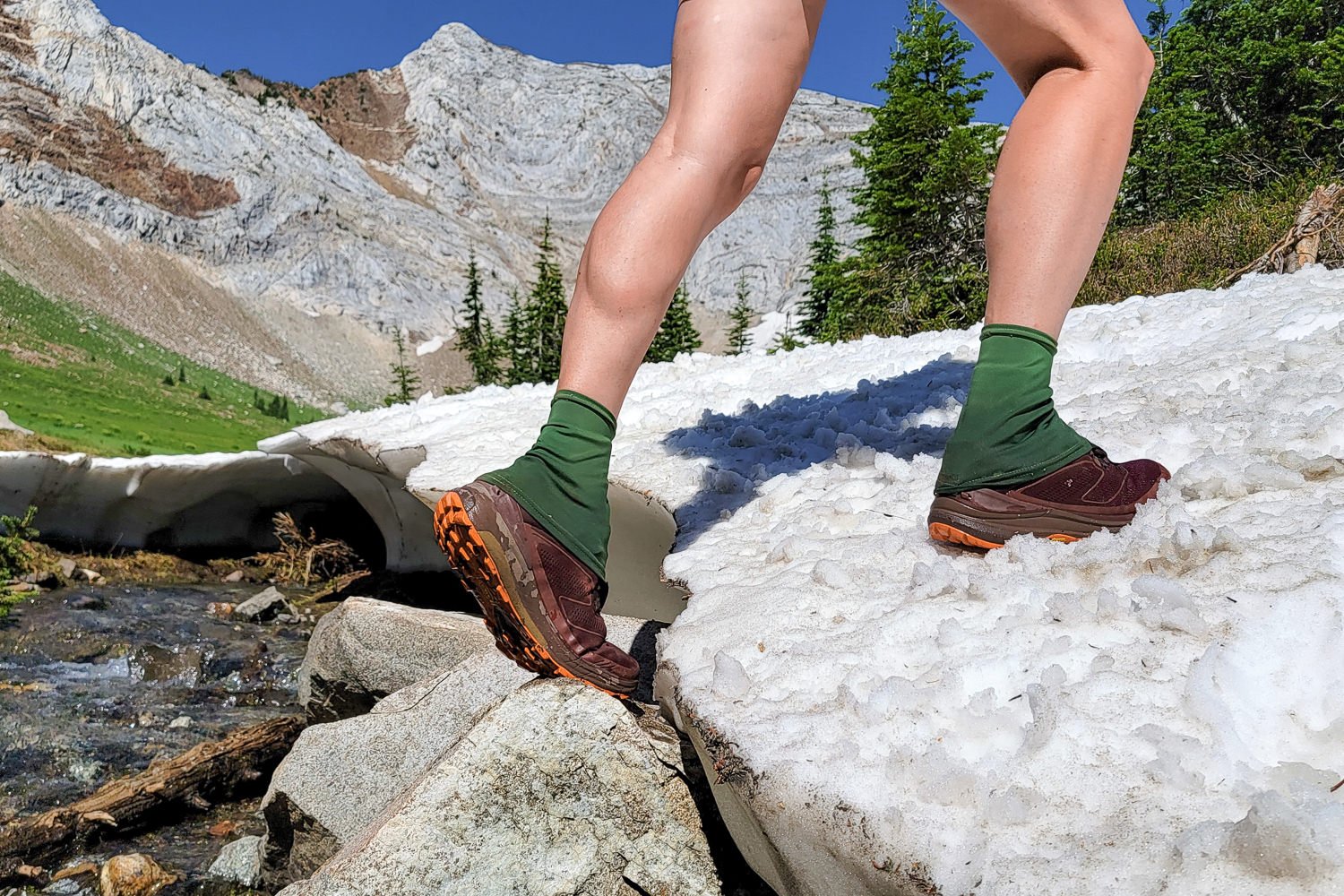
Why trust us?
We understand how tough it is to find trustworthy gear advice, and that’s one of the main reasons we built CleverHiker. We live for outdoor adventure, and we take these guides very seriously.
- Our recommendations are completely independent and based on hands-on experience.
- We test outdoor gear for a living – we’ve logged over 20,000 trail miles and 1,000 nights in the wilderness.
- Our team has thru-hiked some of the most iconic long trails, including the Continental Divide Trail, Pacific Crest Trail, Appalachian Trail, Colorado Trail, Long Trail, Oregon Coast Trail, Arizona Trail, Pinhoti Trail, Superior Hiking Trail, as well as extensive peak bagging, and international treks.
- We field test every product we recommend, which is sadly not the norm.
- We travel to industry trade shows to stay up-to-date on product innovations.
- We continuously update our guides throughout the year and when new products launch.
- We treat recommendations to our readers as if they were for our family and friends.
- We’re lifelong learners and we’re always open to feedback. If you think we’ve missed a worthy product or got something wrong, we’d love to know about it.
Need more Footwear advice?
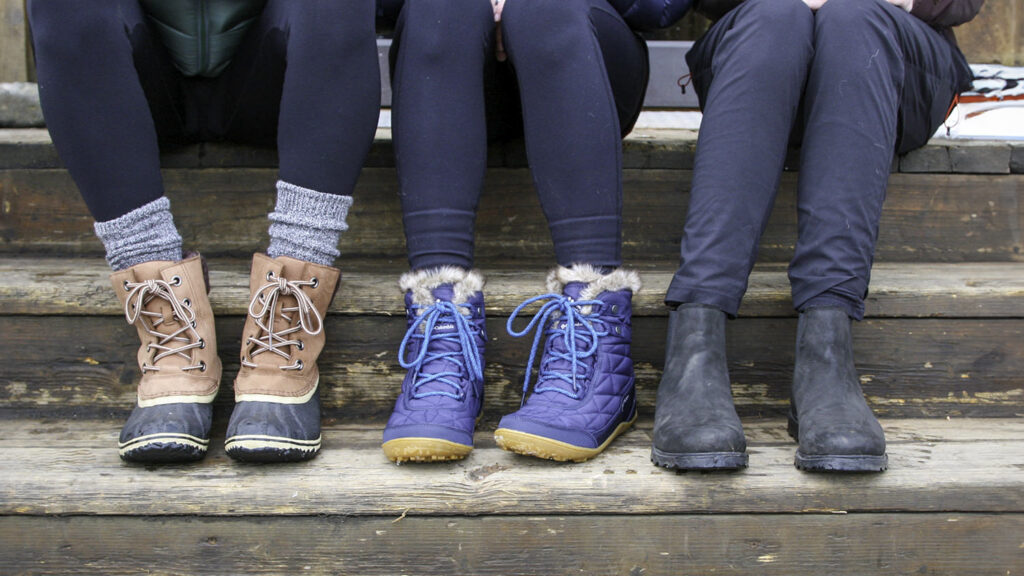
Best Women’s Winter Boots of 2024
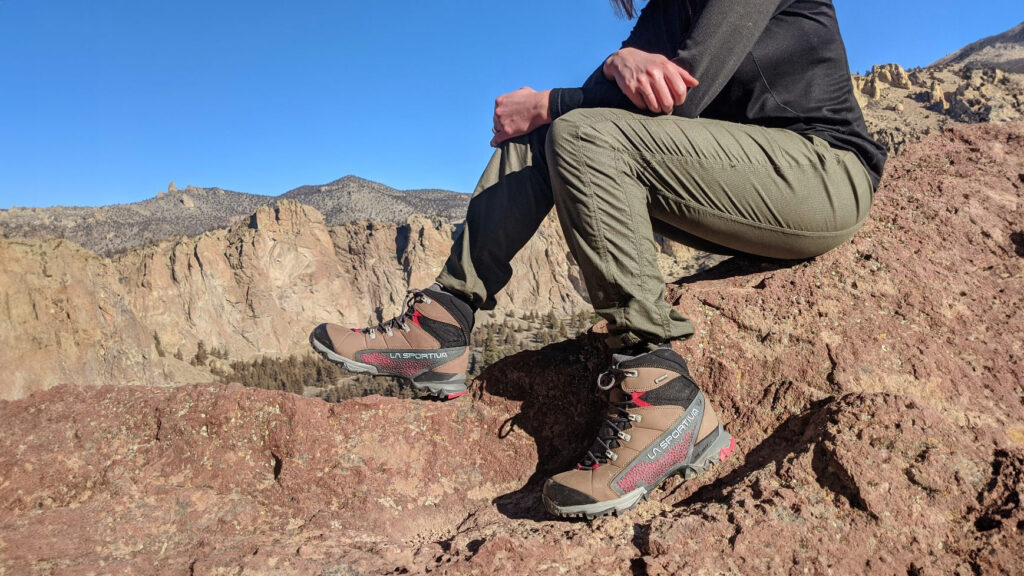
Best Women’s Hiking Boots of 2024
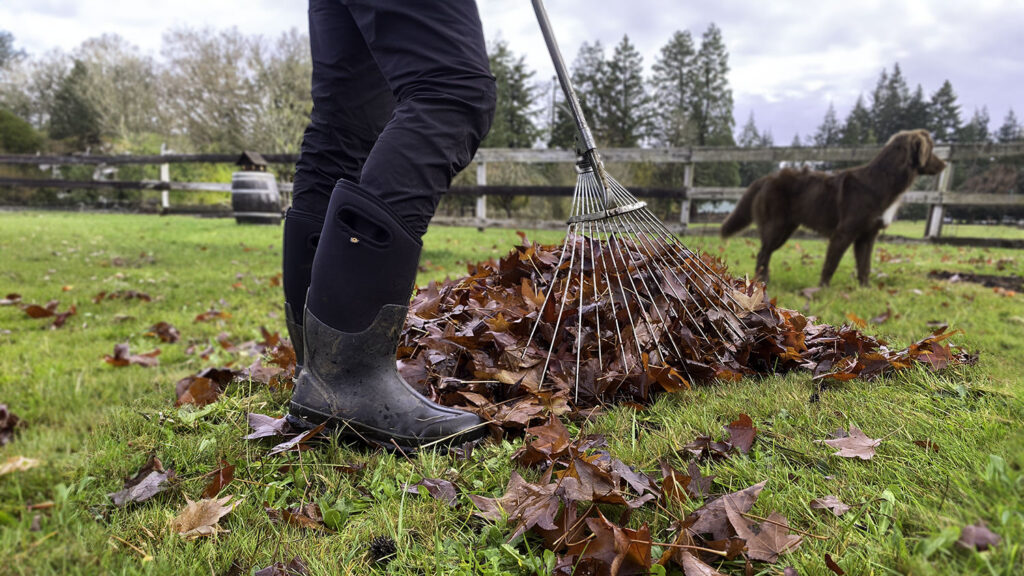
The 7 Best Rain Boots for Women of 2024
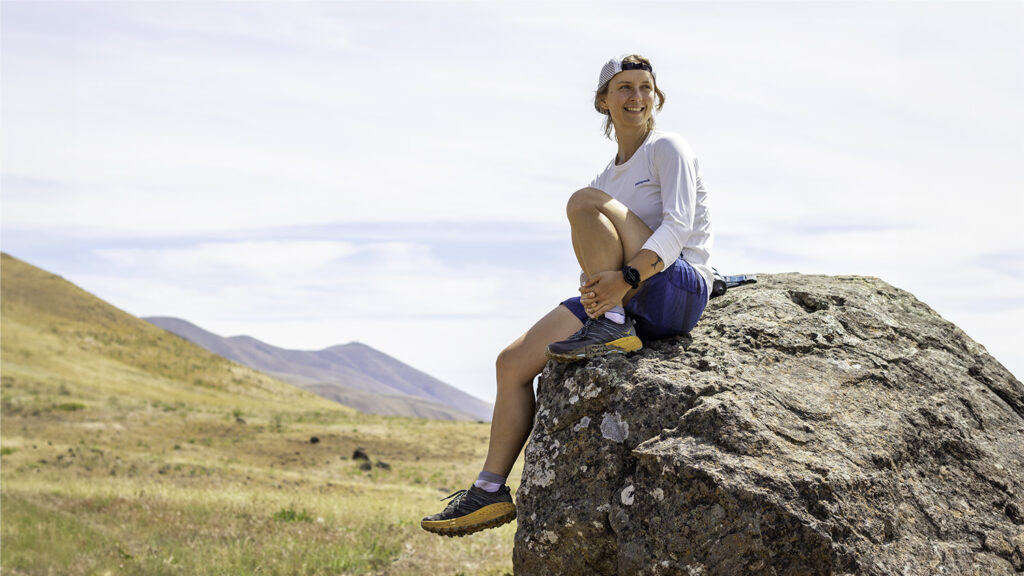
Best Trail Running Shoes for Women of 2024
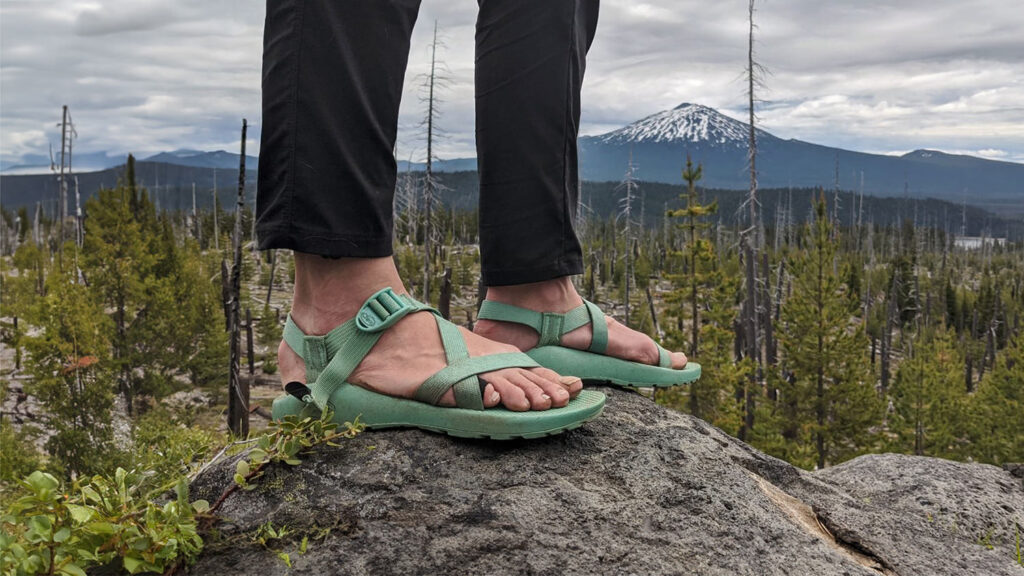
Best Women’s Hiking Sandals of 2024
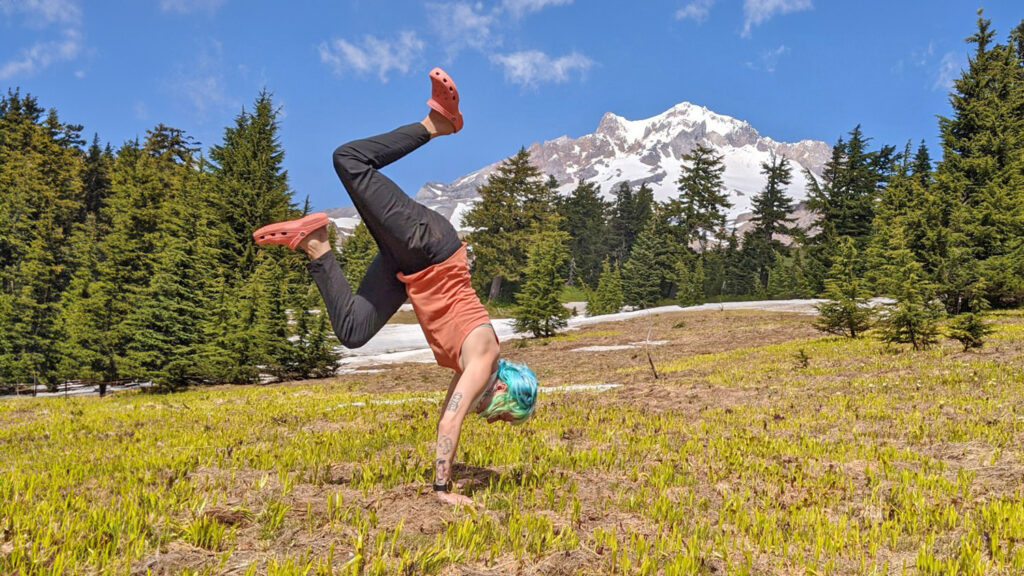
The Best Camp Shoes of 2024
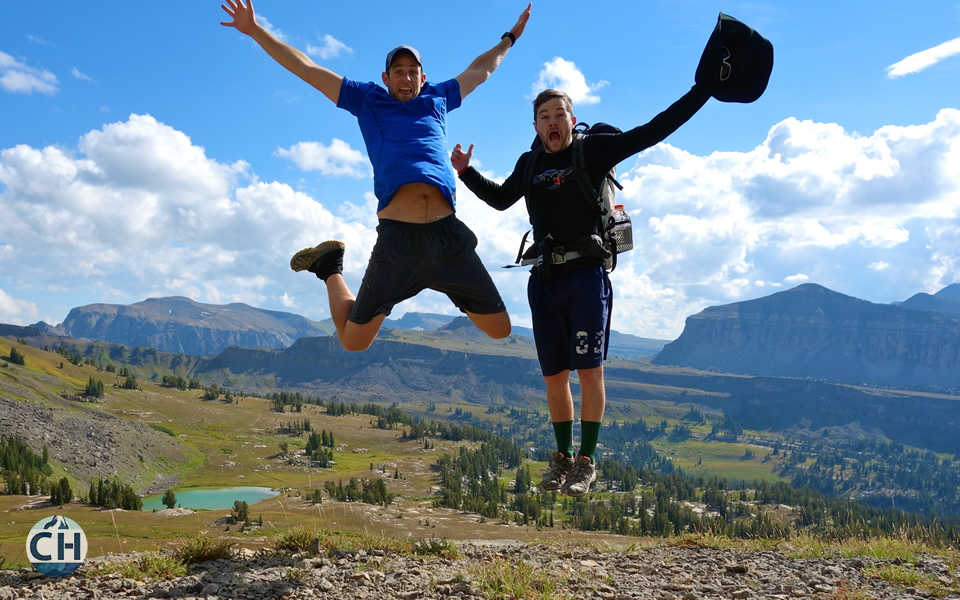
5 Reasons To Ditch Your Hiking Boots
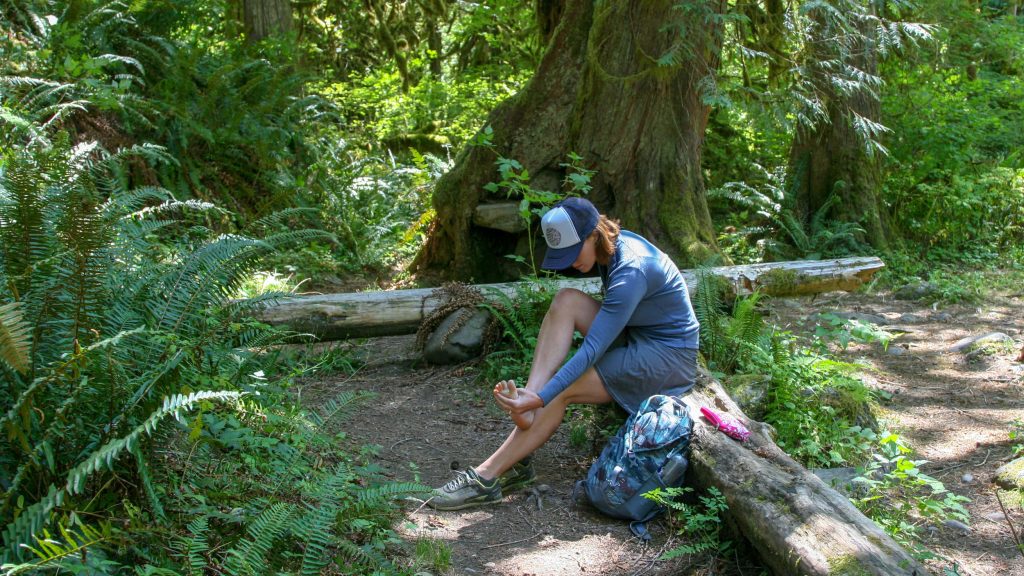
How to Prevent and Treat Blisters While Hiking
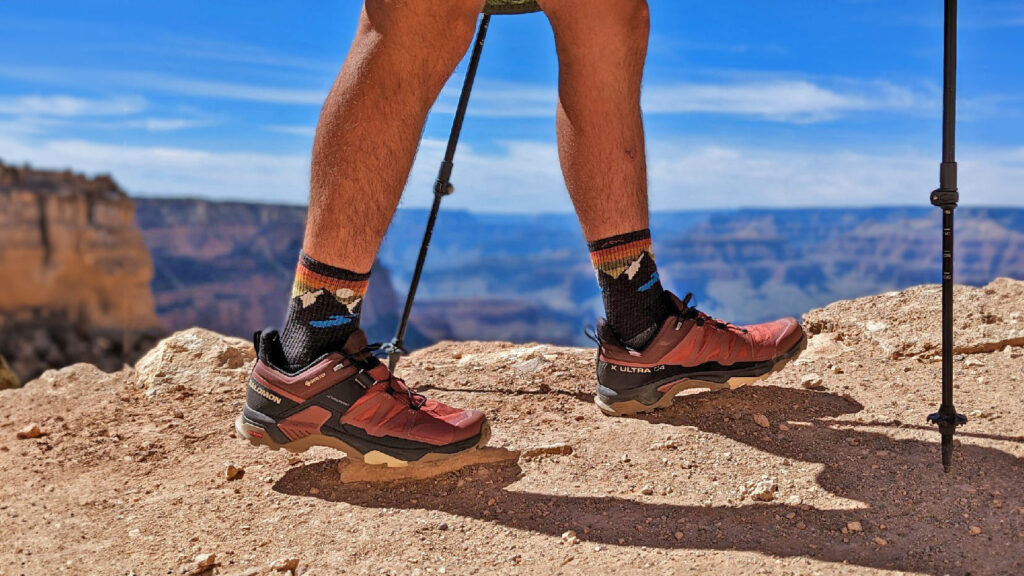
10 Best Hiking Socks of 2024
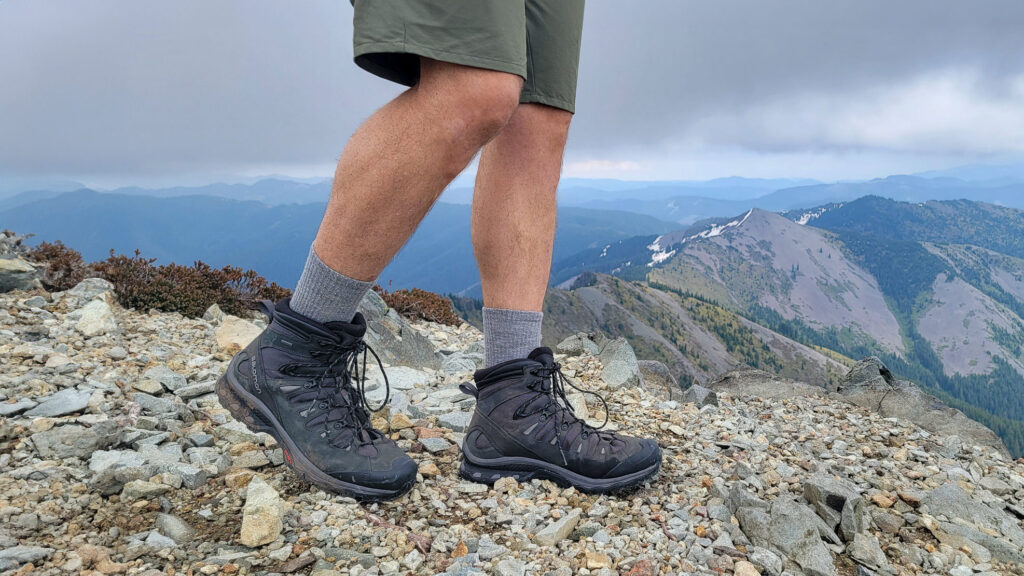
Best Hiking Boots for Men of 2024
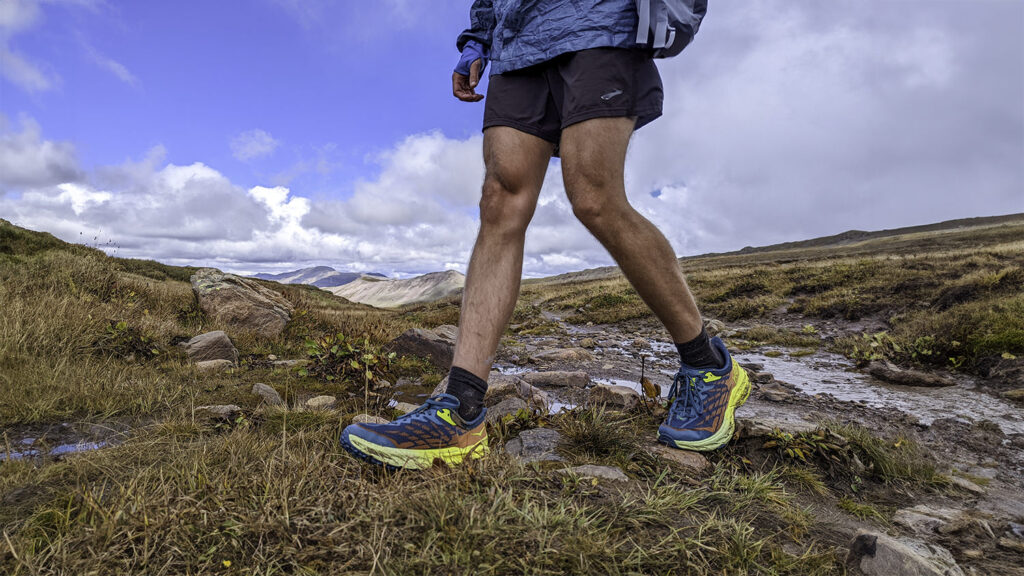
Best Hiking Shoes for Men of 2024
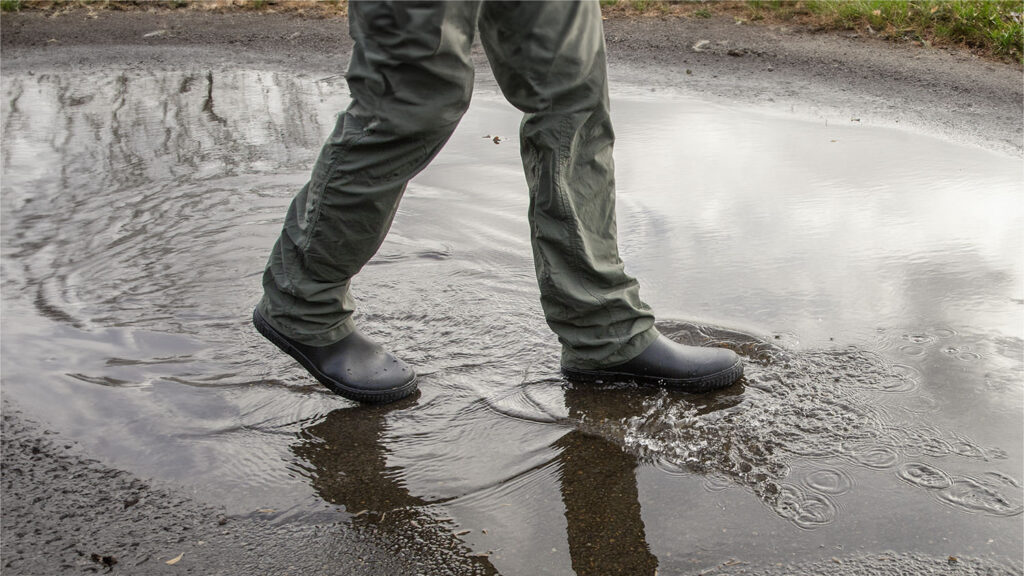
Best Rain Boots for Men of 2024
Get the best content from cleverhiker & around the backpacking world.
Social media is great, but our bi-weekly newsletter is a much better way to stay in the know.
Sign up to get our curated emails with the best content from CleverHiker and around the backpacking world. You’ll be turned on to new videos, trip reports, gear reviews, inspiring outdoor stories and much more. So get in the mix!

- Clothing, Shoes & Jewelry
- Hiking & Trekking
- Hiking Shoes

Image Unavailable

- To view this video download Flash Player
hiwalk Men's Waterproof lightweight Hiking Trekking Camping Shoes

Product details
About this item.
- Made in USA or Imported
- Rubber Sole
- Advanced Waterproofing Technology: Lumparland hiwalk hiking shoes are equipped with advanced HI-TEX waterproof technology, keeping your feet dry and comfortable even in wet and rainy conditions. Seam-sealed construction and waterproof materials provide reliable protection, allowing you to confidently tackle any trail or adventure.
- Non-Slip Durability & Arch Support: Lumparland hiwalk hiking shoes are built to last incorporating non-slip durability into the design. With reinforced toe caps and rugged materials,this waterproof hiking boots withstand the rigors of the trail, protecting your feet from impacts and ensuring long-lasting performance even in challenging environments. Therefor it features enhanced arch support, providing stability and reducing fatigue during long hikes or outdoor activites.
- Breathable Design & Versatile Use: Mesh upper promotes airflow, preventing overheating and moisture buildup for a cool and dry feel throughout the journey. Ideal for day hikes, weekend backpacking trips, and all outdoor adventures, offering versatile performance for various terrain and conditions.
Customers also search

Product Description

Gear up for your next outdoor escapade with hiwalk Waterproof Hiking Shoes
Adventure Awaits: Whether you're embarking on a day hike or a multi-day trek, hiwalk Waterproof Hiking Shoes are your ticket to unforgettable adventures. Embrace the wilderness, experience nature's beauty, and forge lasting memories with footwear that's up for the challenge.
Lumparland hiwalk waterproof hiking shoes
All-Day Comfort: Don't let discomfort hinder your adventures. Our Lumparland hiwalk Hiking Shoes are designed with your comfort in mind. Enjoy the perfect blend of cushioning and support, allowing you to hike longer and farther with ease.
- Uncompromising Waterproof Protection: Our hiwalk Waterproof Hiking Shoes feature a premium waterproof membrane that keeps your feet dry, allowing you to embrace the elements without worry.
- Durable and Dependable: Built to withstand the toughest terrains, these hiking shoes boast rugged construction, ensuring durability that stands the test of time.
- Advanced Traction: The high-grip rubber outsole provides exceptional traction on various surfaces, from slippery rocks to muddy trails.
- Breathable Design: The breathable mesh upper that promotes airflow and ventilation, let you experience refreshing comfort even during the most intense outdoor activities.
- Ankle Support: With ankle support and a secure lacing system, our hiking shoes offer enhanced stability, minimizing the risk of ankle injuries and providing extra confidence on uneven terrain.

- Department : mens
- Date First Available : February 28, 2024
- ASIN : B0CWPL4M28
- #3,582 in Men's Hiking Shoes
Looking for specific info?
Customer reviews.
Customer Reviews, including Product Star Ratings help customers to learn more about the product and decide whether it is the right product for them.
To calculate the overall star rating and percentage breakdown by star, we don’t use a simple average. Instead, our system considers things like how recent a review is and if the reviewer bought the item on Amazon. It also analyzed reviews to verify trustworthiness.
Reviews with images

- Sort reviews by Top reviews Most recent Top reviews
Top reviews from the United States
There was a problem filtering reviews right now. please try again later..
- Amazon Newsletter
- About Amazon
- Accessibility
- Sustainability
- Press Center
- Investor Relations
- Amazon Devices
- Amazon Science
- Sell on Amazon
- Sell apps on Amazon
- Supply to Amazon
- Protect & Build Your Brand
- Become an Affiliate
- Become a Delivery Driver
- Start a Package Delivery Business
- Advertise Your Products
- Self-Publish with Us
- Become an Amazon Hub Partner
- › See More Ways to Make Money
- Amazon Visa
- Amazon Store Card
- Amazon Secured Card
- Amazon Business Card
- Shop with Points
- Credit Card Marketplace
- Reload Your Balance
- Amazon Currency Converter
- Your Account
- Your Orders
- Shipping Rates & Policies
- Amazon Prime
- Returns & Replacements
- Manage Your Content and Devices
- Recalls and Product Safety Alerts
- Conditions of Use
- Privacy Notice
- Consumer Health Data Privacy Disclosure
- Your Ads Privacy Choices
- Order Status
- Shipping & Delivery
- Order Cancellation
- Size Charts
- Promotions & Discounts
- Product Advice
- Send Us Feedback
Popular Search Terms
- Air Force 1
Top Suggestions
Members: Free Shipping on Orders $50+
Mother’s Day Sale: Extra 25% Off
Look for Store Pickup at Checkout
Earn $100 with a New Apple Card. Terms apply.
Hiking Shoes (28)
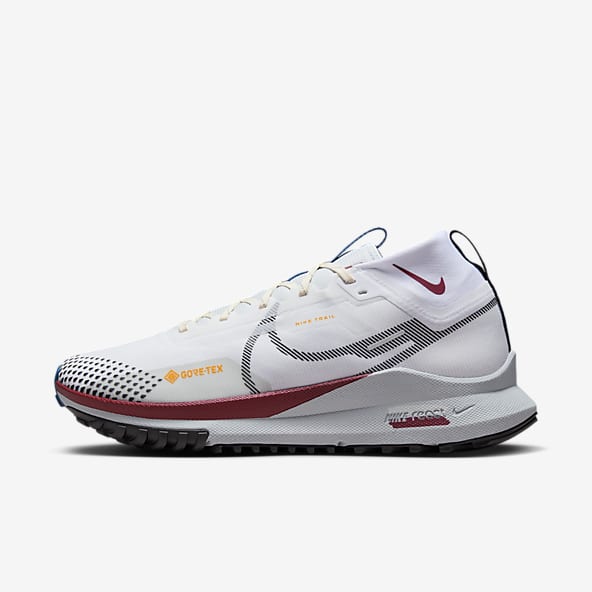
- Search Please fill out this field.
- Manage Your Subscription
- Give a Gift Subscription
- Sweepstakes
- Travel Products
- Trends + Deals We Love
Hiking Gear Is Already on Sale at REI, Backcountry, and More Ahead of Summer — 53 Expert Picks Up to 75% Off
Shop top deals from Patagonia, Merrell, and The North Face, hand-picked by a professional gear outfitter.
:max_bytes(150000):strip_icc():format(webp)/Untitleddesign-2023-09-21T095521.004-d73c7b0845d6471783eaa848d8c9c3ea.jpg)
Best REI Hiking Gear Deals
Best backcountry hiking gear deals, best amazon hiking gear deals, best dick’s sporting goods hiking gear deals, best zappos hiking gear deals.
If you click on links we provide, we may receive compensation.
Travel + Leisure / Tyler Roeland
I’ve been camping and hiking for almost two decades, and the trips I’ve taken in warmer months have been some of my absolute favorites. From cool early morning starts winding down into the Grand Canyon on Bright Angel Trail to tranquil days trekking about Tyresta National Park outside of Stockholm , I’ve covered a lot of ground over the years.
With all that mileage under my belt, plus two years of experience as a professional gear outfitter , I know a thing or two about the clothing and gear you need to have a successful excursion. Now that summer is almost here, outdoor retailers like REI, Amazon, and Dick’s Sporting Goods are offering major savings of up to 75 percent off on products perfect for your summer adventure. Whether your trails are across the ocean or closer to home, some essentials don’t change. Drawing from my years of experience and personal picks, I’ve put together a list including top brands like Osprey , Merrell , and Patagonia to make sure your summer hikes are perfect. Don’t wait — the summer won’t last forever, and neither will these deals!
As a lifelong backpacker, I find REI is always a reliable spot to pick up technical hiking gear. I prefer to wear long pants as long as I can into the summer for protection from the elements, so check out the Patagonia Women’s Happy Hike Studio Pants , marked down thirty percent, or the REI Co-op Men’s Trailmade Pants , a steal at just $35. Don’t forget to pack a base layer with UPF 30 sun protection, like the REI Co-op Merino 185 Long-sleeve Base Layer Top .
- Patagonia Women’s Happy Hike Studio Pants , $69 (originally $99)
- Patagonia Baggies Shorts , $41 (originally $59)
- Outdoor Research Women’s Argon T-Shirt , $40 (originally $55)
- REI Co-op Men’s Trailmade Pants , $35 (originally $70)
- prAna Men's Stretch Zion Slim Pants II , $47 (originally $95)
- Salomon Outpulse Mid Gore-Tex Women’s Hiking Boots , $80 (originally $160)
- TheTentLab The Deuce #2 UL Backcountry Trowel , $15 (originally $20)
- REI Co-op Trailmade Waterproof Women’s Hiking Boots , $42 (originally $140)
- REI Co-op Merino 185 Long-sleeve Base Layer Top , $56 (originally $80)
- Khumbu FX TA Trekking Poles , $59 (originally $150)
- Vuori Women's Vintage Ripstop Shorts , $34 (originally $68)
Salomon Outpulse Mid Gore-tex Women’s Hiking Boots
Backcountry
For epic day hikes this summer, Backcountry has you covered. Pair Osprey’s Sirrus 24L Backpack , a fantastic daypack with the brand’s cooling AirSpeed mesh back panel, with a light and protective Mountain Hardwear Women’s Crater Lake Long-Sleeve Hoodie , 50 percent off on Backcountry, for an unbeatable setup. And don’t forget to pick up a Patagonia pullover for chilly mornings and evenings on the trail while it’s up to 55 percent off.
- Patagonia Men’s Microdini 1/2-Zip Pullover , $71 (originally $125)
- Patagonia Women’s Maipo 7/8 Tight , $35 (originally $99)
- Osprey Packs Women’s Sirrus 24L Backpack , $135 (originally $180)
- The North Face Men’s Sprag 5-Pocket Pant , $56 (originally $80)
- The North Face Women’s Aphrodite 2.0 Capri Pant , $30 (originally $60)
- Prana Women’s Kanab Pant , $63 (originally $89)
- Black Diamond Men’s Alpenglow Hooded Shirt , $63 (originally $90)
- Black Diamond Women’s Notion SP Pant , $60 (originally $100)
- Mountain Hardwear Women’s Crater Lake Long-Sleeve Hoodie , $30 (originally $60)
- Outdoor Research Women’s Astro Short , $21 (originally $68)
Osprey Packs Sirrus 24L Backpack
As you may have noticed, sun protection is the name of the game on summer treks. Whether it’s at your local lakefront or on dusty desert trails, I can personally attest to how sun exposure can ruin a trip. Wide-brim hats, especially ones with neck coverings like the Sunday Afternoons Unisex Ultra-Adventure Hat (on sale for $32) are game-changing, as are breathable pants with UPF protection like the water-resistant (and best-selling) Baleaf Women's Hiking Pants , marked down to $37 and UPF sweat-wicking tops like this Baleaf UPF 50+ Hiking Shirt for 44 percent off.
- Baleaf Women's Hiking Pants , $37 (originally $56)
- Baleaf Women's UPF 50+ Sun Shirt , $20 (originally $36)
- Sunday Afternoons Unisex Ultra-Adventure Hat , $32 (originally $42)
- LifeStraw Personal Water Filter for Hiking, Camping, Travel , $15 (originally $20)
- Merrell Men's Moab 3 Hiking Shoe , $80 (originally $120)
- Klymit Single Traverse Hammock , $41 (originally $60)
- Adidas Women's Terrex AX3 Hiking Shoe , $64 (originally $80)
- Anker Portable Charger , $16 (originally $18)
- Asfixiado Women's Hiking Cargo Shorts , $8 (originally $16)
- Columbia Men's Tamiami Ii Ls Shirt, $49 (originally $55)
- Trail Buddy Collapsible Trekking Hiking Poles , $34 (originally $40)
- G4Free 10L/15L Packable Lightweight Hiking Backpack , $17 (originally $19)
Baleaf Women’s Hiking Pants
Trail buddy collapsible trekking hiking poles.
I love my long pants, but it’s hard to beat a pair of shorts you can take everywhere over the summer. My collection of Patagonia shorts grows every year, and I especially love their natural pairs like these Men's Lightweight All-Wear Hemp 7in Volley Shorts , a bargain at over 50 percent off. For active wear, sweat-wicking movement-friendly clothing like the Columbia Women's Pleasant Creek Stretch Short , on sale for $32, or Under Armour Men's Tech 2.0 Short Sleeve T-Shirt , a score at $12, are perfect for summer treks. No matter where you’re going, safety should always be a priority — I stash first-aid kids from Adventure Medical anywhere I can, and their Backpacker Medical Kit is a must-buy while it’s 50 percent off.
- Nike Women’s One High-Rise Leggings , $28 (originally $60)
- The North Face Women's Aphrodite Jogger Pants , $36 (originally $80)
- The North Face Women’s Arque Hike Dress , $46 (originally $110)
- Osprey Hikelite 18 Technical Pack , $66 (originally $120)
- Danner Men's Trail 2650 GTX Waterproof Hiking Shoes , $190 (originally $210)
- Patagonia Men's Lightweight All-Wear Hemp 7in Volley Shorts , $36 (originally $75)
- Patagonia Women’s 5-inch Baggies Shorts , $28 (originally $59)
- Under Armour Men's Tech 2.0 Short Sleeve T-Shirt , $12 (originally $25)
- Adventure Medical Kit The Backpacker Medical Kit , $24 (originally $48)
- Columbia Women's Pleasant Creek Stretch Short , $32 (originally $45)
Nike Women’s One High-Rise Leggings
It’s hard to understate how important a good pair of shoes can be, especially for adventure lovers who refuse to be slowed down by blisters and rugged terrain. It’s most obvious on long trails — I’ve talked to a number of Appalachian Trail thru-hikers who say the Altra Lone Peak 7 literally saved their feet, making them a serious deal at 34 percent off. I’ve loved the roomy toe-box in all the Altras I’ve worn, and for a more classic hiking shoe, I can also vouch for these sturdy Keen Women’s Targhee III Mid Waterproof , marked down 22 percent. Even for shorter jaunts, dialing in a great fit can make all the difference. I’ve put a ton of miles on my Chaco Women’s Z/Cloud X2 sandals, a score at 30 percent off, and their super-adjustable straps make it easy to tailor their fit for maximum comfort.
- Chaco Women’s Z/Cloud X2 , $70 (originally $100)
- Salomon Men’s Cross Hike Mid GTX 2 , $123 (originally $180)
- Columbia Women’s Newton Ridge Plus Waterproof Amped , $75 (originally $100)
- Hoka Men’s Hopara Sandals , $102 (originally $135)
- New Balance Men’s Fresh Foam X Hierro v7 , $96 (originally $140)
- Altra Men’s Lone Peak 7 , $99 (originally $150)
- Saucony Men’s Peregrine 13 , $98 (originally $140)
- KEEN Women’s Targhee III Mid Waterproof , $129 (originally $165)
- SOREL Women’s Lennox Hiker STKD Waterproof , $106 (originally $200)
- Salomon Women’s Quest 4 GTX , $165 (originally $230)
Chaco Women’s ZCloud Hiking Sandal
Love a great deal? Sign up for our T+L Recommends newsletter and we’ll send you our favorite travel products each week.
See More T+L Shopping Deals
:max_bytes(150000):strip_icc():format(webp)/im-a-lifelong-camper--heres-all-the-cooking-gear-you-need-to-not-just-have-smores-in-the-woods-tout-dd3cb8006fac4268a8603e2d18426eb6.jpg)

Friends of Stevens Creek Trail
The Friends of Stevens Creek Trail promotes community pride and involvement in the completion, enhancement and enjoyment of the Stevens Creek and Permanente Creek trails and wildlife corridors.

Trail Interruptions in Shoreline Park
The U.S. Fish and Wildlife Service and the California State Coastal Conservancy is continuing soil hauling for the South Bay Salt Pond Restoration Project at Shoreline Park. Because this utilizes free dirt as it becomes available, it is intermittent, but the trail remains open at all times. This project will provide important sea level rise and habitat restoration benefits. As part of the project, soil hauling will continue for the next several months.
Between 7:30 a.m. and 4 p.m. on weekdays, visitors to Shoreline Park and on Stevens Creek and Bay Trails may experience daily interruptions and brief closures of public access trail crossings for delivery of project materials.
For more project details, visit the Mountain View Trails Visitor Information page and scroll to the bottom.
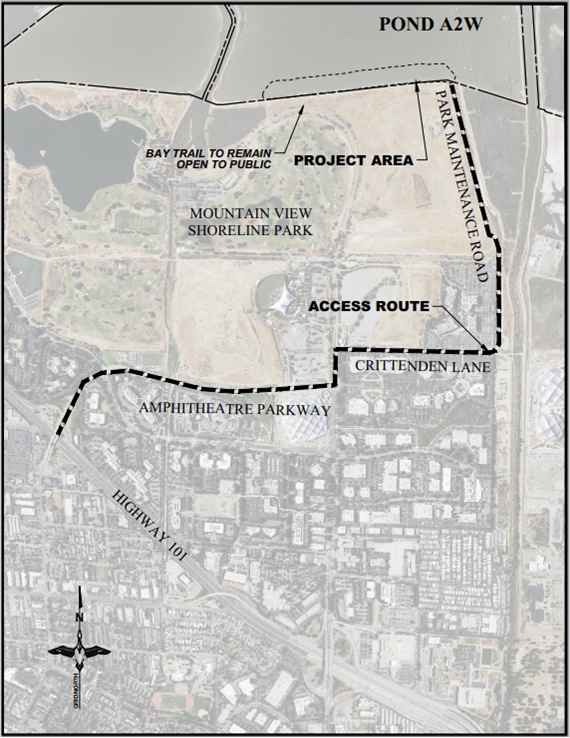
Midpen Designates Stevens Creek Trail in Monte Bello OSP
27 October 2021

Click to Volunteer
17 June 2023
King Tide 2020-21 Info ×
- Sunday November 15, 2020 high time / height: 11:40 AM / 9.95 ft. low time / height: 6:52 PM / -1.38 ft.
- Monday Nov. 16, 2020 high time / height: 12:22 PM / 9.95 ft. low time / height: 7:41 PM / -1.49 ft.
- Sunday Dec. 13, 2020 high time / height: 10:31 AM / 10.13 ft. low time / height: 5:54 PM / -1.40 ft.
- Monday Dec. 14, 2020 high time / height: 11:15 AM / 10.22 ft. low time / height: 6:41 PM / -1.63 ft.
- Tuesday Dec. 15, 2020 high time/height: 12:00 PM / 10.08 ft. low time/height: 7:28 PM / -1.64 ft.
- Monday Jan. 11, 2021 high time/height: 10:10 AM / 10.00 ft. low time/height: 5:46 PM / -1.35 ft.
- Tuesday Jan. 12, 2021 high time/height: 10:58 AM / 9.99 ft. low time/height: 6:31 PM / -1.46 ft.
To learn more about King Tides, visit the California King Tides Project website . There you can look up how to share your pictures (hint, tag them with #KingTides and there’s and app for that), find the time of your high tide at other locations (its over an hour earlier at the Golden Gate Bridge), or watch a video broadcast of King Tides from at home.
WARNING - If you plan to go to the coast to check out these high or low tides, be extremely careful. Monster big waves are in the forecast. Don't turn your back on the waves. Don't go out where it is wet - that means waves have been there recently. When waves are big, sneaker waves happen. Those are where the biggest waves may only happen every 15 minutes or even less frequently.
About The Friends of Stevens Creek Trail
VISION: Welcoming trails and healthy wildlife corridors that connect people from the bay to the mountains in the Stevens Creek and Permanente Creek watersheds.
The Friends of Stevens Creek Trail is a local community group whose goal is to raise community awareness and support for the completion of a trail in the Stevens Creek Corridor. Founded in December of 1992 to support on-going local government efforts, the Friends was incorporated as a 501(c)3 public benefit non-profit corporation in March of 1993. This grassroots community action group is endorsed by the Santa Clara County Board of Supervisors and by the Cities of Cupertino, Mountain View, and Los Altos.
The Board of Directors of the Friends of Stevens Creek Trail is made up of volunteer community members from the communities that the creek runs through on its way to the bay. Meet the Board
The Friends Volunteer Action Team runs community outreach and education programs, organizes tree plantings and trail work days, and raises funds for enhancements of the trail, as well as hosting the annual Trailblazer Race. Take a look at the list of great folks who have been past recipients of our Volunteer Of The Year award.
To sponsor us or be part of the Trail Action Team or for more information:
Stevens & Permanente Creeks
And wildlife corridor.

Stevens Creek is named after Capt. Elisha Stephens, one of the early settlers of Cupertino.
In Santa Clara County and in Cupertino, Stevens Creek flows northeast from the 1000-acre Stevens Creek County Park, through Deep Cliff Golf Course, McClellan Ranch Park, and Blackberry Farm Golf Course. From there the Creek forms the border between Los Altos and Sunnyvale. In Mountain View it runs roughly parallel to Highway 85 until it reaches Highway 101 where it flows into the Bay between Moffett Field to the south and Shoreline Park to the north. The total length of Stevens Creek is more than 20 miles.
Permanente Creek parallels Stevens Creek and shares a similar route. Historically the two creeks have intermingled. As its name implies, Permanente Creek runs year round most years, though with lowered groundwater levels in the past century, it goes underground before reaching the bay.
Stevens Creek Trail
Some history.
For over 50 years, a multi-use trail has been envisioned along the creek corridor of Stevens Creek. The cities and the counties have wisely reserved over 100 acres along the creek for public access, and have rejected previous plans to replace the natural creek bed with a cemented channel.
In 1961 a brochure was even published by Santa Clara County describing the "Stevens Creek Park Chain" and showing much of the route on the land as it still exists today. This accompanied the construction of Highway 85 between Hwy 101 in Mountain View and Hwy 280 in Cupertino.
The Current Trail
The trail runs through tidal marshlands and natural riparian habitats, providing for recreation and educational opportunities. The trail is regularly used for bicycling, bird watching, commuting, dog walking, education, hiking, jogging, nature walks, running, scootering, roller and inline skating, skateboarding, striding, and walking.
The trail in Mountain View extends south from its connection to the Bay Trail in Shoreline park, past La Avenida trailhead, under Highway 101, past Whisman School and Park, under Middlefield Rd., past Creekside Park, under Hwy 85, over Central Expressway, past Landel's School over Highway 237 past the Yuba Drive trailhead, under El Camino Real, through a large meadow, past an access point at Sleeper Avenue, then over Hwy 85 to where it now ends at the corner of Dale Avenue and Heatherstone Way. Together with the city of Sunnyvale, work is underway to extend the trail South to Fremont Ave.
With the spring 2021 addition of 0.3 miles of trail, Cupertino now has 1.3 continuous miles of Stevens Creek trail following the creek from Linda Vista Park to Stevens Creek Boulevard. The trail follows Stevens Creek through open space from Linda Vista Park north through the McClellan Ranch Preserve, Blackberry Farm Park, and the old Stocklmeir property to Stevens Creek Blvd. Along the way, the gravel and permeable concrete trail passes by areas of habitat restoration, the 4-H farm and community gardens of McClellan Ranch Preserve.
For the latest developments, please check our trail update page .
Functions of the Trail
Restoration and preservation.
Stevens Creek is home to a host of native California wildlife. Raccoons, opossums, quail, hawks, swallows, jays, and many others make their home in the creek corridor or use it as a greenbelt thoroughfare for traveling to and from distant feeding areas. Trail plans stress the importance of restoring and preserving the creek's natural environment. This includes planting native vegetation to protect existing wildlife habitats and to provide wildlife with additional sources of food and shelter.
Recreation and Community Access
The Stevens Creek Trail provides access to the creek and, eventually to hundreds of acres of adjacent open space. It is available for hiking, jogging, cycling, and other recreational activities which easily integrate with the natural environment. Read more about the benefits of trails...
The safe, automobile-free route links neighborhoods, local parks, schools, and businesses including Rancho San Antonio , Monte Bello Open Space Preserve , Stevens Creek County Park, McClellan Ranch, Stevens Creek Shoreline Nature Study Area and Shoreline Park . The Trail offers residents an alternative transportation corridor to avoid the congestion and pollution of the region's highways. The proposed trail is through Cupertino, Los Altos, Sunnyvale, and Mountain View. It already connects to Cal Train and the Light Rail System in Mountain View. The Shoreline Business Park, commercial areas in Cupertino, and other business areas near the Trail employ over 30,000 people.
Youth and Adult Education
Outstanding environmental education opportunities for the community at large exist in the creek corridor. School children from four schools directly on the creek and the 12 schools within a mile of the creek will have safe access for hands-on nature study. School children will also be invited to participate in trail days to plant native vegetation, and to creek cleanup days. The opportunity also exists to adopt a portion of the Trail. Tours will be regularly available to familiarize the community with the rare riparian habitat provided by Stevens Creek.
Representatives from each of the school districts and the Environmental Volunteers, a non-profit environmental education organization, serve on the Advisory Council of the Friends. They are working together to tailor their curricula to take advantage of the enhanced access to the creek.
Serving the Community
The Stevens Creek Trail route travels through four cities and many neighborhoods, business centers, and school grounds. Over 40,000 people live within walking distance of the Trail. The 30,000 who work near the creek can also benefit from access to the Trail for lunch breaks, alternate transportation, and opportunities to relax in natural environments.
Explore the interactive map in the full window. or get the app on your IOS or Android phone
Contact Information
Comments, Questions, Suggestions?
Make a donation
- Check our FAQ
- Sign up to Volunteer
- Make a Donation
- Become a Sponsor
- Sign up for our Newsletter
- Media Inquiries
- Other business to: Executive Director [Still a work in process...]
- Accidents - CALL 911
- in Mountain View, report to [email protected] or use the Ask MV webpage or mobile app.
- in Cupertino, report to Cupertino-311 webpage or mobile app.
- Report damaged/missing signs
Find us on Social Media:
Remember to tag @fosct, #StevensCreekTrail and/or #PermanenteCreekTrail
Mailing Address


COMMENTS
Come and check All Categories at a surprisingly low price, you'd never want to miss it. Awesome Prices & High Quality Here On Temu. New Users Enjoy Free Shipping & Free Return.
Hike Footwear - Highest Quality Shoes That Offer Comfort, Durability And Optimal Design. Optimal Support With Maximum Comfort - Hike Footwear, Your Path To Well-Being
Best Overall Hiking Shoes: HOKA Speedgoat 5 Trail-Running Shoes. Most Comfortable Hiking Shoes: adidas Terrex Free Hiker GORE-TEX 2.0 Low Hiking Shoes. Best Hiking Shoes for Technical Terrain: Salomon X Ultra 4 GORE-TEX Hiking Shoes. Best Hiking Shoes for Thru-Hiking: Altra Lone Peak 8. Best Hiking Shoes for Beginners: Merrell Moab 3 Hiking Shoes
Best budget hiking shoes: Merrell Moab 3 ($120) Jump to Review. Best hiking shoes for technical terrain: La Sportiva Ultra Raptor II Low ($149) Jump to Review. Best lightweight trail runners for long distances: Saucony Peregrine 14 ($140) Jump to Review. Best zero drop shoes for thru-hiking: Altra Lone Peak 8 ($140)
Men's Waterproof Hiking Shoes Leather Low-Top Hiking Shoes for Outdoor Trailing Trekking Camping Walking. 4.2 out of 5 stars 2,710. Limited time deal. $39.99 $ 39. 99. List: $49.99 $49.99. FREE delivery Fri, May 3 +4. Merrell. Men's Moab 3 Waterproof Hiking Shoe. 4.5 out of 5 stars 1,090. 50+ bought in past month.
Ahinsa Chitra Trek&Trail stands out as one of the softest, most flexible, and lightweight barefoot hiking shoes available. This model offers two choices: the barefoot and comfort versions. The comfort line features an insole with a slight heel rise, while the barefoot version, designed for more experienced hikers accustomed to barefoot footwear ...
MSRP: $120 Weight: 26 oz women's | 33 oz men's Upper Materials: Pigskin leather and mesh Waterproof version: Women's | Men's Pros: Vibram soles; made with recycled materials; affordable Cons: Heavy; not the most durable hiking shoes Details. The Merrell Moab 3 was released in spring of 2022. The newest update features partially recycled materials (the mesh lining, laces, and webbing ...
3.25 in. Last Board/Shank. ADV-C chassis. The Salomon X Ultra 4 Gore-Tex is a solid choice for hikers looking for a lightweight, supportive, grippy, and waterproof shoe. The X Ultra 4 is the latest in a long line of dependable shoes from Salomon that fit well thanks to a Sensifit system that locks the foot in place.
HOKA Anacapa Breeze Low Hiking Shoes - Men's. $155.00. (70) Compare. 1 ... 10. Shop for Hiking Shoes at REI - Browse our extensive selection of trusted outdoor brands and high-quality recreation gear. Top quality, great selection and expert advice you can trust. 100% Satisfaction Guarantee.
Best Hiking Shoes for Style & Function: Danner Trail 2650. Best Water Hiking Shoes: Astral TR1 Water Hiking Shoe. Best Travel Hiking Shoes: Lems Trailhead Hiking Shoe. Best Hiking Shoes for Summer ...
Shoes such as the Salomon X Ultra 4 and the Adidas Terrex Swift R3 Gore-Tex have great traction on a range of surface conditions. The X Ultra 4 is one of the most supportive shoes in our review, we feel confident traveling over varied terrain. Credit: Ryan Huetter.
Best Hybrid. Danner Trail 2650 Campo GTX. See It. Most Comfortable. Hoka Speedgoat 5. See It. We may earn revenue from the products available on this page and participate in affiliate programs. Learn More ›. In recent years, the line between hiking shoe and trail running shoe has blurred, with more and more day hikers, and even backpackers ...
The Best Hiking Shoes. Best Durability: Merrell Moab 3 Hiking Shoe. Most Comfortable: Altra Lone Peak 7 Hiking Shoe. Best Waterproof Option: Keen NXIS Evo Waterproof Hiking Shoe. Best Traction ...
Best Overall Hiking Shoe: Salomon X Ultra 4 GTX. Best Budget Hiking Shoe: Merrell Moab 3. Best Ultralight and Cushioned Hiking Shoe: Hoka Speedgoat 5. Best Shoe for Backpacking and Technical Trails: La Sportiva Spire GTX. Best Hiking Shoe for Off-Trail Scrambling: La Sportiva TX4 Evo.
After putting miles on these shoes and evaluating their fit, traction, features, and support, I made my top picks for the best men's hiking shoes. Best Overall: Scarpa Rush GTX. Most Comfortable: Merrell Moab 3. Best Trail Runner: Altra Lone Peak 6. Best for Mixed Terrain: La Sportiva Ultra Raptor ll.
Shop top-rated hiking boots and hiking shoes for men, women and kids from KEEN, Merrell, Timberland and more. Get low prices on hiking boots with our Best Price Guarantee. ... Trek through the field in high-cut and mid-cut hiking boots, crafted with an extended ankle to provide both stability and protection on rugged terrain. Low-cut hiking ...
We trail-tested over 25 models to put together our list of the best hiking shoes for men and women, looking at comfort, waterproofing, protection, and support. ... The waterproof Keen Targhee III Low are reliable, stylish trekking shoes for casual hiking. Keen just released the Targhee IV (men's and women's) and we're currently testing. However ...
We put women's hiking shoes from Salomon, La Sportiva, Merrell, Keen, and others to the test to find the best. By Myrha Colt, Trish Matheny, and Mary Witlacil. Wednesday April 17, 2024. On the hunt for new hiking shoes? In 11 years, we have put 126 pairs of the best hiking shoes through extensive testing.
Best Hiking Shoes Overall: HOKA Speedgoat 5 ($155) Best Budget Hiking Shoes: Merrell Moab 3 ($120) Best Balance of Weight, Support & Breathability: Topo Athletic Ultraventure 3 ($150) Best Budget Trail Runners for Hiking: Saucony Peregrine 14 ($140) Most Durable & Supportive Hiking Shoes: La Sportiva Spire GTX ($209)
Vibram Five Fingers Men's V-Trek Trail Hiking Shoe . 4.5 out of 5 stars 1,688 | Search this page . Price: $122.00 $122.00-$129.95 $129.95 Free Returns on some sizes and colors . Select Size to see the return policy for the item. Size:
Gear up for your next outdoor escapade with hiwalk Waterproof Hiking Shoes . Adventure Awaits: Whether you're embarking on a day hike or a multi-day trek, hiwalk Waterproof Hiking Shoes are your ticket to unforgettable adventures. Embrace the wilderness, experience nature's beauty, and forge lasting memories with footwear that's up for the ...
Shop for Men's Hiking Shoes at REI - Browse our extensive selection of trusted outdoor brands and high-quality recreation gear. Top quality, great selection and expert advice you can trust. 100% Satisfaction Guarantee
Find Hiking Shoes at Nike.com. Free delivery and returns.
Weight: 9.2 ounces (per shoe) | Closure: Lace-up | Stability: Low | Waterproof: No | Heel-to-toe drop: 0 millimeters Pros: Wide toe box and natural foot position; Durable upper of ripstop mesh ...
Amazon Has Tons of Hidden Deals on Comfy Hiking Shoes for Fall — Save Up to Nearly 50% Off REI's Summer Sale Includes 5,000+ Markdowns — but These Are the 10 Best Deals Starting at Just $16
REI Dublin provides outdoor enthusiasts in the Dublin, California, area with top-brand gear and clothing for camping, climbing, cycling, fitness, hiking, skiing, snowboarding and more. We're a complete Dublin-area bike shop, offering a full range of professional bike shop services to help keep you biking the Bay Area streets and trails year-round.
The Friends of Stevens Creek Trail is a local community group whose goal is to raise community awareness and support for the completion of a trail in the Stevens Creek Corridor. Founded in December of 1992 to support on-going local government efforts, the Friends was incorporated as a 501 (c)3 public benefit non-profit corporation in March of 1993.
About REI Saratoga. Since 1985, REI Saratoga has been providing outdoor enthusiasts in the Saratoga, California, area with top-brand gear and clothing for camping, climbing, cycling, fitness, hiking, skiing, snowboarding and more. We're a complete Saratoga-area bike shop, offering a full range of professional bike shop services to help keep ...
Find an REI store near you to shop for clothing, gear and footwear. Sign up for classes and events or talk to an REI outdoor expert.